INTERNATIONAL SCHOOL BANGKOK
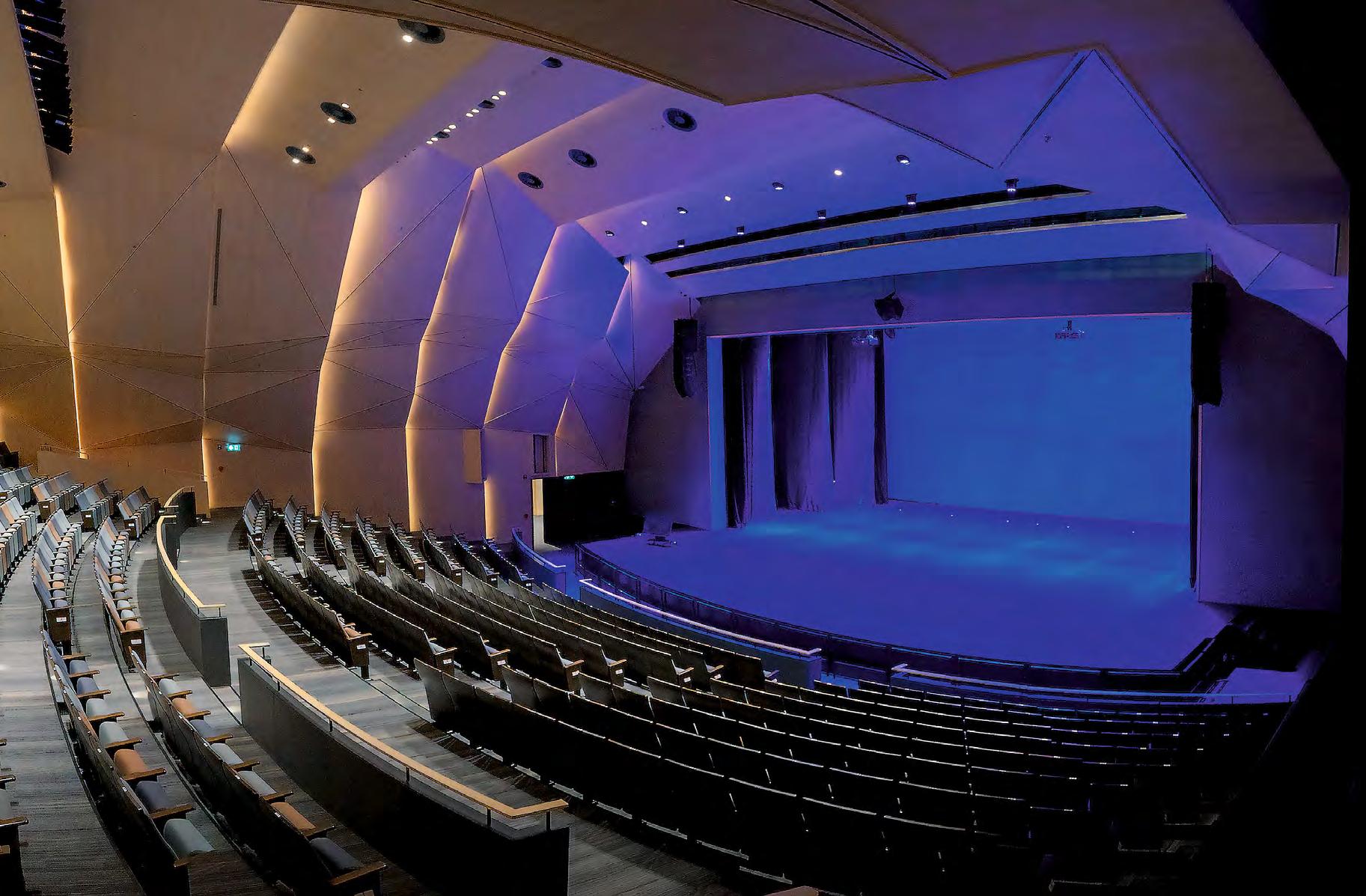
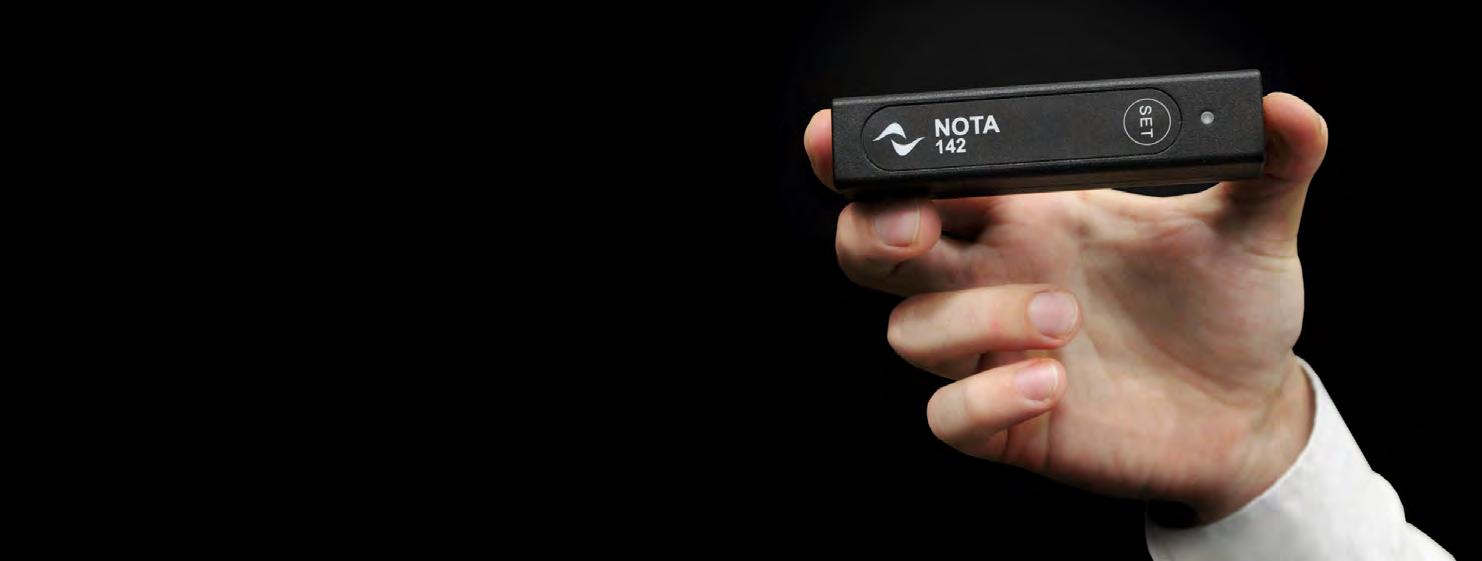






















































































Over the last few months it’s really starting to feel like generative AI has reached a tipping point. An AIpowered option is now integrated into the majority of searches, and many people I talk to are admitting to using platforms like ChatGPT to assist in their work or studies. While we’re all aware of the dangers it poses to the creative industries, most people I spoke to are excited about its potential as a creative tool, using it to assist what they are already working on rather than outsourcing the entire job to the bots.
It was therefore timely that PR guru Sadie Groom, CEO of Bubble Agency, sent us a piece about the critical need to understand how platforms like ChatGPT source and process information, and how professionals can strategically engage with these
tools to manage the risks they may present, whether perceived or real.
I’ve been noticing that generative AI knows much more about our industry than it did just six months ago, so it was interesting to discover that, according to Sadie’s research, machine learning only uses around 10% of branded copy and “puff pieces”, relying instead on content generated by third parties including – drum roll – trade publications such as this one. Once we finished patting ourselves on the back and doubling down on our commitment to continue serving the industry with impartial, relevant features and news, we decided to run Sadie’s piece in full; it can be found on p102 and I’d recommend everyone to read it.
Generative AI is here to stay but, instead of fearing or ignoring it, it’s in all of our interests to understand how it works.



Richard Lawn General manager rlawn@proavl-asia.com
Nick Smith Digital media manager nsmith@proavl-asia.com

Sue Gould Advertising director sgould@proavl-asia.com
Chris Yardley Video editor cyardley@proavl-asia.com
Carolyn Valliere Sales associate cvalliere@proavl-asia.com
Jack Stennulat Digital content creator jstennulat@proavl-asia.com
Simon Luckhurst Senior reporter sluckhurst@proavl-asia.com
Adrian Baker Production manager abaker@proavl-asia.com

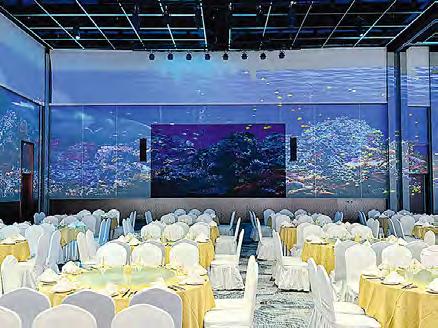



Karen Wallace Editorial coordinator kwallace@proavl-asia.com
Marne Mittelmann Circulation manager circulation@proavl-asia.com
Bea Meikle News editor bmeikle@proavl-asia.com
Sue Su Guangzhou manager ssu@proavl-asia.com

Riedel Communications has added to its growing suite of broadcast, event and production technologies with the acquisition of hi human interface (hi) from Broadcast Solutions. Launched in 2018, hi is a browser-based, platform-independent control layer designed to enable operators to manage a wide range of devices, including baseband routers, multiviewers, video and audio mixers, and third-party SDN controllers.
Stefan Breder, CEO, Broadcast Solutions Group, said that the deal is the culmination of years of successful partnership between the two manufacturers: “hi is a truly exceptional solution with a bright future ahead and we believe that Riedel has the
global reach and resources to fully unlock its enormous potential as a product.”
Thomas Riedel, founder and CEO of the Riedel Group, added: “hi has become a benchmark for intuitive control in the industry. This proven control solution perfectly complements our portfolio and will give our customers unprecedented freedom to shape and operate their workflows exactly as they envision.”
Riedel and hi have already demonstrated their integration capabilities, with hi working hand in hand with the MediorNet media infrastructures and SmartPanels for routing, device control and workflow management in various high-profile deployments. hi is also fully integrated for
Riedel StageLink audio routing and tally control with SimplyLive video production solutions, with further integrations across the Riedel portfolio already in development.
“Riedel has believed in and championed hi since its inception,” said Tamás Szanto, product owner – hi, Riedel Communications. “hi will remain an open, manufacturer-independent platform. What’s changing is the backing of Riedel’s global organisation, which means accelerated development, wider availability and a new level of support for customers worldwide.”
www.riedel.net
Barco has announced a landmark agreement with Huao Media that will see the Belgian manufacturer deliver 400 projectors, 1,200 lenses and 60 Encore3 image processing systems to the Chinese distributor.
The deal is said to represent a significant step in Barco’s long-term strategy to expand its footprint in Asia, underscoring the growing demand for professional visualisation and collaboration solutions in the territory. Huao has already allocated much of the equipment to confirmed projects, reflecting both the company’s extensive market reach and the strength of demand across entertainment, cultural and corporate sectors.
The order includes I600-4K15 single-chip laser projectors and matching ILD lenses. According to the manufacturer, the agreement highlights renewed momentum in the Chinese professional AV industry following several years of slower growth after the pandemic.
“The Chinese market has faced considerable headwinds since Covid-19, with slower recovery and cautious investment patterns,” noted Domien De Witte, vice president of sales and marketing, Barco. “However, we’re now seeing encouraging signs of renewed growth.”
Liu Dong, chairman of Huao, added: “This partnership marks a new chapter for us; it’s a strategic move to align with a brand that understands the dynamics of a fast-growing market and is committed to supporting our long-term success.”
www.barco.com
Yamaha Music Japan, in partnership with Nexo and Steinberg, recently hosted an immersive audio experience in Japan to showcase the Sound xR concept. Taking place at the Garden Room in Tokyo’s Yebisu Garden Place complex, the two-day event themed around “bringing immersive experiences to everyone” was attended by local sound rental companies, consultants and integrators all eager to learn more about the technology.
Sound xR is the collaboration between Yamaha group companies to provide a full technical solution for the production and delivery of three-dimensional sound for installations and live events. The Tokyo event was designed to highlight the technology’s immersive audio workflow, from content production to mixing, control, systems design and playback.
The event kicked off with an explanation of Sound xR and its aim to deliver enhanced immersive sound experiences in both real and virtual worlds. Delegates then learned about the

solution with Steinberg’s Nuendo DAW acting as the production hub through integration with AFC Image three-dimensional object-based mixing controlled directly from Yamaha digital
mixers, processing up to 128 channels from Nexo’s new DME10 immersive audio processor and delivered via the French brand’s powered processors and loudspeakers.
With the company’s engineering support director, François Deffarges, delivering final onsite tuning, a full Nexo immersive sound system was designed using the NS-1 system configuration and performance prediction software. The solution comprised five P12 upper front speakers, four ID24 lower front speakers, 12 P10 surround speakers, six P8 ceiling speakers, four L15 corner subs and two L18 centre subs. Amplification and processing for the system was provided by the manufacturer’s NXAMPMk2 powered TD controllers.
Speaking at the event, Deffarges said: “Alongside Yamaha’s established expertise in spatial acoustics, the combination of technologies from Yamaha group companies to create a full immersive audio technical solution from production to delivery makes a very compelling proposition for event designers.”
www.nexo-sa.com
www.steinberg.net
www.yamaha.com/2/proaudio

North India-based A to Z Audio Rental Service Chandigarh has bolstered its audio arsenal with the addition of an Adamson S10 line array system provided by StageMix Technologies. The new setup, which is powered by Lab Gruppen amplifiers, is aimed at enhancing the rental company’s capabilities for even the most demanding events, as part of the continued evolution of its business.
The investment includes 16 units of Adamson S10 compact 2-way line array cabinets, which have been designed for both live music concerts and large-scale events. These are complemented by six of the brand’s E219 subwoofers, which can be paired together to deliver immersive listening experiences. To drive the system, the rental company has acquired three Lab Gruppen
PLM20K44 amps, chosen for their reliability, power and onboard Lake processing.
“We wanted a system that could handle the growing demand for high-quality sound at concerts and large events,” commented Sunil Kumar, owner of A to Z Audio Rental Service Chandigarh. “The Adamson S10 and E219 combination gives us the clarity, power and consistency we were looking for.
Powered by Lab Gruppen PLM20K44 units, this setup ensures that we can deliver the best-possible experience to our clients and audiences. The system’s compact size also makes it easy to deploy without compromising on output.”
www.adamson.ai
www.labgruppen.com
www.stagemix.com

LSC Control Systems celebrated Robe’s launch into ANZ with an event at Sydney’s The National Institute of Dramatic Art (NIDA). Titled LSC: The New Home for Robe in ANZ, the affair welcomed over 100 industry professionals for technical insights, presentations, live music and networking opportunities.
The event follows a re-boot of the Robe Group’s commercial activities across ANZ this year, coupled with its representation of LSC Control Systems and Avolites. LSC also announced the appointment of Darren McLanders as Robe sales manager for ANZ, filling out a team that now represents the group of brands.
McLanders commented: “There’s some hard work ahead for sure, but I am looking forward to all the challenges and rewards that will come with getting this market-leading brand the visibility and success it deserves.”
The occasion welcomed attendees from all sectors of the entertainment technology spectrum, such as lighting and visual designers, programmers, managers, engineers, technicians and artists. All guests actively work in the local rental market from

Ross Video has announced its acquisitions of both LAMA, a developer of software-based audio production tools, and ioversal, which manufacturers AV production workflow technologies. Ross Video said that the investments underscore its commitment to broadening its offering across broadcast, sports, entertainment and live events, providing customers with a unified toolkit.
The acquisition of ioversal, the creator of the Vertex AV production suite, marks Ross Video’s expansion into experimental technologies. With decades of expertise in media servers and interactive control systems, the ioversal team strengthens the Canadian manufacturer’s ability to deliver end-to-end live production solutions.
“Vertex gives our customers a powerful new way to tell their stories,” said David Ross, CEO, Ross Video. “It also extends our live production solutions into the experiential world, opening creative possibilities that inspire audiences everywhere.”
“Joining Ross Video is a natural next step in our journey,” noted Jan Hüwel, co-founder of ioversal. “Ross shares our passion for empowering customers and our belief that innovation should always serve creativity.”

venues such as theatres and multifunctional spaces to sectors like corporate entertainment and the arts.
During the event, Robe international product specialist Dave Whitehouse gave a presentation highlighting the brand’s T-series fixtures alongside recent Robe technologies to hit the market. Attendees
were also able to get previews of the brand’s upcoming products.
There were live performances from the band Dave McCormack & The Polaroids, with each number having a special lighting design featuring Robe products, programmed by Hamish Lee from design studio Colourblind, assisted by Alex McCoy and using an Avolites
LAMA’s audio mixing platform is designed for fast-paced environments including broadcast, esports, streaming and corporate events. Ross Video believes that the purchase of LAMA brings new capabilities in cloud-native and on-premises audio mixing to its growing ecosystem, furthering its ambition to deliver complete end-to-end production workflows.
“Ross Video has built its legacy on giving our customers everything they need to connect with their audiences,” commented Jeff Moore, executive VP and chief marketing officer at Ross Video. “This acquisition extends our audio capabilities, both on-premises and in the cloud.”
Founded with the aim of simplifying the complexities of live audio, LAMA has focused on intuitive workflows that serve both experienced engineers and solo streamers. The company’s co-founder and chief commercial officer, Ewan Cameron, said the deal opens up new opportunities for growth: “Joining Ross Video allows us to keep innovating while expanding access to our technology through a trusted global brand.”
www.ioversal.com www.lamamix.com www.rossvideo.com
D9 console. Colourblind director Lynden Gare provided control of LED video elements from an Avolites AI server and T3 console. LSC’s UNITOUR rack powered the entire lighting rig and the new GenX Dim/Switch and APSX power distribution units were also on display. Robe was represented by its CEO and founder, Josef Valchar, alongside global sales director Michel Arntz and APAC MD Jens Poehlker.
“This is is a hugely significant territory with a lively production, performance and arts scene and an existing healthy, strong rental sector,” remarked Arntz on the ANZ market. “Acquiring LSC last year has now given us fantastic possibilities of increasing business and market share for Robe and all its brands.”
Extra production gear was provided by Robe rental partners Harry The Hirer, Chameleon Touring Systems, Theatricks Productions and Lux Imperium, together with some of the Robe and LSC house products installed at NIDA.
www.lsccontrol.com.au
www.robe.cz

FBT’s Indian distributor, Delhi Light and Music Centre, recently introduced the brand’s MYRA system to the region with an event held at the Park Boulevard Hotel New Delhi. The evening welcomed approximately 200 professionals from across the industry, including audio engineers, rental companies and systems integrators.
Matteo Stella, FBT’s application engineer, alongside export manager Roberto Mataloni, kicked off the evening with a short 20-minute technical presentation on the MYRA system. Attendees were then able to experience the system’s sonic capabilities first-hand during a live band performance. This was followed by a dinner where attendees networked and shared their thoughts and questions with the FBT team and Delhi Light and Music Centre.
The demo stage setup in the garden of the Park Boulevard Hotel comprised 16 MYRA 214L line arrays, supplemented in the lower frequencies by eight MYRA 218S subwoofers in cardioid configuration. The setup was powered by two MyRack pre-built amplifier racks designed for the MYRA system, while front fills were courtesy of two MUSE 210LA line array boxes.
“Heartfelt thanks to FBT Italy for the wonderful support in making the MYRA grand launch in Delhi a great success,” commented Pooran Rawat, owner of Delhi Light and Music Centre. “Special gratitude to Roberto and Matteo for travelling to Delhi and sharing their technical expertise – your presence truly made the difference. The feedback was excellent and clients were very
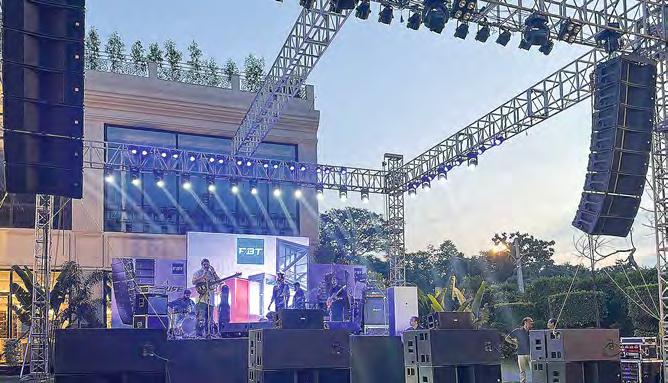
happy with the performance of the MYRA system.”
Stella added: “Having Pooran as our distributor makes a real difference during these times, as he is truly just as passionate about our company as we are. We had a lot of great conversations with professionals during the event and it was a success to showcase such a large system as MYRA, which is one of our flagship products, especially in an evergrowing market like India.”
www.delhilightandmusic.com www.fbt.it
NEP Group has announced a US$700mn equity invest led by its new partner 26North Partners (26North), together with a group of co-investors. NEP’s existing sponsor Carlyle is participating alongside 26North in the investment and will remain its largest shareholder.
Founded in 2022 by Josh Harris, 26North is a portfolio of franchises across sports and entertainment. NEP believes that its new partner will provide a fresh perspective, aligning closely with the group’s position at the intersection of media and live events. The group has also announced it has successfully completed a comprehensive debt refinancing. NEP said that, supported by the company’s performance and global client relationships, the refinancing enhances its capital structure and reduces its debt levels,

reinforcing a strong foundation for future growth.
NEP has been a media services and live events partner for many notable live productions across the world, from sporting events like the Olympics and the World Cup, to live entertainment productions such as the Oscars, to major global events like the recent NATO Summit.
The group believes that these important milestones position NEP to accelerate
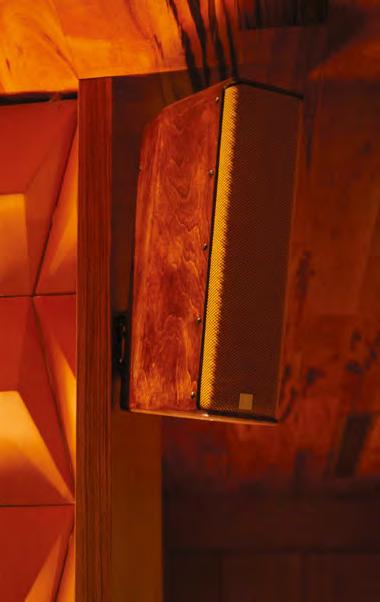

investment in its global operations, product development and new partnerships –enhancing its capabilities and speed to market in delivering solutions globally.
“We’re thrilled to take NEP to the next level with outstanding capital partners at our side,” remarked Martin Stewart, CEO of NEP Group. “Josh brings exceptional expertise in creating one of the world’s leading sports and entertainment portfolios and he and the

The Towers are the only active cardioid column with 20 dB of rear-cancellation.
With outstanding sonic clarity and extended low bandwidth, they deliver a wide dispersion pattern of 120º.
26North team have a proven track record of growing businesses across industries. We also couldn’t be more pleased to have earned the continued trust and support of Carlyle.” Mark Weinberg, head of private equity at 26North, said: “We’re excited to work with Martin, his leadership team and Carlyle to build on the strong foundation they’ve created. NEP represents the kind of business we seek to invest in: a global market leader with a stellar reputation for service delivery, technical expertise and innovation that keeps customers coming back for compelling storytelling around their most important events and experiences.”
www.26n.com
www.carlyle.com
www.nepgroup.com

Peavey Electronics celebrated its 60th anniversary with a party at the Morabito Art Villa, a French artinspired venue perched by the ocean in Berawa, Bali. Over 400 guests were invited to enjoy an evening of live entertainment by acclaimed Indonesian and international artists and presentations from company members covering the legacy of the Peavey brand.
Many of the manufacturer’s distribution partners from across the world, particularly the APAC region, gathered to honour Peavey’s 60-year legacy in pro audio. The company’s leading figures were present, including CEO Courtland Gray, general manager for Peavey Commercial Audio Shayne Thomas, general manager – product development/North American sales Fred Poole and Asia Pacific director Akshay Vaidya.
The evening commenced with a private dinner accompanied by performances from soprano opera singer Jane Maria, followed by Indonesian rock icon Stevi Item before DJ Dee Montero closed off the evening on the main dancefloor. Between sets, the company’s leaders conducted a presentation titled Past, Present and Future that walked attendees through Peavey’s history over the years – from its humble beginnings to its modern-day achievements and a sneak peek into the company’s future plans.
Every note of the evening was powered entirely by Peavey’s own gear. All stages featured the Crest Audio Versarray system, with the Peavey Aureus and Crest Tactus conducting FOH duties. The PVXp active systems served as stage monitors, while the CPL+ speaker line and Pro-lite amplifiers from Crest acted as the delay system throughout the venue. DJ Dee Montero’s afterparty set was also delivered through the Versarray line array system as well as CA 218 Pro subwoofers. The entire AVL setup was executed by the manufacturer’s local partner, Vilon Group Bali.
During the evening, Gray shared some upcoming product news for Peavey: “While we have a lot of exciting products coming out, we are most looking forward to the introduction of Scion, our Gen 3 MediaMatrix solution. Not only is it a significant upgrade to our legacy Nion systems, but it is also backwards compatible thereby enabling it to seamlessly integrate with any existing infrastructure that a venue might have.”
Vaidya remarked: “You only turn 60 once and therefore we felt we needed to have a bit of a
get-together with our partners in Asia and beyond to celebrate. We had guests from China, India, Thailand, the Philippines, Korea, Samoa, Malaysia as well as several from Indonesia in attendance. The fact that the Crest Versarray was able to handle opera, rock and house music back-to-back and sound superb across all three genres really showcases its variety and finesse – we received compliments on the sound all evening.”
www.peavey.com


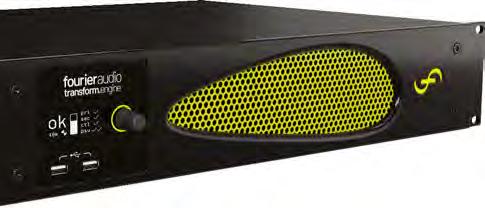
and activation - manage a fleet of engines with ease online - one annual payment for non stop access - perfect for a rider
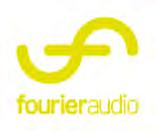
PK Sound has announced that it has integrated Milan networking into its core product offering, beginning with Milan certification for the Tx Series of point source modules and the Ts15 compact subwoofer. The manufacturer said that the move is aimed at providing simple, reliable and futureproof connectivity across a wide range of mobile and installed applications.
processors, amplifiers and other certified devices. Milan aims to provide consistent performance and interoperability across brands, from compact installations to largescale touring systems, allowing users to build complete end-to-end signal chains.
An associate member of the Avnu Alliance, PK Sound now offers Milan functionality for both new and existing Tx and Ts
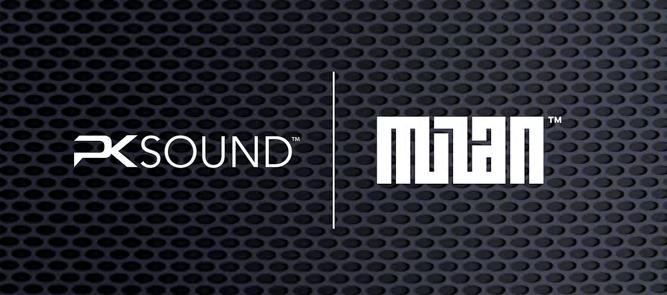
Colton Schmidt, engineering manager at PK Sound, commented: “Milan’s open standard guarantees futureproof investment, supported by a growing ecosystem of certified devices and the collective efforts of the Avnu Alliance. With Milan-certified PK Sound systems, users can expect seamless interoperability, robust performance and confidence in every deployment.”
Milan provides a standardised endpoint solution for professional audio systems, built on established AVB IEEE standards. PK Sound’s Milan-certified loudspeakers integrate into any Milan-enabled ecosystem, connecting via standard Ethernet to mixers,
products. Certification will soon extend to the company’s robotic line source systems and full product portfolio. Current users can activate Milan remotely by contacting PK Sound’s support team.
Dave Cavalcanti, president of the Avnu Alliance and principal engineer at Intel, said: “Milan certification delivers a powerful combination of features and usability, enabling audio professionals to implement cost-effective, networked solutions with ease. We’re thrilled to have PK Sound contributing to our shared mission and expanding the Milan ecosystem.”
www.pksound.live

Taking place at its Kuala Lumpur experience centre, Concept Associates recently hosted a launch event for LD Systems’ ICOA PRO series and MAUI MIX. The event brought together 40 attendees from across the AV community, including industry professionals, partners and audio enthusiasts, for an immersive showcase of the brand’s latest products.
Roger Lim, technical specialist for the Adam Hall Group, led live presentations on the LD Systems solutions. The demonstrations featured the ICOA PRO 12- and 15-inch active speakers paired with the ICOA PRO SUB 21A subwoofers. The session also showcased the MAUI G3 MIX column PA system, highlighting its onboard digital mixer, Bluetooth connectivity and app-based control. In addition, A/B listening comparisons were carried out to give attendees a direct experience of the systems’ clarity, lowend power and overall versatility.
According to Concept Associates, feedback was overwhelmingly positive with attendees commenting on the clarity, balance and punch of
the ICOA PRO series, as well as the user-friendly setup and flexibility of the MAUI G3 MIX. The hands-on session also allowed participants to trial the systems themselves, which was highly valued as it gave attendees practical insight into how these solutions could be applied in realworld scenarios.
The event concluded with networking opportunities, allowing participants to engage in one-on-one discussions with Concept Associates’ specialists.
“This event was a fantastic opportunity to bring our partners and clients together to experience LD Systems’ latest innovations first-hand,” commented Castrit Lim, managing director, Concept Associates. “Hosting such events is important to us because it not only allows people to hear and see the products in action but also fosters stronger industry connections.”
www.conceptaudio.com.my www.ld-systems.com
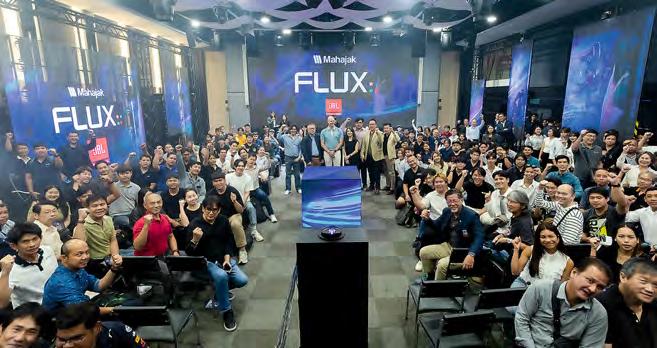
Mahajak Development recently welcomed over 132 industry professionals from Thailand for the FLUX:: Immersive: The New Era of Spatial Audio event, hosted at the company’s headquarters in Bangkok. The gathering featured a mix of live musical performances and audiovisual installations leveraging Harman Professional’s FLUX:: technology, paired with
a JBL loudspeaker system, to showcase the possibilities of spatial audio technology for productions.
The showcase welcomed a mix of professionals from the region including event organisers and production houses, university AV and music technology departments, creative agencies and experiential designers, AV rental companies and
systems integrators, and venue owners from local theatres, museums and experience centres.
At the heart of the showcase was the FLUX:: Immersive platform designed for spatial audio creation and playback, which features tools for real-time 3D audio rendering, mixing and analysis.
To showcase the capabilities of the technology, the hall was outfitted with JBL’s AC195 10-inch 2-way loudspeakers to create a cohesive audio ecosystem.
Mahajak’s integrated solutions manager Supasek Saenmanoh, alongside Harman Professional senior business development manager Bjorn van Munster, kicked off the programme with an in-depth product introduction on FLUX::. They highlighted the philosophy and technological breakthroughs behind the immersive sound technology, presenting product developments that reportedly captured strong attention from the audience.
Assistant professor Woravit Pikulthong (Boy Inca), a renowned Thai artist and educator, was an honorary member of the event and played a pivotal role in arranging and producing the immersive music featured throughout the
showcase. He also presented a talk on creative techniques in immersive music production, providing both technical insight and artistic inspiration.
To complement the sonic dimension, associate professor Janpen Koolkaew (Jib), an expert in visual arts, together with her team from Decide Kit, delivered a visual mapping installation. Their work was designed to transform the venue into a dynamic audiovisual canvas, blending immersive sound with imagery to captivate attendees.
A highlight of the evening was Mahidol University College of Music’s orchestral performance which aimed to demonstrate how immersive audio technology can elevate the performing arts to new heights.
According to the Mahajak team, attendees shared overwhelmingly positive feedback, citing the event’s inspiring atmosphere, the precision and power of the sound system and the valuable opportunities to connect with peers across the audio and creative industries.
www.mahajak.com/flux pro.harman.com

Spectera, Sennheiser’s wideband bidirectional digital wireless ecosystem, is already transforming productions all over the world — and its remarkable capabilities are evolving with regular functionality updates. Now, you can help shape the future of Spectera: Visit the Spectera Lab online to join the conversation and co-create the future of Spectera with us.
Collaborate with us at www.sennheiser.com/spectera-lab
Broadcast Solutions has announced its acquisition of Dutch camera support specialist Egripment BV and its rental subsidiary Egripment Deutschland. Through the deal, both will retain their names and market identities while expanding the portfolio available from Broadcast Solutions. Egripment is backed by 50 years of experience in developing and manufacturing camera support systems, including cranes, dollies, remote heads and other tailor-made solutions for television, film and live events. The company combines in-house design and manufacturing capabilities for various production needs. According to Broadcast Solutions, this will continue following the acquisition, with Philippe Tresfon staying as MD of Egripment and guiding future progress. Broadcast Solutions said that the purchase is aimed at strengthening its position as a global provider of complete production solutions. Egripment will now be represented through Broadcast Solutions’ offices worldwide, providing customers across Europe and the Middle East with direct
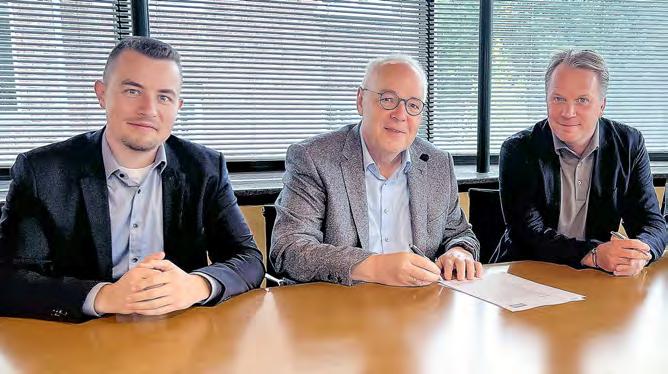
access to the manufacturer’s products, services and support.
Egripment HQ and Egripment Deutschland, based near Amsterdam and Cologne respectively, operate an international rental
Asian rental and staging company and multimedia and projection mapping specialist Hexogon Group has invested in what is reportedly the world’s largest single purchase of Christie Griffyn 4K50-RGB pure laser projectors. According to Christie, this means that Hexogon now owns one of the largest Griffyn 4K50-RGB fleets globally. Hexogon has won multiple international accolades for its large-scale projection mapping projects across Asia. The company said that its investment in Christie’s flagship 3DLP RGB
deliver even larger and more ambitious projection mapping projects across Asia.”
According to Goh, the purchase strengthens Hexagon’s confidence in elevating projection mapping and live events: “With plans to expand our fleet beyond 100 units over the coming year – depending on operational requirements and configurations – it enhances our capability to support events across Singapore, throughout Southeast Asia and beyond. This strategic investment aligns closely with our long-term vision

Hexogon deploys Christie solutions for various projects across the region
pure laser projection system underscores its commitment to delivering even more spectacular, world-class visual experiences. Hexagon also plans to expand its Griffyn 4K50-RGB inventory further within the next year.
“This investment marks our complete transition from conventional lamp-based projection to laser illumination, reinforcing our commitment to environmentally responsible operations,” explained Adrian Goh, managing director of Hexogon Group. “At the same time, it allows us to modernise and grow our fleet with advanced, high brightness 4K projectors, enabling us to
to maintain the region’s most advanced and reliable projection fleet.”
Han Kim, vice president of sales, Asia Pacific, Christie, concluded: “We are deeply grateful to Adrian and the Hexogon team for their trust in our Griffyn 4K50-RGB projectors. With this acquisition, Hexogon is poised to push the boundaries of projection mapping even further. We are proud to support their vision and strengthen their capabilities across the region.”
www.christiedigital.com
www.hexogonsol.com
division that services major events worldwide. Its extensive inventory includes cranes, stabilised remote heads and specialist grip equipment. As part of this acquisition, Egripment Deutschland will manage Birds
Camera Solutions, a Broadcast Solutions company specialising in advanced camera systems, creating a comprehensive, full-service rental portfolio under the Egripment brand.
“We are very excited by this acquisition and the new opportunities it offers,” said Maximilian Breder, MD and COO of Broadcast Solutions Group. “Egripment is a perfect fit for us: it brings unique manufacturing capabilities, worldclass reputation and a global rental offering that perfectly complements our existing services.
Growing the rental business is particularly important to us, because it brings us into direct contact with the creative users of the technology, the directors and operators.”
Tresfon added: “Our customers and partners can be assured that the Egripment name will remain synonymous with quality, innovation and service. As part of Broadcast Solutions, we can operate faster, reach further and continue to develop the groundbreaking solutions that set us apart in the market.”
www.broadcast-solutions.de www.egripment.com

Indian distributor Comcon recently hosted its exclusive dealer meet event Comconnect 2.1 in celebration of the company’s collaboration and growth. Held as an extension of Comconnect 2 at the Palm Expo in Mumbai earlier this year, the gathering ran alongside InfoComm India and welcomed Neutrik’s leadership team, reseller partners and the Comcon team for an afternoon of knowledgesharing and future-focused discussions. The event celebrated the long-standing partnership between Neutrik, Comcon and its Pan-India reseller network, highlighting their achievements in the pro AV segment. During the occasion, the company displayed a history of project milestones delivered across the country with the aim of showcasing the scale of collaboration and the role of partners in the distributor’s growth journey, while highlighting the penetration of Neutrik products in the various AV segments.
Speaking at the event, Comcon director Gaurav Aggarwal said: “This meet was a reinforcement of the trust, innovation and shared vision that define our partnership with Neutrik and our resellers. Together, we have executed landmark projects and together we are shaping the future of the pro AV industry. Capitalising on the success of the AV connectors, new innovative products like Dante converters and optical assemblies are continuously being introduced by Neutrik and are already a success in the India story with Comcon.”
Alongside a networking lunch, the meet fostered open dialogue on emerging market trends, strengthening partner synergies and building strategies to drive the next phase of growth.
www.comcon.co.in
www.neutrik.co.uk
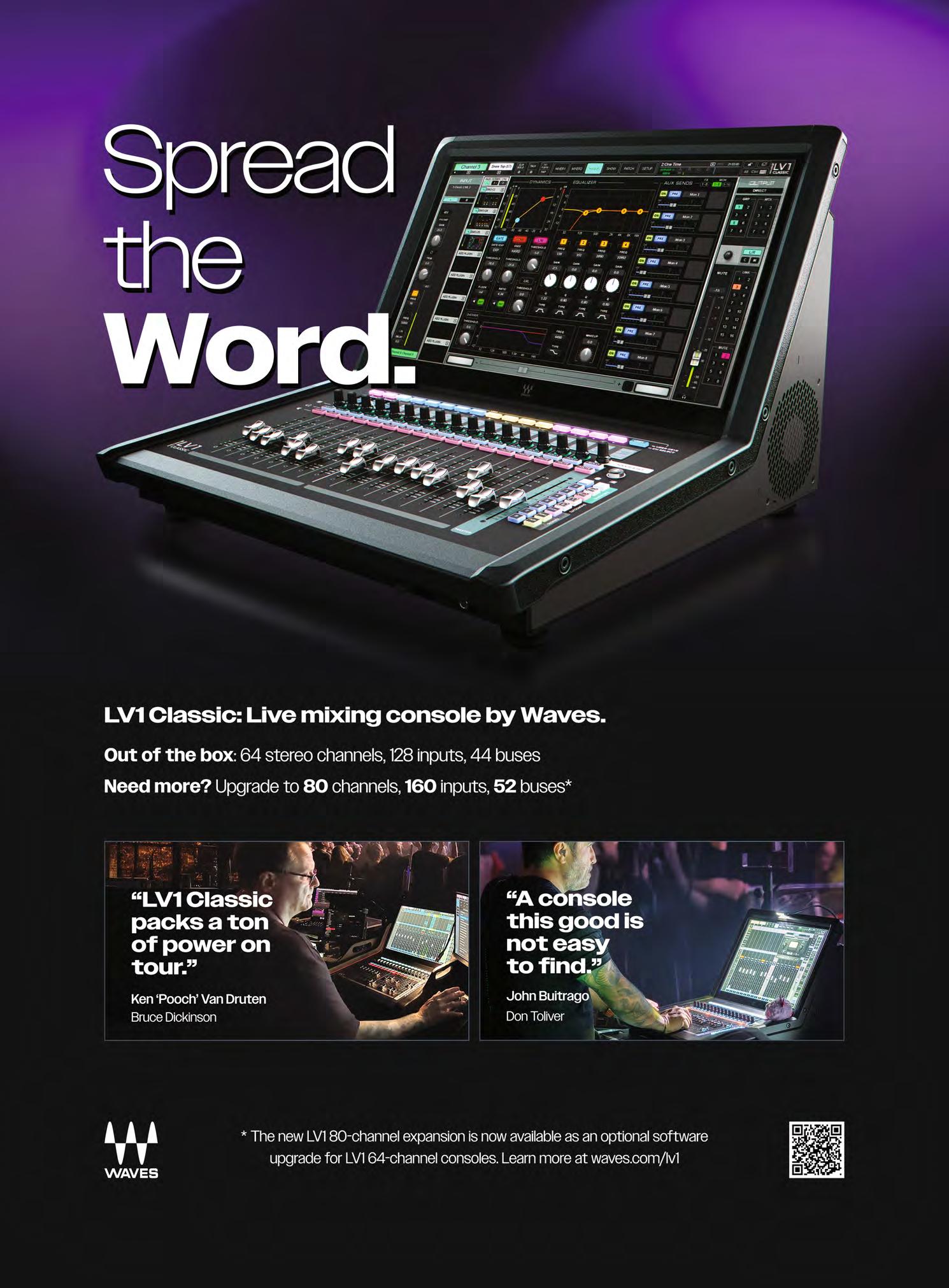

AXIENT DIGITAL PSM INCLUDES AN innovative WMAS transmission mode that is also named as “multichannel wideband”. With multichannel wideband transmission, a single radio, also commonly referred to as an RF carrier frequency, can deliver up to four stereo audio channels. With both narrowband and multichannel wideband, one can also access the Spatial Diversity feature, which delivers a whole new level of antenna diversity performance driven by advanced digital wireless technology that only Shure can deliver.
This means that with ADTQ and ADTD transmitters, the “Q” for quad and the “D” for dual no longer refers to the number of stereo audio channels, but rather the number of radios. As a result, the ADTQ quad transmitter with its four radios supports up to 16 stereo audio channels, while the ADTD dual transmitter supports up to eight channels with its two radios. Developing the hardware, software and business infrastructure to support the full vision of multichannel wideband (WMAS) is a serious undertaking.

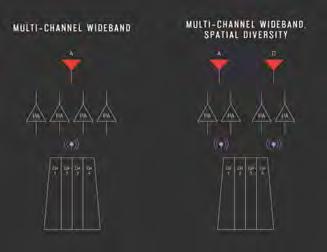
Recently, Shure has taken another major step towards completing the vision for WMAS and multichannel wideband for Axient Digital PSM. With new firmware now available through the Shure Update Utility or ShureCloud, operational presets with expanded multichannel wideband options are now accessible. With the availability of the new firmware, users can now preview the new operational presets and learn more about what new configurations will be possible in the future.

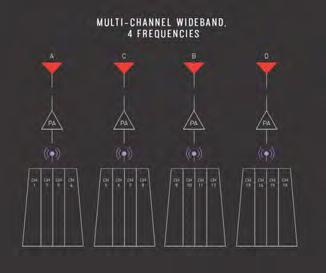
Users will see many benefits from the addition of channel expansion. The following are the two key advantages of channel expansion for Axient Digital PSM:
1. Cost savings of some Axient Digital PSM configurations
The first advantage is that channel expansion can potentially reduce the cost of the total multichannel Axient Digital PSM hardware configuration for customers that do not need
access to the highest RF output power to maximise total physical coverage.
Channel expansion for Axient Digital PSM is enabled on the transmit side, and all transmitters operate with a fixed amount of RF output power driven by the power amplifier section. When multichannel wideband was previously limited to a single radio, that radio was able to take advantage of all the power amplification resources per transmitter. With channel expansion, each multichannel wideband radio must now equally share the same power amplifier section resulting in lower RF output power, which affects distance performance. There are also operational presets available to balance half the channel expansion with spatial diversity to achieve a good balance of extended channel count and sufficient coverage. This type of configuration can provide significant value as a compact, highdensity, wireless in-ear monitoring solution. At the same time, there may be less challenging environments like houses of worship or isolated broadcast studios where neither spatial diversity nor higher RF output power is necessary. In these environments, all you would need for a successful Axient Digital PSM configuration would be a single transmitter device, the additional required channel expansion licences and the relative number of transmit antennas patched directly from the transmitter’s RF outputs.
2. Flexibility to manage your perpetual channel licences as needed
Axient Digital PSM channel licences are perpetual, not subscription licences. Once purchased, not only do you own them outright, you manage them based on your needs via your ShureCloud account. You
can add and activate channel licences to an Axient Digital PSM transmitter easily and/or you can transfer channel licences from one Axient Digital PSM transmitter to another. They’re yours! Use them as needed.
For example, if a single site eventually needed eight channels instead of four channels, and the coverage requirements for those eight channels were not extreme, it would be convenient to simply purchase, add and activate additional channel expansion licences instead of needing to purchase additional hardware.
Similarly speaking, if, for example, you own two Axient Digital PSM transmitters and 12 channels of channel licences, you can add six channel licences to each or four to one and eight to the other. You can also deactivate channel licences from one Axient Digital PSM transmitter and activate them in the another. Again, your Axient Digital PSM channel licences give you an incredible amount of flexibility to maximise your in-ear monitoring setups.
Axient Digital PSM is the most advanced wireless system that Shure has ever developed and brought to market. Its capabilities have been tested and used on the largest stages, biggest arenas and the most demanding tours (and elsewhere) on the planet. Though not the perfect fit for all, perpetual licences that add channel count to the quad (ADTQ) and dual (ADTD) transmitters – and the incredible flexibility to manage them across your inventory – is going to be a great addition for many users and situations. WMAS is an exciting area of focus for Shure and Axient Digital PSM is delivering a great deal of options for in-ear monitoring at the very highest levels of performance.
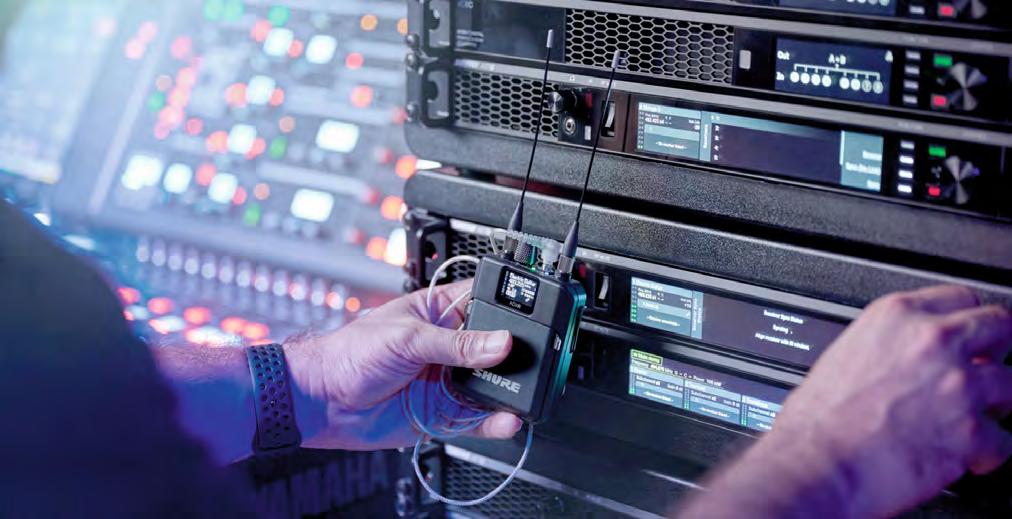
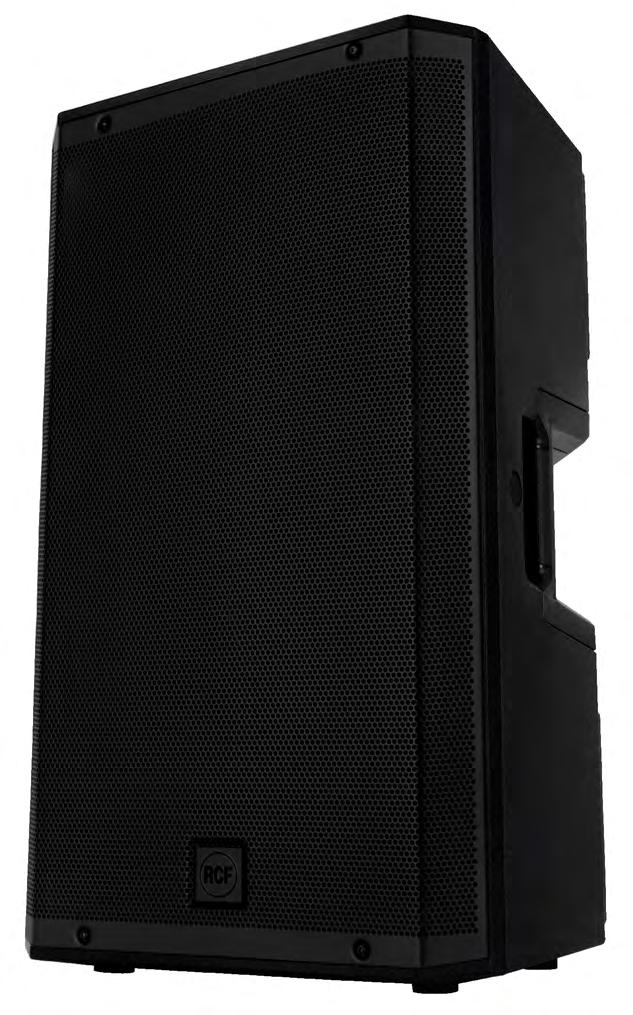

Absolute clarity meets deep, powerful bass. The high-power active ART 9 Series features advanced transducers, the new TRW waveguide, FiRPHASE processing, and Bass Motion Control algorithms to deliver exceptional audio performance for any professional application. Visit
L-Acoustics has welcomed Group Technologies Australasia as its new distributor for Australia and New Zealand.
The Melbourne-based company is already operational as an authorised distributor for the French audio brand and from 1 January 2026, Group Technologies will assume full distribution responsibility across ANZ.
“With decades leading the pro audio market and a deep connection to their clients, Group Technologies are the perfect partner to carry the L-Acoustics torch in Oceania,” said David Cooper, director of sales and business development, APAC at L-Acoustics. “Together, through this powerful collaboration, we’ll shake up the market, back our customers with unbeatable support and make sure L-Acoustics is heard loud and clear across Australia and New Zealand.”
Group Technologies brings decades of experience in professional audio distribution and a proven track record in large-scale installation projects. The company has built a reputation for supporting high-end professional
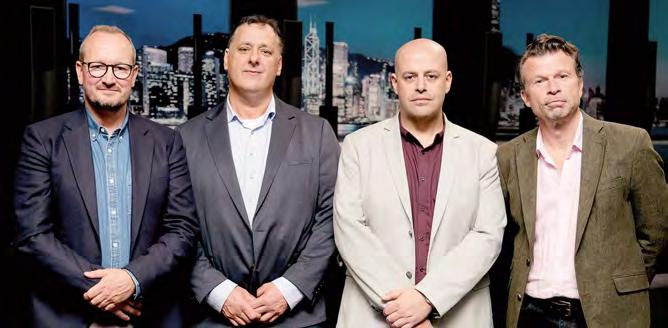
audio equipment across diverse applications in the local market, as well as delivering resources and support.
Anthony Touma, general manager at Group Technologies, remarked: “L-Acoustics’ reputation for pioneering sound reinforcement
technology and their significant influence in our market makes this partnership a natural fit for Group Technologies’ mission to bring worldclass brands to the Australasian market.”
The partnership brings enhanced support and access for L-Acoustics customers across
ANZ, including comprehensive local technical support, faster product access, hands-on training opportunities and expert assistance with custom installation solutions.
Furthermore, the distributor has committed to developing a specialised L-Acoustics demonstration facility in Melbourne, featuring both L-ISA immersive sound technology and Ambiance acoustic enhancement solutions. Scheduled to open in February next year, the experience centre will provide customers and industry professionals with hands-on access to the brand’s audio technologies.
“Group Technologies’ investment in this world-class demonstration space is a bold statement of vision and passion,” concluded Cooper. “It will be more than a showroom – it will be a destination where customers and industry leaders can step inside the magic of L-Acoustics and experience our technologies at their full potential.”
www.grouptechnologies.com.au www.l-acoustics.com
PreSonus recently announced Silicon Radio House (SRH) as its second distributor for India. SRH has been operating in the region’s audio and lighting industry for 25 years and boasts branches across the country, including its Chennai head office, alongside locations in Mumbai, Hyderabad, Delhi and Bangalore.
“We’ve been talking to PreSonus for a few months and are very proud to announce that we’re now representing the brand throughout India,” commented VR Rajashekaran, CEO and technical head, SRH. “They are an incredibly pioneering manufacturer and we’re very excited to have them join our portfolio of brands. We’ve already got some projects lined up with rental companies and systems integrators with plenty more in the pipeline.”
Kamal Mahtani, sales director of PreSonus Asia Pacific, said: “While PreSonus has been present in India for a number of years and our incumbent distributor has done a fantastic job, it’s been very much focused on our studio portfolio, which
incorporates the recording hardware, DAW, audio interfaces, studio monitors and accessories. However, we needed to work with a company dedicated to the other side of the product offering which is centred on our digital mixer and loudspeaker range. I’ve been really impressed with the strong relationships SRH have with production companies here, as well as the private sector, and their involvement in multiple government projects.”
SRH will now be responsible for PreSonus’s range of mixers, loudspeakers, accessories and stageboxes in addition to the new Studio Live SE Digital mixer. “We are really excited for the future,” added Mahtani. “Silicon Radio House is highly prepared for what’s to come from us; we’ve got a great road map ahead and will be launching more new products so there’s lots to look forward to here in India.”
www.presonus.com
www.siliconav.net

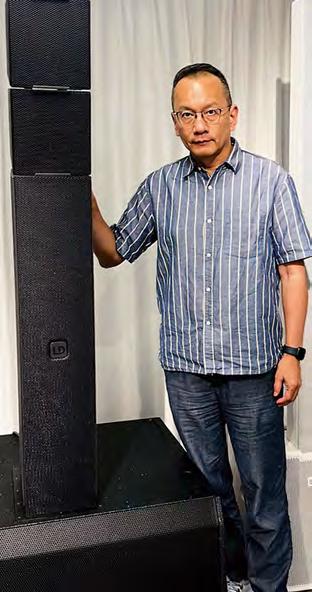
Expanding its international sales network and strengthening its presence in Asia, the Adam Hall Group has appointed MPHK Group Limited as the exclusive distributor of the LD Systems brand in Hong Kong. Through the partnership, the German manufacturer aims to position its audio solutions more strategically in Hong Kong’s technologically demanding and highly competitive market.
Founded in 2000, MPHK is a respected AV distributor in the region and boasts a head office in Hong Kong, alongside further branches in Beijing, Shanghai, Taipei and Macau. The company represents many international manufacturers from the audio, lighting and stage technology sectors, including other Adam Hall Group brands. In addition to sales, MPHK also offers comprehensive planning, development and other services for professional applications in the entertainment and architecture sectors.
“Hong Kong is an exciting, multicultural market with high standards of design, quality and technological innovation,” commented Alessio Foti, global business development manager, Adam Hall Group. “With MPHK, we have an established partner at our side who not only has in-depth market knowledge and technical expertise but also shares our philosophy of taking a holistic approach to event technology and installation solutions. We look forward to working with them.”
Raymond Wong, CEO of MPHK, remarked: “LD Systems not only has innovative ideas, but also the ability to translate them into practical products. That convinced us right from the start. After more than 25 years in Hong Kong, we know the local market very well and offer our customers not only a constantly growing brand and product portfolio, but also comprehensive technical support – a powerful combination that will enable us to successfully launch LD Systems on the market in Hong Kong.”
www.ld-systems.com www.mphkg.com.hk
for professional camera, film & broadcast solutions
6G/12G UHD transmission via BNC, SMPTE, HICON Fiber4, OpticalCON, FiberLens Broadcast
CAT 8.1 network connections with up to 40 GBit/s
Fiberoptical systems for installations and mobile applications IP67


Lightning fast data transfer with up to 100 GBit/s *


CAT 8.1, 40 GBit/s Highflex

6G/12G UHD BNC connectors





* Singlemode
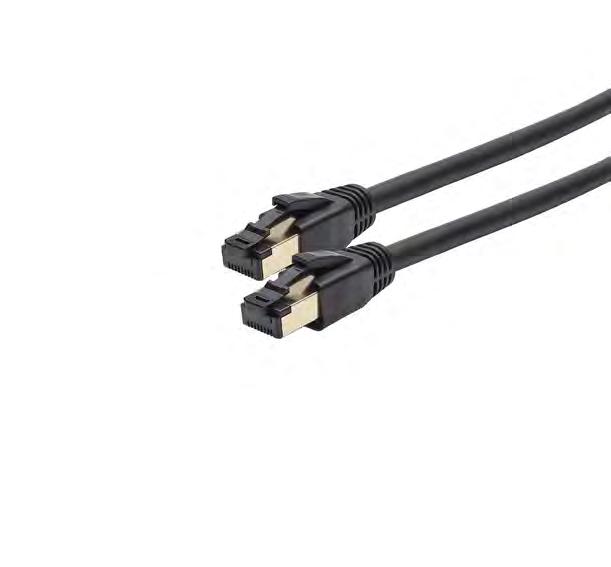










SOMMER CABLE based in Straubenhardt/Germany was founded in 1999 and is now one of the leading suppliers of professional high-quality cable and connection technology with a focus on the audio, video, broadcast, studio and media technology sectors. The product range including the in-house brands HICON, CARDINAL DVM and SYSBOXX covers cable bulkware, connectors, connection cables, individually adaptable distribution systems and electronics. A B2B shop with over 25,000 products is available 24/7.
Loud Technologies Asia (LTA) has bolstered its portfolio of brands through its new distribution agreements with both Turtle AV and Williams AV. The Singapore-based distributor is highly regarded in the region for its expertise in providing end-to-end audio and visual solutions for complex integration projects, as well as its market knowledge and technical support.
“Singapore is a key market in Asia and Loud’s technical expertise, credibility and strong local relationships make them the ideal partner to represent Turtle,” said Eamon Drew, co-founder and co-CEO at Turtle AV. “Their team knows how to deliver results and we’re excited to build the brand together in Singapore.”
Colin Quek, managing director at LTA, added: “Turtle AV has quickly become a name to watch in the pro AV industry and we’re excited to represent them in Singapore. Their lineup, from Dante AV-A video to Dante audio bridges, USB extension and beyond, brings real innovation with the reliability integrators demand. We see huge potential for these solutions in Singapore and look forward to driving their growth with our partners.”
Williams AV’s alliance with LTA is part of a wider strategy to expand the manufacturer’s footprint across Southeast Asia, enhancing
availability of its communication solutions for commercial, government and educational sectors throughout the region. Furthermore, the company said that LTA’s focus on quality, service and reliability aligns with its mission of advancing clear communication and accessibility.
Per Persson, VP of international sales and business development at Williams AV, commented: “With their strong technical expertise and respected reputation in Singapore’s professional AV community, LTA is exceptionally well-positioned to deliver Williams AV’s solutions – from hearing assistance systems to seamless interpretation technology – into this important market.”
Quek added: “We are seeing a fast-growing demand for assistive communication in Singapore – not just for accessible audio, but also for high-performance real-time interpretation and robust solutions for live events and meetings. Williams AV’s innovation and dedication to inclusivity make them the perfect partner.”
www.loudtechnologiesasia.com www.turtleav.com www.williamsav.com


Funktion-One has expanded its partnership with Audio Gears, appointing the distributor as its partner for Japan and Taiwan. This follows Audio Gears assuming distribution of the brand’s products in Thailand and Vietnam last year, where it has established a successful presence.
CEO Osamu Satoh will head Audio Gears Japan, with CEO Joyun Huang leading the Taiwan operation. Both boast offices in their respective countries as well as teams with deep industry knowledge and local market expertise.
Parent company Audio Gears Co is led by founder and CEO Jesada “Jack” Pattanatabut, owner of Production Company and a respected live sound engineer,
together with COO Bob Siripremanant, owner of After Miracle Plus Company. The manufacturer said that both Japan and Taiwan present exciting opportunities for the brand as it continues its growth around the world. “We are excited to expand our partnership with Audio Gears into two key markets in East Asia,” remarked FunktionOne’s director of sales, Andrew Low. “Joyun and Osamu’s leadership will ensure that Funktion-One’s uncompromising standards for audio quality are delivered with the same passion and expertise that Audio Gears has demonstrated in Thailand and Vietnam.”
www.audiogears.asia www.funktion-one.com

HiTech Audio Video Systems has been appointed as the exclusive distributor for HK Audio in India. The company already has stock of the German manufacturer’s audio equipment, ready to cater to the country’s bustling live events and fixed installation markets.
The distributor is based in the city of Noida in northern India’s Uttar Pradesh state and boasts decades of experience in the professional AV market serving customers across the region. To kick off the new partnership, HiTech Audio Video Systems has already visited HK Audio’s St Wendel HQ to receive COSMO training and visit the production facilities.
“We are extremely excited to partner with and represent an audio giant – HK Audio – offering a huge range of products from the economical portable sound range to concert-level products,”

Adamson Systems Engineering has announced its partnership with Audio Logistics, a trade-only distributor of professional audio solutions in Australia.
The addition of Adamson to the distributor’s local network will provide local integrators, rental companies and production houses with enhanced access to the brand’s technologies, backed by Audio Logistics’ customer support and technical expertise.
The partnership is already underway, with Australia’s first arena-sized VGt system arriving soon and several projects on the horizon.
“We’re thrilled to represent Adamson in Australia, a brand synonymous with cuttingedge audio engineering and exceptional sound quality,” said Adam Dullens, managing director of Audio Logistics.

“Through this partnership, we look forward to supporting Adamson’s growth locally and empowering our partners to create an outstanding sound experience.”
Adamson’s APAC sales director Lee Stevens said that the move is a natural step forward for the company in Australia.
“Audio Logistics’ deep industry knowledge,

technical capability and strong relationships make them an ideal fit to represent Adamson going forwards,” he explained.
“Adam and his team are highly driven and motivated to replicate the huge successes we are seeing around the globe. We’re really excited to be working together on this journey, especially at a time of huge market
commented Manikk Gupta, managing partner, HiTech Audio Video Systems. “India is a very demanding market and clients believe in value for money. Product stability and natural sound have been a big challenge with many reputed brands in India. With our 25 years of experience in the pro audio market, we are confident that rental companies, musicians and big artists will just love the sound of HK Audio.”
David Leonhard of HK Audio ISM Middle East and India added: “We see India as a very important market with vibrant events and installation sectors. We are excited to see how our new partners will grow our market share and look forward to seeing users across the country benefit from HK Audio products.”
www.hkaudio.com
momentum and an exciting roadmap of products around the corner.”
According to Adamson, the transition to Audio Logistics signals a new chapter for the brand in Australia, with a focus on customer service, streamlined logistics, expanded dealer support and deeper market penetration. “As part of the transition and ensuring our partners confidence and continued success, Neil Colliss will be joining the Audio Logistics team,” added Stevens. “Having two very experienced Adamson users, Alex Glover and Neil, in the team is a very exciting prospect.”
www.adamson.ai
www.audiologistics.com.au

L-Acoustics has announced a strategic enhancement to its APAC sales and applications teams. Led by the company’s APAC CEO, Tim Zhou, the initiative brings together local expertise and global resources with the aim of enabling L-Acoustics to better address the region’s increasing demand for pro audio solutions across various sectors. Zhou remarked: “By strengthening our local presence with industry experts who understand both the technical demands and cultural nuances of each market, we’re positioned to provide unparalleled support to our partners and clients while accelerating growth across the region.”
The expansion is anchored by key leadership appointments, including the promotion of 12-year veteran of the company David Cooper to the position of director of sales and business development APAC. Sebastian Hammond has joined as application director APAC, bringing strong experience from his work across Asia and the Middle East as a sound designer. He also

Soleil and Dragone. Lastly, leveraging his 12 years of L-Acoustics expertise and extensive industry relationships, Alvin Koh has transitioned to a newly created senior advisory role.
development expertise at Sennheiser, has been named as head of sales for the Greater China region. Hiro Sawaguchi, who has key industry expertise from Lenovo and Shure,
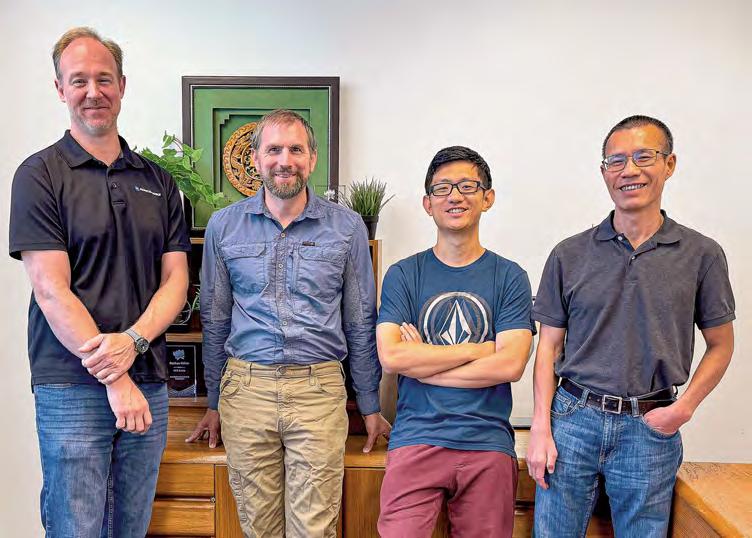
Shure has appointed Ekta Shetty as senior sales director for Africa, the Middle East, India, Southeast Asia and Pacific. Based in the manufacturer’s Dubai office, Shetty will be responsible for driving growth, strengthening Shure’s distribution and channel partnerships, and advancing the brand’s go-to-market and marketing initiatives across the regions. In her new role, Shetty will lead the sales management, market development, channel marketing and customer experience teams across Dubai, India, Singapore and Australia. Shure said that her appointment underscores the company’s commitment to strengthening its presence and accelerating growth in these important markets – building on its
has been appointed sales manager for Japan. They join established sales managers Eric Chua and Chris D’Bais to create a comprehensive sales network designed to further accelerate growth across the region. Under Hammond’s leadership, the application team welcomes Singapore-based Jufri Price, who brings 15 years of hands-on experience as a sound engineer. Manilabased Zohar Pajela joins as application manager, house of worship, boasting key industry experience from Switch Online Solutions and Music Tribe. They join existing team members Chung Wah Khiew, who has been promoted to senior application engineer, along with Frieda Lee, Daniel Lee and Kim Fai Hep. The team is supported by application coordinator Amelia Wong, while Damien Juhasz has been promoted to application manager APAC, consultant liaison.
www.l-acoustics.com
technician and Peng Yin as senior software engineer.
“As a company, it is important for us to continue investing in our core research and development teams,” said Ralph Heinz, chief technology officer at Renkus-Heinz. “We look for individuals who are passionate about what we do, so we can continue to deliver on our commitment to innovation.”
Hai Le brings more than 20 years of experience in embedded software development across industries including storage, networking, medical devices and traffic detection. “I am very excited to have the opportunity to learn about sound whilst contributing to the performance of Renkus-Heinz loudspeakers,” he said.
Robert Newman, formerly technical head at an audio engineering company, has 15 years of experience in professional audio with a focus on transducer design, manufacturing and testing. “It’s a great feeling to step into a role where I can combine everything
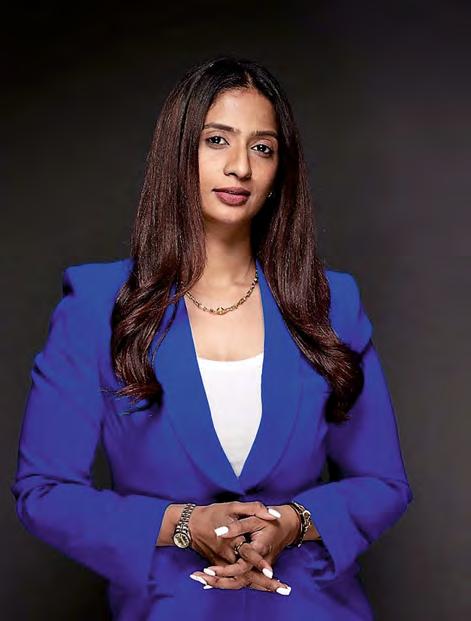
established presence across Africa, the Middle East, India, Southeast Asia and the Pacific while further expanding new opportunities in the collaboration and conferencing sector.
Shetty brings to the role more than 15 years of international leadership experience in the AV and unified communications industries. She previously served at Barco, where she successfully led sales and marketing across the Middle East, Africa and Asia Pacific. During her tenure, she was responsible for streamlining operations, optimising channel programmes and enhancing regional performance.
“I am proud to welcome Ekta to Shure,” said José Rivas, vice president and chief
I’ve learned over the years,” said Newman. “It’s wonderful to have the opportunity to contribute to such an innovative team.”
Peng Yin, who holds master’s degrees in software engineering and civil engineering from the University of California, Irvine, has worked in software engineering since 2016.
“Joining Renkus-Heinz is more than a career move – it’s a chance to blend my passion for software engineering with the art of sound,” he said. “With my background in realtime systems, signal processing and .NET development, I look forward to building tools that support future product development.”
The new hires will work closely with engineering manager Chad DeFranco and the wider engineering team. “I am excited to welcome our new colleagues as strategic additions to the Renkus-Heinz team, further reinforcing our commitment to innovation and future growth,” said DeFranco.
www.renkus-heinz.com
sales officer at Shure. “With her strong sales and marketing expertise, extensive experience and deep network within the AV and UCC industries, we are confident that Ekta will make a significant contribution to our growth and play an instrumental role in shaping our future plans for the region.”
Shetty remarked: “Joining Shure feels like embarking on a new adventure with a close-knit team ready to create meaningful impact and lasting success across the Africa, Middle East, India, Southeast Asia and Pacific markets. I am delighted to be part of Shure’s vibrant community, where collaboration turns ideas into reality and challenges into opportunities.”
www.shure.com


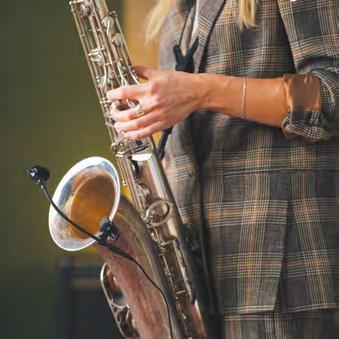
The Miniature Clip Microphone system (MCM) delivers true Neumann sound on stage for wired and wireless operation. Flexible mounting options, fully modular, ultra durable.
TAKE YOUR LIVE EXPERIENCE TO A NEW LEVEL.

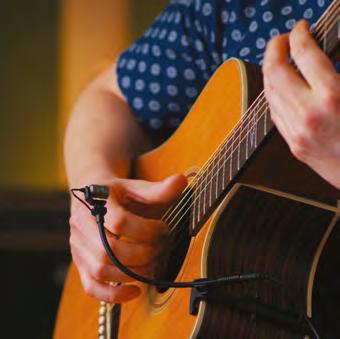

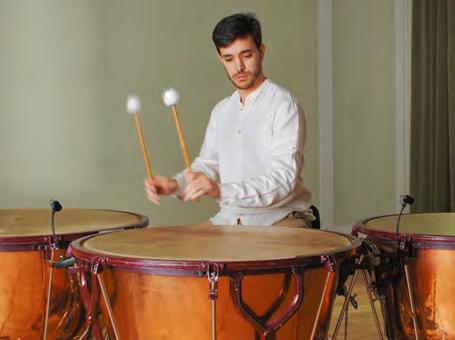
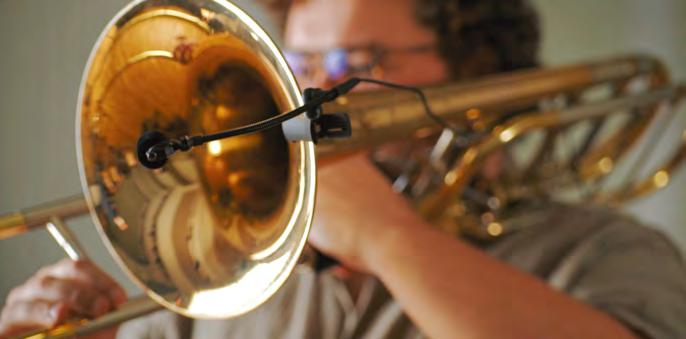
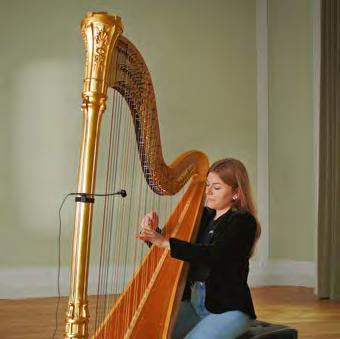
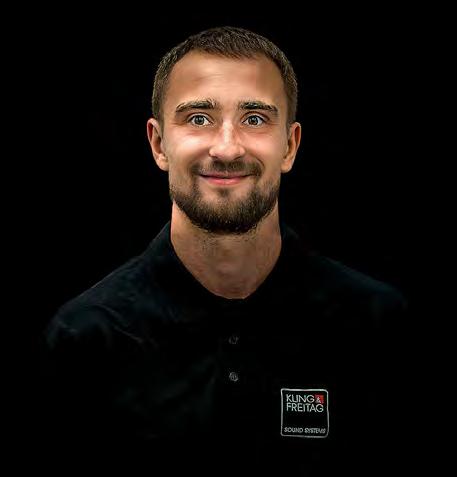
d&b group has announced that, effective 1 January 2026, Amnon Harman will step down as CEO, handing over the role to Jaakko Kaivonen, who currently serves as CRO. The company said that the leadership transition has been prepared to ensure continuity and marks an important step in the brand’s next phase of growth.
Harman will remain closely connected to d&b as a shareholder. After ensuring the transition until the end of the year, he will join the supervisory board in January. “I am convinced that with his experience, international perspective and deep understanding of our customers and culture, Jaakko is the right CEO to lead d&b into a strong future,” noted Harman.

Kaivonen joined the company as CRO earlier this year, where he has been responsible for

global sales and customer activities. d&b said that during this time he has strengthened the company’s international market presence
Strengthening the company’s presence throughout the APAC region, AtlasIED has announced the appointment of Glenn Lin as director of sales, APAC.
With over 20 years of experience in business development and sales across the region, Lin’s career has focused on expanding market presence, building distributor networks and strengthening B2B relationships. Lin will report directly to executive vice president of AtlasIED, Matt Czyzewski.
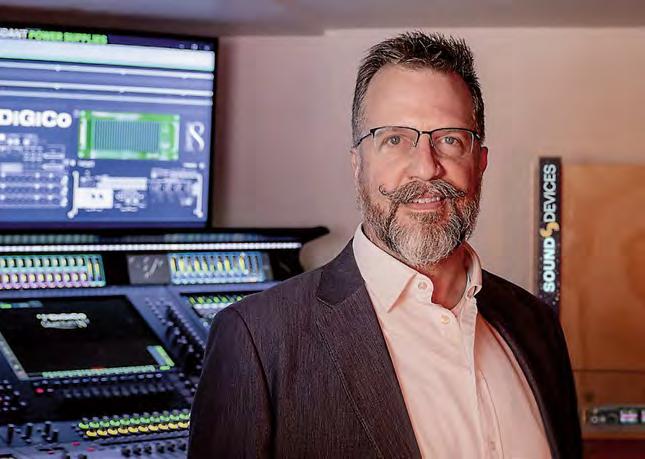

and deepened collaboration with customers and partners. Furthermore, the manufacturer cited Kaivonen’s international outlook, proven ability to lead dynamic growth and clear focus on sustainable development as key qualities needed to guide the business into its next phase.
“I would like to thank Amnon for his trust and close collaboration during my time at d&b so far,” remarked Kaivonen. “d&b has a unique culture, outstanding people and a strong product portfolio. I look forward to working with our customers, the management team and all colleagues to shape the next phase of
“The APAC region is a crucial area for growth for AtlasIED and Glenn’s leadership will be vital in strengthening relationships
and expanding opportunities in these diverse markets,” stated Czyzewski. “His extensive knowledge of the region, combined with a proven record of success, makes him the ideal candidate.”
In his new role, Lin will focus on expanding the manufacturer’s reach across the locales by supporting integrators, consultants and end users, while strengthening the company’s regional sales infrastructure.
“I’ve long-respected AtlasIED’s commitment to engineering excellence and its visionary approach to integrated audio,” countered Lin. “I am particularly energised by the chance to leverage my 20 years in the APAC region
Industry veteran Mike Case has joined PK Sound as director of global network and partnerships. He will report to CEO Jeremy Bridge and lead the company’s growing international network in further expanding the brand’s profile and reach.
Case is backed by a strong history of establishing new technologies and advancing leading brands, including positions at Yamaha Commercial Audio and Digidesign, now

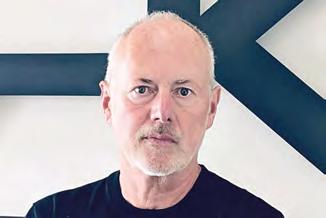

www.pksound.live
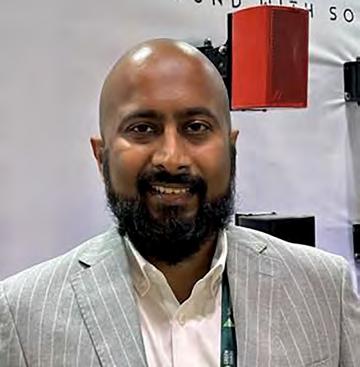

Actual installation using AtlasIED’s Atmosphere platform at The Fig Lobby in Bangkok, Thailand
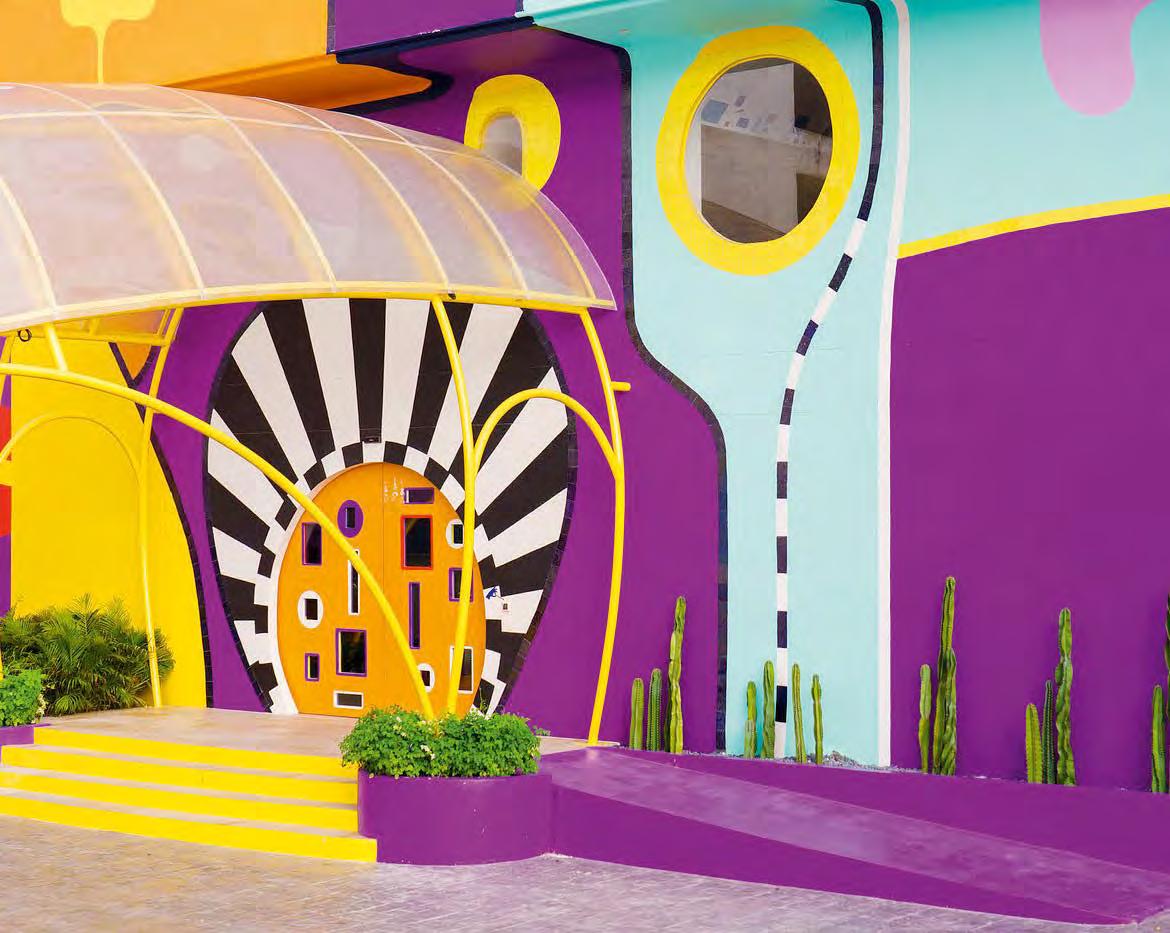






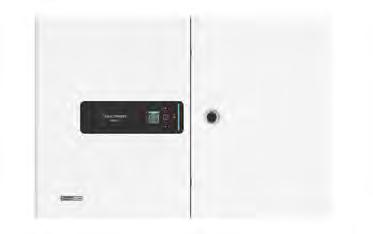






EASY TO USE AUDIO CONTROL TAKES THE GUESS WORK OUT OF
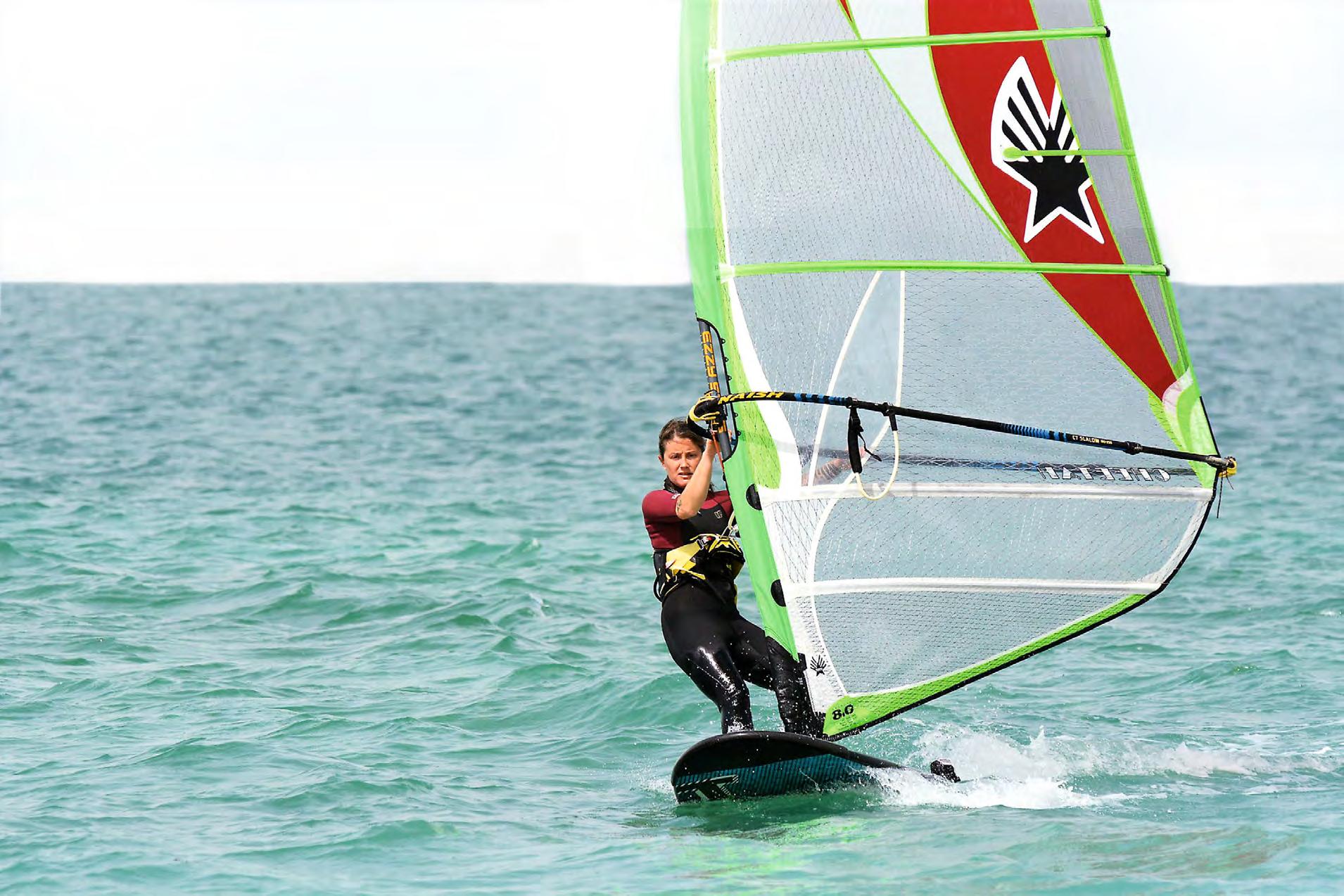
Dubai-based audio specialist Alice Macaluso chats to Bea Meikle about her passion for windsurfing and how it brings her a sense of calm alongside her busy work life
What does your role at Venuetech involve?
As brand manager at Venuetech, I work across both the technical and commercial aspects of several key audio brands we represent, including Meyer Sound and Sennheiser. As a distributor, Venuetech offers a full spectrum of services across the Middle East – from systems design to technical support and training – and I support these projects from multiple angles. Whether it’s working alongside our partners or collaborating with our in-house teams, my role is ultimately about helping bring special audio experiences to life.
How long have you been windsurfing and what first sparked your interest?
I’ve been windsurfing for about 10 years now. It all started quite unexpectedly. I was sitting on a beach in Sardinia, reading a book and occasionally watching the windsurfers out on the water. A man – who turned out to be a seasoned windsurfer – approached me and simply asked, “what are you waiting for?” He must have noticed me watching and sensed my curiosity. That one question was all it took. It gave me the nudge I needed to give it a go and I’ve never looked back.
Where have you windsurfed and is there a destination that stands out?
This hobby has taken me to some incredible places around the world – from beaches across Europe like Greece, Sardinia, Sicily and the Canary Islands, to the Middle East and Africa, including South Africa, the UAE and Oman. Each destination has its own personality. The water conditions, wind strength and local atmosphere all make each spot unique. One place that really stands out is Masirah Island in Oman. It’s very remote and life there moves at a slower, calmer pace. Even the simplest things are done with intention, without any rush. The tide really dictates everything – it decides when you can get in
the water and you just follow its rhythm. That connection to the natural environment – being attuned to its cues – is something I really value. It’s not just a windsurfing spot; it’s a place that brings perspective. There’s something incredibly grounding about that.
Do you prefer to set out on lakes or the sea?
Definitely the sea. The vastness and unpredictability mean I’m never fully in control, which keeps things interesting. The waves do their thing, the wind changes its mind and I just try to keep up without looking too lost.
I’m still learning how to handle larger waves – every break and beach has its own set of challenges. But that’s what makes it so engaging. While I still take plenty of falls, at least saltwater helps you float a bit more easily!
What are some of the most challenging aspects of the sport?
Facing a wave taller than you can be intimidating. In those moments, your only option is to commit fully, hit it with speed, knowing the landing might be rough – or you might not land at all. But that’s part of the process. Each time, you aim to fly a little higher and land a little softer. No matter how many times you fall, you get back up, better prepared for the next attempt.
What do you find most beneficial about being on the water?
Being on the water forces you to let go of total control. It’s a constant, silent conversation between you, the wind and the sea. You have to read the conditions in real time and constantly adjust your approach. Things change quickly out there – a gust can suddenly jump by 8 knots – so it sharpens your awareness and keeps you fully present. And despite all the unpredictability, there’s a calm to it; even in the chaos, there’s a rhythm.
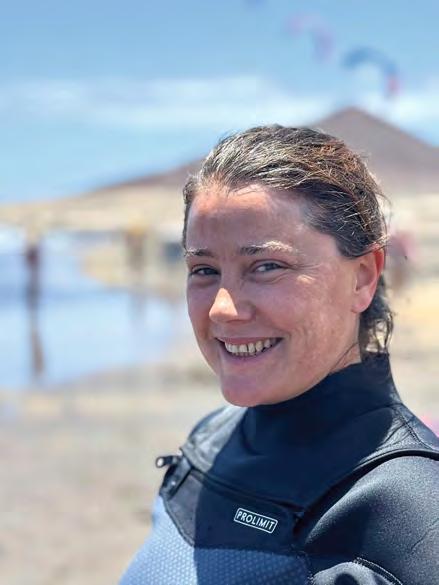
How does it help you unwind from work and daily life?
When I’m out on the water, everything else fades away. It’s one of the few times I feel completely present, its just me, the wind and the sea. It’s a form of active serenity. My head clears without me even trying and I come off the water feeling lighter, more grounded and usually with a few new scratches, of course!
Why is it important to have an outlet like this?
Having a passion outside of work – whether it’s windsurfing or something else – gives you a much-needed reset. For me, it helps me step outside my usual bubble, which I really value. Each session brings a different challenge: sometimes it’s just staying upright, other times it’s trying not to swallow half the sea! Whatever the goal, it keeps me focused and in the moment and helps put everything else into perspective.

INDIA
A new outlet of the Japanese-themed Harajuku Tokyo Café chain has opened in Mumbai’s BKC district with a sound system featuring HH Audio speakers powered by LEA amplifiers. The installation was handled by systems integrator Varun Dua of Bassline AV Technologies, which has installed similar systems into several Harajuku Tokyo Café outlets in the north of India. Both brands are represented in India by Generation AV.
“HH is a very flexible, multiuse brand that fits well for a venue like this, which plays background music during the day as well as DJ music and karaoke in the evenings,” explained Dua. “HH Audio with LEA amplification is a good combination, and we get brilliant service support from Generation AV. I was one of HH Audio’s first partners three years ago, when Generation AV starting representing them in India, and I’ve used them for several pan-Indian chains and retail outlets I work with.”
The main system consists of four white HH Audio TNi-W8 8-inch passive speakers supported by two TNi-W6 6.5-inch speakers used as delay fills and a TNA-1800S subwoofer for low-frequency reinforcement. The entire setup is powered by a single LEA Connect Series 1504 amplifier. Dua
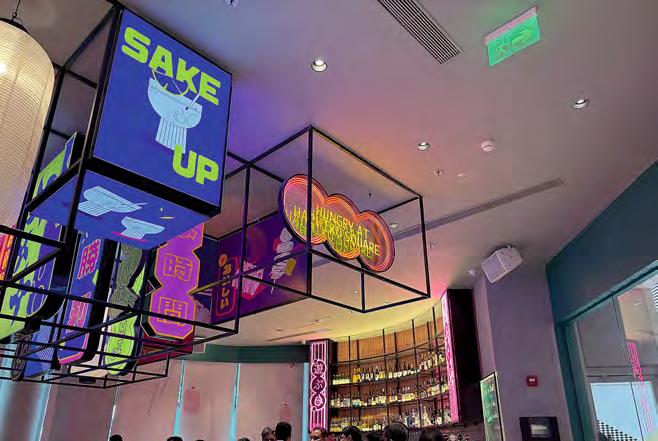
used the amp’s built-in DSP to fine-tune the audio, ensuring optimal coverage in the centre of the room while minimising reflections from the floor-to-ceiling windows. Harajuku’s own playlist sets the tone during the day, with DJ sets for special events. Every Friday evening, a projector screen drops down for karaoke –or “Harajukuoke” – as a mic is passed around to willing participants.
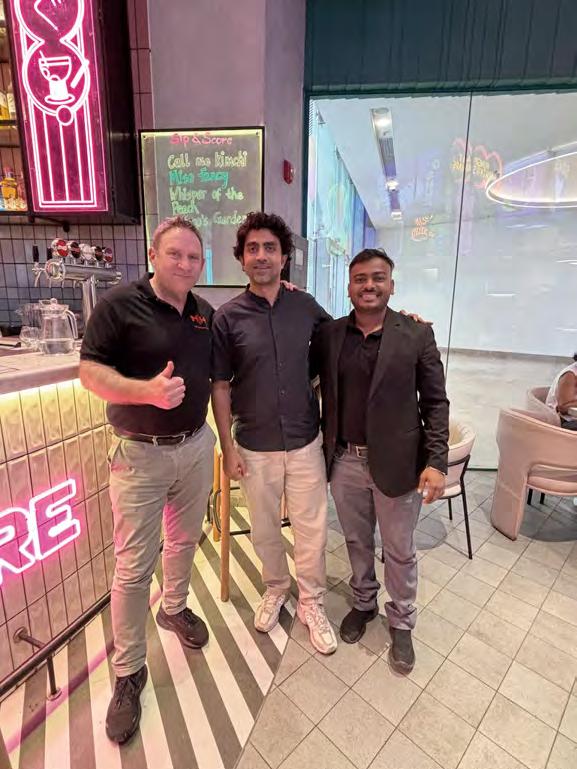
“This is a new concept in India, where Japanese cuisine is typically presented in a formal dining context,” explained Harajuku Tokyo Café marketing manager, Khushe Taylor. “We position ourselves as as fun dining outlet, not fine dining, because we want everybody to enjoy Japanese culture and food.
“We play a mixture of J-pop and K-pop along with other styles of music, and it changes throughout the day. The sound system is very
www.bassline.in www.generationav.net www.hhaudio.com www.leaprofessional.com


Sixteen thousand festivalgoers recently flocked to the Australian outback to enjoy live music performances backed by an L-Acoustics sound system for the three-day Mundi Mundi Bash festival. Turnkey production company Powa designed and deployed the audio solution, selecting the brand’s K Series to deliver consistent coverage across the expansive 60,000m² outdoor concert area.


DESIGNED & ENGINEERE D IN THE UK SINCE 1968
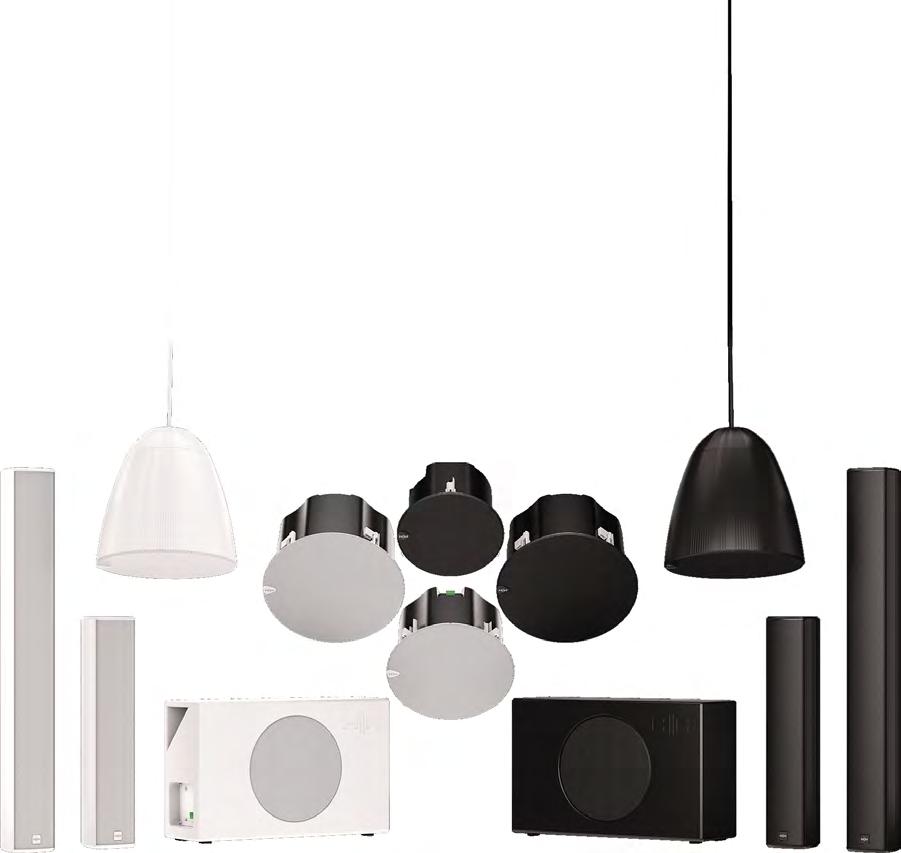
Get your FREE ticket to ISE 2026 and see the range in person. Scan the QR and enter the code ISE260540
DESIGNED & ENGINEERE D IN THE UK SINCE 1968

The HW Superhouse Paskal Bandung live music bar has upgraded its sonic capabilities with the installation of a Martin Audio WPC system. The establishment is one of the many venues under the banner of Indonesian lifestyle and entertainment group Holywings, which owns an eclectic selection of bars, clubs and live music venues across the island’s key cities.
Compared to other Holywings venues, which typically feature point source units, the Bandung bar implemented the WPC line array as main stage hangs. The system was provided and installed by Martin Audio partner GMT Group, with support from the manufacturer’s local distributor PT Goshen Swara Indonesia.
Superhouse Paskal Bandung is a large, near 400-capacity, open-plan venue featuring a centrally set stage. With the venue offering a combination of live band performances and DJ sets, GMT Group recommended the WPC solution to meet
LaON’s Genie intercom systems are providing stability and beltpack expandability for one of South Korea’s major television and radio networks, Korean Broadcasting System (KBS).
The broadcaster, which operates seven radio networks, 10 television channels and multiple internet exclusive services, has implemented the solution for its D control room and KBS Hall, one of the largest halls of KBS.
KBS Hall is where famous shows such as Open Concert, Gag Concert, The Seasons and Music Bank are produced. Previously, the hall had an outdated intercom system and was experiencing challenges related to wireless interferences. Additionally, the size of the crews using intercom systems was getting larger with some of the crew often bringing in their own equipment to use alongside KBS’s in-house setup.
The broadcaster sought a new intercom solution that could guarantee stability, while offering beltpack expandability. The KBS team said that they were impressed by LaON’s Genie system for its ability to perform without any breakups even in congested work environments
performance requirements. The system was conceived by GMT Group’s marketing and technical director, Satrio Prisetya.
Four WPC elements have been installed per side, paired with two SXH218 subwoofers per side in stereo stacks. These are supported by a pair of X15B out fills and four TORUS T1230 for delay, with a further pair each of SX218 and X118B subs for delay.
The audio setup is complemented by advanced lighting systems, stylish industrial interiors and a spacious layout to enhance the clubbing experience. According to the venue’s AVL team, the feedback from customers has been highly positive, with the team noting that their main requirement for the sound to reach every corner evenly has been fully achieved thanks to the WPC units.
www.goshen.co.id www.martin-audio.com
Christie’s HS Series 1DLP laser projectors are powering a new immersive cultural performance at the Three Kingdoms Ancient Battlefield Scenic Area in Chibi Town, Xianning, Hubei Province. Red Cliff: Borrowing the East Wind, produced by Hubei Dingtu Culture and Tourism, and directed by multidisciplinary artist Luo Kege, combines live performances and display technologies to recreate the Battle of Red Cliff.
installed high above the performance area, Jianye Display’s technical team implemented strict safety protocols and used advanced 3D simulation to calculate projection angles and positioning, with the aim of ensuring precise coverage and seamless image blending. To withstand dust, moisture and unpredictable weather, all DWU19-HS projectors underwent rigorous testing to ensure reliable long-term performance in the outdoor venue.

Seven DWU19-HS laser projectors, deployed by Jianye Display, deliver visuals on the left citadel wall and the sails of a large onstage warship, immersing audiences in a reimagining of the Three Kingdoms conflict.
The Jianye Display team said that they chose the DWU19-HS units for their brightness, colour reproduction capabilities and reliability, enabling them to achieve the optimum fusion of light, shadow and storytelling.
Despite demanding conditions, installation of the projection systems was completed in just one month. With some projectors

“We commend Jianye Display for their expertise and dedication in delivering Red Cliff: Borrowing the East Wind,” commented Han Kim, vice president of sales, Asia Pacific, Christie. “Through meticulous planning and flawless execution, they showcased the full potential of the DWU19-HS projectors, bringing history and artistry together in a compelling spectacle. This project is a shining example of how technology and creativity can work hand-inhand to elevate cultural tourism.”
www.christiedigital.com
KBS and the KBS Hall are now equipped with two full Genie intercom systems. LaON has connected the two Base Stations with designated multi-sync cables for IP synchronisations.
“The Genie 5GHz intercom is an ideal solution for our environment as it provides a wide range of RF channel options,” said Byun Yerin, technical manager at KBS. “We currently operate around 20 beltpacks, but can expand flexibly in the future without needing to invest in additional base stations or wireless antennas, which makes our work much easier. The Genie Configuration Manager software is also very helpful. By scanning at each antenna location, we can monitor RF activity, avoid potential interference and switch channels quickly when needed. With so many different tasks to manage, Genie really helps take the pressure off.”






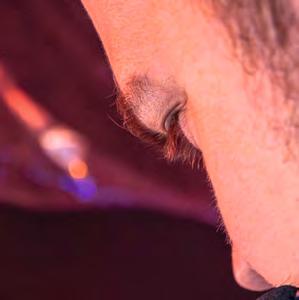



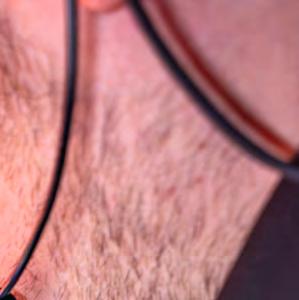

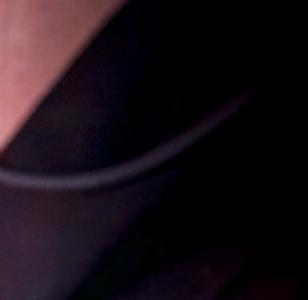


















All the wireless power, audio clarity, and seamless integration you expect from Bolero now in a lighter, smaller form. With proven Boleroperformanceinacompactanddiscreet body, Bolero Mini is ready for any challenge inbroadcast,sports,orliveevents.


















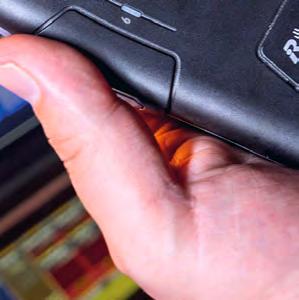


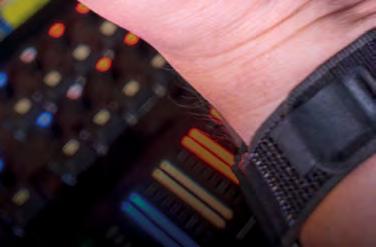



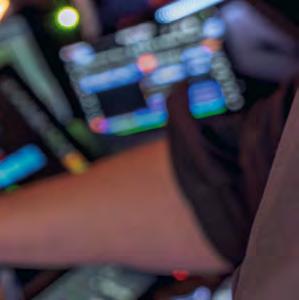

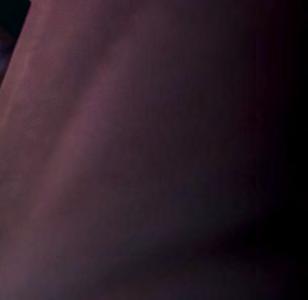


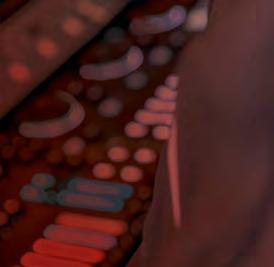





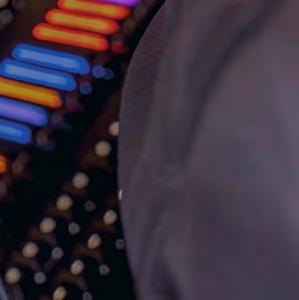



•165g,28mmthin •Touch&GoNFCbeltpackregistration •Bluetoothconnectivity •Riedel-exclusiveAdvanced DECTReceiver(ADR)



VIETNAM
The Royal Lounge at Wyndham Hoi An Royal Beachfront Resort & Villas, located in Da Nang on Vietnam’s central coast, has been outfitted with a Bose Professional sound system, powered by Powersoft amplifiers. The system was co-designed by AVS | AnhDuyen Audio and Universal Procurement Systems Vietnam (UPSV) to combat potential issues posed by the region’s harsh weather conditions,
remains a long-term asset for the venue, all while producing optimum sound quality for events and daily operations. The installation was divided into two dedicated zones. The outdoor zone has been outfitted with Bose Professional’s weather-proof AMU208 full-range loudspeakers alongside one of the manufacturer’s MB210-WR subwoofers. Inside, the Royal Lounge benefits
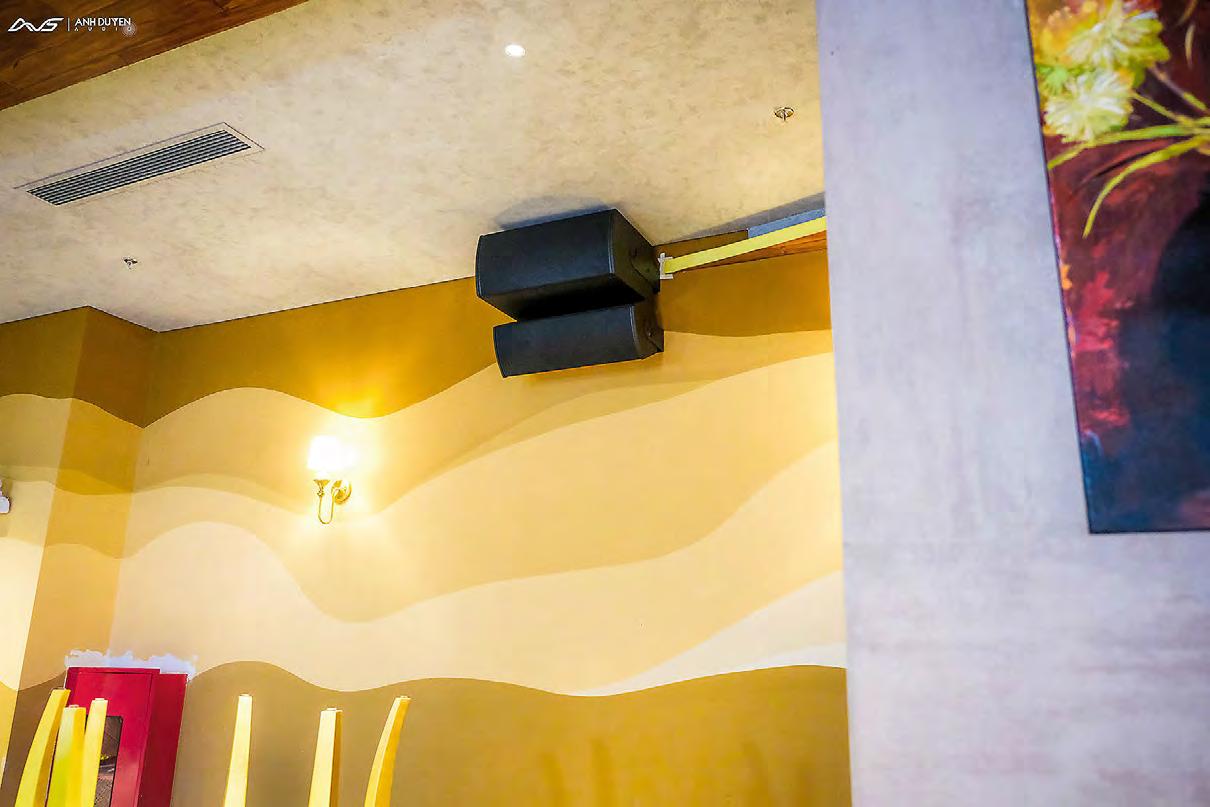

capable of delivering high SPL performance while maintaining clarity and musicality. The Powersoft T604A and T902A units were chosen for their outstanding efficiency, compact form factor and advanced DSP, providing the power and flexibility needed for such a demanding bar environment.”
www.boseprofessional.com www.powersoft.com proaudio.upsprocurement.com

The 12th edition of the JVWF Music Fest leveraged a DAS Audio sound system, deployed by 162 Production to enhance coverage in the outdoor Gadjah Mada University ground. Taking place in Yogyakarta on the island of Java, the music and automotive festival welcomed over 3,000 people for a day of concerts and a large exhibition of classic Volkswagen vehicles.
festival’s parallel activities.
The main PA comprised 24 EVENT210A systems, deployed in an L-R configuration of 12 per side, supported by 18 EVENT-218A subwoofers. Out fills were courtesy of 12 EVENT-210A systems split into two arrays of six per side, while an additional six units were used as centre fill to ensure proper coverage in the front zone of the stage.

Several well-known bands graced the stage including pop-rock group Sheila On 7, melodic pop group HIVI!, alt-rock band Good Morning Everyone and Hunian, an emerging name in the local indie pop scene.
Attracting collectors, car clubs and restoration specialists from across the country, the festival featured an extensive exhibition of classic Volkswagen vehicles, with models such as the Beetle, Kombi and other iconic editions displayed across the university campus. There were also parallel activities including contests, parades and themed camping zones.
For this edition of the festival, Yogyakarta-based 162 Production chose systems from the EVENT series. The objective was to deliver clear and stable audio coverage tailored to the characteristics of the space.
The main technical challenge at JVWF Music Fest 2025 was to ensure even sound coverage in a completely open environment, with large crowds moving constantly between the concert area and the vehicle exhibition zone. Located on the university campus, the outdoor stage required a precise system setup to maintain sound pressure and intelligibility throughout the area without generating excess levels in the outer sections.
In addition, due to the proximity between the main stage and the classic car exhibition, sound had to be carefully controlled to avoid interfering with the
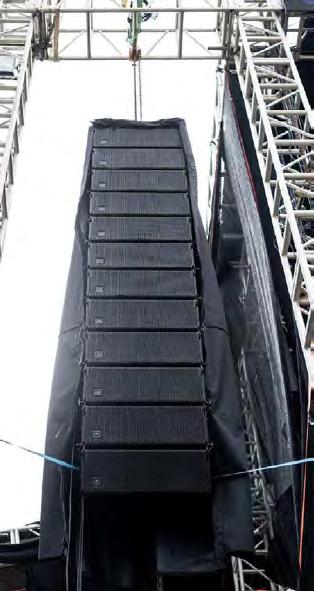
The 162 Production technical team marked the project a major success, praising the EVENT system’s stable performance and clean coverage throughout the whole festival. Furthermore, the team also commented on the DAS setup’s reliability, easy deployment and compact design.
www.dasaudio.com


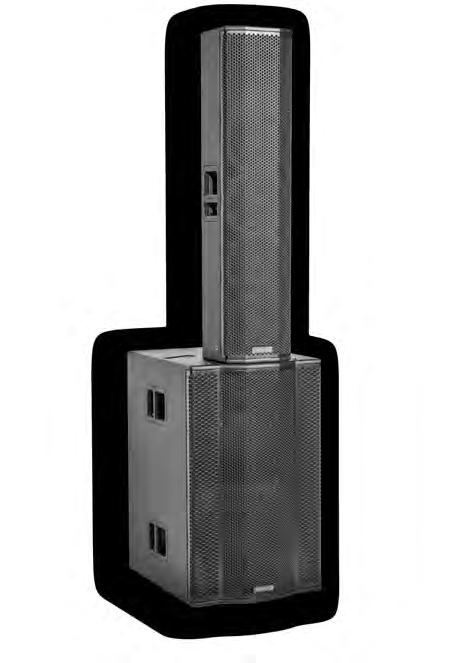




Serving as the headquarters of Carlton Football Club, Ikon Park was the last suburban ground in Melbourne to be used in the Australian Football League (AFL) until its final game in 2005. Primarily used for AFLW (Women’s) since, an AU$50mn extension of the administrative headquarters in 2022 together with the construction of elite training facilities and installation of lights for night matches transformed the landmark. Comprising six grandstands, all built during different phases, the Southern Stand recently required a makeover of its own in the form of a high-powered FBT loudspeaker system.
Clear Systems manager Andrew Bowen has been on hand to service and upgrade the audio systems over the past two decades, including the decommissioned Bose 502 subs that had been configured in a directional array. For the latest iteration of the Southern Stand, Bowen’s design to install 21 FBT Shadow 112HC T speakers was approved. In addition to the IP55 weatherproof properties of the enclosures, the full-range power handling capabilities
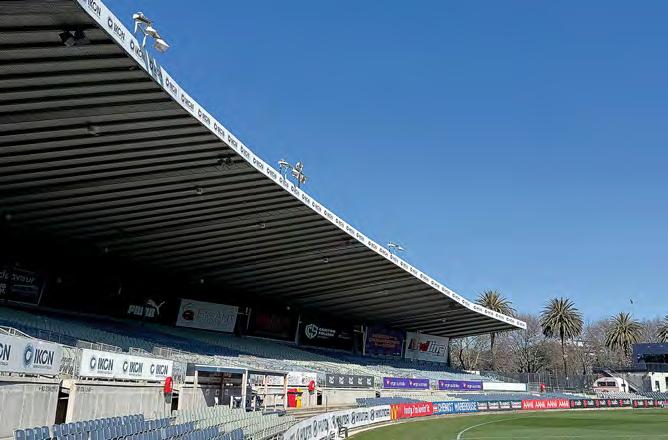
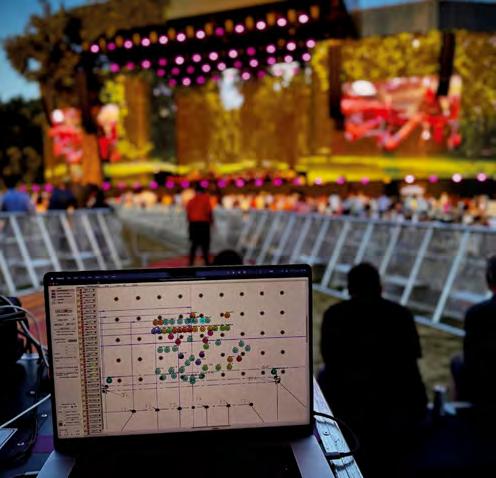
explained Bowen. Routed to each rack in the Southern Stand, Cat6a data cables connect to individual Netgear M4250 10-port managed switches, including the main control room, where the speaker system is controlled and managed from a PC.
In addition, an open section of the stadium adjacent to the recently built Ikon headquarters has been furnished with eight Quest MX801 speakers. Powered by a Dynacord IPX Series amplifier and time-aligned with the other loudspeaker zones throughout the stadium, the weatherproof 8-inch enclosures enhance the message. The audio console, playback and other audio equipment including wireless microphones have been supplied by Rinaldo Entertainment.
“The DSP settings within


programmed to create the desired acoustic results including delays, parametric EQs and remote-control
have specified Dynacord amplifiers,
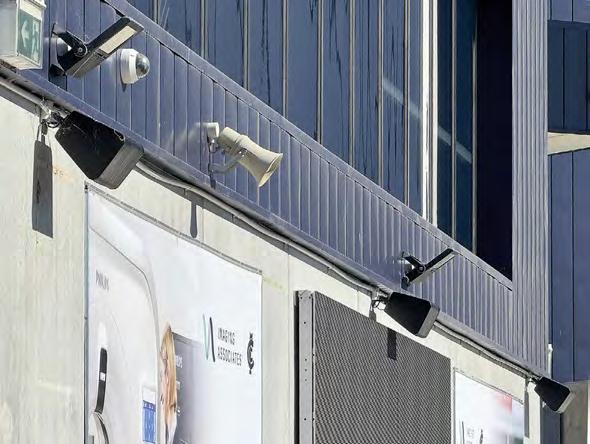
However, they achieved the results to varying attendances at games, volume control of the loudspeakers according to the number of people match, several members of the CFC Board called the stadium operator,


genelec.com/8380a
Located in China’s Zhejiang Province, Yunhe has earned a national reputation as the country’s “Wooden Toy Town”, but its cultural offering now extends well beyond handcrafted playthings. At the heart of Yunhe’s Fairy-Tale Castle complex sits the 696-seat Fairy-Tale Theatre, a multifunctional venue that has recently invested in two DiGiCo Quantum 338 mixing consoles to elevate the sonic quality of its performances.
Supplied by Chinese distributor Rightway Audio Consultants (RAC), the consoles have been installed to provide a fully mirrored system with redundancy and synchronisation between both surfaces. One console is designated as the primary mix position, while the second serves as a real-time backup, with the aim of ensuring uninterrupted audio for every production.
“Yunhe Fairy-Tale Theatre benefits from exquisite architectural design and visitors will be impressed by the modern, minimalist style,” explained Zhao Haozhi, deputy manager – product department, RAC. “The

Tetra Pak, a global provider of food packaging and processing solutions, has opened its technology-enabled Customer Innovation Centre (CIC) in Bangkok boasting an experience centre with interactive content and visuals designed to impress visitors. The space features a comprehensive AV solution designed by Esco Thailand with Netgear switches serving as the critical networking foundation.
dual 4K camera system, LED panels and a large 105-inch display, alongside professional audio systems and unified communications capabilities. The result is a meeting space that connects physical and virtual participants with broadcast-quality audio and visuals.
Serving as the backbone of this system are Netgear’s AV switches which connect all the displays, cameras, microphones and speakers

Located at Tetra Pak’s Thai office in the Bhiraj Tower at EmQuartier, the new centre needed to accommodate diverse functions across 10 interconnected spaces, including multiple meeting rooms, demonstration zones, a collaborative workspace, an experience centre for visitor engagement, plus digital signage throughout.
The goal was to create a functional audiovisual environment to support a wide variety of demonstration and collaboration scenarios, while providing a compelling “wow factor” for visitors. Esco said that its technology selection proved particularly critical to the project’s success, with each component chosen based on three key criteria: enterprise-grade performance and reliability, seamless integration capabilities and user-friendly operation.
The final solution comprises multiple high-end displays, including an 85-inch 4K touchscreen,
throughout the system. The manufacturer’s M4250 switch is specifically used for Dante audio networking, enabling it to carry highquality digital audio signals over standard network cables, eliminating the need for separate audio cables between equipment.
“Netgear’s networking solutions have played a critical role in ensuring reliable, highperformance connectivity throughout the centre, enabling smooth collaboration and real-time innovation,” said Rahul, senior consultant at Tetra Pak. “We greatly appreciate the invaluable support of Esco and Netgear throughout the project. Their expertise was instrumental in making sure every part of the CIC works harmoniously.”
www.esco.asia www.netgear.com
team insists on high standards, so the Quantum 338 was a natural choice. The result is truly next-level – no matter what type of performance is showing, the sound system is well-suited to deliver a fairy-tale experience.”
The first show to benefit from the upgraded system was Hymn of the Earth, performed by the China National Opera & Dance Drama Theatre Traditional Music Troupe. The debut production served as a proof point for the theatre’s new capabilities, receiving praise for its clear, immersive sound.
“We are proud of the work we do with venues like Yunhe Fairy-Tale Theatre,” Zhao concluded. “Seeing the benefit of investing in great tools like DiGiCo and the transformative effect that can have on the creativity of theatre shows is very rewarding. Alongside DiGiCo, we will continue to support the theatre’s performances with excellent audio technology, helping Yunhe’s cultural vibes to shine brightly.”
www.digico.biz

Ideal Systems has delivered the Ministry of Education (MOE) Malaysia’s first fully remote NDI live production, streamed via EduwebTV. The monthly assembly, held at Putrajaya Government Hall, was switched and controlled entirely from Ideal Systems’ Studio 3 in Bukit Kiara, 40km away, using an end-to-end IP workflow.
The production used NDI Bridge (NDI Tools v6) over a dedicated 1Gbps symmetrical line, enabling real-time multicamera switching, live graphics and simultaneous streaming with sub-1s latency. Ideal Systems managed the full project lifecycle, including systems design, network planning, equipment setup, crew training, live support and post-event reporting.
The venue setup featured five NDI-enabled cameras: two Bolin PTZs, two BirdDog PTZs and a Panasonic ENG. Slides were projected to the LED wall via a vMix system over NDI and audio was sent from the venue mixer as an NDI stream. PTZ camera control was handled remotely using NDI Bridge, with all feeds and control data routed through Netgear S3300 switches.
In the remote control room, operators used a TriCaster TC1 Pro for switching, overlays and
streaming. Graphics included titles, lower-thirds and a sign language interpreter window. Return video was delivered to Android devices used by camera operators for tally and framing. Intercom and mix-minus IFB were also transmitted via NDI. During the event, congestion on the government’s internal network reportedly caused bursty packet loss. Ideal Systems engineers increased the NDI buffer from 300ms to 400ms to maintain stability.
“Having the PTZs 40km away felt natural and the programme stayed rock-solid,” said Fizzi Kamarul, technical and operations support engineer at Ideal Systems.
MOE’s head of technical production, Nuurul Akmal Razali, said: “Based on this proof of concept, we are confident that NDI technology brings tremendous value to the MOE.” Ideal Systems noted GPU scaling will be important for future deployments, with six inputs already pushing utilisation beyond 90%. According to the team, the project delivered a repeatable, scalable remote production model for MOE events nationwide.
www.idealsys.com
Tokyo Metro has installed Blackmagic Design ATEM Mini Extreme ISO switchers and HyperDeck Studio HD Plus broadcast decks at its central training facility situated in the Japanese capital. The equipment is being used to support in-house video production, alongside regular staff training sessions on DaVinci Resolve Studio.
Tokyo Metro operates nine subway lines and 180 stations, serving more than 6.8 million passengers each day. Its central training centre provides education and practical exercises for employees across different roles, from administrative staff to train operators. The facility includes classrooms, mock stations and simulation areas.
In 2023, the operator added a dedicated broadcast studio within the centre, including chroma key capability, an editing booth and a recording space. The move followed the global pandemic, during which the company had to adapt training delivery methods to remote
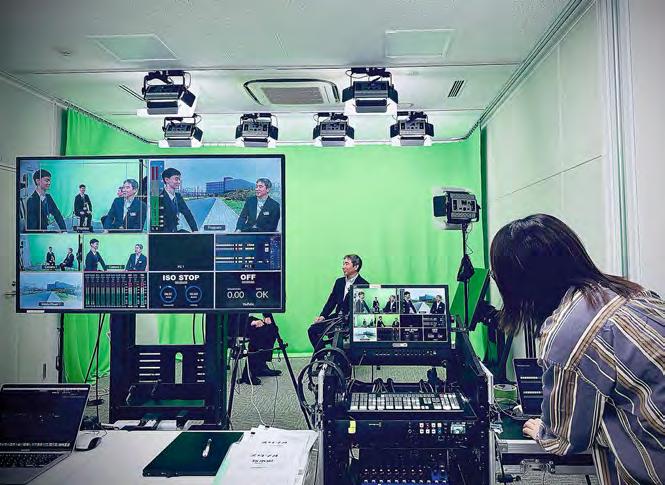
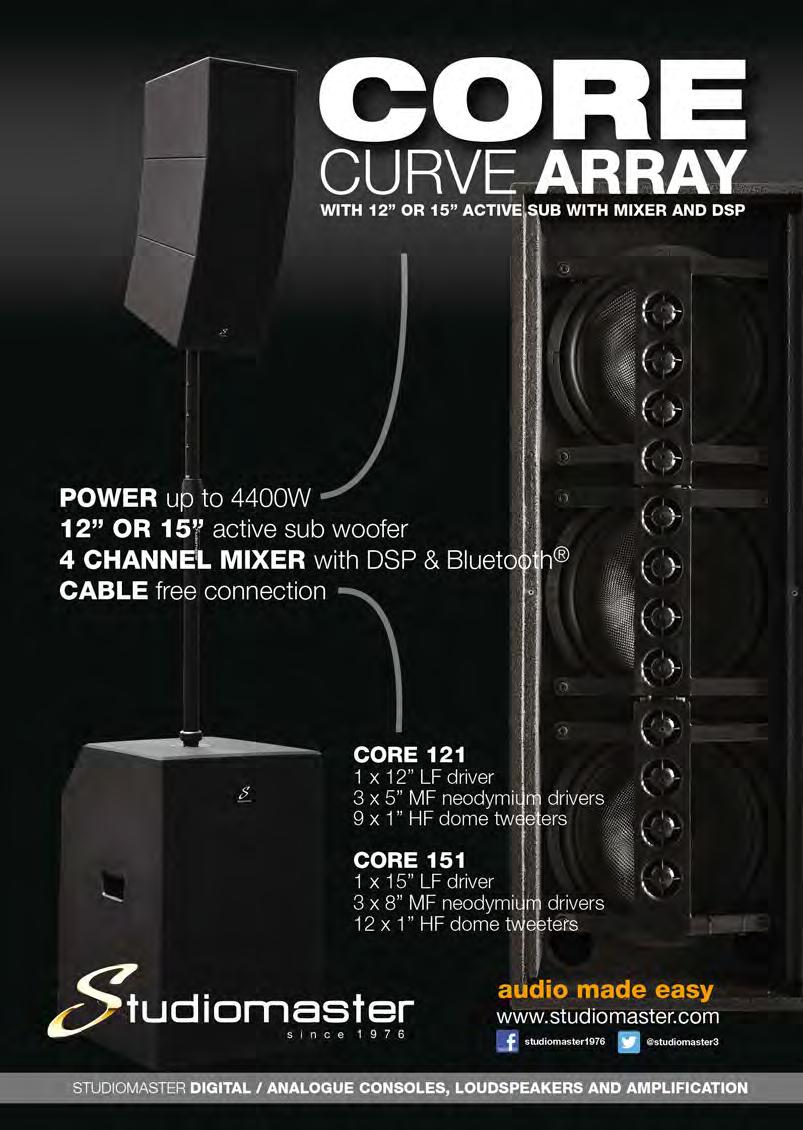
formats. The new studio continues to be used for creating training videos and livestreaming. The studio setup integrates two HDMI cameras, an audio mixer and a MacBook Pro with the ATEM Mini Extreme ISO, with the HyperDeck Studio HD Plus used for recording. Backgrounds and presentation material can be composited live, while the ISO recording feature allows postproduction adjustments in DaVinci Resolve Studio.
Tokyo Metro also provides annual DaVinci Resolve training for staff, with more than 100 employees taking part over the past two years. Some departments have already used the facility to produce collaborative training materials, incorporating graphics, text and transitions. The training centre plans to expand access to the studio, with workshops to enable employees to operate the equipment independently.
Following its relocation to new offices in Wanchai, content management solutions provider HeterMedia has upgraded its meeting facilities with Sennheiser TeamConnect Ceiling 2 (TCC 2) microphones and TC Bar M
The TC Bar M integrates a 4K camera, microphones and speakers into a single device, supporting Dante I/O and control integration, while the TCC 2 ceiling microphone offers flexible room layouts with clean, cable-free tables.

conferencing devices. Carried out in partnership with local integrator Komstadt Systems, the installation included two TCC 2 units for a VIP 2-in-1 meeting room and two TC Bar Ms for medium-sized meeting spaces.
“Before moving to our new office, we struggled with hybrid meetings that were constantly delayed by tech glitches,” said Ellis Tsui, management executive of HeterMedia. “Everything changed when we installed the TC Bar M.
The 4K Ultra HD camera paired with Sennheiser’s stereo speakers now deliver crystal-clear quality – it’s like having everyone in the room. The Auto Framing feature is an absolute game-changer.”
“Setup is a breeze,” added Tsui. “We just plug in the USB cable and we’re good to go. When we do need tweaks, the Sennheiser Control Cockpit software lets us fine-tune settings in seconds. Honestly, this sleek bar has become our secret weapon for productive meetings.”
HeterMedia primarily serves financial and corporate clients, specialising in disclosure, marketing collateral, digital media projects and translation services. The AV upgrades form part of its wider strategy to enhance digital communication and client engagement.
www.sennheiser.com
Jungle Adventure Play Centre (JAPC) has implemented an Optimal Audio ecosystem for its second location in the suburb of North Lakes on Australia’s Sunshine Coast. The installation was carried out by Brisbane Sound Group (BSG), with local distributor Audio Brands supplying the system.
Having previously fitted out JAPC’s first venue in Tingalpa, BSG was no stranger to the acoustic challenges of Jungle Adventure. Serving as a space for kids to run wild while parents enjoy the tranquillity of the nature around them, the centre’s team sought an audio system to support every moment. They chose the Optimal Audio solution for its simplified control and management, as well as coverage capabilities for the expansive venue.
The team used the placement of the already installed play equipment – including ball pits, climbing structures and safety nets – to help define JAPC’s 12 zones. “Accessing walls and ceilings was a real puzzle in this environment,” noted BSG’s installation and projects manager, Josiah Kerridge. “Working with the physical obstacles, we created consistent coverage and clarity across every zone.”
Despite limited access during the build, BSG and Audio Brands collaborated to ensure the best product choices and speaker placement. “Audio Brands were fantastic,” said Josh Bonnici, operations and marketing, BSG.

“They helped narrow down the
and amps for every zone and were always quick to support us.”
mounts weren’t possible, Cuboid 6 units were placed to take advantage of the 130° x 120° dispersion. The system is driven by SmartAmp 10 and SmartAmp 20 amplifiers, featuring onboard DSP to enhance configuration and balance performance across all zones. To position the amps safely away from the play areas, BSG deployed a Dante audio network using the building’s existing cabling.
The 12 focused zones were configured to deliver intelligible, energetic audio without bleed. Control is centralised via a wall panel at reception, with additional panels in key locations. Paging and emergency messaging can cut through instantly when needed. “Clarity and control were essential,” added Kerridge. “This isn’t just about loud music – it’s about keeping the space safe, connected and enjoyable.”
According to BSG, Jungle Playground was a significant project for the group, best known for its live event production. “This project really mattered to us,” Kerridge concluded. “It’s helping change perceptions – showing we’re just as capable in integration as we are in production. And we’ve got the right people and the right partners to do it.”
www.audiobrands.com.au www.brisound.com.au www.optimal-audio.co.uk








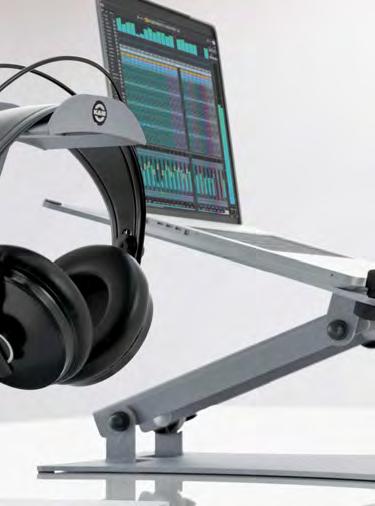



Celebrated Thai rock band Potato recently returned to the stage following a six-year hiatus for five live shows at One Bangkok Forum. Local distributor Sonos Libra supported the tech crew for the concerts, delivering a PA system backed by DirectOut’s PRODIGY.MP multifunction audio processor.
The audio setup for the POTATO HEAD CONCERT performances was designed to ensure that fans could enjoy the music with the utmost clarity. Sonos Libra equipped the venue with speaker systems arranged across six dedicated zones, positioned from the sides of the stage to the centre and upper levels. For balanced sound coverage, each zone was fine-tuned to ensure that every listener – from the front row to the

A 1,000-capacity auditorium and an 80-seat conference hall at the Anna Centenary Library in Kottarpuram, Chennai, have recently undergone technical refurbishments, with both spaces installed with Proel Commercial Audio and Axiom loudspeaker, DSP and microphone systems. The upgrade was carried out by Chennai-based distributor and systems integrator Silicon Radio House (SRH). The library, inaugurated in 2010, was built to celebrate the anniversary of former Chief Minister of Tamil Nadu, Dr C N Annadurai (“Anna”), who had a deep interest in books and literature.
“For the auditorium, we’ve used six Axiom AX2065P line array modules and one flyable SW215 subwoofer per side to provide uniform coverage and intelligibility across the venue, as well as some audio richness,” said SRH’s V R Rajashekaran. “These were all major requirements, as the auditorium is used by the Government of Tamil Nadu for speeches, cultural events, music and drama.” The systems are powered by five Proel HPX6000 amplifiers and controlled by a Proel PA DMP88 DSP unit. SRH also provided six Axiom CXL12A active stage monitors, three Proel Eikon Aether RM1 wireless microphones, one RM1H lapel mic, two PA BMG2 gooseneck mics, six Eikon EKD9 cardioid microphones and a PreSonus
StudioLive 32SC 32-channel digital mixer with two NSB stageboxes.
“The client appreciates the clear sound and is very satisfied with the Axiom speaker system,” continued Rajashekaran. “This is the third prestigious auditorium project I’ve done with the brand in Chennai, following Valluvar Kottam monument and the 150-year-old Don Bosco School.”
SRH also integrated a new AV system into the library’s 80-seat conference hall. A Proel PA BMCD chairman microphone with 59 BMDD delegate units handles meetings, while nine XE65TB wall-mount speakers relay audio around the room. There are four Eikon Aether RM1 wireless microphone systems with UHF antenna distribution and a dedicated Axiom speaker for press use. For videoconferencing, the hall features an LG display, Optima projector and Milestone Systems software. The multipurpose space regularly hosts meetings, press events, motivational sessions and student presentations.
SRH has built a trusted relationship with the government-owned establishment and has entered into a technical maintenance contract for both newly renovated spaces.
www.commercialaudio.proel.com www.siliconav.net

second floor – experienced the same level of impact and detail.
At the heart of the audio system was the PRODIGY.MP processor which converts MADI signals from the front of house mixer console into AES3 for the speaker amplifiers. In addition to signal conversion, it also manages advanced processing for multiple clusters, including independent FIR EQ adjustments, allowing for more precise control. “With this setup, the concert delivered an unforgettable, worldclass sonic experience,” noted Sithikarn Buhngarueang, operations manager at Sonos Libra.
www.directout.eu
www.sonoslibra.com
Located at the heart of Springvale’s cultural and commercial district, Saigon Rex has built a strong local following that goes well beyond its compact size. Known for its Vietnamese and Chinese cuisine, the restaurant has also become a popular space for contemporary Vietnamese events and private functions and is now enhanced by a new RCF sound system.
subwoofers providing low-end reinforcement. Six NX 32-A loudspeakers are wall-mounted around the room to extend coverage, while a circular truss supplied by JD’s frames the stage and houses the main lighting fixtures. Two NX 15-SMA monitors serve as stage foldback.
Installation was handled by Canh Le, one of JD’s regular installers and a respected figure

Formerly Maxim Saigon, the venue has long been a fixture for live entertainment, weddings and social gatherings. With a stage backed by a full-height LED screen and an expandable dancefloor, the restaurant regularly transforms into an event space. As part of its recent rebrand, the Saigon Rex team chose to highlight this heritage, investing in new AV technology including lighting, décor and a professional audio system from RCF.
Supplied by JD’s Sound and Lighting, a Melbourne-based specialist in audio, lighting and staging, the new setup features an RCF HDL 26-A line array system. The design was led by Mike Nikitiuk, JD’s sales and project manager, with support from Jeff Drabik, the company’s managing director.
The FOH system comprises four HDL 26-A modules per side, with two RCF SUB9006-AS
in Melbourne’s Vietnamese entertainment community. His understanding of both the technology and the venue’s cultural context helped ensure the system was optimised for a wide range of events.
“Saigon Rex were looking for a big, bold sound that really turns heads, with substantial coverage in a room where space is at a premium,” explained Nikitiuk. “As reliability and longevity are always core priorities for us, we suggested an RCF line array. The HDL 26-As deliver perfectly within the room. They sound fantastic – even a little excessive – but that’s exactly what the client wanted: a serious amount of power to really impress, with the added benefit of all that extra headroom for different kinds of events.”
www.jdsound.com.au
www.rcf.it









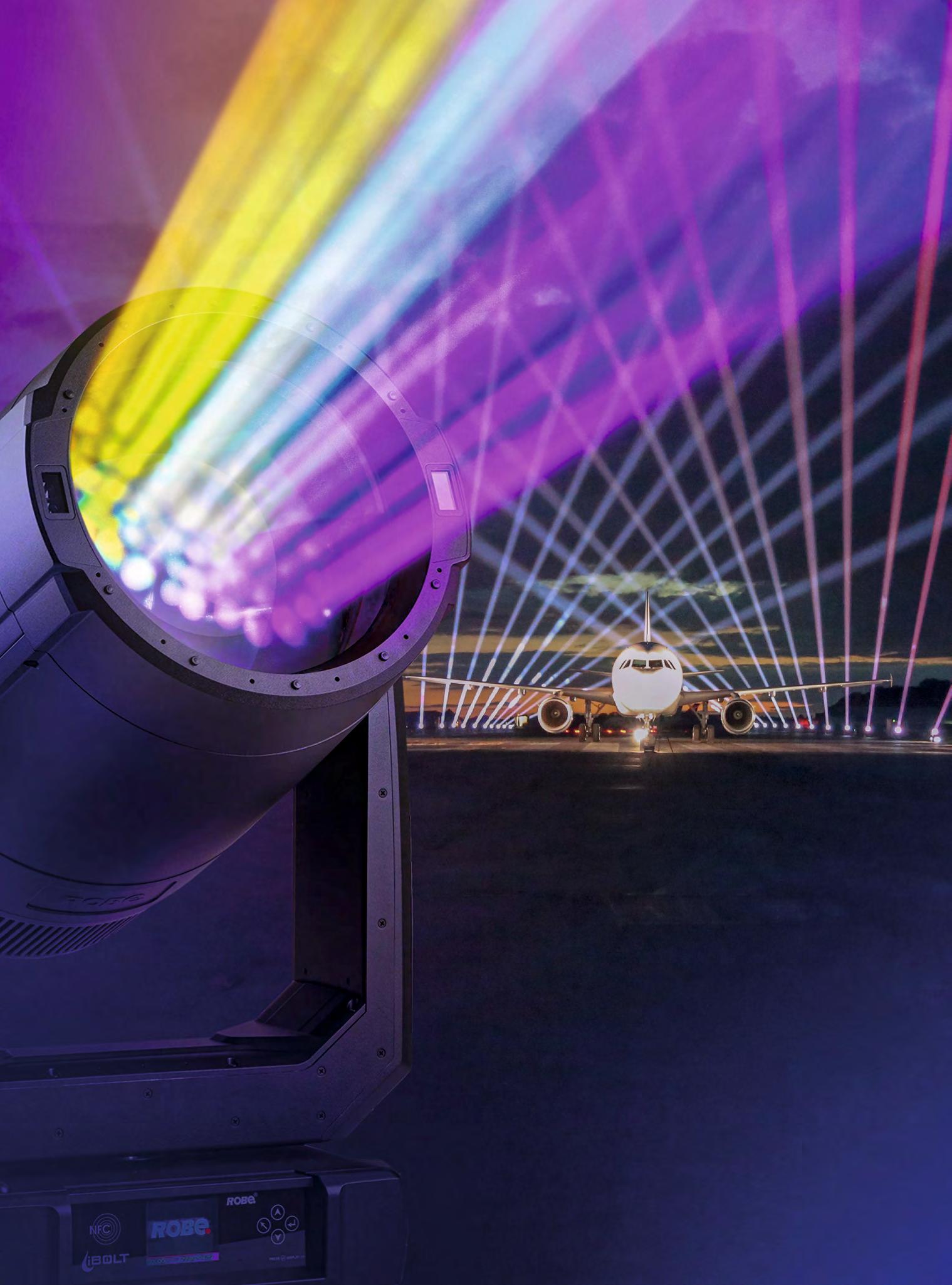
From searchlight to skyower, beams to effects, it does it all!


Sport Nation has launched a new broadcast studio in Auckland, equipped with Lawo and Densitron technology supplied and integrated by Professional Audio & Television (PAT). The facility marks a major step forward for the sports media platform,
designed for multiplatform production across radio, video and digital.
At the centre of the installation are Lawo diamond radio consoles with 18-fader desks, supported by Power Core engines for DSP, I/O and routing. Additional flexibility
is provided by Lawo VisTool touchscreen interfaces and crystalCLEAR virtual consoles, enabling custom workflows and remoteready operation. Studio control and branding are managed through a Densitron IDS system, covering signage, lighting, clocks, countdowns and camera triggers. On-air talent benefit from Densitron ProDecks, giving control over microphones, headphones and talkback channels.
PAT designed the technical backbone for the facility, including Arista switch fabric to handle the IP infrastructure and iHSE KVM systems for seamless access to critical computers.
“We are extremely pleased with the outcome of this project and the collaboration with PAT and its manufacturers,” explained Michael Tompkins, head of technology, Entain Media. “Having a trusted local technology partner on the ground in New Zealand who understands both our
requirements and the solutions has been invaluable in ensuring a smooth and successful implementation.”
Radio host and executive producer Riccardo Ball described the upgrade as “like night and day”, adding: “It enables us to create content that wouldn’t have been possible before. Seamless integration between traditional radio, social media and even TV content is now possible. This is huge for the brands we represent in New Zealand.”
Mike Heard, head of technology at PAT, called the project “another chapter in the highly successful collaboration between Entain and PAT”, adding that the solutions provided would support Sport Nation’s broadcasting capabilities for years to come.
www.densitron.com
www.lawo.com
www.proaudiotv.com.au
Prime Sound Studio Form, part of Japanese label Avex, has upgraded its flagship Room 1 with a Genelec retrofit, which included transforming its 1035A main monitors into the latest 1235A Smart Active Monitoring models. The recording studio has played an integral role in the country’s music industry for more than two decades and its five-room complex has hosted countless hit productions.
According to recording engineer Koji Morimoto, Room 1 has been long defined by the presence of Genelec’s 1035As. “They were the face of the studio,” he said. “Back then, we tried a few options, but the 1035A just felt right. It became our standard.” When the time came to modernise, the team opted for a retrofit that retained the enclosures while upgrading the internals to the 1235A specification. “I’d first heard the 1035A back at Victor Studio in the late 1980s,” explained technical engineer Yuhiko Utsu. “At the time, no two large monitors sounded alike – you’d spend days tuning. But the 1035A didn’t need that. It was a revelation.”

The retrofit has delivered Class-D amplification, lower noise and introduced Genelec’s Smart Active Monitoring technology. “The S/N ratio has drastically improved,” noted engineer Yuji Tanaka. “We
Taking place at the Rizal Park Open Air Auditorium in Manila, Kolin Tanlin’s recent lighting show event leveraged an immersive sound system centred around Audiocenter’s AVANDA series.
The spectacle utilised a range of stage lights from the distributor’s inventory which were precision-synced to timecode by lighting engineer Patrick Vianzon and his team under the guidance of technical director Jay AR, who handled the stage production. To complement the light show, Audiocenter’s senior application engineer Roshan Malim designed a surround sound system to envelope the audience in an immersive audiovisual experience.
The audio setup comprised 12 AVANDA 210A line arrays, six per side, as main FOH loudspeakers. These were paired with eight AVANDA 218A subwoofers in a cardioid configuration and supplemented by GT512A 12-inch active point source speakers as surrounds.
According to Malim, to combat challenges posed by the venue’s outdoor setting, he strategically tuned and calibrated the AVANDA units to ensure optimum sound quality for the event.
“As the system engineer for this event, it was an absolute pleasure to work with such an exceptional team and technology, bringing the entire production to life,”
used to hear a faint hiss. After the upgrade, it was gone.”
Morimoto explained that the retrofit allowed the team to upgrade all the drivers, but that the sound of the 1035A’s high end is still
their reference. “We asked if it was possible to retain the original HF driver and Genelec said yes,” he noted. “They even rewrote firmware and updated the PCBs to make it work. That level of manufacturer support is rare.” Utsu echoed those sentiments, stating how the Genelec Japan technical team still visit the studio and provide direct assistance. Following installation, calibration was carried out with GLM software, starting with the AutoCal automatic algorithm before finetuning by ear. Utsu noted how GLM helped solve a structural issue: “Because it’s a floating floor, the front-heavy 1035A had caused the baffle to tilt slightly over time. However, GLM can easily correct such issues. So even if various changes occur over time, we can fix them.”
For Tanaka, the change has been transformative: “The quality has improved, even in the parts you don’t see. It’s still our studio, just sharper and more refined, and we hope our clients can feel that difference.”
www.genelec.com
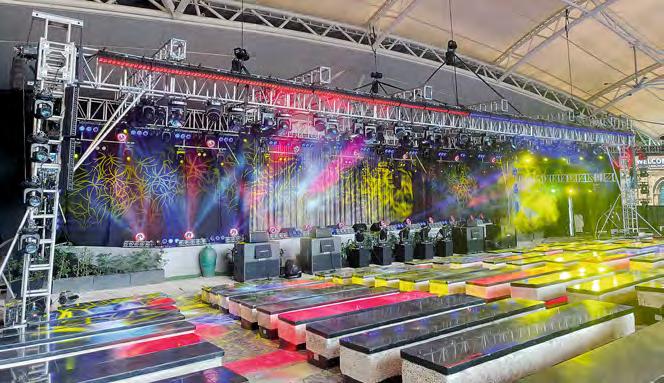
Designed and built in the UK, Ten Squared (Ten2) is a range of premium, low frequency loudspeakers. Engineered without compromise, they deliver consistently superior levels of performance in the most demanding professional sound reinforcement applications. All the time. Every time. 18, 21 and 24-inch models available.
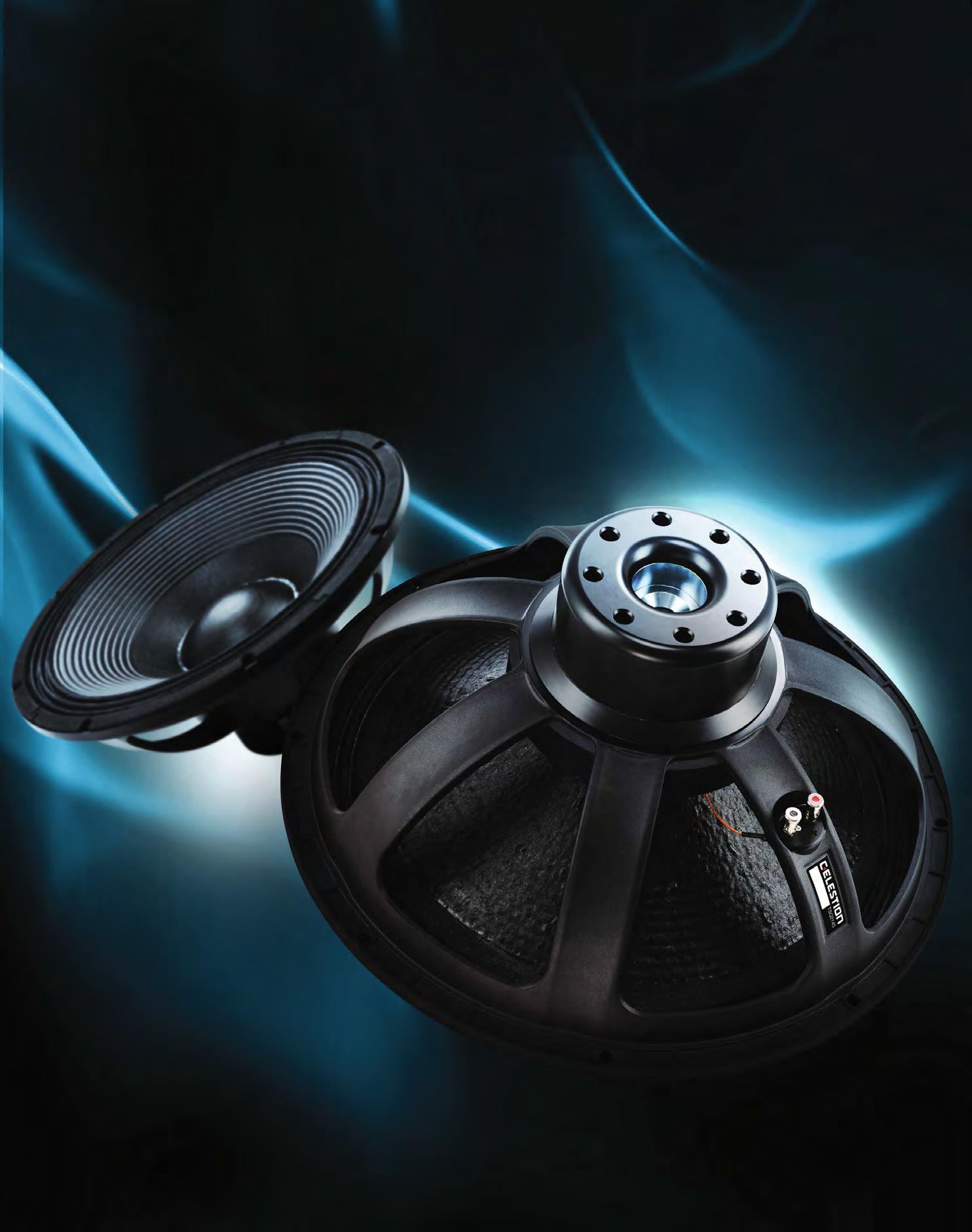
Discover Ten Key Features that add up to a new standard in LF driver performance celestion.com
Shanghai Legoland Resort has introduced Bolin Technology’s N2-220X NDI PTZ cameras to pick up small movements and facial expressions during hands-on creative workshops for children. The immersive resort recently opened as China’s first Legoland park and, spanning 318,000m2, it is also the theme park franchise’s largest location in the world, built with over 85 million Lego bricks and featuring over 75 rides and attractions. Inside the park, six creative workshops allow children to participate in hands-on model building activities. Professional Lego instructors guide participants through construction techniques, encourage creativity and teach problem-solving through play. Each workshop is designed to be both educational and immersive, with multiple learning zones and group tables arranged throughout the space.
However, the size and seating layouts of the workshops present visibility challenges as children seated at the back or sides of the room often struggled to see the instructor’s hand movements or facial expressions during live demonstrations,
hindering learning outcomes. The objective was to find a way of providing every
In turn, the resort installed Bolin’s N2-220X NDI PTZ cameras for each of the six

child with a clear view of the instructor’s demonstrations, ultimately improving clarity, engagement and accessibility.
creative workshops. The cameras have been positioned to capture detailed views of the instructors and transmit them to large
displays around the room. Equipped with Sony image sensors and precision optics, the cameras reproduce Lego’s colours and capture subtle hand movements, even under mixed indoor lighting conditions.
The cameras’ smooth pan, tilt and zoom functionality enable staff to reframe shots in real time to follow instructors as they move between different areas of the workshop.
Furthermore, the N2-220X NDI PTZ units’ NDI transmission provides low-latency video output that enables children to see every movement onscreen at the same time it is happening in front of them.
In addition to enhancing visibility for children, the new camera system has provided instructors with a new freedom of movement. They can now walk naturally around the room without worrying about whether every child can see them, knowing the cameras will capture their actions and display them on the screens, creating a more dynamic, responsive and enjoyable workshop experience for both teachers and students.
www.bolintechnology.com
Strawberry Sound recently deployed a JBL Professional sound system for Taieri Musical’s Jesus Christ Superstar production at Dunedin’s Regent Theatre. Provided by local distributor JPRO, the system was selected to provide clarity, impact and energy to complement the rock opera show taking place in one of New Zealand’s grandest venues.
The Regent, Theatre is regarded as a landmark in the region, featuring an ornate baroque-revival interior and 1,600 seats. However, the venue’s scale and architecture present significant challenges for sound designers. “In a theatre like the Regent, the challenge is covering all the seats while staying out of the sightlines,” explained Strawberry’s Dave Bennet, who led system engineering for the project. “You can’t just hang giant speaker arrays in front of the stage and those beautiful views. Instead, we used a mix of flown and ground-stacked arrays, discreet under-balcony fills and a few spot fills for the tricky areas.”
The main L-R arrays consisted of three VTX B18 subs with four VTX A8 per side, ground-stacked beneath the proscenium to avoid sightline issues. Additional hangs of four VTX A8 per side covered the circle, while a centre cluster of eight Vertec VT4886 was dedicated to vocals. Under-balcony dialogue coverage was provided by six AC25 units suspended discreetly from the circle’s front lighting rail, while SRX712s were called in for difficult pockets of coverage and as stage foldback. Crown I-Tech 4x3500 amplifiers ran the entire system, with JBL Performance Manager providing system control and tuning.
Bennet explained that from the outset of the project, it was clear that the performance required a distributed system: “The VTX A8’s consistent acoustic performance across its 110° horizontal coverage helps a lot when
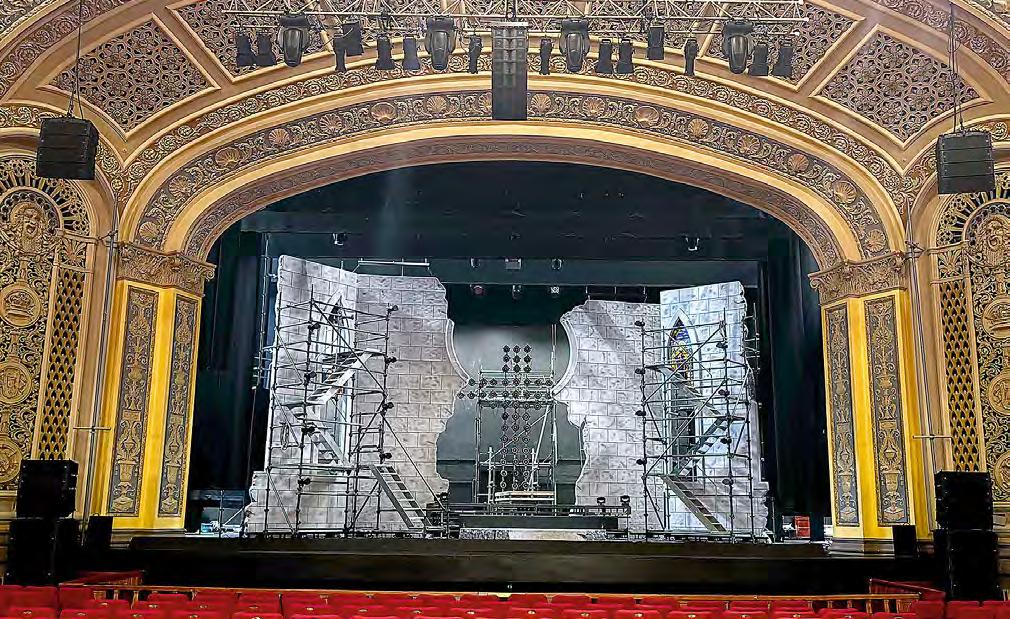
you’re pushed into the corners and planning the fills in advance was key,” he explained.
“We had four different generations of loudspeakers managed under one platform showing how handy Performance Manager is. It’s been a great tool for deployment, tuning and monitoring.”
Sound designer and mixer Tom Acklin of Crossfade shaped the production’s audio each night, balancing the rock band with the vocals that drive the story forward. “Sound design for a rock musical like Jesus Christ Superstar
comes with many challenges and trade-offs, but the JBL range makes it elegant,” Acklin said. “The VTX A8 handling the band content is the heart of the system. It ticks many boxes for me as a sound designer: full-range frequency response down to 60Hz, compact size to avoid those sightline issues and a wide 110° dispersion that’s perfect for this venue.” Acklin emphasised the mix of cabinets as a strength: “The VT4886 centre hang carries the vocals, and if you’re under the balcony the AC25s are the real star. It’s all about making
sure the story reaches everyone, no matter where they’re sitting.”
“The A8s are at home in this kind of deployment,” Bennet concluded. “From their wide coverage to their impressive low-end output even in small numbers, they’re an excellent choice for a musical show that needs big energy in a compact package.”
www.jblpro.com
www.jpro.co.nz
www.strawberrysound.co.nz
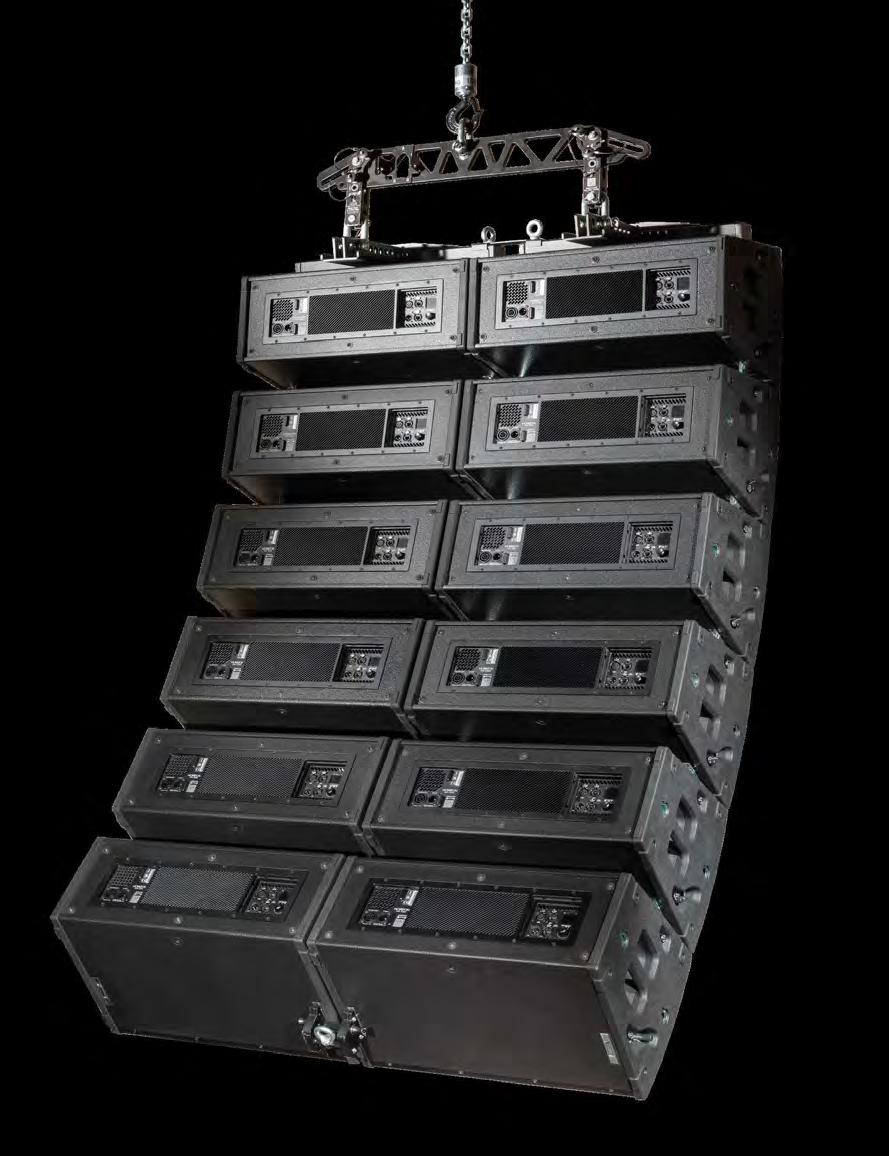
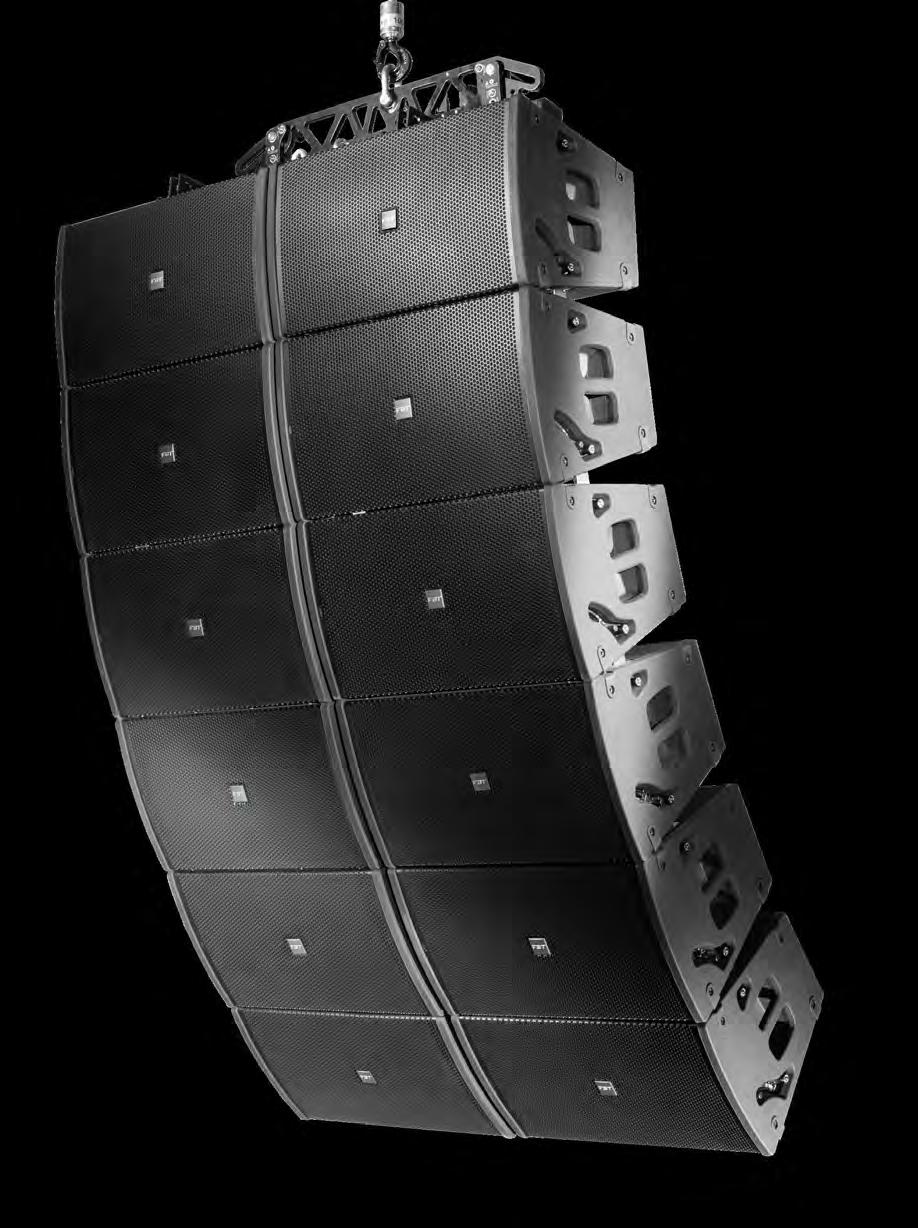

VHA 406N/ND
Line Array
» Self powered 2-way line array
» Class D 800W for LF / 400W for HF amplifier
» 4 x 6.5” woofers with 1.5’’ coil
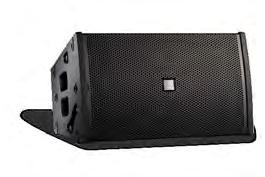
» 1 x 1.4” neodymium compression driver with 2.5” coil
» Dimensions (H x W x D): 612 x 360 x 397 mm / 24 x 14 x 15.6 inch
» Weight: 31.8Kg / 70 Lb
VHA 118SN/SND
Subwoofer
» Self powered bass-reflex cabinet
» Class D 2500W amplifier
» 1 x 18” woofer with 4” coil

» Dimensions (H x W x D): 611 x 711 x 720 mm / 24 x 28 x 28.3 inch
» Weight: 61.2 Kg / 135 Lb
VHA 112SN/SND
Flyable Subwoofer
» Self powered bass-reflex cabinet
» Class D 1600W amplifier

» 1 x 12” woofer with 3” coil - neodymium
» Dimensions (H x W x D): 612 x 360 x 397 mm / 24 x 14 x 15.6 inch
» Weight: 26.3 Kg / 58 Lb
COMMON FEATURES
» Vertical and horizontal installation
» DANTE audio streaming on board (ND/SND versions)
» Compatible with the INFINITO System Management Suite software
» Network interface TCP/IP - AES70 compatible
» OLED display and encoder with push
» Cabinet in 0.47” birch plywood with anti-scratch varnish

Bea Meikle visits the International School Bangkok, which has turned an eight-year-old sound system into a future-ready solution for its new theatre
WHEN THE INTERNATIONAL SCHOOL BANGKOK (ISB) renovated its ISB Theater, it made a decision that combined performance, practicality and sustainability: rather than investing in a completely new sound system, the school chose to repurpose its existing L-Acoustics setup, originally installed in 2017. The move not only reduced environmental impact and costs, but it also demonstrated the lasting value of a well-specified and well-maintained audio system.
Located in the Nonthaburi Area of Bangkok, ISB is regarded as one of Thailand’s leading international schools, offering a broad academic curriculum programme to approximately 1,800 students, from Pre-K to Grade 12, from over 61 countries. Its expansive campus includes science and design labs, technology-forward libraries and learning spaces, plus extensive sports facilities and performance venues.
The ISB Theater, which was originally built in 1991, was identified for a major upgrade in 2023 to accommodate larger events and more advanced technical capabilities. “We’ve operated the ISB Theater for many years with only minor renovations,” says Marc de Vries, the school’s chief financial officer. “We decided to expand seating, improve access with a new mezzanine entrance and upgrade the equipment to match the evolving needs of our performances. The goal was to bring the facility up to a professional level, so students could gain real-life experience in performance environments.”
Prior to the upgrade, the theatre hosted a multitude of productions with an L-Acoustics K Series sound system which had been installed in 2017. That system was selected to replace speakers that had been in use for 25 years after a shootout involving five major audio brands. “We ultimately chose L-Acoustics for its sound quality, the performance of the K Series, its visual appeal and the strong technical support from both Vision One and L-Acoustics,” explains theatre manager Sathit Kaivalvatana. “It’s been reliable and has delivered consistently since day one.”


performances and the room has undergone acoustic treatment to optimise sound performance, with the installation of a custom-designed origami-style acoustic ceiling.
“ISB is located in the northern suburbs of Bangkok, where there are no professional theatre facilities nearby,” de Vries explains. “We wanted a space that could be used by the community as well, and that meant designing it as a flexible, multipurpose venue. We couldn’t build a full concert hall or a pure theatre – it had to do a bit of everything and sound quality was a major factor in making that work.”
L–R: Vision One’s Pete Akarat Thitipattakul, Eric Chua of L-Acoustics, Sathit Kaivalvatana of ISB and Wei Ling Wang of L-Acoustics
Given the system’s performance over eight years, the idea of reusing it for the newly renovated theatre quickly gained traction. “ISB were very satisfied with the original system we installed,” says Pete Akarat Thitipattakul, business development manager at L-Acoustics’ Thai distributor, Vision
For Kaivalvatana, maintaining consistent sound quality across a wide range of event types was a priority: “We wanted to retain the same clarity and scalability we had with the original L-Acoustics system before the renovation. The ISB Theater will host everything from musicals and concerts to student-led performances, assemblies and film screenings, so the system had to be flexible.”
Vision One worked with L-Acoustics engineers to reconfigure the existing system for the new facility, using the manufacturer’s Soundvision 3D modelling software to determine optimal speaker placements. “Once we modelled the space, it became clear that the layout would be very different from the original installation,” notes Thitipattakul. The original KIVA II loudspeakers, SB15M and SB18 subwoofers and 5XT point source cabinets were reused,
and the system was expanded to suit the new room. Two additional KIVA II speakers and five extra 5XT units were added, along with a P1 processor and an L10 AVB switch for enhanced audio networking and control. “The aim was to ensure every event runs smoothly, with high-quality, reliable sound that matches the versatility of the space,” Thitipattakul adds.
L-Acoustics’ APAC sales manager, Eric Chua, who worked alongside the Vision One team throughout the project, declares the K Series to be the perfect solution for the theatre: “It hits the sweet spots in the space, it’s compact, powerful and gives an even coverage. Whether you are sitting right at the front or in the back of the theatre, you hear the same clear sound. Plus, with its sleek design, KIVA II fits perfectly into the ISB environment where aesthetics also matter.”


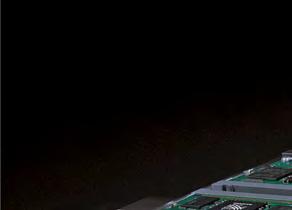



Reflecting on the differences between the original system installed back in 2017 and the reconfigured solution in the ISB Theater, Chua adds: “The difference is noticeable. Speech is clearer, music is fuller and there’s a greater consistency across the space. We also improved the subwoofer setup and integrated smarter control tools, giving the ISB AV team more flexibility to monitor and adjust the system as needed.” Beyond the audio setup, the theatre upgrade includes a new stage lighting system running on the Art-Net protocol, a Panasonic video-over-IP projection system and additional rigging infrastructure. de Vries says the space plays a crucial role in student life: “Community is important at ISB, so having a space where all students can come together to celebrate achievements is key. But, just as importantly, we want our performers to have access to an inspirational, professional environment – something that encourages them to pursue
Support and collaboration throughout the project was a continuation of the partnership that began with the install in 2017. “We’ve had a strong relationship with ISB,” notes Thitipattakul. “From the beginning, we’ve provided ongoing support and maintenance to make sure the system stays in good condition and performs over time.” Kaivalvatana agrees:

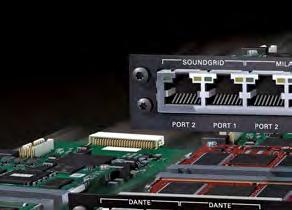


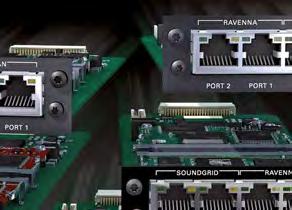

“The support from both Vision One and L-Acoustics has been excellent. Their teams have a deep understanding of the system and I’ve learned a lot from working with them. They’re not just delivering equipment; they’re providing a solution that fits our space and our needs.”
From a sustainability standpoint, the decision to reuse and expand the existing system is a model that more AV projects could follow. “Extending the life of a system and building on what’s already there is a big part of L-Acoustics’ sustainability approach,” remarks Chua. “We’re not just about selling new gear. We want to help clients get the most out of their systems and avoid unnecessary waste. It’s better for the client and it’s better for the environment.”
The ISB Theater project demonstrates how sustainability and performance can go hand in hand. With thoughtful planning and strong collaboration, the school has delivered a space that meets professional standards, supports a diverse range of activities and avoids unnecessary environmental impact. Sometimes, the best solution isn’t a brand-new one – it’s one that’s already proven its worth.
www.l-acoustics.com www.visionone.co.th
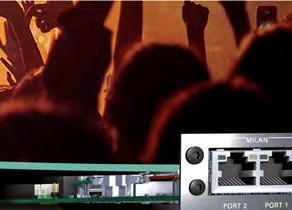
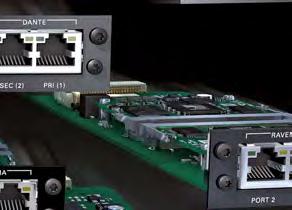

















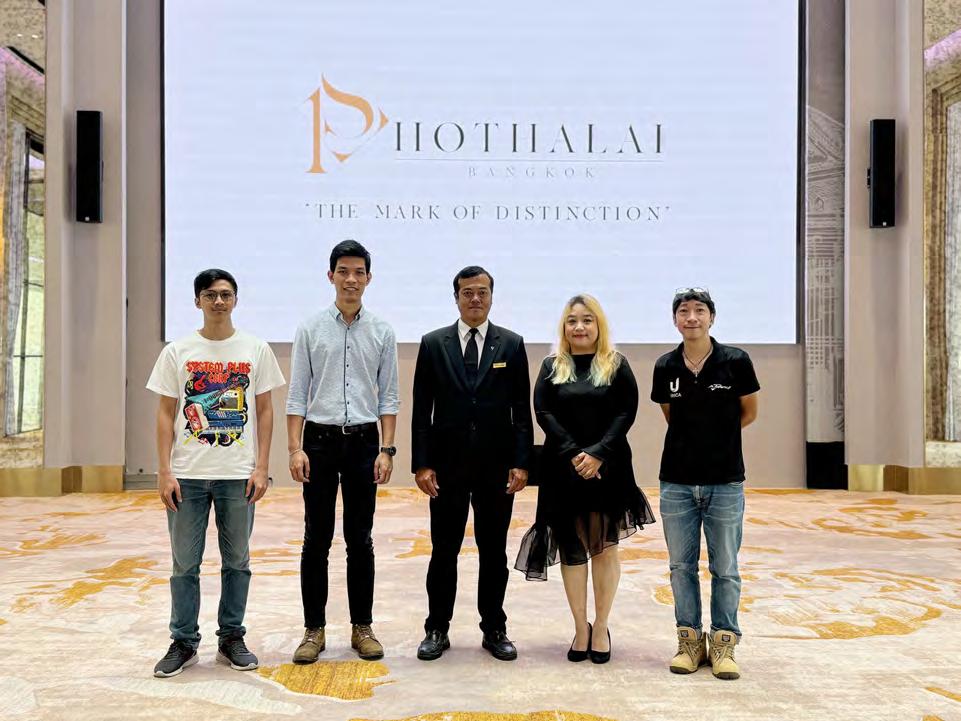

LOCATED TO THE NORTH OF BANGKOK, PHOTHALAI Golf Park has progressively advanced its dress code beyond colourful leisurewear to include attire more suitable for business and formal events. Simultaneously, its client base has diversified significantly with the creation of a MICE (meetings, incentives, conferences and exhibitions) complex, large spa and the Bay Lounge café and restaurant. Just as many of the guests attending functions at Phothalai Bangkok may be blissfully unaware of the full-service golf driving range, it is also hoped the discreet yet powerful audio system designed and installed by System Plus Corporation will be similarly under the radar.
Interconnected by interior and exterior walkways, Phothalai Bangkok features an extensive layout of standalone meeting, seminar and banquet rooms surrounded by verdant gardens, ponds and water features. An elegant octagonal white pavilion hosts Buddhist and Christian wedding ceremonies. Either side of the central area, the Saranromya and Bannabhiromya ballrooms can cater for up to 800 guests. Elsewhere, several medium-sized meeting rooms including Vanaromya, Dhararomya and Dhiraryoma can accommodate between 40 and 100 guests for meetings and training sessions.
Phothalai managing director Maneenat Tavisaengsiri explains the concept behind the redesigned spa, MICE event spaces and golf course clubhouse: “An increasing number of customers were requesting private events during golfing tournaments, in addition to enquiries for weddings, fashion shows, conventions and launches, so we decided to invest in an upgrade and expansion plan. Because of the varied nature of the events, we realised that the AV networking and technology within our large multipurpose venue would need to be completely integrated to facilitate ease-of-use functionality.”

Enter Bangkok-based System Plus Corporation. “Having previously installed AV technologies into the Phothalai golf resort, we were requested to tender an AV design for their latest renovation,” explains managing director, Chuthinthorn Bhanyotin (Mam). “One of the overriding challenges was to ensure that the loudspeaker technology would not distract the guests’ attention away from the ballrooms’ beautiful chandeliers and interior décor.”
Following EASE simulations of the entire venue based on Pan Acoustics technology, System Plus Corporation calculated the optimum models and locations for the
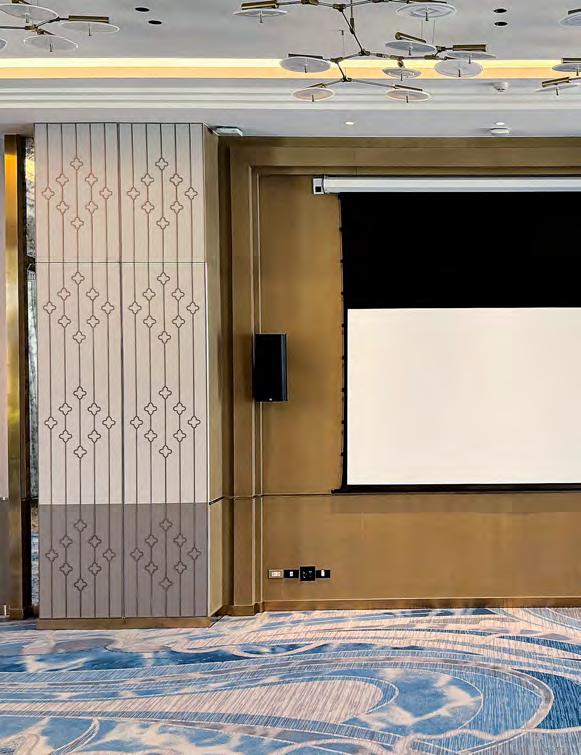
speakers. As a distributor for the German brand, Mam and her team submitted an elegant, unobtrusive design based on low-impedance 8Ω operation.
Acoustically challenged by fully glazed doors and windows running down its entire 28m length, the larger divisible ballroom simply features two Pan Acoustics PB 224D beam-steerable line source speakers. Wall-mounted in a stereo configuration on either side of a P2.97 3.5m x 6m (HxW) LED screen, the digitally controllable columns can generate beams for either speech intelligibility or full-range music reinforcement. Combining six 6.5-inch woofers with 18 1-inch tweeters in its slim, 1,109mm-high enclosure, the active PB 224D operates within a frequency response of 85Hz–19kHz. The room’s architecture has been factored in by configuring the vertical beam and tilt angles within the Pan Audio DSP programme.
“A less is more design philosophy applies,” continues Mam. “The two stereo PB 224D columns that we installed provide excellent dispersion, full-range audio and highpower output over the entire length of the ballroom. Enhancing the lower frequencies down to 35Hz, we only had to add two subwoofers in the form of SW-112 SP D 12-inch models, which are recessed into the wall below the LED display. We must have done a good job because the client asked me where the speakers were located upon completion.”
Affixed to tilted columns and finished in white, several 500mm-high P 04-Pi quadruple 3.5-inch line source speakers address a seated area in the courtyard outside the main ballroom. Handling both speech and music reinforcement, two larger meeting rooms have been provided with P 261-AMT (Air Motion Transformer) aluminium enclosures. Comprising two 6.5-inch drivers and a custom AMT tweeter unit, the 555mm-high passive speakers can reproduce low frequencies down to 50Hz. Balancing the required SPLs with even distribution, the smaller meeting rooms and corridors are catered for by an aesthetically pleasing ceiling speaker solution based on the P 6.5-CM coaxial 2-way model.
“For a guest experiencing Pan Acoustic beam technology in the ballrooms or main meeting rooms, we have maintained a consistent coverage beyond,” explains Mam. “For any guests entering the courtyard, toilets or corridor,
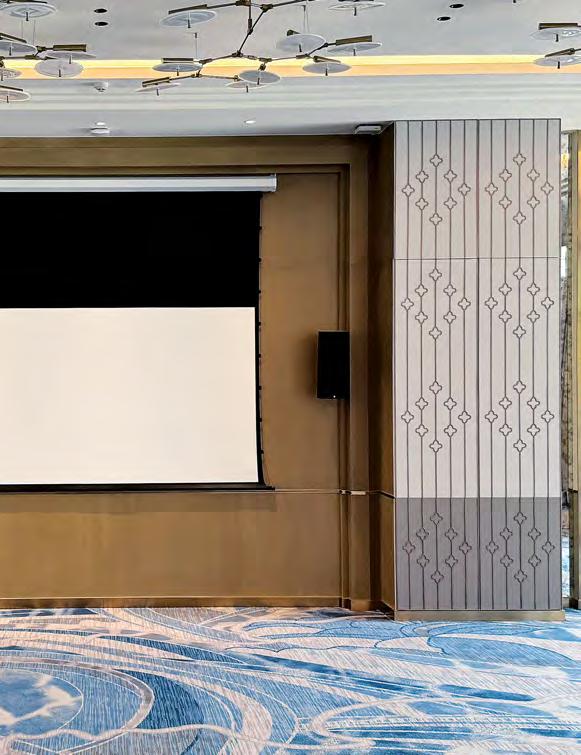
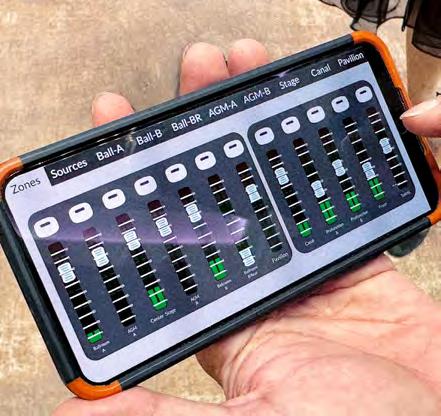
the transition in audio level and quality remains seamless. We have mastered this by providing consistent transducers, together with accurate programming and tuning.”
The audio cabling infrastructure connects the I/O patch panels and loudspeaker outputs in the various rooms to the Powersoft amplifiers and the Allen & Heath SQ-5 digital console in the rear control room. The entire low-impedance speaker system is powered by two Powersoft Unica 4K8 amplifiers in addition to a pair of Mezzo 324 A and 322 AD half-rack units. “Combined with the outdoor speaker system and corridors, the MICE loudspeaker system is sizeable yet it only requires two full and four half-rack amplifiers,” explains Attapol Praisri, product manager at Powersoft’s Thai distributor, M.I. Engineering. “To route the audio between the various venues, we created a Dante network that can be controlled within the amplifier’s ArmoníaSuite software, which was relatively simple to install.”
By configuring the audio processing and loudspeaker parameters within ArmoníaSuite, any audio input can be assigned to any output. “Faults that occur on the network are automatically detected via the amplifiers,” continues Praisri. “The Powersoft platform can share power across all output channels, so it can be used where most needed. It engages automatically and even works when channels are operating at different impedances on the same unit. The power-sharing capabilities offer plenty of headroom for future expansion and can redirect unused power to channels requiring more power.”
Additionally, the main audio parameters are remotely monitored and managed using the same ArmoníaPlus software. Having installed a wireless access point, the M.I. Engineering team can remotely log into ArmoníaPlus to detect faults in the system and add firmware updates when required. “With remote access to ArmoníaPlus on a PC, you no longer need to be onsite to troubleshoot,” explains Praisri. “If a problem arises, it’s normally a case of a wrongly touched button, which can be solved remotely by signposting the client to the technical fault.”
Supplied by Sonos Libra, an Allen & Heath AHM-64 64x64 audio matrix processor plays a central role in the venue’s flexibility. Inserted with an SQ Dante 64x64 expansion card, the SQ-5 mixer receives its inputs from portable DT168 Dante I/O and Dante AVIO units. “For a large event, both ballrooms can be connected via the AHM-64 matrix, so a band playing in one room and mixed on the SQ-5 console can be transmitted to the other with very little latency,” continues Mam. “With varied entertainment being staged, a flexible yet simplified form of audio management control was vital. The SQL file allows the visuals of a band playing in one room to be transmitted to any of the other LED displays on the network.”
According to Mam, the discreetly located control element of the design won the interior designer’s seal of approval. “Control, source selection, output and routing are integrated into the AHM-64 without any technical issues,” she says. “The audio parameters can be managed on the actual front panel interface in the control room,
which comprises four soft keys for volume control, source selection and recall presets, although the Phothalai technicians prefer to use an iPad or smartphone.”
As such, a customised user interface was designed and programmed to include all the controls requested by the operational team. Once fully tested, various permission levels were assigned to each member of staff. “It’s a very useful tool for the operations manager as he can immediately adjust the volume for guests in the various zones while walking around,” adds Mam. “Should the network need to be upgraded, it’s futureproofed with ongoing software and firmware updates.”
The audio chain is completed with source players and eight channels of Shure SLXD4 receivers paired to Beta 92 handheld wireless transmitters. The facility requires an extensive network of UA864 antennas to be connected to two RF Venue 4-zone antenna amplifiers and two Shure UA845UWB distribution units. “Wireless coverage across the whole complex was a concern initially,” explains Mam. Shure supplier Mahajak Development assisted with the configuration within the Wireless Workbench software.
Flexibility of use remains the central theme of the AV design. “The AV network combines well with the wireless system, which had to synchronise and combine with both

the audio and video systems,” continues Mam. “The added challenge was to broadcast content to all the screens over the network, which needed to be centralised. By adding receivers and transmitters, the video can be broadcast from any input to any output.”
With a schedule of bookings lined up, the System Plus Corporation engineers completed the works within a compressed timeframe of just two months. Tavisaengsiri was impressed with the results. “Not only has the centralised AV control of the sources and levels been greatly simplified with an iPad touchscreen and smartphone, but the venue also needs less manpower now,” she says. “By configuring the inputs and outputs in a specific room, it is so much easier to cater for our various events. With the unobtrusive Pan Acoustics loudspeaker system, the interior design remains unblemished, and we can interconnect AV between the various buildings for bigger events from an iPad.”
www.pan-acoustics.de
www.phothalaibangkok.com
www.powersoft.com
www.systempluscorp.com

Venue operators know a wise investment backed by detailed research equals technical longevity. Richard Lawn visits Singapore’s National Library Drama Theatre to exemplify this
OCCUPYING LEVELS 3–5 OF SINGAPORE’S 16-LEVEL
National Library, the Drama Centre’s pièce de résistance is its 614-seat Drama Theatre. Thrust into the belly of the main building, the isolated theatre is suspended in mid-air by a series of connecting mega-trusses with 100mm-thick flanges. The venue opened its doors in July 2005 and, over the next two decades, the infrastructure and technological hardware endured constant use. Having exceeded their sell-by dates, the audio, lighting and visual systems of the theatre were earmarked for an upgrade in 2024 by deputy director (technical production) Fazil Sulaiman and his team, including assistant manager (technical production) Hisyamnudin Bin Shariffudin, marking the first significant upgrade since the theatre was built.
The theatre is wholly funded by the Singaporean National Arts Council, whom Sulaiman approached for permission to invest in what was perhaps an overdue upgrade. He would quickly familiarise himself with the exact wording required when submitting government budget forms, including the omission of brand names and accurately documented technical specifications.
The investment in high-quality technical equipment as part of the original S$28.9mn project had served the theatre well. Back then, AV consultant CCW had undertaken extensive market research to ensure that the theatre would be equipped with best-in-class, rider-friendly equipment. Fulfilling the requirement for a powerful, full-range loudspeaker system, a d&b audiotechnik Q-Series was

specified on account of its compact and portable form factor that would cater for the theatre’s diverse clientele. Likewise, the Yamaha PM1D digital console and Clear-Com P1 Pro intercoms would endure over two decades, while a full-power fly system has provided quick scenery changes and rigging during that time. But perhaps it was the infrastructure originally installed that has served as the bedrock of stability. “I was constantly reminded when I came on board that the theatre wouldn’t have to change its infrastructure for decades,” explains Sulaiman.
Following a lengthy review, Loud Technologies Asia (LTA) was commissioned as the theatre’s systems architect.
“We had noted their works at other theatres including the Goodman Arts Centre,” says Bin Shariffudin. “Due to their network of supportive SIs and contractors, LTA are solutions providers rather than just equipment suppliers, as we found out after we initially worked with them to upgrade our black box theatre at Goodman Road. To date, we have enjoyed a professional yet close technical relationship.”
For the level one black box theatre, LTA supplied a Yamaha digital mixing console system with two RIO remote I/O stageboxes. Powered by d&b audiotechnik 40D and 10D amplifiers, a flown speaker system combining d&b 24S-D enclosures with B6 subwoofers and E12 monitors enhances venue flexibility. “With the exception of the overhead grid which was overhauled, the existing infrastructure connected to the entire building was in excellent condition,” reveals LTA managing director, Colin Quek. “Ultimately, the contract



to upgrade the black box and theatre was straightforward, and the theatre has received positive comments since the upgrade.”
LTA was tasked with upgrading the audio, communications, show relay and wireless microphone systems for the main theatre. The previous infrastructure installed in 2005, including 200 analogue patch points, remains in situ. Providing inbuilt redundancy, Clear-Com two-wire interfaces can also be deployed as regular partylines. “If we had to replace the extensive cabling infrastructure, the theatre would have had to close for around a year rather than three months,” explains Sulaiman. “We simply wanted to upgrade to digital, so the existing infrastructure continues to serve us well into the future. A hybrid intercom operates over the existing XLR lines as the regular three-conductor cabling incorporates sufficient capacity to handle both digital data and power.”
Boasting four different protocols, with a Clear-Com Arcadia Central Station mainframe unit at its heart, the digital hybrid system designed and installed by LTA interfaces the customised HelixNet, FreeSpeak wireless and legacy 2-wire analogue partyline intercoms. “No other system currently available could bridge these protocols and the four different platforms including our legacy partyline,” Sulaiman continues. “The existing infrastructure is more like an old telephone line and allows some production companies to connect and operate their own 2- and 4-wire legacy partylines. However, an increasing number of operators prefer to run a wireless setup because they can add their own equipment once registered to the antenna.”
With the potential for interference that exists in this heavily built-up area, Sulaiman and his technical team insisted on the installation of carefully sited wireless antennas. Licensed for 64 endpoints, FreeSpeak pairs five antennas around the venue to handle up to 50 FS-II digital beltpacks. Rental partners sometimes insist on using their own subhired equipment, according to Quek: “With different personnel requiring different channels, our job was to make the house system robust.”
Providing power for the 2-channel HXII-DPL beltpacks, the Arcadia units are connected to four HelixNet interfaces installed around the theatre. The inventory currently includes 10 singleside headsets with flip-to-mute, 20 hybrid HelixNet 2-channel beltpacks and 10 wireless beltpacks.
The upgrade oversaw the replacement of the original tungsten lighting fixtures with LEDs. StageEquip supplied most of the lighting fixtures, including new LED colour sources, RJ followspots, Ayrton moving heads and an extensive inventory of ETC lighting. A grandMA3 lighting console has also been brought in as a control surface. “If a theatre group does not

have a lighting designer, we provide a minimal default rig for the show without incurring additional technician costs,” explains Sulaiman. “Although the professional artists have their own inventory, the school shows, amateur groups, graduation ceremonies and smaller groups lack the funds and access to lighting designers. For these smaller productions, we provide an extensive list of lighting equipment.”
The show relay system has been upgraded to an SDI transmission network from the legacy composite video system. In addition to other video sources, high-definition inputs including a Bolin Technology PTZ camera and an AIDA Imaging IR POV camera are routed to a Blackmagic Design 12G SDI matrix

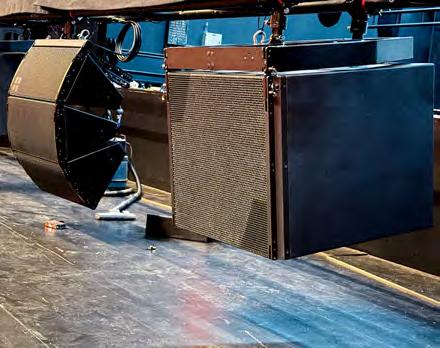
router. To complete this part of the upgrade, LTA installed an IR blaster floodlight with customised video scalers and SDI signal boosters to compensate for the long cable runs, ensuring a stable frame rate and resolution.
“Most of the routing specifications are based on the recent upgrade at the Victoria Theatre, which revolves around a Blackmagic video routing suite,” explains Sulaiman. “I was initially apprehensive about upgrading to SDI but, after LTA conducted tests, we discovered that the existing infrastructure could support HD video with the correct equipment. If we increased the gain on the line output, we could get additional bandwidth to run HD and SDI because the legacy composite video system has fewer TV lines needing lower bandwidth and, following testing, we discovered the upgrade was feasible. Finally, LTA was instrumental at the testing and assessment stage in confirming our findings, measuring the signal integrity and highlighting where the video amplification could be added in relation to the existing infrastructure.”
The original Yamaha PM1D 48-channel console was replaced in 2018 with a Rivage PM3 control surface with a 15-inch touchscreen and three 12-fader bays. The channel section of the compact dual-redundant PM3 features dynamics, gain, HPF, EQ and pan controls. Routed to an RPio622 I/O rack with hybrid microphone and digital sections including a Rupert Neve Designs transformer and SILK processing circuitry, Yamaha’s TWINLANe protocol allows up to 400 audio channels to be transmitted over optical cabling. A rackmounted MRX7-D digital processor was also added with stored DSP settings and presets.

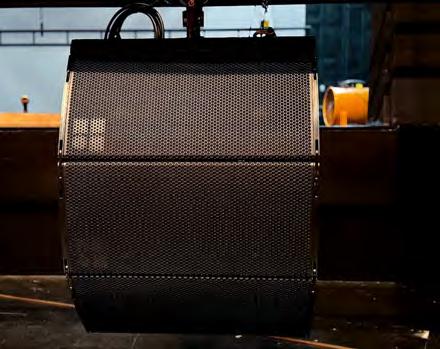
To cater for bigger productions, the previous 16-channel wireless setup has been increased by 50%. Comprising 12 AD4D digital dual-channel wireless processors, the Shure Axient system boasts a wide dynamic range, AES-256 encryption and 2ms of latency from the microphone transducer to the analogue output. “Compared to 20 years ago, wireless mics are less complex, but the bandwidth has visibly shrunk,” continues Sulaiman. “In order to scan or monitor for interference, an AD600 spectrum manager can visualise the status of all the microphone transmitters. The simple user interface allows our technicians to witness, at a glance, any RF difficulties that we may be experiencing.” The theatre’s wireless signal strength has been further boosted with the addition of an RF Venue HDR (high dynamic range) RF signal setup featuring cascading Distro9HDR and Distro5HDR antenna distribution units. Capable of handling an increasing number of wireless signal levels with lower noise and higher linear headroom, multichannel performance is enhanced by reduced intermodulation and interference. The RF Venue systems even support mixing and matching any brand of UHF wireless microphone system, whether analogue or digital. “Over two decades, we haven’t suffered any notable wireless issues, and we intend to maintain that system performance,” he adds. “We can maintain industry standards, but it is financially hard to keep up with the touring riders. Some tour operators even bring in their own wireless distribution. This is why we chose an antenna distribution system with high dynamic range. Our in-house wireless system is by design more robust than any external wireless, which could potentially compromise the integrity of the signal. We’re working with very technical engineers so, when they look online at our setup, they feel assured when they see we possess a large Shure Axient inventory boosted by RF Venue.” Over the past 20 years, Clear-Com, d&b audiotechnik and Yamaha have served as reliable and responsive technological partners according to Sulaiman. “Their technical teams are highly competent, so a phone call is usually enough to troubleshoot a problem. For example, Kenny Chng and Imran Hariht were members of the team that conducted the initial 2005 fit out, and they continue to work at d&b audiotechnik! Having that first line of local support is paramount should anything go wrong or any of the technical crew have an equipment enquiry.”
Powered by d&b audiotechnik D12 amplifiers, three modes of amplified operation were previously available depending on the type of performance: speech mode with no subwoofers, normal with subwoofers and supplementary with the addition of the ground stacks. Concealed within the proscenium, the previous left and right clusters of dual Q7 cabinets and twin Q-SUB subwoofers were balanced by a centre cluster combining four Q1s and a single Q7. For low-frequency extension, two further QSUBs positioned below the stage were augmented by two ground stacks, each consisting of one Q-SUB and two B2 subwoofers.
Twenty years later, the upgraded d&b audiotechnik loudspeaker system bears similarities. To cater for the variety of shows ranging from school productions to musical concerts, the theatre demanded versatility and flexibility in addition to power. The L-C-R configuration is enhanced with subwoofers, infra subs and fills. “I don’t think there’s
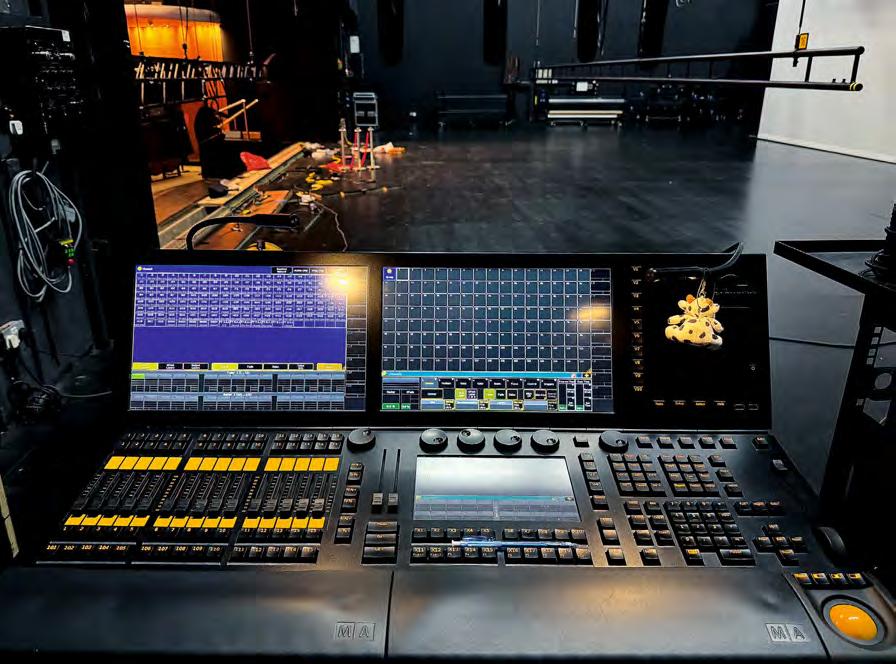
a theatre of this size which can offer the equivalent power output of this one,” asserts Sulaiman. “The range of shows and performances that we cater for has increased exponentially. Like the lighting and wireless systems, the audio has been designed to bypass the requirement for external rentals. Not only does this investment save our vendors from added costs, it also takes their shows to the next level.”
A similar L-C-R configuration combines three AL-Series compact modules in each array. The flown system is extended with the addition of single Vi-SUB subwoofers located between the central and L-R arrays.
Augmented by V-GSUB subwoofers, the ground stacks comprise further AL-Series cabinets with an extended low-frequency response down to 33Hz (–5dB) delegated to KSL-GSUB infra subs. EASE analysis together with d&b ArrayCalc simulation software led to the front seats being addressed by 44S compact dual 4.5-inch enclosures, with E12 cabinets for stage monitoring.
The Yamaha PM3 console’s signal transmission to the d&b audiotechnik multichannel 40D, 10D and 5D amplifiers are still sent in analogue format. The amplifiers’ DSP provides comprehensive loudspeaker management, switchable filtering functions, user-definable equalisation and delays. Theatre technicians can monitor and control the loudspeaker parameters from a PC loaded with R1 remote control software, while a system check feature verifies the status by measuring the impedance of the connected loudspeakers. Input monitoring detects an incoming pilot signal regardless of whether this input is routed to an output, and the load monitoring function checks load impedance for possible loudspeaker malfunctions.
a new layout, shut down certain boxes and what needs to be reconfigured in terms of muting, groups and so on. This is why I like d&b.”
Arriving onsite in December 2024, LTA completed its extensive assignment in mid-March 2025. “The schedule was condensed with the Christmas, Chinese New Year and Ramadan holidays taking place over this three-month period,” says LTA’s Koay Kheng Ying (KKY). In addition to overseeing the installation of the audio, communications, lighting, show relay and wireless systems, LTA also had to work around the other trades installing the drapes, dance mats and a new stage floor. “We had to be highly organised with our scheduling and work long shifts to complete in time,” he continues. “Despite the challenges posed, good coordination ensured that everything fell into place and our suppliers didn’t let us down.”

Given the experienced technical crew, ease-of-use features were not a requirement, although hands-on training was provided for every new facet of the system. “All our vendors – including Clear-Com, Shure and Yamaha –supported us reliably through LTA,” explains Sulaiman. “Having conducted the tuning and commissioning of the d&b audiotechnik loudspeaker system, Kenny Chng also educated the technicians about the software nuances of the loudspeaker system.”
“There is ample headroom with this setup,” confirms Sulaiman. “You encounter fewer problems when you don’t have to push the speakers hard, and if you do encounter a need for higher SPL, you know you’re covered. The five-year warranty is also reassuring. It’s not so much about what the speaker system is, because a box is a box. It’s what happens at the back end and what needs to be done if you want to draw
Whether or not the same team will still be with d&b audiotechnik when the theatre undertakes its next loudspeaker upgrade, one thing is certain: the Drama Theatre at the Singapore National Library is now future-ready. “With the added flexibility of the lighting, loudspeakers and infrastructure, the theatre can easily scale up its performances over the next two decades,” concludes Sulaiman.
www.clearcom.com
www.dbaudio.com
www.loudtechnologiesasia.com
www.rfvenue.com
www.sg.yamaha.com

COMBINING AN ICONIC DESIGN WITH GRACIOUS THAI hospitality, the Anantara Siam Bangkok Hotel exudes class, from sumptuous interiors hung with hand-painted silk murals and lit by chandeliers to the tropical gardens beyond. Located in the bustling Ratchaprasong district, the five-star property recently commissioned Bangkok-based hospitality specialist i-Magic to upgrade the audio systems in two of the ground-floor food and beverage (F&B) outlets, Guilty and Aqua. Featuring 354 luxurious rooms and suites, the hotel blends comfort with distinctive Thai design elements, where music plays a vital role in creating the atmosphere. Centrally located in the open-air courtyard, the Aqua bar is designed as both a dining and an entertainment venue for guests to unwind. Surrounding Aqua are three additional dining outlets: Guilty Bangkok, Madison Steak Avenue and the Spice Market. Following extensive renovations, this hidden oasis now boasts a powerful yet discreet Nexo loudspeaker system that enhances the ambience without overpowering it. Hotel guests are free to choose between any of the four F&B outlets during the breakfast service, and i-Magic has provided a room-combining setting for this purpose. However, after 10.30am, the outlets all function separately, with EQ and presets stored in the pre-existing Symetrix Prism 8x8 processor so staff may apply individual volume adjustment and source selection via the hotel’s Wi-Fi network utilising the Symetrix ARC-WEB HTML web browser control pages.
Previously a merchandise store, the adjoining space was repurposed as Guilty, a themed drinking and dining den with South American roots. Sensitive to the requirements of the interior designer, i-Magic was aware that the speakers had to conform to high audio standards while also being discreetly hidden from the diners’ view.
i-Magic project manager Seth Langer specified Nexo ID14 coaxial speakers for this room powered by an existing but newly serviced QSC GX3 amplifier. Despite being wall-mounted at a height of 3.5m, the six compact 4-inch enclosures provide even
dispersion across the dining area. Supplemented in the lower frequencies by a Nexo IDS110 10-inch subwoofer concealed above the HVAC mechanicals, the Latin American vibe is enhanced during the evening hours when a DJ takes to the twin Pioneer DJ XDJ-1000MK2 multiplayers and a DJM-900NXS2 mixer, with Genelec 4010 speakers on monitoring duty.
Located under a retractable roof, the extensive Aqua space is where patrons can enjoy drinks and all-day dining. The venue has also been reinforced with a Nexo loudspeaker solution comprising six higher-performance ID24 ceiling-mounted speakers augmented by three IDS110 subwoofers. Two of the subwoofers are neatly integrated into the bar area behind wooden panels. To maintain an even low-frequency dispersion across the extensive open zone, a third model, finished in white, was recently added at the far end of the room away from the bar area.
“With the availability of more budget, the hotel management approved this third subwoofer,” says Langer. To ensure lowfrequency emissions could not penetrate to the guest rooms immediately above, i-Magic attached elastic ties to the M8 threaded mounting points of the suspended subwoofer, isolating it from the structure. The four IDS110 subwoofers are powered by a Nexo DTDAMP4X1.3 4-channel amplifier while a preexisting Work Pro Zenith 1700 amplifier takes care of the ID24 enclosures. Loudspeaker management is handled for each room by Nexo DTD-I processors.
Langer provided further acoustic consultancy to maintain the peace for hotel residents not wishing to partake in the nightly live entertainment. Following the renovations, the band has been relocated and now performs at a covered bandstand pavilion in the courtyard facing Aqua. Noise pollution has been minimised by switching the musicians to Shure IEMs and adding an electric drumkit. The musicians are patched into a stagebox linked to a Midas MR18 mixer connected to the hotel’s Wi-Fi network, allowing audio engineers to adjust the band via a tablet from any point within Aqua.

Born in New Jersey, US, industry veteran Langer has been based in Bangkok for over half his life. An entertainment technology consultant who has earned the respect of the Thai hospitality community, he trusts in brands and suppliers that don’t let him down. “Meeting best-in-performance expectations on constrained budgets is increasingly tricky,” he muses. “Therefore, I tend to rely on the same brands which provide excellent ease-of-use benefits, a great return on investment and peace of mind when it comes to full-service support.”
www.anantara.com
www.i-magic.co.th
www.nexo-sa.com
www.symetrix.co




As we enter a new decade shaped by 60 years of innovation, Ecler presents EclerPLEX — an advanced AV platform that connects Ecler hardware and software, allowing real-time processing, system deployment, and integration with third-party devices.
Intuitive design
Flexible and scalable modular architecture EclerCLOUD integration E icient real-time DSP processing
Explore EclerPLEX live at ISE 2026 – Booth 7B300

Lawn visits a new divisible ballroom in Kuala Lumpur that’s offering patrons maximum flexibility when planning their events

FROM THE MOMENT THE CAR IS CHECKED INTO THE country’s largest automated parking system, New Ocean World Fine Food City distinguishes itself markedly from anything that previously existed in Malaysia. Spanning almost 30,000m2 over eight levels, 22 handpicked restaurants offering gourmet cuisine from around the world can be experienced within at this new landmark. Just as the latest addition to Petaling Jaya’s vibrant dining and lifestyle scene is wooing food critics, the pillarless Grand Banquet Hall is capturing the attention of AV technology admirers.
While New Ocean World Fine Food City claims to redefine flavours from around the world, there is a similar assault on the senses at the Grand Banquet Hall as different elements combine to produce a rich blend of immersive audio with 4K projection mapping and an assortment of LED delights. No stranger to designing five-star hospitality ballrooms, Infinitum Technologies director Saw Siong Yih stretched his creative imagination from the moment he first accepted the challenge.
“In comparison, hotel upgrades are normally quite conservative, so this project was quite an exciting challenge,” he attests. “Although the projection mapping was carried out by another contractor, the novel design concept marked a departure from the regular audio, video and lighting systems. However, because of the extremely compressed four-month time frame required to complete the project, I was initially reluctant to accept the contract.” Challenge accepted, Saw commenced his formidable task in August 2024. With audio and lighting technologies having to compete for attention with the room’s stunning visuals, Saw experienced an added pressure to deliver solutions that would more than complement the LED displays and 3D projection mapping. With the sands passing through the timer at a fast rate, Saw invested more time at the drawing board stage.
“Many ideas proposed to the client required modifications,” he continues. “Once the plans had been agreed two months later, however, the time span to order and install the equipment was extremely tight as the venue was opening for a big event in late January, just before Chinese New Year. Fortunately, I have worked


on several projects in the past with the same interior designer and general building contractor, so team familiarity helped. Critically, I also placed my trust in known AV suppliers who would deliver on time, particularly Mercoms Systems.”
Accessible from the sixth-level via one of two glazed elevators, the scene is set from the entrance leading into the pillarless ballroom. Guests are greeted by a full-length LED that spans three levels of the exterior ballroom wall. Passing through the main doors into the room itself, the LED assault continues with L-C-R LEDs fixed to the front wall and five smaller 3,840mm x 2,160mm
(WxH) LEDs fixed to the rear wall. Overhead, 13 Panasonic 4K LED projectors combine, their carefully curated output bringing storytelling to another level.
Flexibility of use has been enhanced with the addition of 12 wall and floor panels incorporating Extron HDMI/VGA and audio XLR outputs. The connected visual inputs are routed to an Extron DXP HD 4K Plus digital crosspoint 16x16 matrix switcher via DTP HDMI 4K 230 Rx receivers in the eighth-level control room overlooking the ballroom. A Colorlight video processing solution combining an X100 Pro video splicer with an X16E LED signal controller
outputs the resultant signal to the displays. Loaded onto a PC, GrandShow EE software edits the content prior to transmission. The Blackmagic Design video editing suite combines a 12G-SDI to HDMI micro converter with a HyperDeck Studio digital video recorder and player. In addition, the video operator can manage the live feeds sourced from four wall-mounted Canon CR-N300 Full HD PTZ cameras with an RC-IP100 remote camera controller. A Blu-ray player serves as an added visual input. A rackmounted Extron IPCP Pro 350 xi processor provides the banquet hall
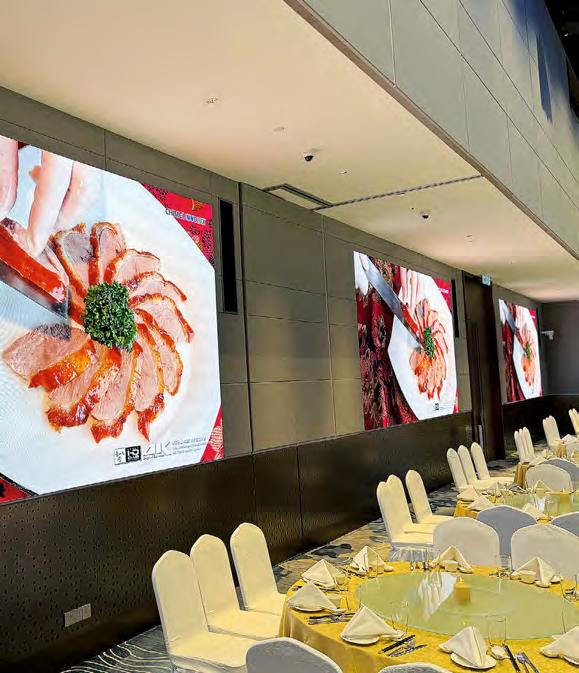
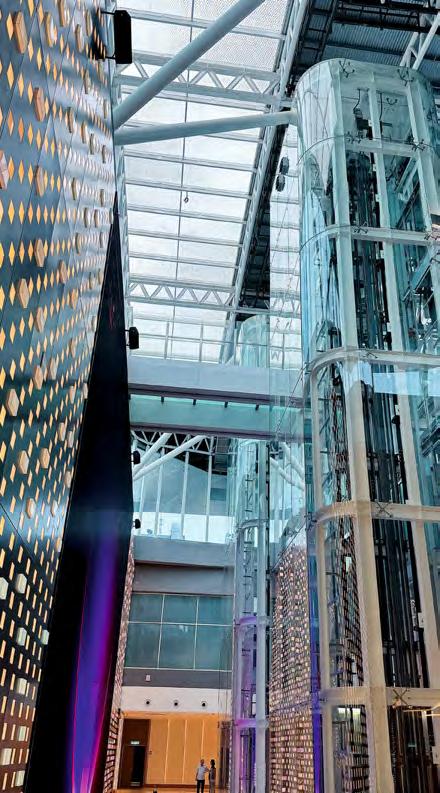
technicians with centralised AV control, with parameters instantly accessible from a smartphone or an iPad running the Extron app. Room processing functionality including EQ, delays and crossovers is managed by an industry-standard Q-SYS Core 110f processor. One-touch DSP presets stored within the Q-SYS software provide room combining and separation scenes. “Added outputs were required for the surround sound speaker system,” explains Saw. “To support the topology required, the addition of a QIO 4 expansion peripheral proved to be the most cost-effective way to scale up the network I/O.”
Specified for its high-power capabilities and highly directional beam-steering qualities, a Renkus-Heinz loudspeaker system fulfils multipurpose speech and musical requirements. The proprietary RHAON (Renkus-Heinz Audio Operations Network) has been adopted for audio control, monitoring and management of each active enclosure. Integrating electronics with loudspeakers, RHAON connects and networks the powered loudspeakers via the Cat6e cabling infrastructure and a Cisco 24-port Gigabit PoE network switch. From a PC or one of the three wireless iPads in the control room, technicians can manage the specific DSP functions of the loudspeaker arrays.
Mercoms Systems supplied the new venue with both the Renkus-Heinz loudspeaker system and the Q-SYS processing. Each divisible ballroom is equipped with a pair of ICLXL digitally steerable column speakers wall-mounted on either side of the main LED display. Also wall-mounted, at equally spaced intervals around the room, 10 P3-64-RN mechanically controlled quadruple 6-inch loudspeakers receive their Dolby or DTS-HD signals from a Pioneer AV VSX-LX505 9.2-channel AV surround sound receiver. Whenever the occasion warrants low-frequency extension down to 35Hz (–3dB), a total of six CA118S 18-inch portable powered subwoofers can be patched into the dedicated floor panels.
A Yamaha TF5 32-channel console has been adopted for audio mixing when the room is combined. When divided into three, the TF5 continues to mix the audio in the central segment with two Yamaha MG12X 12-channel analogue mixers called into play for the left and right rooms. Equipped with an NY64-D Dante network expansion card, venue flexibility is enhanced with the addition of 8–10 Dante outputs, allowing the Tio1608-D I/O rack to be patched according to the operator’s requirements. On-the-fly mixing can be carried out from the iPad touchscreen courtesy of the Yamaha TF StageMix app.
The QLX-D 8-channel wireless setup comprises six QLXD24/ Beta58 handheld and two QLXD14/85 lavalier microphones. “Rather than being fixed in the control room, the receivers can be transported on carts according to the banquet hall setup,” explains Saw. “This dispensed with the requirement for fixing directional UHF and VHF antenna onto the walls.” The microphone inventory is rounded out with four Audio-Technica PRO31 cardioid dynamic wired models.
Beyond the banquet hall, an audio design challenge awaited Saw in the sixth-level pre-function area. In addition to the glass elevators, the harsh acoustic environment of this space was accentuated by a full-length glass window, a 9m ceiling and marble floor. Accordingly, Saw needed to accurately programme the DSP settings to minimise reverb and feedback.
Connected to the main control room rack and managed by RHAON, four Renkus-Heinz CX82 dual 8-inch complex conic enclosures fire down from above the expansive wall display into a narrow foyer area confined by two glass elevators. Beyond this three-level-high strip, a lower 3m ceiling is fitted with a small network of passive speakers. Powered by two Next Audiogroup A504 amplifiers, a simple background music and paging system for the pre-function area relies on an Amperes Electronics CD1002 player and MX2232 preamplifier mixer for analogue processing control.
Like the banquet hall audio, the lighting control is designated to three pieces of hardware, with an Avolites Quartz ISV16 console chosen for central hall standalone and room combined functionality. When divided, the left and right halls rely on separate ALS Professional Nexus DMX768 consoles. Battling for position among 13 projectors, the crowded ceiling hosts eight 8m lighting bars supporting an assortment of ALS LED fixtures including 16 Profile 400-CTO spotlights, eight F400AZ CTO Fresnels, 30 Quat LP5403 RGBW PAR cans and 26 Luminar Flex 400 three-in-one moving heads. For added theatrics, an ADJ FS600 followspot and Malanbao TX-5 hazer machine are also available.
The compressed timeline led to Saw calling in favours from his preferred suppliers. “Once the purchase orders had been received,


the technical equipment including the mixing consoles, amplifiers, processing and loudspeakers needed to be ordered from overseas manufacturers,” he explains. “The integration works were carried out before installation, but every process had to be accelerated and approved to make the deadline. Mercoms Systems has continually assisted me with rush deliveries, excellent technical expertise and service.”
Mercoms Systems’ managing director Steven Chen has earned Saw’s trust over the years. “As a supplier, you learn to order products before the purchase order has been raised,” he comments. “For common products we carry stock but, for specialist components, you must order them early to clear Malaysian customs. The distributor, the suppliers and the manufacturers all need to appreciate each other’s challenges and work together for a project to be successful. When a contractor such as Infinitum Technologies understands the engineering and the products, the system sounds excellent and the venue becomes a great advertisement for all the brands included.” Those holding private functions at the New Ocean World Fine Food City banquet hall can choose from one or more of the 22 restaurants below to cater for their bespoke event. To add to the exclusive nature of the occasion, carefully curated AV content output onto the four walls of the room will transport guests to new worlds of discovery.
www.infinitumtech.com.my
www.web.mercoms.com
www.qsc.com
www.renkus-heinz.com
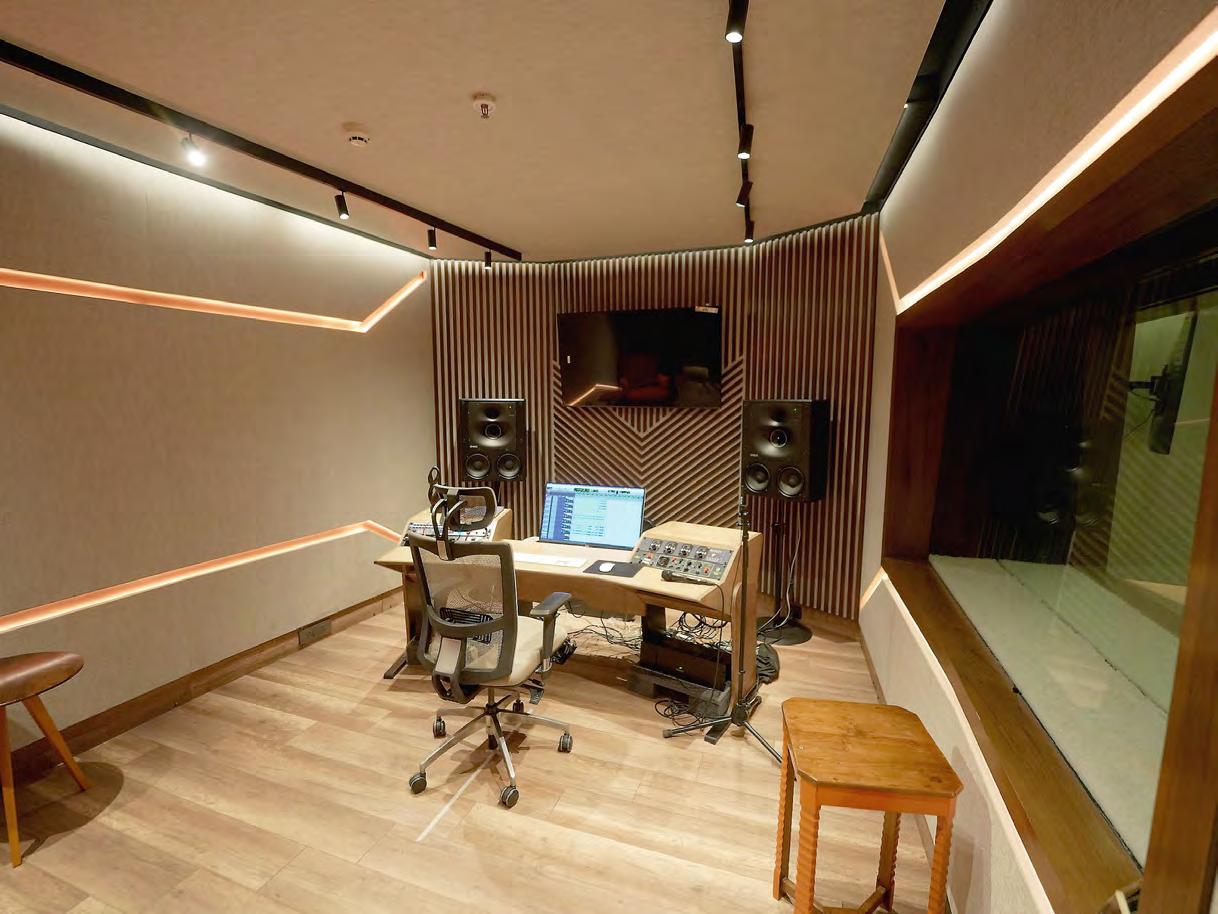
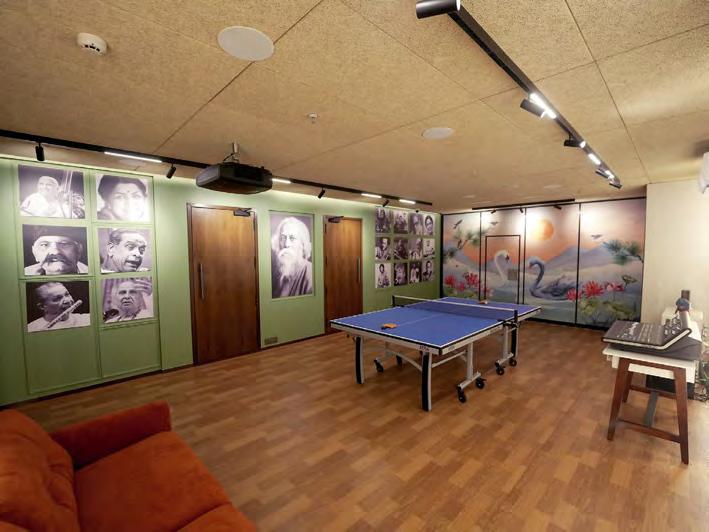
Caroline Moss visits an aptly named Mumbai studio where a renowned playback singer can retreat to unleash her creativity
INDIAN VOCALIST SHREYA GHOSHAL HAS FULFILLED a long-held dream of having her own studio, opening The Sanctuary in the recording stronghold of Linking Road, Santacruz West. Nicknamed “the Queen of Dynamics” for her remarkable vocal range, the multiple award-winning Ghoshal chose the studio name to reflect her vision – a creative haven where she can work spontaneously and collaborate with fellow musicians.
“I always wanted a place where I could come to create, to think and make music at my own pace without having to book a studio,” she explains. “I wanted somewhere to my taste, that sounded the way I wanted it to, with the right ambience. As an artist, your space to create should feel like a second home.”
A suitable premises became available near Ghoshal’s home in Mumbai. Initially, her father, Biswajit Ghoshal, had planned to use the two adjoining residential units as a workshop for his DIY projects and to teach children building skills, occasionally sharing the space with his daughter for recordings. But those plans changed when Munro Acoustics came on board, reimagining the space based around a multipurpose, divisible live room essential to Ghoshal’s vision of a welcoming, collaborative environment for other musicians to drop by, jam, rehearse or hold songwriting sessions. Munro’s team, recommended by Ghoshal’s long-time engineer and technical advisor Chinmay Harshe, presented several designs and layouts. Once a decision had been made, the project took off quickly. Construction began in August 2024 and wrapped up in four months, with Mr Ghoshal lending his extensive engineering and DIY expertise to the build. Some test recordings were done in November, and the facility was in use by January.
Harshe helped select equipment including microphones and speakers. “I already had a Manley reference mic that I bought during Covid when I had a small home studio,” she says. Also available are microphones including AKG C414, Shure SM57, SM58 and Beta 52A, Neumann M 149 Tube and K 184 and Audix DP7 drumkit models. Mic preamps and effects include Manley Force 4-Channel Tube, Chandler Limited TG Microphone Cassette and Universal Audio 4-710D units.
A pair of Genelec 1238DF SAM studio monitors and a 7370 SAM subwoofer were chosen for the control room, with plans to upgrade to a 5.1 surround system. “Genelec is a standard in all the studios where we’ve worked, and [Indian distributor] Sound Team is located in the same building, with a demo room where we tested different

models,” explains Ghoshal. An SSL Big Six provides a selection of preamps and EQ while enhancing workflow and routing capabilities, a Lynx Aurora interface handles AD/DA conversion and a Midas M32 is on hand for live sessions in the multipurpose space.
Munro director and acoustician Kapil Thirwani enhanced the studio’s flexibility by adding a fully retractable door that transforms two separate rooms into one space of approximately 60m2 for larger gatherings. An in-ceiling SpeakerCraft 7.1 system comprising Profile AIM 7 Two speakers and an SDSi-12 subwoofer, together with a drop-down Epson 4K laser projector and screen, facilitates live performances, recording sessions, workshops, lectures, film screenings and even table tennis tournaments. It has accommodated up to 30 musicians, including full string sections as well as providing a rehearsal space for Ghoshal’s live shows, which feature between nine and 16 people.
Ghoshal herself contributed greatly to the interior décor and styling of the studio. For the vocal booth, she designed an abstract mural to represent the tree of life made from acoustic materials, giving performers the impression of standing under a tree for protection.
The booth’s mic stand was built by Mr Ghoshal using recycled wooden planks, while soundproofing includes fibreboards made from recycled PET bottles painted with murals of swans, symbolic of Saraswati, the goddess of music and learning.
Extending the natural theme, wood, stone and warm earthy tones give the studio a grounded, calming feel. Ghoshal has even brought some furniture from her home, and encourages people to leave books, instruments and other personal items behind, enhancing the concept of a shared creative space.
“The studio has become a favourite with the people I work with,” she says. “It’s not possible for me to be here all the time, and a space like this shouldn’t be underutilised, so I encourage likeminded people to come and use it.” American saxophonist Mark Hartsuch, now based in Mumbai, recently gave a workshop there, and more are planned, both for professionals and students. Ultimately, Ghoshal’s studio has given her unprecedented levels of spontaneity. “We can be impulsive now,” she says. “The workflow is so easy that we go from having a cup of tea to writing songs that I feel like doing in the moment. Since the studio opened, I’ve recorded three or four independent songs and released them within three days. It wouldn’t happen like that if I was relying on booking an outside studio.”
www.genelec.com
www.munro.co.uk
www.sanctuaryaudiovisual.com



SINCE ENTERING THE CHINESE MARKET OVER 30 years ago, TOA has become a leader in airport public address systems. After years of market development, the global audio manufacturer has solidified its position through consistently reliable product quality and a strong localisation strategy, allowing it to maintain a leading role in the country’s airport sector.
“TOA products perfectly match the requirements of mega airports,” comments Kang Shixin, general manager of Peidanzi (Beijing) Network Technology, TOA’s airport industry dealer. “Most importantly, their products rarely fail. PA systems at large airports withstand extreme workloads. Systems operate almost 24/7, and even a few minutes of interruption in broadcasting can be a serious incident. Therefore, the products must meet the most stringent requirements not only in terms of functionality but, more importantly, in terms of quality.”
Peidanzi (Beijing) Network Technology was formerly TOA’s dealer in Heilongjiang province and, from 2020, the company shifted its focus to the airport sector. To date, TOA has successfully won bids for numerous mega airport projects including Hohhot Shengle International Airport, Jinan Yaoqiang International Airport T2, Zhuhai Jinwan Airport T2, Hefei Xinqiao International Airport Phase II and Taiyuan Wusu International Airport T3.
With a total investment of RMB50bn, the recent Jinan Yaoqiang International Airport T2 project encompasses the 600,000m Terminal 2, with 173 aircraft stands – 145 of which are passenger stands – and an annual passenger throughput designed for 55m. The PA systems for T2 and the General Transportation Centre (GTC) at the airport utilise the TOA 3000 series intelligent networked PA/integrated voice alarm system, providing reliable support for both daily business and emergency broadcasts. At the heart of Yaoqiang Airport terminal 2’s PA system are two IP-3000SM system managers, one of them for backup, located in the PCR (primary computer room). This ultra-large digital network system, built with switches and running on the TCP/IP Ethernet protocol, provides centralised management of microphones, audio interface units, digital amplifiers and loudspeakers. The PCR is also equipped with multiple digital audio processors for automated
announcements, intercoms, text-to-speech (TTS), background music and fire safety. An audio matrix controller providing fire alarm audio warnings as well as a background music player are also installed in the PCR.
The terminal’s amplifiers are located across nine converged control rooms and integrated with TOA’s 3000 Series PA/ integrated voice alarm system, including audio matrix controllers, digital power amplifier modules and network audio input/output units. A total of 121 touchscreen microphones are deployed across the fire control centre, fire control room, airport operation centre, terminal operation centre, various operations and
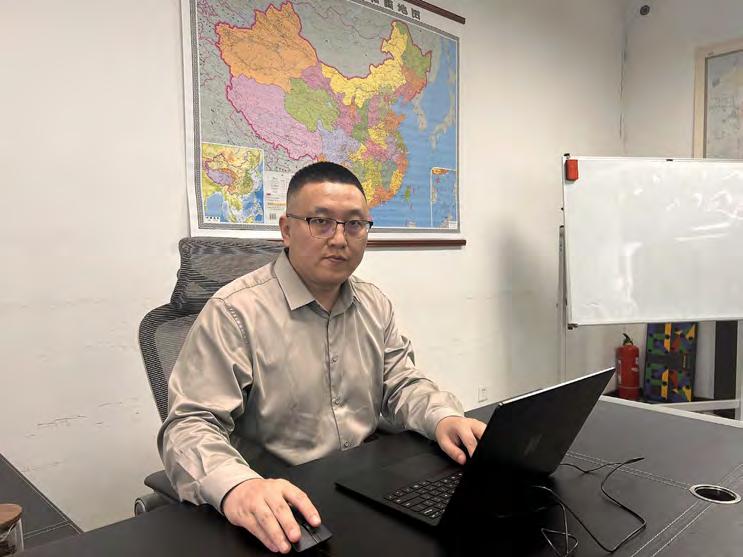
“Yaoqiang Airport’s terminal building, GTC and parking building together account for nearly 1m m2, with over 700 output channels; not many manufacturers can support such a large broadcasting loop,” explains Kang. “We selected TOA’s 3000 Series after thorough research. A single mainframe




supports a 1024x1024-channel audio matrix, allowing flexible configuration. Most products on the market would need multiple units stacked together to meet the 1024-channel requirement, which increases the number of failure points when one-to-one hot backup is needed.”
Ensuring a system continues to operate while a backup is in progress, hot backup is a requirement for PA systems at Chinese civil aviation airports. In 2020, the Civil Aviation Administration of China issued Guidelines for the Construction of Four-Type , outlining the development of future airports based on the principles of “safety, greenness, intelligence and humanistic

system manager failed, the voice evacuation frame can still operate independently. Even in the unlikely event of a CPU failure in the frame, manual announcements can still be broadcast. This isn’t a feature that all brands offer.”
Another mega airport project recently supplied by Peidanzi (Beijing) Network Technology is Hohhot Shengle International Airport, Inner Mongolia’s first 4F-level airport, the highest classification for civil aviation airports. The terminal building covers 260m2, with 130 aircraft stands and an annual passenger throughput designed for 28m. Shengle Airport’s PA and fire emergency broadcast system has over 300 output channels, also
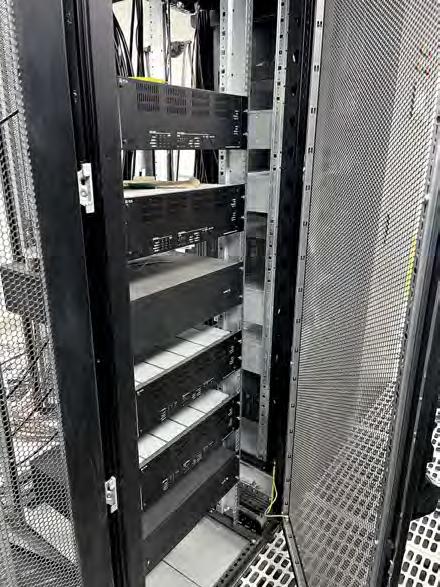
voice alarm system as its core architecture. Spanning Terminal 1, the parking area and the GTC information building, nearly 100 touchscreen microphones and nearly 3,000 various TOA speakers have been installed.
The construction of Shengle Airport was extremely fast-paced, with TOA’s localisation strategy ensuring all supplies were delivered quickly via domestic production chains. As TOA’s airport industry dealer, Peidanzi refined the needs of the airport and the client and fed them back to the manufacturer’s R&D department to further enhance product performance.
“More than half of our success is due to TOA’s trust and strong support,” attests Kang. “Airport projects often require 2–3 years of early involvement, with no returns during this period. Without the manufacturer’s support, we wouldn’t have been able to persevere for such a long time. The excellent quality of TOA products has also been a significant benefit to us. Taiyuan Airport T1 installed TOA 11 years ago, and the system has never had any issues. It wasn’t until 11 years later, when the power amplifier started to report a red light, that they returned to us. From the operators to management, they were extremely happy with the system, which helped us win the bid for T3.”
Concludes Yang Ruizhe, general manager of TOA (China) Beijing Branch: “TOA has been in China for over 30 years. With the rapid development of China’s economy, the company has also achieved remarkable growth. From its humble beginnings as a trading company to TOA (China) today, from early analogue to digital to today’s large-scale networked PA systems, the profound transformation of the Chinese market has also been a catalyst for product upgrades. As a global company with over 90 years’



SITUATED TO THE NORTH OF MUMBAI, MIRA-BHAYANDAR is an outlier of the city’s film industry, with major players including virtual production (VP) specialist K Sera Sera and its subsidiary, KSS VP Studio, which has recently invested in a large volume of Absen NT2.6 XR panels. The first facility in India to deploy Absen’s XR panels at this scale, the acquisition allows creative teams to build up LED walls by adapting the volume for specific production needs, whether expanding the vertical height or the horizontal wrap. When Pro AVL Asia visited an 18m x 5.5m LED volume was being managed by NovaStar MX40 Pro LED display controllers.
KSS VP Studio has two major shooting floors: Stage One, featuring the LED volume where virtual environments are created, and Stage Two, a chroma (green screen) floor for more traditional VFX-based production. The studio operates as an end-to-end production house, offering services from concept to postproduction. The 750m2 Stage One offers an integrated workflow whereby physical sets are built in front of the LED walls to extend realism while digital environments seamlessly stretch the physical world into the background.


The Absen 2.6 XR panels were supplied to KSS by Satish Molasi from Molasi International, Absen’s Indian distributor for the past three years. They are designed to reproduce high-quality imagery with an emphasis on true blacks – vital for creating the believable, immersive environments needed for VP – and providing a rich colour palette and high dynamic range, even when operating in Standard Dynamic Range (SDR). These features have been specifically designed for VP, where the visual fidelity of digital backgrounds must blend seamlessly with physical foreground elements. Control is provided by NovaStar MX40 Pro LED systems which offer HDMI 2.0, DP 1.2 and 12G-SDI input connectors, 20 Ethernet output ports and four 10G optical ports as well as being compatible with the new
VMP (Vision Management Platform) software.
“The Absen panels are very rich in quality and produce colour well while also offering the final controls that the DOP [director of photography] requires, providing the lighting to match,” says Prakash Kutty, an accomplished Indian cinematographer working at the studio as head of virtual production, known for his keen eye for composition and lighting. “For example, if there is a little bit too much magenta we can get rid of the those tones, grading it very evenly. The panels have a high dynamic range.”
A key component of VP is parallax realism – the accurate simulation of how objects appear to shift relative to each other.
Using real-time rendering systems like Unreal Engine, digital scenes are synchronised with camera movement, creating a sense of depth and authenticity. This process, known as In-Camera Visual Effects, eliminates the need for months of postproduction VFX work. Once a shot is captured, it’s largely ready for final edit, significantly streamlining workflows.
The studio’s virtual production supervisor Harshit Sinha, who trained as a computer science engineer, entered the world of VP unexpectedly when the Covid-19 lockdown created a two-year hiatus
at the end of his studies. With a passion for game development and experience in coding, he found the VP environment to be a natural fit. A big inspiration had been Jon Favreau’s Star Wars TV series The Mandalorian and its extensive use of the StageCraft VP system. Powered by Epic Games’ Unreal Engine, this is used in gaming applications to render digital environments onto large-scale LED walls and ceilings, creating a real-time, in-camera backdrop for live action sets. A successful interview saw Sinha rapidly transitioning into the film industry, relocating to Mumbai from Bangalore in the space of three days. His hybrid background has enabled him to bridge the gap between software development and cinematic storytelling, a valuable asset in this cross-disciplinary field.
“I knew a little bit about coding but wasn’t that interested in it,” he relates. “I wanted to explore something beyond what I can see around me, and I was drawn to game development. Then, by chance, Unreal showed me the demo for virtual production in the film industry.” For somebody from a computer science background, the creative avenues that this opened up was quite a shift. “From an engineer’s point of view you don’t expect to be a creative, but now there’s this crossover which combines with my technical ability, so I could leap forward very quickly,” he continues. “I could
certain things which I couldn’t have done if I was solely a creative person rather than a technician.”
At the time of our visit, Sinha was working on an Indo-German co-production involving a gondola-lift sequence set in a mountainous region. To prepare, the crew conducted camera and lighting tests with the production team, ensuring all equipment was calibrated to work within the LED volume. A major scene involves the destruction of the gondola, requiring complex previsualisation and practical rigging. The team was creating both real and virtual lighting environments for the upcoming sequences including the mountain scenes, which would have been expensive or logistically challenging to shoot on location.
VP requires tight collaboration between traditional and emerging disciplines to succeed. Sinha and his team work closely with directors, DOPs and production designers from the early stages to align lighting, composition and set design with the virtual assets. A virtual art department (VAD) works as an extension of the production design team, crafting digital sets such as mountain ranges, forests and city streets, tailored to the specific cultural and visual context of each film, whether it’s set in India or abroad. Details such as the type of road surfaces, local trees and atmospheric conditions are meticulously crafted to ensure realism and cultural accuracy. When physical props are used in the foreground, the team ensures that lighting and scale match the digital background, with the same lighting setup mirrored within the virtual scene to ensure continuity and immersion.
Sinha outlines the advantages of working with VP on a recent shoot for a six-episode web series set in a coal mine in Madhya Pradesh. “This was a big challenge as it was obviously going to be very difficult to shoot with a total crew and cast of 200 people inside a coal mine, with the attendant health and safety hazards,” he explains. Using VP, the team recreated the mine environment digitally, combining foreground sets with LED-driven backgrounds. This allowed complex scenes to be shot safely and efficiently while preserving authenticity.
VP is still in its early stages in India, but it has the potential to redefine filmmaking across the country; indeed, Molasi was able to confirm recent sales of similar setups to three more major studios.
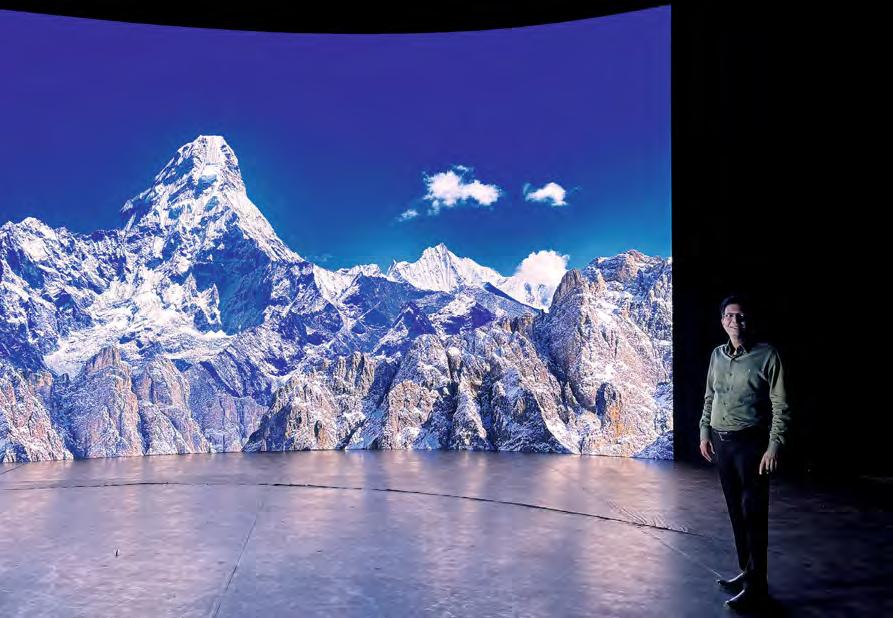
Filmmakers can realise ambitious visions without requiring large budgets or international travel and, as technology becomes more accessible and more artists and technicians train in hybrid skills, VP could become a standard part of Indian film production. The convergence of technical and creative skill sets is enabling a new breed of film professionals like Sinha to navigate both the technical and the aesthetic elements of filmmaking. And while VP isn’t a
replacement for traditional filmmaking, it expands what’s possible, allowing dramatic scenes like mountain rescues to be filmed within a controlled studio environment in Mira-Bhayandar.
www.absen.com www.molasiinternational.com www.novastar.tech


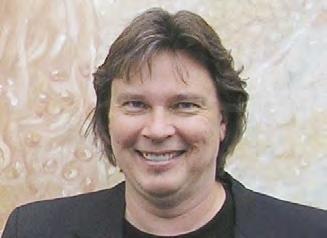
Like an urban InfoComm, Nashville’s noise is music to the ears of sound system manufacturers. Dan Daley listens up
NASHVILLE’S FAMED MUSIC ROW IS MOSTLY GONE.
The pair of avenues that once housed recording studios and record label offices now looks more like Shanghai, lined with glass and steel office and condo towers. The labels have moved downtown, where even taller, glassier skyscrapers populate the city’s rapidly changing skyline, and the recording studios… well, that’s another column for another time.
But there is still one place where music dominates. The city’s main entertainment district, a five-block stretch on Broadway ending at the Cumberland River, has transformed from a seedy array of bars and tourist traps 20 years ago into a country music Disneyland. There are still plenty of bars and tourist shops, but they’re dazzling, noisy, pricey shrines to the growing number of country music stars whose names are plastered on their marquees. Jason Aldean, Luke Bryan, Blake Shelton, Garth Brooks and Eric Church, as well as rocker Jon Bon Jovi and (relatively) recent country convert and rapper Post Malone, all have licensing deals on the strip. (It’s not like you’ll actually see any of them there other than the occasional, calculated photo op.) It’s where visitors to the city spent much of the US$11.2bn the city took in last year from tourism. This is all
imported money – Nashville residents have a relationship with Broadway similar to that of New Yorkers with Times Square: they simply do not go there, ceding it to the tourists. But something else is happening there that’s of great interest to the live sound business. All of these monikered venues are competing on installed sound as well as celebrity status, and the companies that make those systems have noticed. The biggest names are there – d&b audiotechnik (Bourbon Street Blues & Boogie Bar) and L-Acoustics (Garth’s Friends in Low Places). But the sheer scale of the strip has opened up opportunities for a range of other brands. The Italian RCF (Jelly Roll’s Goodnight Nashville) and Canadian PK (Malone’s Posty) marques are represented as well as Spain’s DAS Audio (Luke Bryan’s 32 Bridge). Ironically, few American brands have managed to make the cut, though QSC is installed at Kid Rock’s Big Ass Honky Tonk and John Rich’s Redneck Riviera. These clubs have become flagships in that category of venue. It is, in effect, a kind of urban InfoComm, a showcase for manufacturers and integrators to invite prospective customers and clients down for beer and a listen.
It’s a rare opportunity, as this category of music venue continues to contract, a trend precipitated by the Covid
pandemic and continued by the growth of high-ticket touring that sucks up consumers’ entertainment dollars, leaving little for the neighbourhood pub stages. And in an odd twist, listeners can compare the sound of the same songs from venue to venue, as the musicians work from common playlists ginned up by requests from patrons and radio, performed by a crew of grafter musicians who rotate through the clubs.
The sheer number of venues needing quality sound in this compact location means there are ample opportunities for a multitude of brands. That’s critical at a time when the number of brands dominating the live sound market – the so-called contract rider-friendly ones – can be counted on one hand. As the owner of one integration firm pointed out to me one evening downtown: “You don’t always have to live in ‘riderfriendly world’ and, oftentimes, you can blow out your budget trying to do that and not need to.”
Nashville’s Lower Broadway may be properly denigrated as a lager-drenched theme park. But the patrons are having fun and spending freely while the sound systems are getting a workout and a marketing effort that no intentional campaign could ever have dreamed up.

The advent of stereo in the late 1950s was mystifying, rarefied and confined to the few. Phil Ward explores the parallels with today’s immersive world
THE CONCEPT OF THE AUDIOPHILE WAS WELLestablished by 1959. A BBC documentary of the time is called Hi-Fi-Fo-Fum and if you think that sets a withering, patronising tone you should listen to the voiceover: “There is a man in Wimbledon who will go on adding to his equipment until he can hear the sigh of the conductor as the piccolo misses its entry… is it a religion or a disease?”
These “high priests of flawlessness” are seen fussing and fiddling over labyrinthine wires and frequenting a new kind of shop, one that sells all the kit and is staffed by characters in duffle coats with goatee beards and horn-rimmed spectacles. “Do they like music or are they in love with equipment?” the programme asks. In due course, a breakthrough called stereo – pronounced “steer-reo” – is heralded as “three-dimensional reality”, and this is where we notice how perceptions are recalibrated over the years. Just as listeners to Edison’s demonstrations of the phonograph weren’t sure – imagine – of the difference when confronted with AB comparisons between the recording and the real thing, live onstage and hidden behind a curtain, it was possible in the late 1950s to portray stereo in exactly the same terms as we describe spatial audio today. Life copies art but also, eventually, it copies marketing hyperbole.
That documentary film was directed by John Schlesinger, who went on to make Billy Liar, Midnight Cowboy and many other Hollywood corkers. No doubt the liars and cowboys of hi-fi consumer retail were a great inspiration. But the year is significant: the culture of “high fidelity” is clearly reaching a critical mass because it’s not only attracting the attention of BBC documentary makers. In 1959, the magazine Tape Recorder was launched, combining consumer interests with professional issues (inside vol no 6, July: “The Art of Tape Editing”; “Tape Decks analysed”; “This is Copyright”; “Recording Nature’s Sounds”). Within a decade, it would evolve into Studio Sound, the complete trade package. Back then, fidelity was a studio matter. It could only be attempted in the hush, firstly, of a recording session and, later, the kind of home with the right amount of aspiration and pipe tobacco. There was virtually no such thing as concert sound; a couple of cinema columns if you were lucky. Nowadays, the full quest for as many dimensions as possible has reached the stage, the auditorium and the box office, where an increasing number of tickets are being sold next to a poster somewhere upon which you will find the word “immersive”.

In Paris recently, the famous escalators running up the outside of the Pompidou Centre were appended by d&b audiotechnik’s compact E-Series loudspeakers to deliver sounds and voices collated by Icelandic noise-pixie Björk and processed by Soundscape and SPAT Revolution, the FLUX:: Immersive spatial algorithm now owned by Harman Professional and partially developed by the Institute for Research and Coordination in Acoustics/Music (IRCAM) based beneath this very building. Björk’s Nature Manifesto was “a haunting, immersive presentation” on the theme of endangered and extinct species, many of which used to work in Radio Shack.
The World of Hans Zimmer – An Immersive Symphony has just wowed them at the Metronom Theatre in Oberhausen, Germany – 22,000 fans at 15 sold-out concerts – using a combination of spatial audio and Sennheiser’s Spectera wideband wireless system, before setting off around the world. And, in Stuttgart, Kraftwerk continued their campaign for real audio with a 270° Soundscape system, once again deployed as if it really were a studio production by FOH engineer Serge Gräfe, the “fifth member”.
Tape, of course, is history. Then again, aren’t we all?

Lawo’s HOME Apps processing platform empowers broadcasters to create efficient, dynamic media facilities with maximized infrastructure utilization. Paired with Lawo’s .edge SDI-to-IP gateway, the new HOME Intelligent Multiviewer minimizes bandwidth and CPU usage by intelligently selecting optimal downsized video proxies for layouts.
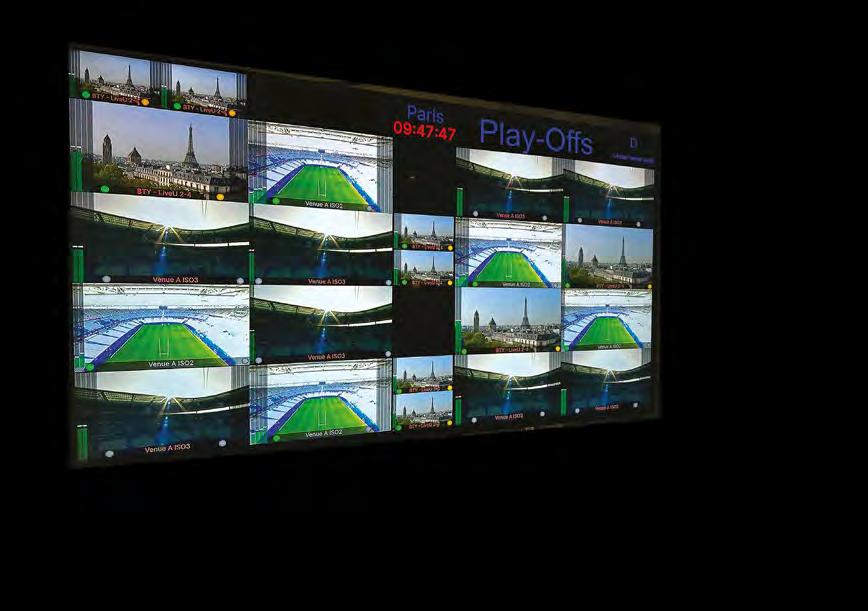

Most visitors looking to find something new at this year’s Integ away with an overwhelming sense of déjà vu, reports
MEMORIES OF MOORE PARK, HOMEBUSH AND THE Melbourne Convention and Exhibition Centre remained distant memories as the exhibition reopened its doors at Sydney’s ICC for the fourth consecutive year. Celebrating its 16th anniversary, the AV-savvy show once again teamed up with the Security Exhibition & Conference to create a larger footprint. Both paid and free educational classes and workshops lie at the very heart of Integrate, with the AVIXA Education platform focusing on helping the industry understand new market opportunities. The topical Tech Talk forums enticed many visitors away from the show floor, with panelists discussing a wide range of pertinent topics ranging from immersive technology, AI in AV, strategic hardware planning, skill evolution in pro AV and AV solutions in agile working environments. Others sampled the latest technologies in Barco, Bose Professional and Harman Pro demo rooms.
The projection and LED exhibits of bygone years seemed reduced, despite the attractions on the Panasonic Connect, Westan Australia, ULA Group and Yes Tech stands. However, the more experienced exhibitors know how to attract crowds and keep them on their booths without losing them to competing companies; excellent hospitality always helps. Exemplifying this was Crestron ANZ, celebrating its 10th anniversary. Drawing residential and commercial installers alike, the booth showcased UC technologies under the banner of Content, Collaboration, Control.
A decade has passed since Jands ceased distribution of the Harman Pro brands and the subsequent disruption continues to shape the layout of the audio exhibits. Following Harman’s recent decision to place all their brands under one roof, the MadisonAV booth showcased the entire portfolio. The Jands booth itself was awash with the latest products from Blaze Audio, Clear-Com, Dynacord, Electro-Voice, L-Acoustics, RF Venue and, of course, Shure which continues to celebrate its 100th anniversary in style.
It was business as usual on the Technical Audio Group (TAG) booth where Italian coffee aromas enticed consultants, SIs and end users. The gravitational pull of Q-SYS is unmistakeable, but Allen & Heath, Audio-Technica and
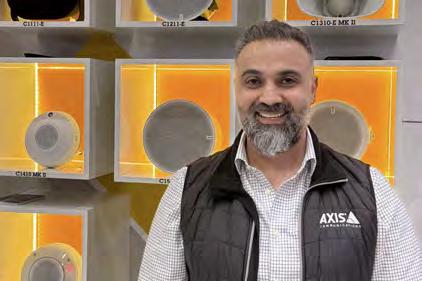
Oshana Jouna, AXIS Communications:
“Axis is showcasing security technologies at Integrate, with a wide audio range of loudspeakers and software solutions, including Audio Manager Pro, that are designed to drive these systems. Since the Integrate and Security exhibitions united, we have positioned ourselves on the border of both floors. Next year’s proposal to separate the shows on different levels will lead to us dividing our presence both upstairs and downstairs. However, this year, the foot traffic has been exceptional, and our teams have enjoyed quality conversations. In addition to meeting existing systems integrators and consultants, we’re also meeting some new ones and a few end users.”
Martin Audio

Elsewhere, tweaks to portfolios could be found among established distributors, including Xilica and Production AV Technologies with a display of Luminex switchers.
Exhibitors such as Sennheiser were making a concerted effort to promote their software enhancements. Enticed by the EW-DX wireless platform and TeamConnect Ceiling Medium conferencing products, visitors were then given demonstrations of the latest web-based software updates to Room Planner, Mobile Connect and Control Cockpit.
The presence of Blackmagic Design, OnAir Solutions (Sonifex Australia), Qvest, Riedel, Ross Video and VITEC suggests that the worlds of AV and broadcast continue to converge on the same HDMI and AVoIP networks. PAT made an impressive debut promoting broadcast solutions including Lawo console technology and RTW loudness meters. As

Bryan Rekstein, VITEC:
“Now we are coming out of austerity, the VITEC team is reinforcing its partnerships with customers in the traditional hospitality and entertainment sectors. Australia is one of our most dynamic markets and many of our projects are on a scale rarely seen elsewhere. There’s a definite drive for investment in technology to make operations more efficient. Tradeshows around the world are very dynamic and Integrate is probably fading. However, I believe VITEC met its expectations in terms of visitors to the booth, which was helped by hosting a happy hour each evening to meet partners on a more personal level.”
reflect today’s AV industry in Australia. Tradeshows may not be compulsory for every Australian reseller or distributor, but Integrate certainly excels at aggregating the main movers and shakers in Australian AV, broadcast and production.
2025 Dates: 27 – 29 August
2026 Dates: 2 – 4 September
Venue: ICC, Sydney
Total exhibitors: 250
Attendance: 12,800
Contact: www.integrate-expo.com
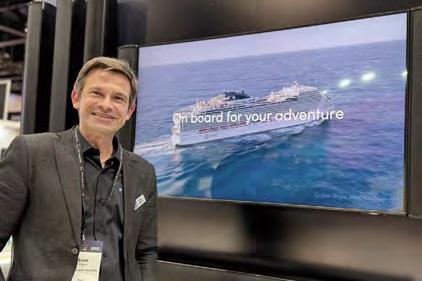
Scott Angove, Audio Brands:
“Over the course of the show I have enjoyed back-toback quality conversations. There is always a buzz when exhibiting brands such as Fohhn, but now we have added Xilica to our portfolio there is a new dynamic. The pairing is powerful for the UC sector, and I feel that we are entering a very exciting period, because there is a growing demand for premium sound from corporate to stadium level, with a particular focus on the education sector. There is a requirement to make these rooms sound much better, which is where Fohhn technologies are best suited.”

Treva Head, Qvest Australia:
“We have been exhibiting since 2012 because the format of the show allows us to host around 20 quality daily meetings. We prefer to network with end user clients who are more specialised in government and enterprise. If it’s big and complicated, we’re interested. By focusing more on conversations and less on the products and technologies, we can better understand what customers require to deliver a more bespoke design for their individual needs. We have met lots of pro AV and security professionals and I’ve been encouraged by the high attendance of broadcasters. With a good mix of audio, video, flight gear and staging being exhibited, Integrate draws a wider audience to Sydney ICC.”
Patrick Salloch, PAT:
Dave Lowton Cogworks:
“We’ve only been representing Christie as a distributor in the enterprise and pro AV sector for the past six weeks so, to exhibit at Integrate, we had to work to a very truncated timeline. It’s been great to meet the dealers and the systems integrators at the show, and we are grateful to Jason Yeo, who has flown in from Singapore to assist us. Targeting more budget-conscious applications within the enterprise market, we have met a lot of existing Christie customers. Overall it has been a worthwhile exercise judging by the amount of exchanged business cards and scanned badges.”


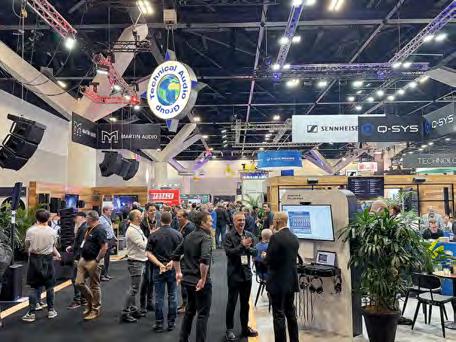
“We normally exhibit at SMPTE, which is more aligned to the broadcast community, and this is the first time we have exhibited at Integrate. With the convergence of AV and broadcast technology, the timing was right to exhibit this year because Lawo needs to better penetrate the AV and corporate workspaces. With more banks and corporate companies wanting to build broadcast infrastructures within their hubs for their meetings and internal communications, broadcast quality is in demand. The specialist expertise required for networking is beyond IT and, with the adoption of AV as a service in multi-venues, I have been involved in some interesting conversations.”


“Integrate is an important part of our industry, and PAVT must exhibit to educate and create more opportunities. The market’s been flat since 2019, and we have not fully recovered yet from the pandemic, but there is a vibe now that hasn’t been evident in recent years. You cannot determine whether an exhibition will instantly generate an ROI because you can never be sure whether your appearance was the reason you won the business or not. Solving Australia’s current economic factors will take time, but this year has certainly been the best. The industry has finally woken from its slumbers with consultants and SIs specifying for projects.”
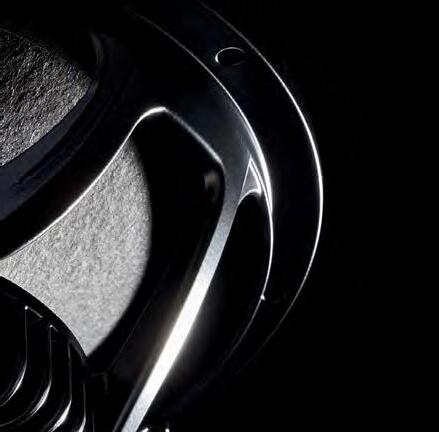




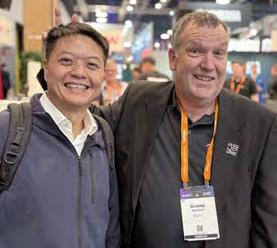



Caroline Moss reports from the Jio World Convention Centre at Mumbai’s BKC, which hosted InfoComm India for the third time
EXPLORING THE LATEST ADVANCEMENTS IN AV, digital signage, smart technologies and communication solutions, the latest edition of InfoComm India again outstripped its forerunners in terms of footprint and attendance. Now in its 13th year, the show has become a key networking, knowledge exchange and business platform for the AV industry across south Asia and beyond. And having overtaken China as the leading AV performer in APAC due to increased infrastructure investment and a growing demand for immersive technology-enabled experiences, India is deserving of such a platform.
This year’s show was more international than ever, attracting visitors from 30 countries – double the amount from 2024 and demonstrating India’s rising prominence as a regional AV hub. Show organiser InfoCommAsia had invited 75 guests it considered “high-value” from across India and the Middle East, while a reported 28% of visitors were technology end users. Demand for more floorspace increases annually, but last year’s expansion into the Jasmine Hall on level three of the Jio World Convention Centre wasn’t entirely successful. Separated by two floors from the main exhibition on the ground floor and reached by three sets of disconnected escalators, it felt like an under-
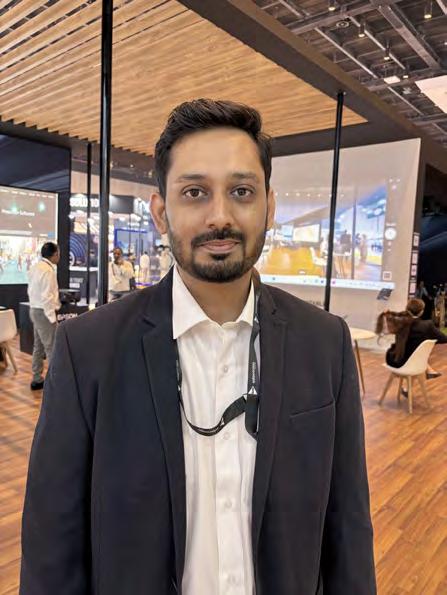
attended add-on to the main event. This year, InfoCommAsia had cleverly located the show registration just outside the entrance to the Jasmine Hall, and the hall itself felt like a proper extension of Pavilions 1–3 on the ground floor, despite the distance. Companies including Extron, K-array, Televic, Audac and BXB were enjoying good traffic which, at times, could seem at the expense of the ground floor as visitors began their journey on level three after registration, taking their time to filter back down. For 2026, the show’s level-three footprint looks set to grow further, with plans to expand into the adjacent hall, at which point Jio will be at full capacity.
New features this year included demo rooms taken by Harman, Jabra and Silicon Radio House; the InfoComm Smart Tech Stage which hosted a schedule of seminars on industry topics; and AVIXA Xchange Live, bringing the online community onto the show floor for sessions including the AVIXA Women’s Council, Rising Professionals and AV/IT Community Meetup. Prior to the show, AVIXA also held its inaugural Indian in-person CTS (Certified Technology Specialist) training, with all the days sold out, underscoring the country’s demand for world-class certification. AVIXA continues to advance the industry through debate and education, and the summit featured more than 50 speakers
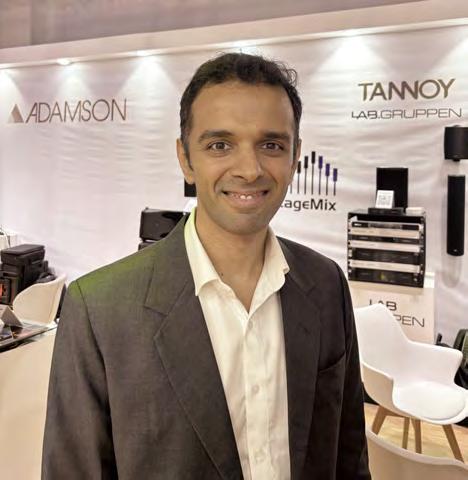
seeing very serious buyers and customers looking to invest in newer technologies. The budgets have gone up and it’s all very optimistic for the future.”
across over 60 sessions with a focus on how AI can be integrated across enterprise, education, government and media environments. “India’s rapid technological adoption, especially in AI, presents a massive opportunity, and InfoComm India’s role is to ensure our industry is ready to seize it,” said June Ko, executive director of InfoCommAsia. “This year, our summit is laser-focused on AI readiness and industry upskilling. Through hands-on workshops, expert-led sessions developed with our partners and premier training like AVIXA’s first in-person CTS course in India, we are providing the essential tools for professionals to master these new technologies and drive innovation across all sectors.”
2025 Dates: 9 – 11 September
2026 Dates: 16 – 18 September
Venue: Jio World Convention Centre, Mumbai
Total exhibitors: 200
Attendance: 12,606
Contact: www.infocomm-india.com
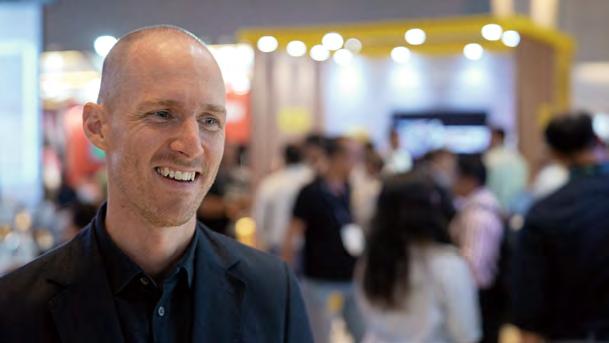
“It’s been fantastic to be here in Mumbai at InfoComm India 2025. India is a really key market for Jabra now, it’s one of the markets where we’re seeing double-digit growth. This year we’ve launched the PanaCast 40 VBS, our latest small room video conferencing solution, and it’s been great showcasing that to customers and partners and seeing the positive response we’ve had to it on the floor.”
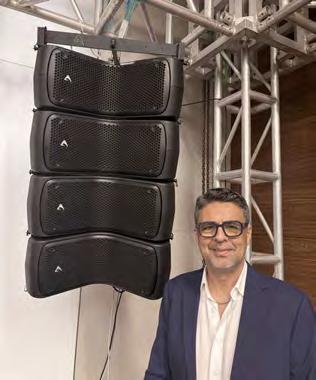
Rohit AK, Avocor:
Chandan Mahtani, Proel:
“We’re excited about being at InfoComm India for the first time, and having a demo room. It’s the first time that we’ve shown Proel’s Axiom brand in the Indian market, so customers can hear what it’s all about, and all the brands under the Proel umbrella. It’s very clever that the show organisers are now offering demo rooms; we are one of just three companies to take one. It’s an acoustically treated environment where you can demonstrate your products one-on-one. The clients who come here are very specific, and some of them are even bringing their own microphones to hear how they sound with our speakers.”

“Just like our booth size, our business has doubled over the past year. Last year we had a smaller one at a 55m today, we are at 105m definitely demands that we have a much bigger space because the kind of crowd that we are seeing is from across the country. There are people who have flown in from the neighbouring countries too and, judging by the types of conversations we have been having, it’s going to keep me busy for the next six months.”
Rajeev Singh, BenQ:
“InfoComm India has been extra special for us this year because, for the first time, we have had a global launch of BenQ products, which we have never done in the past. We launched our new wireless presentation system, the InstaShow VS25 wireless conferencing system, as well as the InstaShow WC15 wireless presentation system here, and the response has been phenomenal. We have had very good feedback from end customers, especially from the banking and financial sectors, because the VS25 is a completely plug-and-play, hardware-based system.”

Justin Peyton, SurgeX:
“It’s been a really great show. This is the second year we’ve been with our APAC sales agency, Generation AV. We’ve seen approximately 250 customers and the vast majority of them have been systems integrators across all the verticals that we cover. We’re looking forward to growing our business in the Indian market and we’ve seen the right clientele: installers, specialists and integrators, but there’s also been a mixture of end customers and partners. It’s well-organised and easy to get around. This is a huge market and we cover so many different verticals, from IT and AV to pro audio to rental and staging. There are always lots of new customers that are very much aware they need power solutions.”
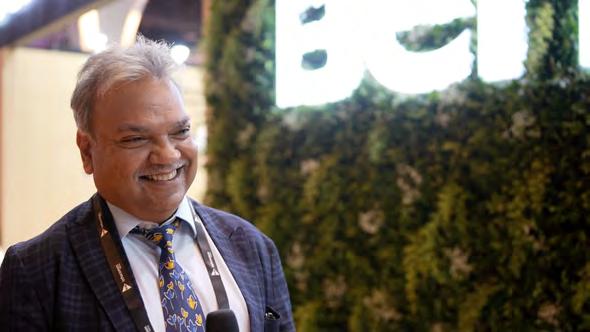
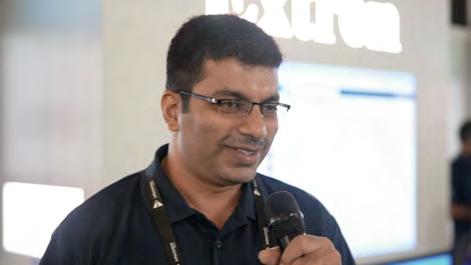
on the third floor, with the registration desk right outside, has been very successful for us – the first thing people see when registering and entering the show is the Extron booth. The brand is 40 years old now, and very established.”


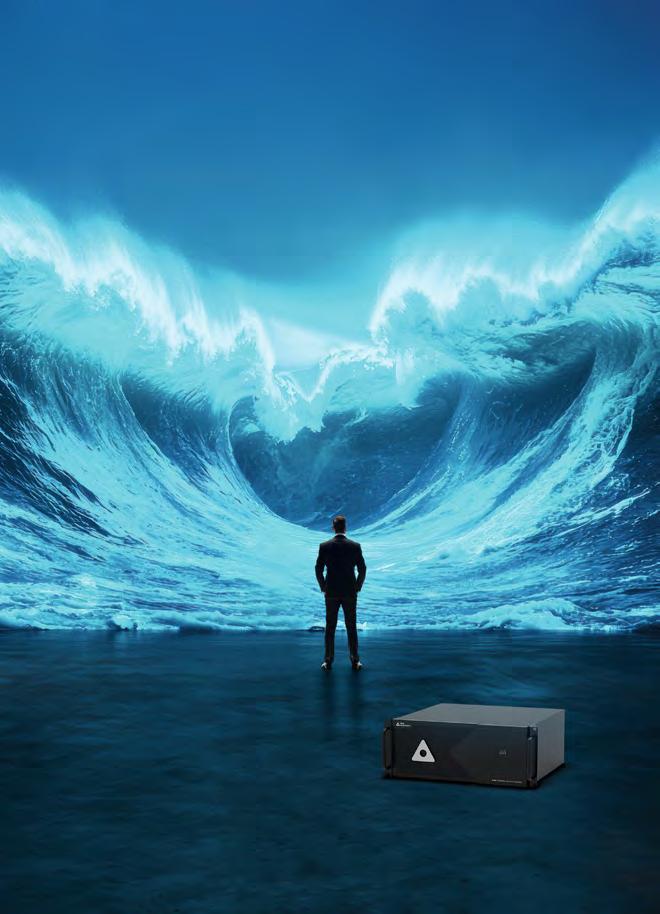
AS TRADITIONAL RADIO AND TV BROADCASTING budgets stagnate at best, IBC has benefitted from the increasing AV and broadcast convergence and a new generation of broadcasters catering for esports and social media platforms. However, a recorded decline in annual footfall this year suggests that some exhibitors are either saving their marketing budgets or prioritising the Mediterranean-adjacent ISE in early
The global media, entertainment and technology communities returned to the RAI’s 15 exhibition halls in Amsterdam to confront pressing industry challenges while seeking new opportunities. “IBC2025 has delivered real business outcomes with overwhelmingly positive feedback from attendees,” commented IBC’s chief executive officer, Michael Crimp. “What struck me most was the sense of optimism and purpose – exhibitors, visitors, speakers and partners all came here to shape the future of our industry. We look forward to continuing the journey together next year.”
Critical trends and issues driving change across the media landscape were addressed by initiatives such as the AI Tech Zone, immersive experiences, over-thetop (OTT) and streaming. Many of these were dealt with during the three-day IBC Conference in the RAI Auditorium Complex in addition to show floor theatres.

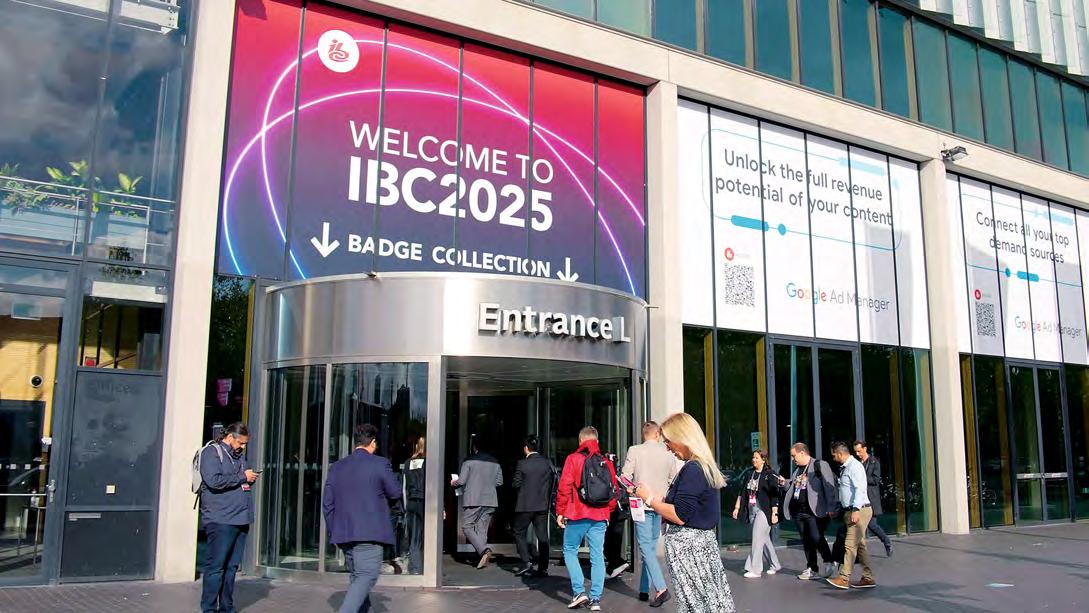
and lightest to date at 165g. The SimplyLive family was also extended together with a SimplyLive Production Suite Flex licensing model, RiView video review system, RiMotion replay bundle and Venue Gateway 1612 Advanced.
A standout feature of IBC2025 was the debut of Future Tech in Hall 14, a dynamic new hub for emerging technologies and collaborative projects. Visitors explored live demonstrations of generative and agentic AI, immersive and interactive media, cloudnative workflows, private 5G networks and sustainable innovation. 4K, 6K and 8K cameras and monitor formats were previewed on booths including ARRI, Blackmagic Design, Canon, Grass Valley, Panasonic, Sony and Ikegami. Following on from last year’s migration to the traditional audio hall (8), Ross Video rolled out Carbonite HyperMax and the NRG compact routers that extend the life of SDI operations – perhaps a new tradition now for the Canadian brand, with an acquisition announced ahead of the European exhibition. This year, audio production software developer LAMA was brought on board to enhance Ross’s live mixing solutions.
Like Ross, Riedel has revealed a penchant for acquiring talented companies on the eve of the show. For 2025, the German brand introduced the team from hi human interface A bemused Thomas Riedel watched as his puppet stole the limelight during the Bolero Mini launch. Integrating technology developed for the RefSuite managed sports production package, the wireless intercom beltpack is Riedel’s smallest
German companies in general were industrious in the runup to IBC2025. Compatible with the XC3, XD3 and XS3 IP cores, DHD’s Routing Web App for management and control was debuted alongside the RM1 audio production system in a desktop unit. Positioning itself as a full-service media solutions provider, Stage Tec unveiled the On Air modular IP-based console for the radio market. Promoting their own WOW factor, the Berliners also highlighted the NEX:T axio IP-based audio I/O and processing platform, together with the software-based Multiviewer Format Converters and IP Gateway video processing. Lawo introduced its upgraded Home management platform, including the Home Audio Shuffler app. With former Home core licences ceasing to exist, flexible control requirements of a specific install can now be scaled up with version 4.x and Home Passes.
Calrec launched its latest and largest Argo M control surface to date with 48 faders together with Argo v1.4 ImPulseV cloud-based DSP processing software. Heralding from the same Audiotonix stable, Solid State Logic demonstrated a range of updates to its System T architecture, including the IP-native MPL Dante-enabled 16-8 stagebox. Additionally, technology partnerships were announced with Dolby, Jünger Audio, New Audio Technology and TiMax for streamlining the creation of NGA content with the integration of third-party control surfaces and processing platforms. Wheatstone paired the LXE and DMX consoles with Blades and the virtual Glass LXE alongside the Wheatstream Duo streaming appliance and the Neuron audio processor. Audio-Technica, Deity, DPA, Lectrosonics, Microtech Gefell, Schoeps, Sennheiser, Shure and Wisycom attracted new and traditional broadcasters seeking wired and wireless microphone technologies, while Clear-Com (Arcadia), Pliant (CrewCom) and RTS showcased their latest
IP comms. It’s one year since the launch of the Spectera bidirectional wideband wireless platform, but Sennheiser is refusing to rest on its laurels during its 80th anniversary year. In addition to Spectera, demonstrations were provided for the SoundBase RF planning tool, Neumann and Merging 7.1.4 immersive setup and Ambeo 2-way channel spatial audio. Twenty years older, centurion Shure highlighted a microphone array for capturing audio in broadcast and media production. Delivering eight channels of audio via Dante or AES67, the steerable DCA901 isolates sound and minimises ambient noise.
While IBC attracts new legions of broadcasters operating in esports, podcasts, TikTok and YouTube, traditional radio and television budgets and visiting engineers continue to decline. If there is an elephant in the room, it is perhaps the AV shadow left behind when ISE bid Amsterdam adios in 2020 for Barcelona. The convergence of AV and broadcasting technologies continues to accelerate and the challenge for the IBC organiser will be maintaining a relevance with its declining broadcast base. With bespoke AV solutions being the driving force for those corporations, financial institutions, stadiums and museums coming to the RAI, Barcelona continues to turn more IBC heads.
And the departure of many corporate heads after day three questions the need for a four-day show, down from the previous five days only after returning from the pandemic.
2025 Dates: 12 – 15 September
2026 Dates: 11 – 14 September
Venue: RAI Amsterdam
Total exhibitors: 1,300 (1,350 in 2024)
Attendance: 43,858 (45,085 in 2024)
Contact: www.ibc.org
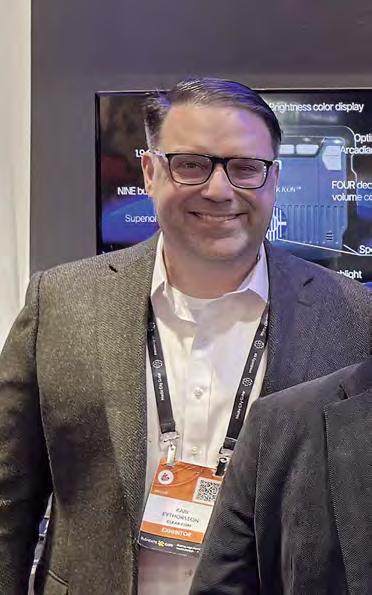


Kari Eythorsson, Clear-Com:
“IBC is still a vital exhibition because it puts existing customers and new projects in the same room. It seems there are now three tiers of attendees: the casual users and operators who want to touch the latest kit but won’t necessarily be making the purchase themselves; decisionmakers scoping real projects; and a growing group looking for where the industry is heading in 3–5 years. Ten years ago, 2110 was the hot topic. Now the talk is software on servers and virtualised tools.”
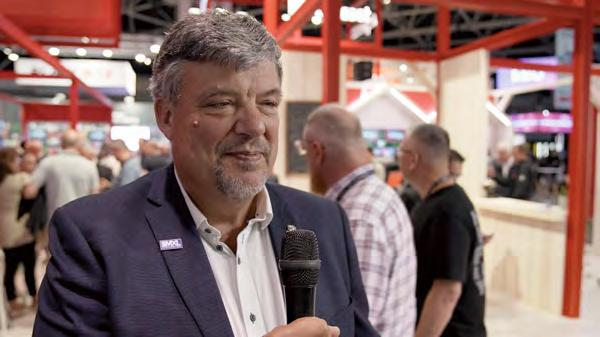
Henry Goodman, Calrec:
“Remote production is the hot topic here now, but it isn’t new for us. We launched the RP1 more than a decade ago. While Covid sped things up, the driver now is competitiveness and efficiency. Legacy kit can’t deliver the agility broadcasters need, whereas IP lets you redeploy people and resources, control surfaces remotely and create more content with the same headcount. Part of the challenge is maintaining tight real-time comms between vision, audio and production when teams are distributed, which is where our Argo, Type R and ImPulse platforms come in.”


professional AV market in recent years, Visionary is making a debut here at IBC to test the water. Apart from traditional broadcasters, we have met many of our distributors from Europe in addition Amsterdam to meet. In contrast, we have met few end enterprise customers such as Netflix provide valuable input
Jan Eveleens, Riedel:
“We’re seeing our own booth traffic grow even if overall IBC attendance looks fairly flat. The customer mix has broadened –streamers now behave like broadcasters and ask different questions because they aren’t tied to legacy processes. There’s been a huge shift from hardware boxes to software systems that interoperate on-prem or in the cloud. Hype cycles come and go – remember 3D and 8K – so we’re cautious about buzzwords. For viewers, HDR delivers a bigger visible step than more pixels, and most consumers are already at ‘good enough’ on resolution. That reality is increasingly shaping what gets prioritised and funded.”

Ade Abt, AJA:
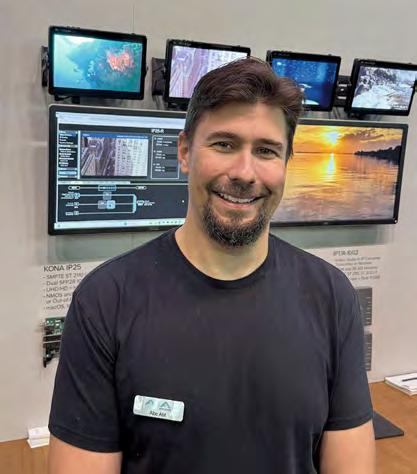
“I’ve watched the show evolve since I first visited IBC in 2013. In previous years, I had more discussions with TV station broadcasters and OB truck guys. Today, I meet an increasing number of OEM developers wanting to know how to integrate our products into their complex workflows. IBC was not an AV show 10 years ago but, with AV and broadcast convergence, AV specifiers are everywhere. ISE is very AV-focused with videowalls, presentation systems and audio networking, and all this technology exists today at IBC because AV has been utilising IP networks such as AES67 and ST 2110 before broadcast.”
Jeff Moore, Ross Video:
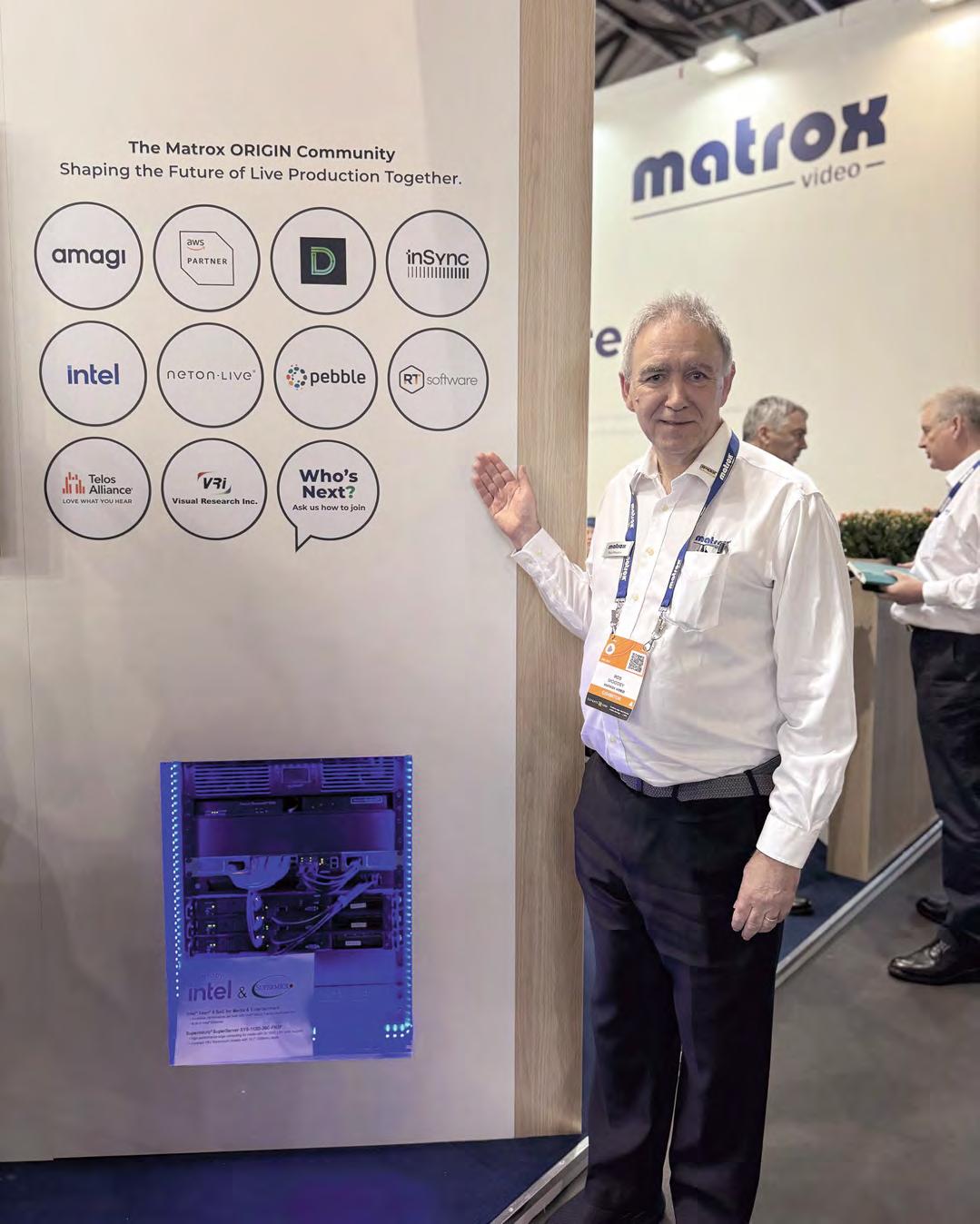
“We are not exhibiting exclusively for broadcasters, because a lot of our business interests are in other market sectors including education, sports and financial institutions. Ten years ago, these visitors were not as evident at IBC.
Although corporate video has been around for a long time, it is more sophisticated today with the rise of event centres, meeting spaces and remote productions. These users want to produce their own content at the highest level but have different requirements to a broadcaster.”

five years are cloud and ST 2110, because they are transformative and will make us work differently. The fear factor of storing video in the cloud or transmitting video anywhere over the network is now over. When I look at the broadcast and AV sectors, fixed installations demand faster frame rates and higher resolutions, so they don’t need cabling. Bandwidth, latency, speed and reliability are the main considerations, but ease of use is also vital.”

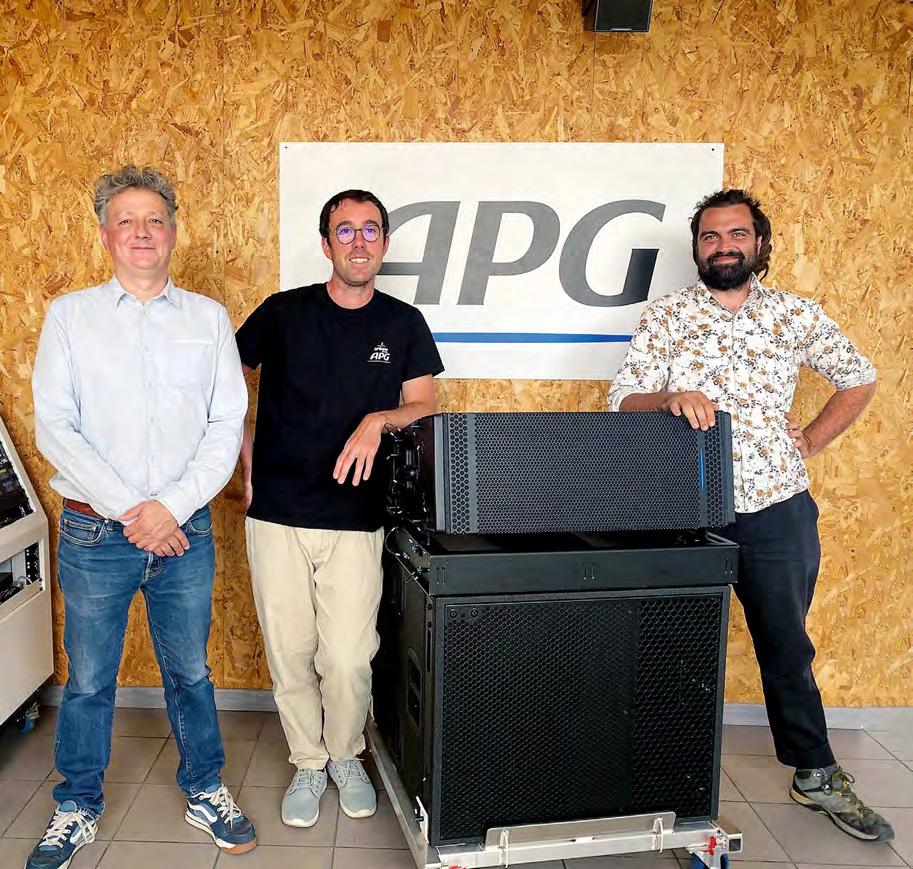

Arbane Groupe’s Mathieu Pobeda details how APG Audio has taken its flagship line array in a new direction
AFTER MORE THAN A DECADE OF FIELD SUCCESS, APG Audio’s original Uniline line array system has earned its place in the rental market. Launched in 2010 as the industry’s first modular solution with mix-and-match flexibility, it appealed to users seeking scalability without investing in separate product families. Five years later, APG launched the Uniline Compact, a small “line source” whose aim was to offer maximum versatility for the widest range usage. But with changing expectations in the live sound industry, APG parent company Arbane Groupe recognised it was time for something new.
The result of a multi-year development process, the new Uniline Max is not an attempt to chase headlines or compete on sheer scale, explains Arbane Groupe technical director Mathieu Pobeda. Instead, it reflects a clear-headed response to changed market needs – a system built for the mid-sized rental firms, production houses and venues that increasingly form APG’s core customer base. These clients prioritise reliability, clarity and ease of use over raw SPL.
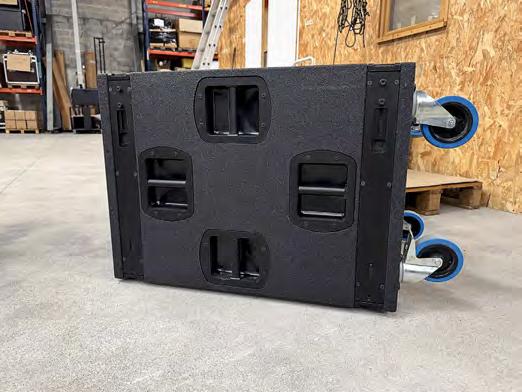
“The reality is that the majority of our industry thrives on more humble events,” explains Pobeda. “Uniline Max is about giving our users a serious performance tool that’s simple, efficient and versatile. The people we’re catering for don’t want complexity, they just want something that works. The goal was to modernise the original solution in all regards –visually, acoustically and operationally.”
Although the original Uniline platform is still highly respected, its angular aesthetic and complex rigging had begun to show their age. “What we wanted was to serve the specific needs of mid-sized rental firms and production houses, clients who want the power and flexibility of a premium system without the infrastructure overhead. Scenographers don’t want visible systems anymore and, as crews have got smaller, everything must to be faster and easier to manage.”
Given Uniline Max came from the need to modernise the look, simplify deployment and better match the expectations of today’s operators, extensive user feedback was vital from the outset.
“We began this simplification by unifying the controller/amplifier platforms to standardise the user experience and promote crossrental within rental inventories,” Pobeda recalls, referencing a visit to a London client that quickly helped solidify his determination.
“She loved the sound of Uniline – the clarity and the dynamic range – but told us it was too difficult to rig with a small team. That was a wake-up call. We heard over and over again that our systems sounded fantastic but were becoming too complicated to deploy.”
One of the first changes, therefore, was to streamline the system architecture. While the original Uniline included four interchangeable modules, Uniline Max simplifies this down to two: a full-range main cabinet and a 21-inch LF extension.
“Modularity sounds good on paper,” adds Pobeda, “but, in practice, too many options mean more rigging, more amp channels and more headaches. For the kind of customers we’re targeting, simplicity ultimately wins. A significant part of that simplification came through user feedback.”
Having two separate rigging systems for different modules also drove up costs and complexity. “In this segment, you’ll find everything from well-equipped companies to tiny outfits with limited gear. We had to design for both. Crews now are smaller and productions leaner, so we needed a system that two people could handle efficiently.”
A complete rethink of the mechanical design was crucial –considering everything from rigging to transport hardware.
“We built the rigging system for Uniline Max as a sort of exoskeleton, separate from the cabinet body,” explains the technical director. “That means that if we ever need to update or replace a mechanical component, it doesn’t affect the acoustic enclosure. It also makes recycling much easier at the end of life, which is of increasing importance for our customers, and a core value for us.”
This focus on sustainability became another guiding principle. Gone is the polyurethane construction material common in previous parts of the system. In its place is high-pressure ABS plastic, produced using precision injection moulding. “It’s better for manufacturing consistency and far more environmentally responsible,” says Pobeda.
Despite the operational emphasis, Uniline Max is no slouch on the technical front. A key innovation lies in its coaxial mid-high arrangement. “We’ve been using coaxial designs since the APG 3000 and 6000 series,” recalls Pobeda. “But for Uniline Max, we completely redesigned the waveguide and phase plug to control path length and directivity even more precisely.”
The result is Pobeda’s self-designed and newly patent-pending SIGMA waveguide, which emits both mid and high frequencies through a single horizontal slit. “That alignment helps maintain consistent directivity and reduces phase issues. It’s a simple but effective concept,” he explains.
“The first thing our test users noticed was how smooth the horizontal dispersion felt, even at longer throws.”
Unlike most competitors who start from theoretical acoustics, Pobeda took a more practical path. “The first constraint for customers is the truck,” he notes. “We started with the physical dimensions – what fits in transport vehicles – and then designed the waveguide around that.”
The result is a gently curving internal geometry with minimal energy loss and clean phase alignment between cabinets. Creating that result required detailed software simulation. “We only needed four waveguide iterations thanks to today’s acoustic prediction tools,” says Pobeda. “But unlike the waveguide, for the rigging system you can’t rely on software. You need to build everything and physically test it. Mechanical ergonomics – how the system feels and handles under load – can’t be accurately simulated. So that’s where most of our prototyping efforts went.”

One other major breakthrough came in the form of a hybrid rigging system that supports both tension and compression.
“This allows us to offset the natural compromise of having the system’s rotational point deeper inside the cabinet, rather than at the front,” he furthers. “Other brands make that compromise too, but our solution lets us retain the horn-loaded sound performance we want without sacrificing usability.”
While many brands chase maximum SPL and throw distance, Uniline Max is instead tuned to real-world priorities. “We want balance, punch, clarity and coverage, but also ease of use, manageable weight and responsible energy use. These are as, if not more, important.” Power distribution is a key example. The system’s amplifier racks were designed around common 32A single-phase connections, avoiding the
the default to suit venues and crews without high-power infrastructure.”
Similar thinking applies to service and logistics. “A lot of our choices were informed by truck dimensions,” he admits. “It sounds unromantic, but if your boxes don’t pack well, everything suffers – storage, transport costs, load times, everything. We started with those constraints and built upwards.”
As technically accomplished as Uniline Max is, Pobeda lights up most when discussing the team behind the product. “While I brought some discipline and experience gained from decades of loudspeaker design when I joined the company five years ago, the whole team has really levelled up,” he says. “We’ve built Uniline Max together, and that team spirit extended to every part of the company – from design and production to supplier coordination and customer service.
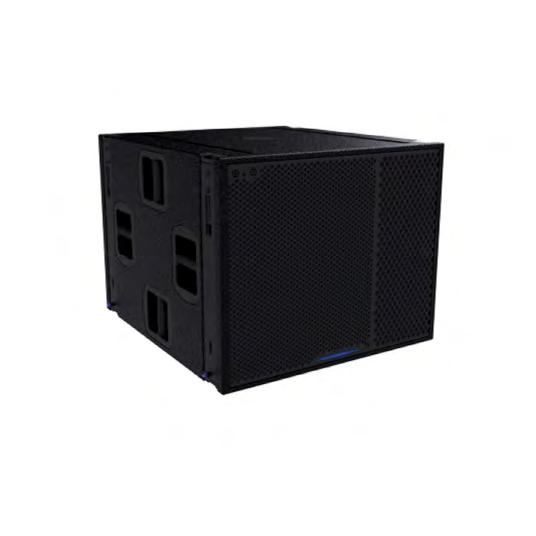
“Our production supervisor told me he was proud to see a product that clearly considered the needs of the people on the factory floor. That kind of feedback is gold. It’s easy to design a great-sounding system. It’s much harder to make one that’s great to build, ship, service and recycle.”
All in all, Uniline Max came together in 18 months, a remarkable achievement given the depth of development. Some technologies, like the amplifier platform, had been prepared years earlier, but development of the system was fast-tracked thanks to Pobeda’s clear vision and close team coordination.
The result is a solution that not only reflects APG’s technical expertise but also its maturity as a company. “It’s not the most powerful system in the world. But it’s honest, effective and built with care,” the technical director concludes. “And I think our users feel that. We maxed out every part of the process.”
www.arbane-groupe.com





Sennheiser CEO Dr Andreas Sennheiser reflects on the company’s 80-year legacy, innovation and its decade-long journey to launch Spectera
IN PURSUIT OF ENGINEERING INNOVATION, FEW pioneers look back. In the latest development for this thirdgeneration business, former joint CEO Daniel Sennheiser has become chairman of the board of directors, while brother Dr Andreas Sennheiser assumes sole responsibility of the CEO position.
One year on from the launch of the Spectera wideband wireless system and Andreas continues to look ahead. However, the brand’s 80th anniversary this year is a useful reference of how far they have come since the brothers assumed joint responsibility for the company in 2014.
“I believe that every great innovation or invention has been created by geniuses who never acknowledged that problems exist, or were unaware of the problems that lie ahead,” begins Andreas. “Ten years after establishing Sennheiser, my grandfather Fritz admitted that he wouldn’t have started the company if he had known how difficult it was at the outset. That statement still rings true, because you’re in a state of bliss when you commence a project. That initial excitement overcomes the difficulties you inevitably encounter.”
Despite all the critical acclaim, awards and sales orders that Spectera is now amassing, the previous 10 years of R&D tested the nerves of the Sennheiser pair. Inheriting a rich legacy of family engineering and international sales success, the brothers would have been forgiven for playing a conservative role and risking little. “Every generation has its challenges to develop a company and take it to the next level and, as a multi-generational company, there is also something to preserve. However, there’s also something to radically renew,” muses Andreas.
The upbringing and long-term values of the brothers are aligned,



look back and see how far you’ve come when you are walking up a hill towards the summit. However, in our pursuit to enable creative freedom in audio and video, Sennheiser has been building the future of audio for eight decades. Our milestones include the first interference tube shotgun microphone for the film industry with the MD 81, which was first shown at a tradeshow in 1954 and was followed by the first wireless microphone for TV use [Labor W] in 1957 and the first audio headphones for music playback in 1968.”
In addition to preserving ageless classics including the MD 441 and MD 42, the brothers are determined to continue innovating to fulfil the next chapter in the company’s evolution. “When we look at the three generations, my grandfather was the founder
the inventor. It was my father Jörg who realised the importance of customer relationships across the globe, and so he founded subsidiaries with a closer network towards end users. Daniel and I are focusing more on the digital enablement of our technology and products. That innovative spirit my grandfather injected into the company has been passed on over the decades and continues to thrive today.”
None of the innovation and growth would have been possible without the secure financial foothold that Fritz built from humble beginnings in a newly emerging post-war West Germany. A combination of Fritz’s hard work and ingenuity and Jörg’s customer-focused drive created the solid basis of the family-owned company. As a result, the focus on creating long-term value with customers superseded the requirement to publish short-term quarterly reports or compromise with banks. Furthermore, the CEO claims that increased creativity has been the result of the mental freedom that their employees have always enjoyed within the selffinanced operation.
The sound finances built by the Sennheiser family continue to gain the respect and trust of their customers, Andreas further explains: “By managing the supply chain and remaining in control of our manufacturing processes, we have always maintained quality and delivery. This is especially relevant during turbulent economic times. For example, when the new trading tariffs were announced, we shipped stored products to the US at the lower

the brothers’ 11-year stewardship. “Sonova Holdings is a very professional partner in the consumer sector and, having delegated that arm of the business to them, Sennheiser has been allowed to focus solely on the professional user and those who make a living from or retain a strong passion in audio. By increasing our investment in R&D, we have paid more attention to the growing Pro Audio, Business Communications and Neumann business units, which are characterised by different customer groups, requirements, product life cycles and market dynamics.”
The acquisition of Klein & Hummel monitors in 2005 served as a prelude to the creation of the Neumann unit. “We started a new chapter for monitors with immersive formats, of course, including Dolby Atmos and Sony 360 in larger installations. In doing so, we demonstrated the power of the Sennheiser brand, because Klein & Hummel was almost unknown before outside German-speaking countries. When a studio features a lineup of Neumann microphones from the U47 to the most recent ones, having monitors of the same brand retaining the same quality makes it a natural fit. Since adding Merging Technologies, we have strengthened our portfolio.”

internally to ensure our products have platforms that can be used more. The three divisions are not isolated because there is a commonality of engineers who work on fundamental technologies such as ST 2110 network technology.”
Following the development of the Neumann KU 100 binaural recording dummy head in Germany and advanced audio algorithms by a dedicated team in California, Sennheiser has pioneered immersive audio since the turn of the Millennium. The pursuit of immersive excellence serves as another example of the company’s lengthy audio passion with little returns. “It was only with the emergence of AR and VR technology that we realised we could incorporate our immersive audio algorithms into 3D computer game goggles,” says Andreas.
The quote “engineers need room for crazy ideas” was once attributed to Fritz. Today, his grandsons try to balance this creative freedom with business sense. Despite committing 8% of the company’s turnover to R&D each year, Andreas admits that risks need to be mitigated: “By starting with a hypothesis and refining it over time, you reach a point where the hypothesis becomes a certainty. We usually run two or three R&D projects of a similar small size concurrently, but not all of these will reach the finishing line. If you look at the failures including wasted time, wasted effort and wasted money, engineers become afraid to take risks. You simply need to know when you have reached a dead end and stop pouring money into something that is not working.”
Ten years in the making, Spectera gained momentum despite the huge resources spent with no return in that time: “Initially, only two people worked on the project for several years. When we became aware of the huge commercial opportunities, we elevated the project to the next stage by increasing our investment in manpower and resources. It is less of a risk to invest when a project appears more likely to succeed. With customers increasingly providing feedback, Spectera is becoming an ever-
With the goal of capturing, processing and playing back audio in the best possible way, Ambeo became the resultant platform, coming to life with the initial development of a VR microphone that remains in production. Commercially, three strands of development resulted including the automobile industry, collaborations with film production companies adopting Dolby Atmos and applications using Neumann mixing and content production.
Just as Sennheiser’s engineers work together across the three divisions, the company was early to collaborate with other brands to enhance the user experience. “To enhance customer values, it’s necessary to strategically collaborate with others including Crestron, Q-SYS, Xilica and Yamaha, for example,” Andreas explains. “Whether it’s a sound engineer operating a mixing console or a meeting rooms systems integrator, our aim is to encourage companies to work closer together for the greater good of the customer. By staying close to our customers and seeing what they need, we aim to provide the tools for them to perform their workflows in a more simplified way.”
In just 11 years, Andreas and Daniel have made their mark on Sennheiser’s history. Bringing unique skillsets to the table, their shared passions, single vision and abundant courage will continue to steer the Sennheiser brand on its upwards trajectory. Sometimes, a glance towards the past can project a path into the future.
www.sennheiser.com
WITH CONTINUED PROGRESS IN VISUAL TECHNOLOGIES, the rental landscape has welcomed entrepreneurs and startups that stay ahead through shrewd investment. From pioneering hourly projection hire in 2007 to the recent award-winning 3D mapping of Jakarta’s National Monument, Argo Visual typifies the trend. A refusal to accept limitations when it comes to visual technologies, coupled with a resilience to survive challenging economic forces, are vital components of the company’s DNA.
Returning from a year in Rome, the 27-year-old Alvin Antono arrived back in Indonesia with a purpose. “One of my friends, Harry Hartono, asked me to work for his subsidiary company, Argo Projector, because they wanted to establish a branch in Surabaya where I was living, but I insisted on doing it in Jakarta,” he explains. “Derived from the word ‘meter’, Argo was initially founded to rent office projectors on an hourly base, with additional tariffs being charged in the same way that fares are.”
Relocating to Jakarta in 2007, Antono established Argo in the Indonesian capital with an emphasis on weddings and parties. With the departure of Hartono in 2010, Antono was free to make decisions, realising that investment in equipment was required to finance growth. A meeting with Christie in 2012 led to the acquisition of Roadster HD20K-J projectors and Argo became the first rental outfit in Indonesia to offer Full HD 3DLP models. The projectors were hardly ever in storage, with the resultant rental profits immediately reinvested in more inventory. At this point, Adrian Goh from Singaporean rental outfit, Hexogon Solution, entered the fray to become a business associate and supporter of the company.
The upward trajectory had peaked, however. Argo suffered manpower failure at a major event, while a sharp decline in the price of LED rentals combined with an increased proportion of the projection business entering the installation sector. “New competition, bad debts and declining business nearly finished Argo in 2016 and 2017,” reflects Antono, who took comfort from the adage that “whatever doesn’t kill you can only make you stronger”.
With the clock ticking down to the 2018 Asian Games in Jakarta and Palembang, Argo was commissioned to create a projection mapping show for the Indonesian National Monument (Monas). In its new iteration as a projection mapping company, Argo was appointed as a partner for the Asian Para Games Opening Ceremony at Jakarta’s Gelora Bung Karno Main Stadium. A wavelike structure measuring 42m x 21m was installed, with visuals output by Christie Roadster HD20K-J projectors connected to Dataton Watchout servers. Inspired by the fledgling company’s first large-scale international event, “Powerful Experience” was adopted as its tagline. Working with an international organiser entailed a steep learning curve, but the Argo team quickly developed a flair for conforming to international standards.
With all major events placed on hold during the pandemic, the rescheduled 2021 Indonesian National Sports Week saw Argo Visual participating in its own production, staging a major international event with added obstacles including a six-hour flight from Jakarta to Papua, and Covid-19 testing and quarantine protocols mandatory for the team. Together with the organiser Royalindo Expoduta and consultant Five Currents, Argo Visual delivered a production incorporating 30 Christie Roadster HD20K-J projectors and Dataton Watchpax 60 media servers. As events started up again, the Indonesian government launched the “Recover Together, Recover Stronger” mission, encouraging those who had grown overly accustomed to staying at home to re-engage with society.
A live show incorporating video mapping to welcome leaders and dignitaries to the gala dinner of the 2022 G20 Bali summit proved to be one of the event’s highlights. Argo Visual built the stage floor around the dining tables, surrounded by a backdrop of six large cliffs. With the entire logistics prepared in just four weeks, the production drew on more than 60 projectors including Christie

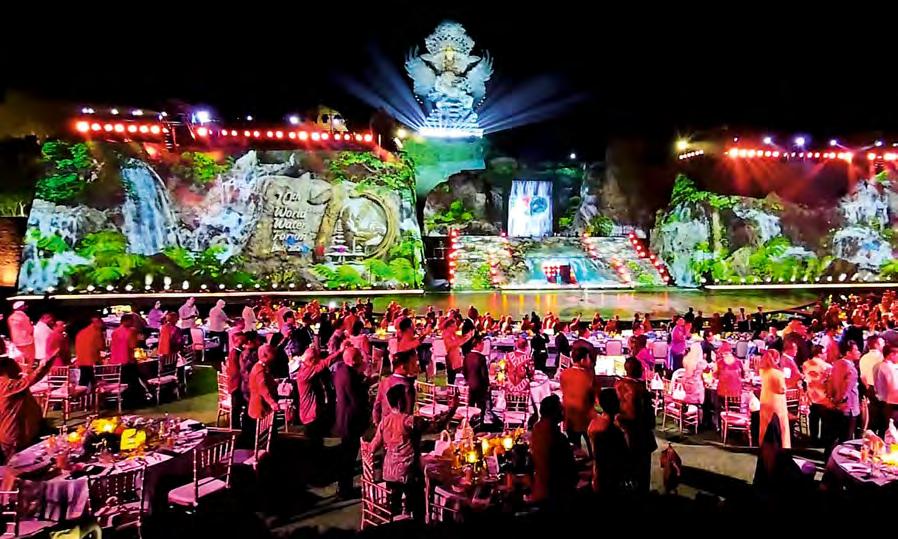
Roadster and Panasonic models together with Disguise VX 4 and 4x4 media servers.
Forming part of the summit – which gave rise to the Argo Visual LED division – the Digital Transformation Expo (DTE) show commissioned Argo Visual to supply 60m2 of AOTO CLDRS1.5 LED walls with Brompton processing, together with 270m2 of INFiLED GX2.5 creative displays and a ball LED, controlled by Dataton Watchpax 60 servers.
As Argo became increasingly involved in the production of largescale international events, some key people joined the company, including Albert Lawrence Lawadi, who initially focused on the growth of Argo Visual and now controls all its LED rental business. System manager Yakobus Joko Susilo, who had left the company in 2012, joined Argo’s projection and projection mapping, media server and image processing business. Meanwhile, Arie
Widyarto Kresno, a veteran of Indonesia’s LED industry, has been strengthening ties with leading LED manufacturers including INFiLED, handling the acquisition of ROE LED screens. Having entertained the G20 leaders, the Indonesian government commissioned the same team to stage the 43rd ASEAN Summit in Jakarta in 2023. Drawing countries beyond the ASEAN region, Plataran Senayan in the heart of the capital’s business district was selected as the venue for the gala dinner. Turning skyscrapers into display surfaces for video mapping, Argo Visual used four large buildings with five façades as a blank canvas on which to project 600m2 of LED displays rotating across 360°. Working to a tight schedule, five Ringlock scaffolding towers were built, and almost 100 projectors and displays set up onsite within a twoweek period. The event required a precisely illuminated 35,000m² surface with high brightness, necessitating the use of Barco
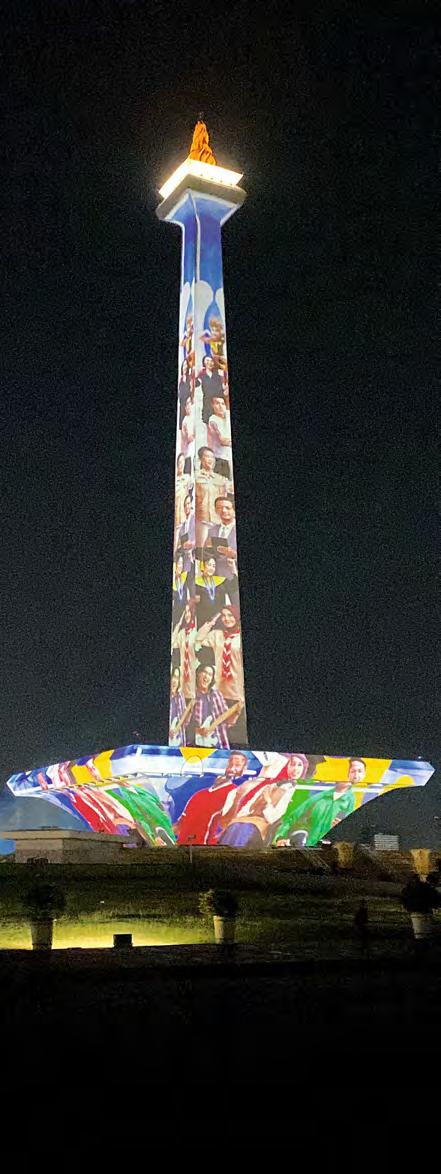
UDX-4K40 projectors, in addition to Argo’s mainstay Panasonic PT-RQ35K, PT-RZ34K and PT-RZ31K models, supported by Disguise 4x4 servers. “The meal, the production and the entertainment were almost beyond anything that Hollywood could pull together,” commented US Vice President Kamala Harris at the time.
Continuing to push creative boundaries, Argo Visual conceptualised a video mapping extravaganza covering all four sides of Jakarta’s Monas monument for Hari Sumpah Pemuda (Youth Pledge Day). Such a feat had never been performed before and many were sceptical it could be delivered. Challenges included a short preparation time, lengthy processing of permits, limited availability of equipment from other vendors and demands that no projection light be directed towards the State Palace.
Panasonic PT-RZ31K and PT-RQ35K projectors output the ambitious display onto Monas to over 100,000 people who eagerly shared their videos and photos on social media, and Argo Visual received the MURI (Indonesian World Record Museum) award for delivering a video mapping show on all four sides of the monument. “We believe that everything we do is based on the sincerity and dedication of every member of the Argo Visual team, and that these two things have brought us to this point,” comments Antono.
Collaborating with Australian vendor, Laser Vision, Argo Visual’s invitation to work with leading advertising company City Vision further elevated its status. For the 2023 New Year’s Eve party, one of Jakarta’s tallest landmarks, Bundaran HI, was the backdrop for a show featuring mist, drones and large-scale video mapping, with some 40 projectors entertaining more than 500,000 people.
Staged at multiple venues across Bali in 2024, the 10th World Water Forum was Argo’s biggest challenge to date. Controlled by Disguise media servers, 77 Barco and Panasonic 3DLP projectors were deployed for the gala dinner at the Garuda Wisnu Kencana Cultural Park. The largest projection mapping event to be staged on the island featured almost 400m2 of INFiLED LEDs at the Bali Nusa Dua Convention Center. Controlled from an Analog Way Aquilon RS4 processor, the welcome party at the Grand Hyatt incorporated 120m2 of INFiLED indoor LED screens, while another site at Taman Jepun utilised 40m2 of AOTO CLDRS1.5 displays with Brompton servers.
“In 2024, we opted to extend our network to Singapore and Melbourne following the success of our show in Bali,” says Antono. There is no immediate plan to establish an office outside Indonesia, but Antono’s ambitions know no borders. “Our vision is to showcase Indonesian talent and to establish ourselves as a preferred rental partner in the global video industry,” he offers. “From Indonesia, Southeast Asia and Australia we will gradually widen our sphere to the rest of Asia, Europe, the Middle East and America. We have always committed to reinvesting in inventory to stay ahead. Projectors and LEDs cannot be considered portable so, by creating international bases with inventory, we will hold a distinct advantage. Today, projection mapping has become a major part of a show, and that demand will remain for some time.”
Continuing to work with existing partners including Barco and Panasonic (projectors) and Disguise and Dataton (media servers) Argo is increasingly using LEDs for its shows. A commitment to INFiLED has grown, while new partnerships have been forged with Analog Way, Brompton and ROE Visual.


Most recently, Argo Visual was commissioned to equip the Indonesian Pavilion at Expo 2025 in Osaka. The initial faith of Argo’s long-term staff has been justified, and profits continue to be reinvested. Along with inventory, Argo Visual’s team also continues to grow and currently includes over 20 technicians trained in projection mapping, LED rental, systems integration and asset management, led by recent recruit, Febry Umargani.
Beginning in 2025, Argo, with the support of Arie Widyarto Kresno, established the Argo Visual Marketing (AVM) distribution division. This focuses on providing the bestquality screens available at different price-points to give smaller rental companies a competitive edge, ranging from INFiLED high-end AP series through to Unilumin’s more budget-friendly UGM options. AVM also represents NovaStar’s COEX control system processors.
“Argo Visual’s mission for each show is to produce the most powerful experience for the audience, and to leave them with an enduring memory of that experience,” says Antono. Almost 20 years on, the original company tagline of “Powerful Experience” remains valid.
www.argovisual.id








WEIGHING ONLY 23kg when housed in a custom Peli case, DiGiCo’s newest and smallest desk brings Quantum features and performance to any venue. Joining the manufacturer’s flagship Quantum852 large-format desk, the Quantum112 is a single-screen, 12-fader desk that is DiGiCo’s first true flypack mixer. Designed to fit within a rugged and robust Peli Air 1637 case, the console, when packed, qualifyies as a standard checked bag option on most flights. But despite its ultra-compact form factor, the Quantum112 is still every bit a Quantum in terms of its pedigree.
Based on the latest seventh-generation FPGAs, the desk offers 80 input channels with 24 aux/subgroup busses, L-R/L-C-R master busses and a 12x8 matrix, all with full channel processing. Twelve control groups plus two solos are also available.

connections (16 analogue inputs and eight
“Our new Quantum112 is a brilliant illustration of the idiom, ‘Good things come in small packages,’” said DiGiCo managing director, Austin Freshwater. “We originally tasked our R&D team to create a rackmountable Quantum console to replace the SD11, which is now 14 years old, and they absolutely outdid themselves. Not only is rackable, but it’s also small and light enough when cased to be under the magic size and weight numbers when
Sporting a 17-inch, 1,000-nit, high-brightness multitouch screen with both a meterbridge and soft quick select buttons for speedy and intuitive operation, the Quantum112 is additionally equipped with 18 individual TFT channel displays to provide clear user feedback and interaction. Beneath the main display are a dozen newly sourced 100mm touch-sensitive faders, selected for their smooth movement and precise control.
The desk incorporates all the usual Quantum features such as Mustard Processing channel strips (20), Spice Rack plugin-style native FPGA processing options (six) and Nodal Processing (24). Twelve graphic EQs are further available, as are eight FX Rack slots.
Other highlights include Stadius 32-bit ADC and DAC conversion, dual DMI slots and a host of versatile I/O options, including Dante (64 channels in and 64 channels out at both 48kHz and 96kHz), MADI (redundant or single), optional optics, AES and local
“The initial brief really challenged our team, driving us to research new materials, optimise design techniques and inversely shrink topologies while increasing performance,” confirmed DiGiCo head of research and development, Michael Aitchison. “Our previously smallest console, the SD11, weighs 24kg without packaging, and 73kg when flight-cased, so it wasn’t a proper flypack product. The new Quantum112 is nearly 70% lighter, but still incredibly solid and far more powerful. We’re extremely proud with how it has turned out and suspect that our customers will be quite pleased with it, too.”
www.digico.biz

CALREC HAS expanded its family of Argo M control surfaces with the addition of a 48-fader console. Completing the Argo M range and the Argo family, the new console enables broadcasters to utilise the extra fader count while still embracing its space-saving design.
The Argo M delivers all the familiarity of Calrec’s flagship Argo platform in a streamlined 24-, 36- and new 48-fader footprint. They have been designed to maximise desk space with fullsized fader strips and intuitive controls built for the most demanding productions. With plug-andplay ST 2110 and cloud connectivity, the Argo M is said to give immediate high-performance control, so broadcasters can focus on creating outstanding content at scale.
With up to 356 channels of internal DSP, the Argo M features built-in analogue and digital audio I/O and GPIO, three modular I/O expansion slots and a MADI I/O port via SFP. The ability to connect to an ST 2110 networked environment and to an existing Calrec ImPulse core alongside other Argo surfaces means it can quickly create multi-console IP environments, while connectivity to ImPulse, ImPulse1 and ImPulseV means additional external DSP paths can be easily added as production demands change.
With seamless ST 2110 integration, touchscreens that can switch between metering, and intuitive UI control and support for immersive formats up to 7.1.4, the Argo M provides a compact and portable IP mixing solution designed to meet the full spectrum of live broadcast production demands.
Meanwhile, the manufacturer’s 48-fader Argo S console is sporting a new software update.
V1.4 introduces enhanced routing strip functionality that enables users to view every fader’s routing simultaneously on the touchscreen and switch rows of physical controls to other strip modes such as EQ, Dyn or Pan. It also enables the Argo Q to support two sets of custom wild panels per section.
A new Tiles feature allows fully customisable up-stand meter layouts with thumbnails, while the mix-minus workflow has been streamlined, enabling any bus to feed a channel’s mix-minus output rather than just the auto-minus. It also adds the ability to select a different output when fader closed to when it’s open and allows users to “interrogate” the console to access routing information of busses being used for a path’s main output. Additional updates
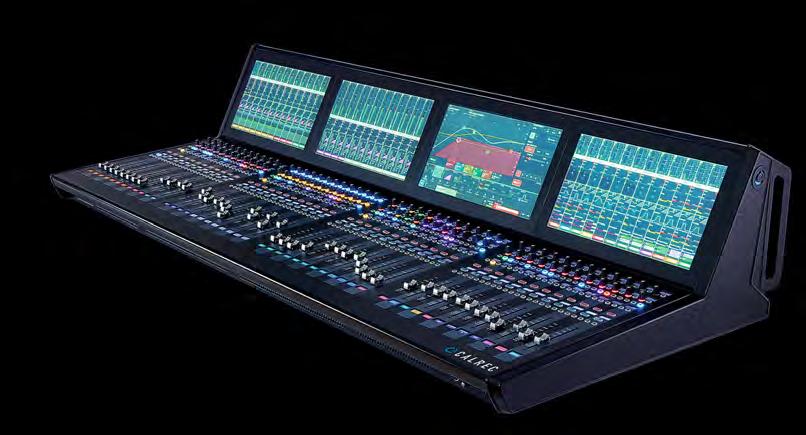
include DAW control of MIDI on the Argo platform, improved NMOS control, enhanced status updates and monitoring, and seamless integration with Calrec Connect.
Finally, Calrec has also added Apollo+ and Artemis+ to the True Control ecosystem, while
COMPLETELY REDEVELOPED from the ground up and based on latest technologies, On Air from Stagetec is a modular console solution designed specifically for the needs of modern production environments – from radio stations and theatres to AV and broadcast applications. The console provides a compact design with flexible control options either via onboard hardware and touchscreen controls or via a browser-based interface for remote-control operation. With native IP integration, PoE operation and seamless setup and workflow, On Air is suitable for spaceconstrained installations, self-operated setups and centralised control rooms. Whether in studios, OB vans or decentralised production environments, the console is said to bring

AIMING TO strengthen integration with broadcast networks, Audinate has expanded Dante support to enable ST 2110 and AES67 configuration directly in Dante Controller. It has also added 96kHz sample rate support and broader ST 2110 network compatibility. Audinate says the enhancements strengthen Dante’s role in bridging audio and video workflows across modern broadcast networks and give broadcast teams more flexibility in how they manage ST 2110-30 and AES67 audio flows. Core configuration tasks such as defining flow parameters and adjusting PTPv2 clock settings can now be completed directly in Dante Controller without the need for Dante Domain Manager. Meanwhile, more complex systems can continue using Dante Domain Manager to automate configuration, apply global policies and coordinate settings across subnets, while also taking advantage of expanded device-level control. Dante now
also supports ST 2110-30 AX, BX and CX conformance levels, ensuring interoperability with systems and equipment operating at higher sample rates.
In addition, features such as the ability to assign flows within a broader multicast address range, define custom RTP payload IDs and specify PTPv2 clock DSCP values are all designed to improve compatibility with third-party devices, support a wider variety of network designs and provide long-term flexibility as systems scale and evolve. Meanwhile, Dark Mode generates email notifications when devices go offline and provides advanced log filtering to quickly identify issues, device importance ranking within sites, signal presence indicators for transmit and receive channels, and detailed latency charts for the previous 30 days. Finally, the manufacturer has also announced that AI-Media and SyncWords have joined
Type R has been updated with off-air record, enhanced GPIO talkback, monitor selector follow, mix-minus bus user labels and a large DSP pack with 32 aux busses.
www.calrec.com
that are said to bring Stagetec’s proven system expertise from the audio world into the video domain – IP-based, flexible and fully integrable into existing workflows. The first products in the new range include a software based Multiviewer, Format Converter and IP Gateway: all components are CPU/GPU-based and controlled via a central, browser-based Stagenet interface for seamless operation. Instead of fragmented standalone solutions, Stagetec has created a consistent platform that unites audio and video, with the aim of making professional video technology easier and more efficient than ever, whether in theatres, broadcast studios or AV setups.
www.stagetec.com


AMC BALTIC has introduced the DCA series of “modern-looking”, compact Class-D power amplifiers, available in 200W (DCA 200) and 400W (DCA 400)
amplifiers offer simple switch controls for input sensitivity, ground lift and low-cut filter, and they also have over-current and over-temperature protection including audio

power variations. Suitable for live music, background music and conference sound systems, the models have been designed as a replacement for AMC endof-line A series (A 100 and A 200) power amplifiers.
The new versions feature two outputs that can be configured in parallel, stereo or bridge modes, and are capable of driving both 4Ω and 8Ω speakers. The DCA
limiter and variable speed cooling fans. The amplifiers have been designed with Phoenix input and output connectors for fast and more cost-effective installation. Both units have a 20Hz–20kHz frequency response, a total harmonic distortions (THD) of 0.1% and a signal-to-noise ratio of >100dB.
www.amcpro.eu

EXTRON HAS expanded its family of 8K solutions with the release of two HDMI distribution amplifiers that add audio de-embedding and embedding functionality.
The DA2 HD 8K AE extracts 2-channel LPCM audio from an 8K HDMI input and converts it to analogue, while the DA2 HD 8K AI accepts analogue stereo input and embeds it onto the HDMI output as 16-bit LPCM audio at 48kHz. Both units provide two HDMI outputs and are designed to simplify integration in environments where audio processing is required alongside 8K video distribution.
The HDCP 2.3-compliant devices incorporate Extron’s EDID Minder Plus technology, which supports extended memory blocks for displays using EDID and DisplayID. This enables reliable management of advanced formats, including
5K and 21:9 aspect ratio content. Additional features include HDMI 2.1 data rates up to 40.1Gbps, HDR, Deep Color up to 12-bit, 3D, HD lossless audio, input cable equalisation, output muting and continuous HDCP verification via Key Minder. The AI model also offers audio gain and attenuation adjustment and provides +5 VDC, 250mA power on each output for external peripherals.
Engineered for commercial AV applications, from presentation venues to esports arenas, the DA2 HD 8K AE and DA2 HD 8K AI aim to provide integrators with reliable, high-performance options for processing and distributing highdata-rate HDMI signals to both standard and ultra-wide displays.
www.extron.com
SOUND CONTROL Technologies (SCT) has released its USB-AMV adapter, a compact signal converter that merges HDMI video and USB into a single USB-C connection with DisplayPort Alt Mode and audio support. With the rise of USB-C and DP Alt Mode in devices such as Cisco’s Codec EQ and Room Bar Pro, Neat’s Bar Gen 2 and Logitech’s MeetUp 2, AV and IT teams are looking for a way to connect legacy two-cable HDMI/USB systems to these
new single-port, USB-C devices. Most extension kits and tabletop interfaces weren’t designed with DP Alt Mode in mind, leading to compromises in performance or functionality.
While most modern laptops already support DP Alt Mode over USB-C, AV endpoints have lagged behind due to high development costs and limited compatibility. SCT’s USB-AMV helps close that gap, by providing a clean, reliable way to interface with these devices using existing HDMI and USB
sources, ideal for BYOD and BYOM environments. The adapter merges HDMI and USB into one uncompressed USB-C DP Alt Mode output and supports full-bandwidth AV signal transfer with uncompressed video and audio. It has a compact, plug-and-play design and is compatible with a wide range of DP Alt Mode-capable codecs and video bars.
www.soundcontrol.net

LISTEN TECHNOLOGIES has announced the release of a major update to its wireless audio platform, ListenWIFI, with version 3.2. Introducing enhanced performance, expanded network compatibility and key usability improvements, the update is said to be the most substantial enhancement to the ecosystem since its launch and is aimed at supporting more robust deployment in demanding environments such as houses of worship, conference venues and enterprise facilities.
Among the headline improvements is increased support for complex IT infrastructures. Version 3.2 now ensures seamless streaming across firewalls and Network Address
Translators (NAT), enhancing the platform’s flexibility in secure and restricted networks. Security has also been bolstered with critical patches, including protection against the high-profile RegreSSHion (CVE-2024-6387) vulnerability affecting OpenSSH servers. Delivering tangible improvements for both integrators and end users, the ListenWIFI mobile apps now feature more transparent permission requests in line with Android and iOS standards, while a new QR code zoom function improves channel access from a distance. The Wi-Fi Audio Receiver has also received a notable upgrade with the addition of a dedicated language button, simplifying multilingual navigation in live settings.
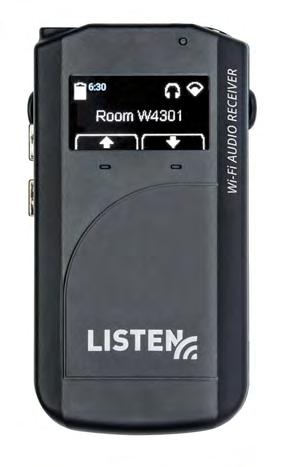
To further assist integration partners, Listen Technologies has introduced mobile app SDKs that allow developers to embed ListenWIFI capabilities into custom applications. The ListenWIFI Manager Software has also been refined, offering a more efficient firmware update process and smoother overall system operation.
Customers are encouraged to update all system components – including server, receiver, manager software and mobile apps – to the latest versions in order to benefit from the full suite of 3.2 enhancements.
www.listentech.com
REDUCING CLUTTER and speeding up installation, Just Add Power has introduced the MC-TX1-RACK, a rackmount unit that combines three MaxColor encoders in a single 3U chassis to streamline AV-over-IP deployments. Supporting 4K60 4:4:4 and all audio formats, the MC-TX1-RACK adds an Audio Return Channel (ARC) for 2-way audio integration.
Front-facing ports and Power over Ethernet (PoE) simplify access and remove the need for separate power supplies. By centralising three encoders in one chassis, the unit reduces potential points
of failure and makes troubleshooting easier, improving reliability in both compact and largescale systems. Built on the MC-TX1 MaxColor encoder, it is the first in the lineup to integrate three encoders without sacrificing performance. The MC-TX1-RACK sits within the MaxColor ecosystem and is designed to be paired with Just Add Power decoders.
www.justaddpower.com
THE DARK8MAI line from Glensound has gained two additions: the Dark2MAI with two inputs and the Dark4MAI with four. Designed to be used as throwdown interfaces wherever microphones or line inputs are required, the units follow the rest of the line in having dual redundant internet connections, over fibre or copper. The boxes can be locally powered, but many applications will use PoE (Power over Ethernet). This is sufficient to provide 48V phantom powering for condenser microphones. The 2- and 4-input boxes use the same circuitry as the rest of the range, providing high-quality, low-noise,
high-dynamic-range capture, suitable for any application from interviews to orchestral music. Meanwhile, the Dark22M is a compact 2-in/ 2-out device. With the same audio quality, network flexibility and power agility as the rest of the range, this adds return or confidence feeds, and the ability to mix and gain control on the device to tune performance to the situation. Like all Dark devices, it can be controlled over the network using the GlenController Windows app, or by any suitable device controller using UDP.

www.glensound.com


DESIGNED TO bridge the gap between podcast and broadcast, DHD Audio has released its latest version of the RM1 all-in-one portable audio production and broadcast system. Incorporating features of the original model plus additional tools and options that enable deep integration with studio-based DHD systems, the latest RM1 Pro focuses on added capabilities for remote production, including tighter connectivity at a host broadcasting centre.
Targeted at applications including remote or onsite broadcast contribution, live news production, web radio and podcasting, the RM1 Pro can operate as a voice booth, a workstation or from a flightcase. Housed in a 210mm x 185mm x 44mm (WxDxH) desktop unit, the 1kg RM1 Pro’s compact design promotes its use in restricted spaces. With connection to either a wall outlet or USB-C linked power source, the production system allows core control networking when exchanging logic commands with other DHD devices for talkback or on-air signalling. With access to individual DHD Toolbox configurations, an RM1 Pro user interface can be tailored to any workflow. Behaving like a standard DHD Series 52 core device ensures that additional software and features can be licensed when required. Additional features include AD/DA interfacing, audio preamps, 48V phantom power for condenser microphones, audio mixing, EQ and signal dynamics processing. AutoMix mode
automatically balances incoming audio channels, conforming background audio to a preset level. Avoiding echo and feedback, there are n-1 mixminus clean feeds on all the return channels when connecting external guests. Allowing operation from a PC, tablet or a smartphone, or from a Streamdeck via the API, the control screen can be supplemented by a browser-based interface.
Bringing a level of accessible control to its digital audio mixing and production systems, the Routing Web App is designed for use with its standard XC3, high-capacity XD3 and XS3 DHD IP cores, and all DHD mixers able to run version 10.4 firmware. DHD says the Routing Web App makes the process of assigning and managing incoming sources and output ports fully transparent and easy to view and control.
An HTML5-based web application, the app runs directly on the web server integrated within the processing core. It can be accessed by an authorised operator or technician using any modern browser, and allows the core’s entire I/O channel configuration to be controlled locally or remotely. Individual crosspoint matrices can be created and displayed graphically or as an I/O list, and matrices are storable as presets. The Routing Web App expands the range of DHD Web Apps to six, joining the Assist App, Labels App, Snapshot App, System App and Views App.
www.dhd-audio.com
DESIGNED TO cut programming time and free production teams to focus on creativity, a significant upgrade has been released by Disguise to its AI-powered workflow assistant for Designer Pro, Ask AId3n. Now powered by Google’s Gemini 2.5 Pro, the updated Ask AId3n can execute complex instructions via a chatbased interface, from configuring LED screens for a specific venue to sequencing an entire show timeline. The assistant can also build reusable custom tools from user commands, stored in the Disguise Cloud for use across future projects. The platform is aimed at easing the setup of concerts, theatre productions, corporate events and virtual productions. Tasks such as creating layers and keyframes for each beat of a music track or preparing awards ceremony video sequences with section breaks for multiple categories can now reportedly be completed in seconds. Users can review and edit the generated Python code or instruct the AI to “fix it” when adjustments are needed. Ask AId3n is available now as a plugin for all Designer Pro users via the Plugin Gallery in the Disguise User Guide. Claiming a 175% increase in generative graphics power, the GX 3+ is Disguise’s most powerful media server. Built on NVIDIA’s Blackwell GPU architecture, the latest addition to the company’s
GX range includes a two-year Notch playback licence to unlock the full capabilities of Notch 1.0 for generative content playback, from advanced ray tracing and real-time global illumination to complex geometry, physics simulations and multimachine rendering. Showcasing the latest Notch capabilities, the GX 3+ comes with a selection of ready-to-use Notch Blocks created by Disguise’s Creative Services team.
The GX 3+ can reportedly handle 40% more video layers when compared to the GX 3, which Disguise says allows for the creation of more complex video compositions in real time. Featuring 96GB of VRAM, the GX 3+ eliminates previous memory bottlenecks and helps bring Notch 1.0’s deterministic, sparse grid solvers to even bigger canvases. To achieve lower video output latency, users can run their content engine of choice locally on GX 3+ with Disguise’s RenderStream Local infrastructure; this is critical for live IMAG, AR overlays in broadcast or interactive effects in immersive installations where precise timing impacts audience experience. The GX 3+ also supports ST 2110 video output via IP VFC, as well as ST 2110 video capture, enabling seamless integration into IP-based production environments.
www.disguise.one
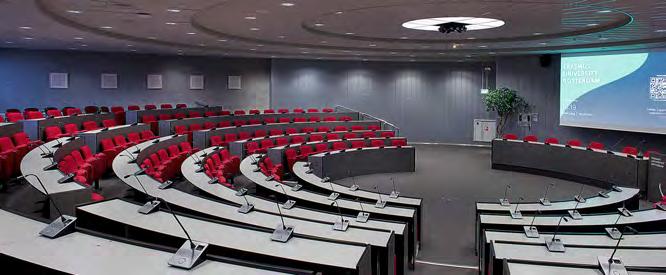
WITH A collaboration that combines bestin-class hardware and software together to bring customisable control and flexibility to its popular conferencing solution, MVI Audiovisual’s EasyConf software ecosystem now supports Audio-Technica’s ATUC-50 Digital Discussion System. Audio-Technica’s ATUC-50 and ATUC-IR are designed for plug-and-play functionality with a choice of wired or infrared wireless systems, or a combination of the two. All options provide 24-bit/48kHz uncompressed digital audio and can be combined to provide for a maximum of 500 participants.
MVI AudioVisual’s EasyConf software offers a customisable control interface for the ATUC-50 with features for agenda, speech time and voting control and participant identification. The
integration gives EasyConf knowledge of delegate seating position, vote casting and microphone operation, and all conference system features can be controlled from the same customisable interface. Meanwhile, EasyConf Connect extends the possibilities of the ATUC-50 by allowing delegates to join a meeting with their own device, turning an iPad or laptop into a virtual conference device that can be used to join remotely. The Netherlands-based developer’s software suite also incorporates EasyCam software, designed for flexible livestreaming and meeting recording and boasting fully automated camera control system to show all active speakers.
www.audio-technica.com
www.mvi-audiovisual.com
What’s next, right here and now.

This isn’t the show for slow. It’s for adopters ahead of the curve. The tools of tomorrow are here. We just need the people who can unlock their potential. Calling all who seek to push the boundaries of possibility–are you ready to test it for yourself? The next Innovation is here and now.
GET YOUR FREE TICKET
Register with code: proavlasia at iseurope.org ISE 2026 Fira de Barcelona I Gran Via I 3 - 6 February 2026
RTS INTERCOMS has announced the launch of RVOC (RTS Voice Over Cloud), a cloud-based intercom solution aimed at revolutionising communication in mission-critical industries, including broadcasting, live events, corporate enterprise and healthcare. RVOC combines scalability, mobility and security without the constraints of traditional intercom systems. Built on Amazon Web Services (AWS), RVOC operates as an Infrastructure as a Service (IaaS), allowing organisations to deploy and scale effortlessly in their own AWS environment using Infrastructure as Code (IaC) through AWS CloudFormation templates. Supporting up to 2,400 non-blocking ports, RVOC integrates with RTS hardware like ODIN, KP series
DESIGNED TO transport one or two contact closures independently or over a standard Ethernet network, Studio Technologies has created two interoperable interfaces. Housed in lightweight, aluminium, tabletop enclosures,
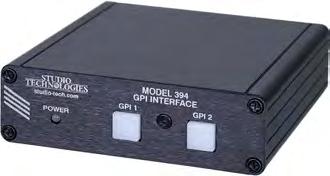
the Model 394 GPI and 395 GPO Interfaces support two general-purpose inputs (GPI) and two general-purpose outputs (GPO) respectively. Providing both data and PoE, each model incorporates a 100BASE-TX (100Mb/s) Ethernet interface and utilises Dante media networking technology for configuration using the STcontroller application.
www.studio-tech.com
keypanels and RVON networks. WebRTC-based connectivity enables low-latency, cross-platform communication, while advanced encryption and authentication ensure security. The RVOC Edge mobile app functions as a virtual keypanel, allowing seamless collaboration from anywhere. With cloud-based controls, REST API support and automated deployment, RVOC is described as a future-ready intercom solution. Meanwhile, the manufacturer has unveiled its HRF Series headsets. Designed for seamless communication in fast-paced, high-pressure environments, the headsets come with the new Flip-To-Mute feature, making muting as easy as flipping the boom up. Re-engaging is just as simple – flip it back down and you’re live again.

In high-pressure production environments –especially sports – there’s no time to fumble with mic controls. Based on the proven HR-1 and HR-2 designs, the HRF-1 (single-ear) and HRF-2 (dual-ear) have been designed for fast-paced production crews where seconds count and silence matters.
Finally, the NOMAD wireless intercom has also been launched. It comes with full-duplex audio,
BASED ON RTW’s TouchMonitor TM7/TM9 technology, the TMxCore metering platform supports evolving workflows in broadcast, postproduction and immersive audio.
Unlike traditional integrated meters with built-in screens, TMxCore is a standalone box that can connect to any external display via DisplayPort or over a local network in any network browser. This gives users complete freedom to choose screen size, resolution and placement, whether integrated into a broadcast console or connected to large wall displays.
Features include RTW’s latest broadcast and pro audio metering platform, a set of AI-assisted tools for advanced speech intelligibility analysis and a fully compliant suite of loudness and metering instruments. Supporting stereo, surround and immersive formats including 5.1, 7.1.4, 9.1.6 and 22.2, the TMxCore platform is network-ready with RAVENNA, AES67, ST 2110 and Dante options in addition to traditional AES and analogue I/O options. To date, Calrec has become the first OEM partner to integrate TMxCore into its Argo audio mixing console. By embedding TMxCore directly into the control surface, Calrec provides its users with RTW’s advanced loudness and metering
seamless multi-site roaming and a durable design. With IP65-rated hardware, redundant fibre and copper connectivity, and glitch-free ST 2022-7 support, NOMAD provides “a future-ready solution for real-time coordination”. It offers wireless freedom with licence-free DECT-based connectivity for extended range and security; scalability that supports up to 120 access points per system; an integrated AEC speakerphone and enhanced sound processing; continuous operation with simultaneous charging and an 18-plus hour battery life; and seamless integration with RTS Digital Matrix via OMNEO, Dante and AES67.
www.rtsintercoms.com

technology as a seamless part of the workflow.
Specifically designed for RTW’s TouchMonitor 5 and TouchControl 5 platforms, a Network Display feature now allows users to display metering or monitoring in a standard web browser, independent of
DESCRIBED AS the company’s lightest and flattest wireless intercom beltpack to date, the Bolero Mini from Riedel Communications has been designed to deliver “maximum mobility with minimal footprint”. It combines Bolero’s wireless performance and audio clarity with a discreet form factor that weighs less than a smartphone, making it suitable for stage talent, rigging crews and anyone who is looking for freedom of movement.
The beltpack is powered by the manufacturer’s ADR technology which provides reliability in challenging RF environments and optimal performance in high-pressure, visibility sensitive settings like theatres, live music venues and broadcast facilities. In addition, it incorporates advanced 5G filter technology for greater resilience in today’s crowded spectrum,

mitigating interference from high-output 5G cell towers.
At just 165g and 28mm thin, the Bolero Mini can be clipped to a costume, worn under a jacket or strapped to a harness. Its low-profile silhouette and black-grey housing help it stay out of sight and out of the way.
Despite its compact size, the Bolero Mini can be deployed in all three network modes for maximum versatility. In Bolero Integrated mode, it operates seamlessly within Artist intercom environments, unlocking the flexible routing, intelligent redundancy and extensive I/O connectivity that power some of the world’s largest productions. This mode supports networks with up to 250 beltpacks, accommodating up to 10 beltpacks per antenna through intelligent bandwidth management.
Bolero Standalone Link offers plug-and-play
the device’s onscreen content. Effectively adding the functionality of an entirely new product without additional hardware, Network Display depicts real-time audio measurements remotely within the local network.
www.rtw.com

simplicity, ideal for smaller productions, temporary projects or when Bolero needs to connect to other systems without an Artist matrix. For standards-based IP workflows, Bolero Standalone 2110 (AES67) allows users to build an SMPTE ST 2110/AES67 network with no Artist required. Connecting to standard Bolero IP-networked antennas, the Bolero Mini integrates effortlessly into any Bolero wireless system and is available in both 1.9GHz DECT and 2.4GHz versions.
This streamlined Bolero features four programmable buttons, dedicated volume controls and a small push-pull connector. It also includes Bluetooth for headset or smartphone connectivity, as well as intuitive Touch&Go NFC registration.
www.riedel.net
VINTAGE AUDIO specialist Warm Audio has expanded access to its WA-47 and WA-87 R2 studio microphones with the introduction of the WA-47jr Studio Essential, WA-87jr and WA-87jr Studio Essential models. Each is built around the same professional capsules as their flagship studio counterparts and engineered to recreate the sound profiles of the classic ‘47 and ‘87-style studio microphones.

Both the existing WA-47jr and the WA-47jr Studio Essential are modelled after the flagship WA-47 tube mic and Warm Audio says they offer the same sonic character in a modern, transformerless format. At the heart of each mic is Warm Audio’s vintage-accurate K47-style capsule. The WA-47jr features a dualbackplate K47-style capsule and offers modern flexibility with three selectable polar patterns (cardioid, omni, figure-8), a –10dB pad for capturing loud sources and a 70Hz high-pass filter for reducing unwanted low-frequency noise. Meanwhile, the WA-47jr Studio Essential retains the same core tonal profile with a singlebackplate version of the K47-style capsule in a fixed-cardioid design.
Similarly, the WA-87jr and the WA-87jr Studio Essential recreate the tone of the ‘87-style studio microphone. The WA-87jr features a dual-backplate K87style capsule and, like the WA-47jr, it boasts the same three selectable polar patterns, a –10dB pad and a 70Hz highpass filter. The WA-87jr Studio Essential again simplifies the design with a singlebackplate version of the same K87-style capsule and the same ultra-low self-noise, wide dynamic range and fully discrete signal path of the jr.
DESIGNED FOR precise, experiential audio capture in sports, studio and live event production, Shure has unveiled the DCA901 planar array microphone. With digitally steerable lobes and onboard DSP, engineers can isolate sources, reduce ambient noise and maintain total control over the mix.
As the first product in Shure’s new Arqos portfolio, the low-profile, all-black DCA901 replaces traditional workflows and complex setups with a streamlined, high-fidelity solution. The manufacturer claims that advances in immersive experiences and multichannel audio mean that previously elusive elements including talent dialogue and on-set or onfield movements can now be captured.
Minimising crowd noise and bleed, the digitally steerable lobes isolate voices and action. Providing wider coverage than analogue sources, the CA901 delivers up to eight isolated channels of high-fidelity audio and can simultaneously capture 5.1 and stereo conversion. A set of real-time digital tools –including integrated DSP with automixing, EQ, compression and delay – can instantly deliver consistent audio with minimal post-processing. Reducing complexity and onsite setup time, the DCA901’s digitally steerable lobes can replace multiple shotgun or parabolic mics. Combining audio, power and control into one source, a single-cable Dante or AES67 connection simplifies routing and reduces cable infrastructure. Remote control
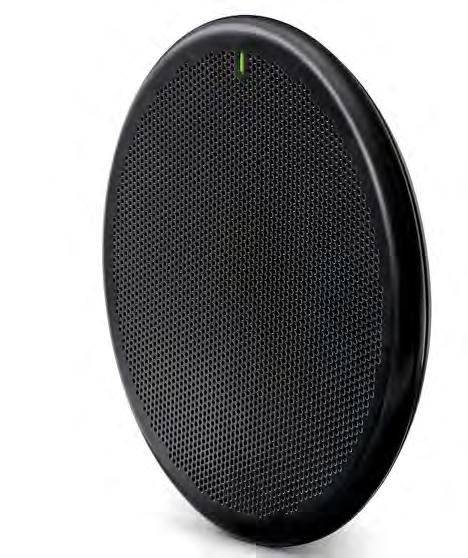
capabilities allow the adjustment of pickup zones without onsite intervention, while also supporting REMI workflows and alternate feeds with flexible routing.
A collaboration between Shure and EDGE Sound Research in live football broadcasting follows the movement of players, referees or the ball, individually or in combination, in real
BUILDING ON the success of the Sennheiser Room Planner, the manufacturer has released a free online tool for simple configuration of its wireless microphone solutions. Named Wireless Planner, the tool reportedly offers customers switching to a new SpeechLine Digital Wireless or EW-DX microphone system a quick and easy way to decide on the right Sennheiser solution and how best to configure it when designing for education, corporate or live environments. The system has been designed to help customers who are facing tight timelines to quickly complete a Sennheiser wireless microphone setup. The step-by-step, webbased interface allows users to select channel count, receivers, transmitters, batteries, chargers and antennas to meet their specific project requirements.
time. Pairing the DCA901 with Virtual Sound Engine software is revealing moments once buried in the mix.
The manufacturer has also announced that its ShurePlus Channels is now Wireless Workbench Mobile, a next-generation tool for audio professionals seeking seamless management of Shure wireless systems while on the move. The app, available for free on Android and iOS, delivers new tools, including guided alerts and mobile frequency coordination. Wireless Workbench Mobile’s frequency coordination capabilities are currently reserved for iOS and will be available for Android phones in 2026. Designed for speed and precision, Wireless Workbench Mobile delivers wireless control away from the rack or laptop, enhancing productivity and facilitating fast decisionmaking to keep users one step ahead. Customers can assign clean frequencies using built-in coordination tools for reliable setup. The platform provides flexible access via iOS mobile devices for real-time control and connectivity, helping engineers stay ahead of any issues. Users can organise their workspace with tags, colours and favourites, set custom alerts and receive guided steps to resolve issues before they impact the production. The layout highlights critical channel data with new search components, side-panel alerts and clearer labelling for faster navigation and easier scanning.
www.shure.com

After completing a setup using Wireless Planner, users will receive a full summary of their design, including a system overview, itemised Bill of Materials, product names, spec sheets and article numbers. To ensure that every
project detail meets the user’s specifications, additional support from Sennheiser’s technical and sales teams is also available as needed.
www.sennheiser.com
FOCUSRITE HAS announced full Windows on Arm compatibility for all generations of its USB audio interfaces. Native Arm64 drivers are available to download from the Focusrite website.
The move is said to bring the quality and reliability that Focusrite users have come to expect to both ASIO and non-ASIO applications running on a new generation of Windows laptop and desktop PCs.

Focusrite Control and Focusrite Control 2 control software applications are also now supported on Windows on Arm systems, enabling remote control of select features. The company is planning to further support Intel, AMD and Arm-based Windows systems, with future driver updates continuing to improve performance across all platforms.
www.focusrite.com

studio-quality sound to the stage. Features include Virtual Soundcheck, Metro remote access, live multitrack recording and playback, while Studio
Users can set up 16 FlexMixes as auxes, subgroups or matrix mixes to match any workflow. Four dedicated effects busses add reverb and delay without affecting monitor mixes, while four subgroups simplify processing for drums and vocals. With 24 DCAs, group control is said to stay intuitive, flexible and fast. The 64x64 bidirectional audio interface allows users to record individual channels and routing to plugin racks. With StudioLive, any of four available sources can be patched to any channel. Customers can instantly switch between analogue inputs or digital returns (AVB, USB or SD card) at the push of a button and route audio freely to networked devices or a computer.
Additional benefits include the ability to create a custom fader layout with the user layer for fast access to critical channels, while soft patching routes the same source to multiple channels for parallel processing or simultaneous FOH and monitor mixing. User profiles and permissions give administrators full control so they can lock access to EQ, dynamics, gain staging, scenes, projects and level limits to keep less experienced operators on track. PreSonus’s XMAX-Remote preamps provide analogue tone with digital recall, while studio-grade 32-bit floating-point DSP is said to deliver smooth, precise processing. Low-jitter clocking and 115dB AD/DA converters are also included.
www.presonus.com
DEVELOPED IN collaboration with audio technology manufacturer Sonarworks, the ORIA Mini from Audient is described as a compact, yet powerful room correction system designed to give music creators, producers and studio owners the confidence to trust every mix. The ORIA Mini delivers professional-grade acoustic calibration in a dedicated hardware device – no software needed, no CPU strain, no latency and no second-guessing.
Powered by Sonarworks SoundID Reference, the ORIA Mini is an inline hardware DSP solution that integrates between an existing audio interface and speakers. It measures and corrects the acoustic imperfections of any space and applies corrective calibration
directly via its onboard DSP. This is said to ensure accurate, reliable monitoring without relying on plugins or system-wide software. With 32-bit converters, 127dB dynamic range and support for up to 2.1 speaker systems, the ORIA Mini allows users to load up to four unique calibration profiles onto the hardware and switch between them instantly for a speedy workflow. With Sonarworks, customers can also create calibration profiles that simulate different playback environments like a car or mobile phone to check how their mixes will translate to other systems, all without leaving the desk.
www.audient.com www.sonarworks.com
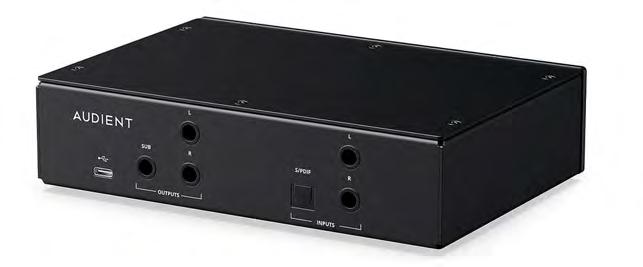
DIGITAL AUDIO Denmark has announced the adaptation of Dante firmware version 4.2.7 for its 128-channel Dante SRC card and Thunder | Core products, supporting ST 2110-30 and AES67 enhancements to the current Dante implementation. The Dante firmware update will deliver broader ST 2110-30 and AES67 support, addressing key broadcast requirements. This will be standard for all products shipped from 1 October 2025 and will be free of charge. The updated Dante SRC card is compatible with all card slot-based Penta and DAD products.
The new functionality requires the use of Audinate Dante Domain Manager to enable
EXPANDING THE Sonance
Professional ecosystem, the Wall-M wall-mounted controller is the first product from Sonance since the company’s acquisition of Blaze Audio. It natively pairs with Blaze by Sonance PowerZone Connect amplifiers (firmware 1.8+), requiring no external drivers or additional hardware, and builds on the Blaze Wall-S1 single-source controller with advanced multi-zone functionality to provide control of up to eight zones per amplifier, including source, volume and mute. Optional PIN lock, multilevel access and auto-revert timers are included for security, and its UI is customisable with adjustable screen themes, brightness, button backlight and rotary encoder navigation. Meanwhile, the Wall-M is firmware-updatable to support new features and extend product lifecycle. Designed specifically for integrators, the PoE-powered controller aims to deliver

multi-zone audio control in commercial spaces with installer-friendly setup and an intuitive interface for end users. It is available in matte white and matte black, with models offered for both EU and US installations.
www.sonance.com
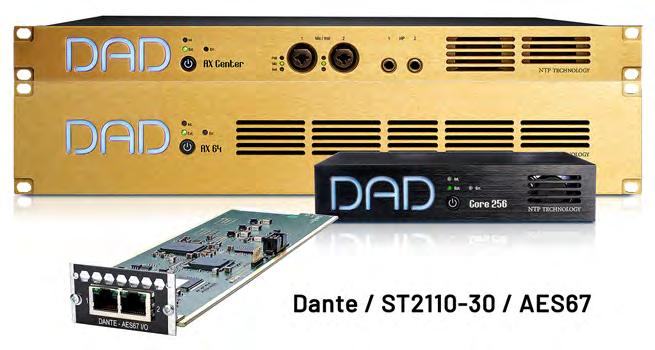
and manage the ST 2110 functionality. Once it has been set up, it supports multicast flows, configurable RTP transmit port, configurable multicast address prefix, advanced PTPv2 clocking settings, configurable packet time 1ms/125us and configurable RX latency.
The unit firmware updates are available from the DAD Support website and work across any units that feature expansion card options: AX Center, AX64, AX32, Penta 720 and Penta 721s as well as for upgrade of the native Dante implementation of AX64, AX Centre and Core 256.
www.digitalaudio.dk
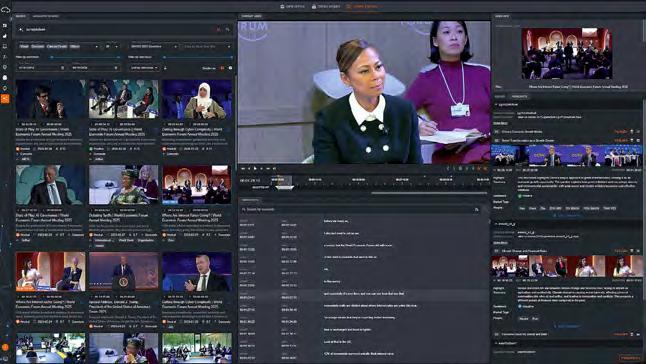
OPTIMISED AND tailored for the implementation of AI in modern TV newsroom productions, Tabatha is the latest module in Ideal Systems’ “Alice” cloud integration platform. Aiming to increase productivity by reducing content search times and increasing search accuracy, Tabatha enables users to search for any highlight across all news and sports genres without requiring contentspecific training. Developed out of a need for integration with both legacy broadcast systems and new media content management systems, it provides an enterprise integration layer for launching AI-assisted workflows, assisting with the creation of news content in
legacy newsroom environments with minimal integration. It also enables management and control of multiple AIs within the same workflows even if they are from different AI providers, providing different billing models and full API level audits of all actions. While Tabatha can integrate with many AIs depending on customer requirements, it launches with a native integration of Comcast Technology Solutions’ VideoAI. Ideal Systems says VideoAI is already used by some of the largest broadcast, media and entertainment companies in the world.
www.idealsys.com
RØDE HAS unveiled CallMe, designed to transform remote content creation for the RØDECaster Pro II and RØDECaster Duo. Developed in partnership with UK-based broadcast solutions company Vortex Communications, CallMe delivers ultra-low latency, studio-quality remote connectivity through seamless integration of Vortex’s CallMe Codec capability.
CallMe enables creators to connect remotely over Wi-Fi or Ethernet, without reliance on intermediary software, complex setups or additional gear. Powered by CallMe’s secure, fully integrated SIP IP audio connectivity, users can now immediately connect to another RØDECaster Pro II or Duo. They can also connect to a guest contributor using a browser-based interface, by sending an invite via email or QR code.
calling. CallMe provides support for two remote contributors (two CallMe channels) and unlimited RØDECaster-to-RØDECaster and Web-to-RØDECaster audio calls. Finally, CallMe Pro offers multi-guest support (three CallMe Channels), a fully integrated IP

CallMe is available in three flexible tiers. CallMe Lite is available for free via a firmware update and supports one remote contributor (one CallMe channel), offering up to 10 hours of RØDECaster-toRØDECaster audio calls per month along with a five-hour trial of Web-to-RØDECaster
audio codec with third-party interoperability and advanced SIP calling with full protocol support.
Finally, the manufacturer has announced that its Wireless Micro is now available in red, orange and blue.
www.rode.com
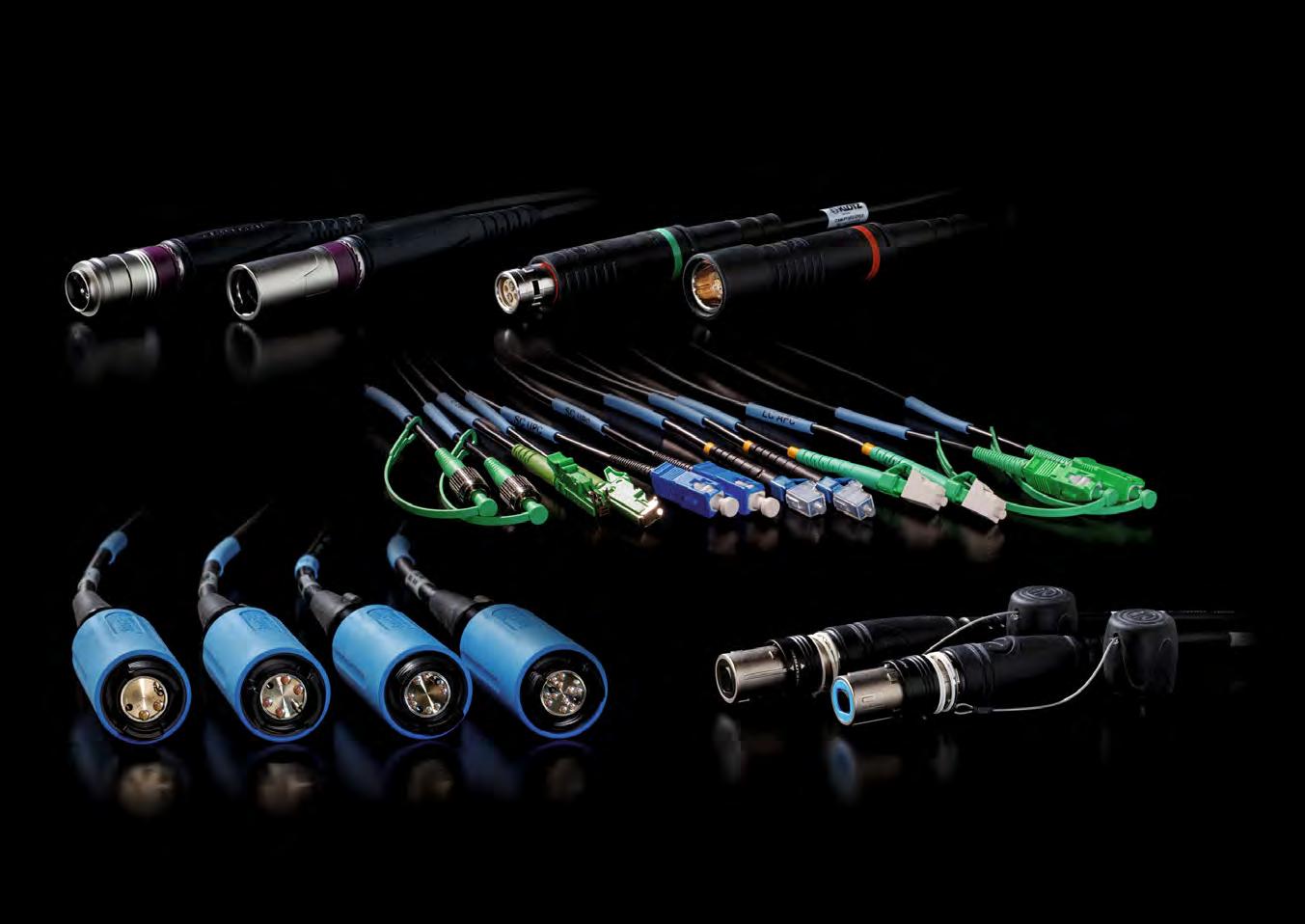

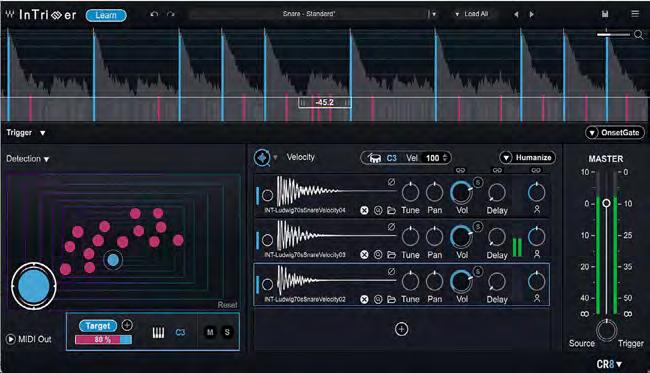
DESIGNED TO make drum triggering faster, easier and more accurate, the InTrigger plugin from Waves Audio includes a hit detection engine that reportedly saves producers and engineers hours of manual tweaking, by handling ghost notes and mic bleed, without manual threshold settings or editing.
InTrigger’s two-step workflow is said to simplify drum replacement: in step one, the system analyses the performance. By clicking the Learn button, InTrigger’s algorithm automatically detects and categorises the drum hits. In step two, users assign a new sample. The Humanise knob shapes each hit’s envelope and dynamics,
WITH 11 freely selectable firmware images, system software v3.2 for Lawo’s .edge helps users simultaneously combine gateway functionality with processing right at the network’s edge. Users are now able to leverage JPEG-XS encoding/decoding alongside essence transport, as well as SDI<>IP and IP<>IP processing such as colour correction, frame synchronisation and 3G UHD Gearboxing. In conjunction with the manufacturer’s HOME platform, .edge enables multiviewer heads based on proxy feeds it generates and the Dynamic Receiver parameter setting in the HOME Multiviewer app to ensure that each PiP/tile uses the smallest possible picture resolution at the highest quality.
Meanwhile, mc2 v12.2.0 is said to bring a host of additional productivity features and workflow refinements to the mc2 mixing platform. These
FOR STUDIO users, SSL has also introduced the Revival 4000, an all-analogue channel strip that recreates the signature sound of the 4000 B and E Series consoles. The unit combines a Jensen transformer-balanced mic preamp, the original B Series De-Esser and E Series VCA dynamics, enhanced with modern workflow options such as soft-knee defeat, fast attack and selectable release curves.
EQ flexibility is provided via SSL’s two most celebrated designs: the “Brown Knob” 02 circuit and the “Black Knob” 242 circuit, originally developed with Sir George Martin for AIR Studios. Additional routing options, re-routable filters, a balanced insert point and an external sidechain input bring contemporary versatility while maintaining the authenticity of SSL’s early1980s’ tone.
The manufacturer has also released version 6.1 of its SSL Live platform, introducing new features for immersive mixing workflows
so one sample reacts differently every time and delivers a natural, expressive feel across the song. Users can also stack up to eight sample layers to give drums greater depth and impact. InTrigger also includes a licence for Cosmos, Waves’ AI-powered sample manager, integrated directly into the plugin with access to 1,400 curated one-shot drum samples. These can be used to streamline workflow by letting customers organise samples in context, all within one session. InTrigger Live is also included for use in real-time performance environments. Built for Waves’ eMotion LV1 Classic and SuperRack setups, this version supports manual threshold settings and up to four sample layers. It omits the Learn and Cosmos features for maximum stability onstage.
Introducing full immersive audio mixing capabilities across all SuperRack products, V15 of Waves’ SuperRack now supports 5.1.4, 7.1.4 and 9.1.4 immersive channel configurations. With support across SuperRack SoundGrid, SuperRack Performer and SuperRack LiveBox products, Waves says the update enables new workflows for cutting-edge immersive audio in both live broadcast and concert environments.
Using Waves’ collection of professional plugins, engineers can now craft immersive mixes for live broadcasts, livestreamed events and live concert audio, and, with SuperRack LiveBox or SuperRack Performer, they can also integrate immersive VST3 plugins from other manufacturers. The Waves Immersive Wrapper plugin is also now compatible with all SuperRack products; this means any Waves mono plugin can be transformed into an immersive processor. Immersive Wrapper is now also bundled with SuperRack LiveBox, giving sound engineers and creative artists access to a variety of plugins running natively on a single 2U rack-mountable device with Dante or MADI connectivity.
Finally, the manufacturer has announced that Immersive Wrapper, which until now enabled any Waves mono-compatible plugin to function as an immersive processor for multichannel and object-based mixing in Dolby Atmos and other immersive formats, now supports VST3 plugins from a wide range of third-party developers.
include enhanced integration with VSM workflow control systems through Audio Matrix Control via the HOME API, enabling tighter, more responsive routing operations. Channel Display management has also been improved with the ability to select up to three different Mini Displays per screen for more at-a-glance information. A newly introduced standard 7-Band EQ module now includes three dynamic bands, offering more detailed and precise audio shaping, especially in demanding live environments. Furthermore, fader user buttons now allow operators to switch banks and layers directly from the fader panel, reducing navigation time during live productions.
Radio v8.2 includes the introduction of the 96kHz XL licence, which brings enhanced DSP capabilities to Lawo’s radio consoles, along with switchable compressor modes that can operate in either automatic or manual settings.

VisTool has also been updated with new features, including the expansion of the source assignment module, direct text input fields for faster configuration, improved touch handling

alongside the launch of the Dante-enabled MPL 16-8 stagebox. The update is designed to give live sound professionals greater flexibility, control and performance, while streamlining connectivity across SSL Live and System T systems.
Live V6.1 delivers a major overhaul of the console’s generic OSC (Open Sound Control) interface, adding a new pan graphic that supports X-Y or X-Z touchscreen interaction, plus encoder and fader control for up to eight fader and eight switch functions. The changes enable
and refined visual feedback mechanisms for touchscreen operations.
www.lawo.com
deeper integration with OSC-enabled immersive processing systems, including those based on the ADM-OSC standard. SSL has also enhanced its integrated Dante routing with resource ownership arbitration and a “Load with Owner Override” option, simplifying I/O and surface reallocation across consoles.
Accompanying the software release, SSL has introduced the MPL 16-8 stagebox, a rugged Dante-enabled unit with 16 mic/line inputs and eight line outputs. Designed for cost-sensitive projects, the MPL 16-8 provides single-console control support and is optimised for the SSL Live L100 Plus, L200 Plus and System T TCA platforms. The stagebox offers high-quality mic preamps with a gain range of +5dB to +60dB in 1dB steps, operation at 48kHz or 96kHz, and redundant Dante networking via etherCON RJ45 connectors.
DESIGNED TO enable “smarter, faster and more adaptive media workflows from ingest to delivery”, Telestream’s Vantage AI builds on Vantage’s DNA of automating complex operations. The AI expansion is said to broaden the scope of what can be automated, unlocking immediate and practical efficiencies.
Vantage AI has been designed to take a different approach by delivering context-aware metadata that’s embedded into workflows and ready to trigger real actions, whether automating subtitles, accelerating searches or enabling smarter decisions. It is described as a unified approach to AI that will allow customers to streamline operations, enrich metadata and enhance QC, while maintaining full control over content, infrastructure and cost predictability.
Features include AI-Caption, which generates accurate, multilingual subtitles from audio with
options for human-refined or fully automated delivery; AI-Speech, which creates searchable metadata through transcription, content summarisation and sensitive language detection; AI-Qualify, which detects lip sync issues, subtitle overlap and spoken language mismatches, problems often missed by rule-based QC systems; AI-Vision, which detects logos, scene changes and ad break opportunities to automate segmentation and streamline content repackaging; and AIWorkflow, which uses natural language prompts to create media processing workflows to accelerate production cycles while reducing errors.
The manufacturer has also updated its Argus platform with the introduction of real-time video, audio and caption playback from active alarms, allowing engineers to isolate service issues instantly. Argus provides single-pane-of-glass observability across OTT, satellite, cable, IPTV

and DAA environments. Sentry, Inspector Live and Surveyor probes feed into Argus for centralised fault detection and diagnostics.
Meanwhile, Prism has been expanded to simplify SDR/HDR monitoring and camera shading with enhanced 3D LUT support that enables precise HDR/SDR colour conversions and eliminates the need for external LUT boxes. This is said to streamline live production workflows with easier feed monitoring and setup. Updates to the patented HDR toolset include enhanced luma-

FEATURE AND firmware upgrades for the 8-Series mixer/recorder and Astral Wireless product lines have been announced by Sound Devices.
V11.0 adds several requested features to the 8-Series CL-16 linear fader control surface, including the new Waveform Display, Speed Shuttling ±32x, Advanced Navigation Tools, Fader Calibration and increased Channel Color options for customisability.
THEORY PROFESSIONAL has announced a new version of its Automator software. Following the introduction of Automator for the manufacturer’s ALC-1809 loudspeaker controller, AutomatorIP provides the ability to deploy Theory and third-party loudspeaker surround sound systems (up to 7.1 or 5.1.2) on its 8-channel DLC-250.8 loudspeaker controller platform.
Developed for integrators deploying surround systems for corporate/executive board rooms,
or immersive retail and commercial spaces, AutomatorIP runs on a connected PC. The interface walks installers through a simple five-step system configuration. According to the manufacturer, with a single DLC-250.8, up to 7.1 or 5.1.2 Theory or third-party surround systems can be configured from start to finish in just 15 minutes.
AutomatorIP key features also include optimised bass management and intelligent power management. With neither microphones
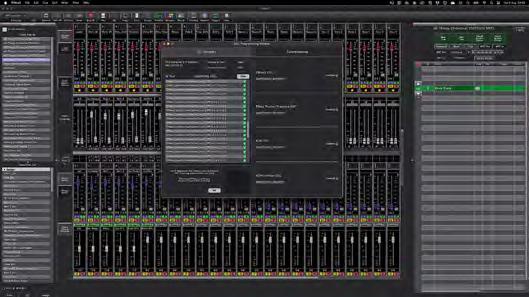
WITH ITS latest v6.11 software release, TiMax has announced an overhaul of its OSC implementation. The update means TiMax SoundHub now supports a range of
OSC dictionaries, enabling out-of-the-box compatibility with third-party control solutions such as QLab, Space Controller and Nuendo. In addition, the company has introduced
The manufacturer has also streamlined the nomenclature of Astral Wireless to more accurately reflect its growing ecosystem of wireless receivers, transmitters and microphones –specifically the Astral ARX32 (previously A20-SuperNexus), Astral ARX16 (previously A20-Nexus) and Astral ARX8 (previously A20-Nexus Go).
www.sounddevices.com
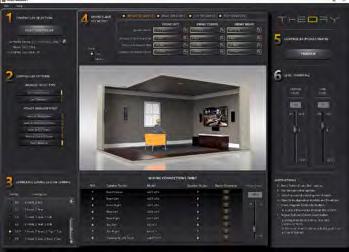
nor cables required, the software has been designed to makes configurations of even complex systems as simple as possible.
www.theoryprofessional.com
a TiMax SoundHub dictionary to enable advanced, bespoke integrations with SSL System T and SSL Live consoles; Atlas Show Control’s software platform for programming, synchronising and automating complex live events; and Grapes 3D Audio Control plugin. The update also introduces an enhancement of the integration between TiMax SoundHub and TiMax panLab’s version 1.3.
With aligned integration between TiMax and third parties dependent on mutual recognition of referenced coordinates, SoundHub utilised its Scaling Surfaces feature to bridge any divide by converting normalised coordinates to the absolute coordinate space. In addition to supporting a range of OSC dictionaries, TiMax says incoming OSC messages can also be manually mapped to TiMax SoundHub commands.
www.timaxspatial.com
qualified CIE chart controls and expanded
False Color modes for both artistic and technical review.
Four-port PTP redundancy, in-band test signals and dual-leader configurations for high-availability timing across IP, SDI and hybrid systems have been added to the SPG9000. These new features include ancillary test sequences, such as closed captions over both SDI and ST 2110-40, with the aim of enhancing commissioning workflows and compliance checks.
Finally, Vantage now integrates directly with next-generation media platforms, including Mimir, Iconik, Embrace and Broadteam, to advance interoperability across modern media supply chains. The integrations enable media organisations to automate critical workflows, scale operations on demand and connect cloud and on-premises environments
www.telestream.net
CUSTOM DESIGNED musicians, DJs and venues searching for professional sound in a portable format, the TrueSonic family from Alto Professional has expanded with the introduction of the TS108C and the TS112C column array systems. Both all-in-one systems are powered by Class-D amplification to deliver wide dispersion without the footprint of traditional box PAs. Both also boast four DSP application-specific modes as well as an app-controlled mixer, 2-band channel EQ and reverb, a balanced XLR mix output and wireless control with the Alto Pro app. The units are also capable of Bluetooth streaming from a variety of popular music apps.
Weighing 15.9kg and with an assembled height of 1.86m, the TS108C features a max SPL of 123dB and 600W peak power. It boasts an 8-inch subwoofer and six 2.75-inch column array speakers to deliver 100° x 30° coverage. It also features a 3-channel built-in mixer with dual combo inputs. The larger TS112C weighs 24.1kg and stands 2m tall when assembled. It has a max SPL of 127dB and 1,200W peak power from a 12-inch subwoofer and eight 2.75-inch column array speakers. Coverage is wider at 110° x 30°, while the unit has a 5-channel built-in mixer with dual combo inputs.

www.altoprofessional.com
DESCRIBED AS “the most versatile multi-tool in your road case”, the VIO W12T from dBTechnologies is a high-performance 12-inch coaxial active monitor developed to address the evolving technical requirements of stage monitoring and distributed sound reinforcement across a variety of deployment scenarios.
Purpose-built to perform as a wedge, the W12T features a 12-inch/1.3-inch coaxial neodymium transducer housed behind a rotatable 60° x 40° horn, delivering 138dB SPL (AES75). This configuration is said to provide directional precision and point source coherence for “highly intelligible” performance in short-throw and tightly controlled zones, while remaining adaptable to a range of deployment scenarios via optional rigging hardware. The design makes it suitable for
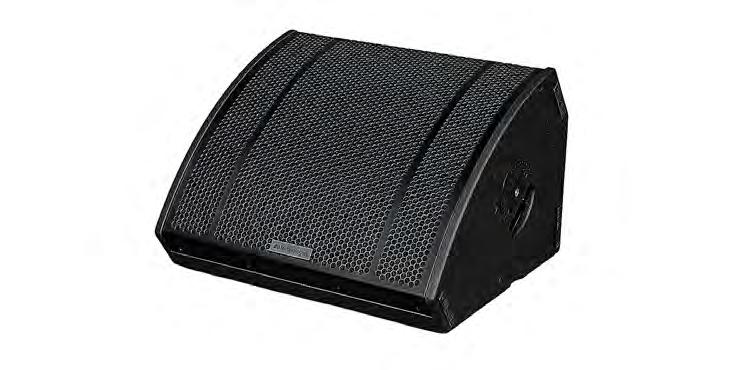
selectable high-pass filters (60–120Hz) allows for precise contextual tuning.
For remote control, monitoring and integration, the W12T features native RDNet support via
but mighty
in EM Acoustics’ Reference Series, the R4 has an ultra-compact, 2-way passive design engineered to convey the performance and headroom of its bigger siblings in the most compact package possible.
Expanding EM’s application range below the R5, the company says the R4 is perfect as a front fill or theatrical delay, for reinforcement in a corporate or AV setting, or for deployment in houses of worship. Its enclosure contains two 1.3-inch voice coil 4-inch neodymium LF/MF drivers and a 1.5-inch voice coil annular HF compression drive unit, while the use of a ring diaphragm HF unit retains ultra-low harmonic distortion levels. Meanwhile, the HF drive unit feeds one of two alternate waveguides to deliver a consistency of response both on- and offaxis. As with other Reference Series models, the R4 is supplied with both waveguide options to provide flexibility for both rental users and installation customers. The wide dispersion is 120° x 70°, while the narrower 80° x 70° dispersion offers more

when combined with the FIR processing functions of EM’s Advanced System Amplifier range and its bespoke waveguide design, the R4 yields flat frequency and phase responses. Externally, the enclosure is coated with an impact and weather-resistant polyurethane finish and is available in both black and white as standard, with custom RAL colour matching options and permanent outdoor enhancements also available. www.emacoustics.co.uk
professional use, the enclosure features a polyurea-coated wooden cabinet, a rugged wraparound powder-coated metal grille and recessed handle design. Weighing 22.5kg and equipped
with M10 rigging points, the W12T integrates seamlessly with VIO W-series accessories –including the new SA-WT pole mount adapter and U-bracket – for secure flown and installed configurations.
According to the manufacturer, the VIO W12T delivers “clean, high-output monitoring with phase-coherent coaxial clarity and consistent VIO voicing”, making it suitable for a wide range of performance styles in demanding live environments. Its compact form factor, flexible mounting options and remote DSP control also make it a valuable asset in auxiliary roles such as stage wings for offstage talent or cue mixes, choir loft fills in houses of worship, side-stage or utility vocal monitoring, speech reinforcement zones, and broadcast or camera wing monitoring.
www.dbtechnologies.com
THE LINEAR 9 Long Throw Pack from HK Audio is described as a scalable system configuration that combines high SPL performance, long-throw precision and plugand-play usability. Developed with the needs of touring professionals and rental firms in mind, the setup offers a road-ready solution for applications where range, clarity and control are needed.
The pack consists of two Linear 9 210 LTA mid/high units and six Linear 9 118 Sub BA subwoofers. This configuration is designed to deliver extended horizontal coverage, high output and a tightly controlled low-frequency response in both mobile and installed environments.
The Linear 9 210 LTA has been engineered for clustered arrays and quick rigging, and features a constant-curvature design for consistent dispersion across the horizontal plane. It can be paired with an 18-inch dualvented bandpass subwoofer to provide depth and definition in the low end.
All components in the Linear 9 range are controlled via HK Audio’s DSP Control software, which enables remote access to EQ, delay, limiter, mute and preset settings. The full system can be managed from the FOH position via a stable network connection using etherCON. In addition, all Linear 9 models can now be upgraded for Milan audio

networking compatibility with a free firmware update. DSP Out allows users to integrate non-networked speakers into the same setup and apply uniform DSP processing, extending the value of existing loudspeaker stock while streamlining control.
www.hkaudio.com
AS PART of the K-array ecosystem, KGEAR has added the GH4 Marine and GH8 Marine loudspeakers to its portfolio of ultra-compact point source, arrayable satellite loudspeakers. Designed for the marine market and outdoor environments, the IP65-rated versions are built on the acoustic quality and design of the original GH4.
Incorporating a 4-inch full-range driver with a dual-coil neodymium magnet, the GH4 Marine is housed in a corrosionresistant stainless-steel enclosure. The 16Ω impedance makes it adaptable to a diverse range of system configurations, while the signature cabinet design promotes tightly controlled audio

dispersion, particularly in open-air or reflective marine environments. Featuring an 8-inch full-range driver with a dual-cone design, the GH8 Marine inherits the acoustic principles of the GH4 and
can produce a maximum SPL of 129dB. To prevent energy loss and residual noise, its cardioid dispersion pattern ensures lower emission at the rear of the stainlesssteel enclosure and improved control.
Marine-grade accessories, including the K-WALL2LMINI Marine and a ground stake, provide a variety of rigging options.
www.kgear.it
Simplifies control across large audio installs and includes offline configuration capability
A vast selection of third-party API’s for ultimate system integration
No additional costs required to remote control and monitor audio installs
No software to download; browser-based and works on any device
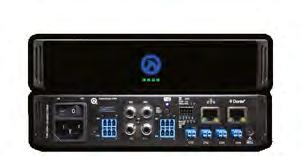





HARMAN HAS announced the launch of the JBL Professional Control 400 Standard Coverage Series and Control 400 Premium Coverage Series Ceiling Speakers. The 15 new models join the Control 400 Enhanced Coverage Series introduced earlier this year. The three tiers have been designed to provide the optimal solution to support any commercial application.
The Standard, Enhanced and Premium Coverage Series share many core features, including sonic performance, reliability, installation features and a contemporary design aesthetic. The nine Standard models are designed to provide high-performance audio at affordable price points; the six Enhanced units include JBL’s Coplanar Radiation Boundary Integrator (CRBI) to provide a more even frequency response throughout the coverage area; while the six Premium speakers include JBL’s proprietary conical Radiation Boundary Integrator (RBI) technology to achieve coverage consistency for installations where audio quality and clarity are paramount.
The Control 400 Standard Coverage Series consists of the Control 412C/T 3-inch, Control 414C/T 4-inch 2-way coaxial, Control 416C/T 6.5-inch 2-way coaxial and Control 418C/T
8-inch 2-way coaxial. The Control 412C/T-VA 3-inch, Control 414C/T-VA 4-inch 2-way coaxial and Control 416C/T-VA 6.5-inch 2-way coaxial are for Life Safety Applications (EN54-24). The Control 414C/T Micro 4-inch 2-way ceiling speaker and Control 414CT Micro Plus 4-inch 2-way high-output ceiling speaker both come with a low-profile enclosure.
Meanwhile, the Control 400 Premium Coverage Series comprises the Control 442C/T 2.5-inch, Control 445C/T 5.25-inch RBI-equipped 2-way coaxial, Control 447C/T 6.5-inch RBI-equipped 2-way coaxial ceiling speaker, Control 447LP 6.5-inch RBI-equipped 2-way coaxial ceiling speaker with a low-profile enclosure, Control 440CS/T 6.5-inch RBIequipped 2-way coaxial ceiling speaker for high ceilings and the Control 447HC 8-inch ceiling subwoofer.
Terminal covers allow for convenient top or side cable entry and the reliable captive dogear design accommodates a variety of ceiling thicknesses, ensuring versatility for any environment. Most options include transformers to support both 70V/100V and low-impedance applications.
pro.harman.com
EXPANDING THE lineup with solutions optimised for stereo, surround and immersive audio production, Neumann has introduced five subwoofers to its KH series. The KH 805 II, KH 810 II and KH 870 II are joined by two audioover-IP variants – the KH 810 II AES67 and KH 870 II AES67 – offering scalable monitoring options for a wide range of studio formats.
Designed to deliver greater headroom and tighter low-end control in stereo setups, the KH 805 II builds on the success of the KH 750 DSP with approximately twice the output. Positioned as a match for the KH 120 II, KH 150 or KH 310 monitors, the sub is aimed at music production, editing and mastering environments requiring precise bass reproduction.
For multichannel applications, the KH 810 II incorporates bass management for up to 7.1.4 configurations and supports up to 11 connected monitors. It shares the same acoustic design as the KH 805 II, while the flagship KH 870 II doubles the output again, pairing with largeformat monitors such as the KH 420 for full-
DENOTED AS an evolution of weatherproof systems for commercial and hospitality applications, Quest has redesigned the MX loudspeaker series. Engineered for applications requiring extended low-frequency response, high output and clarity, the MX Series currently consists of three weatherproof surfacemount loudspeakers. A broad assortment of accessories promotes venue flexibility and ease of installation.
The 2-way, high-fidelity weatherproof models comprise 4-, 6- and 8-inch versions, for integrating seamlessly with each other to provide consistent, full-range coverage. The 50W-rated MX4 and 60W-rated MX6 models provide a dispersion of 150° x 125°, and the 80W-rated MX8 offers a narrower 140° x 110°. Housed in an IP55-rated ASA injection-moulded cabinet from UV-stabilised materials and with a corrosionresistant grille, the MX Series low-profile cabinets can operate over 16Ω or 70V/100V impedance. The compact, low-profile enclosure enables discreet wall or ceiling mounting, with the respective UB1X included or UB2X optional brackets.
The Melbourne-based manufacturer has also engineered a range of 4-channel power
amplifiers with DSP and network capabilities. The QXD Series features four variants including the QXD-1K 4x250W amplifier. Providing flexible bridged output options up to 2x500W, including 70V/100V capabilities, the QXD-1K features UMAC Class-D technology, ensuring low distortion, high efficiency and low power consumption. Featuring 32-bit/96kHz DSP with FIR/IIR filters, peak and RMS limiters, together with Quest speaker libraries, the 1U amplifier is fitted with a front-panel TFT display, an RJ45 network port and GPIO for local and remote control and monitoring capabilities. Like the QXD-1K, the QXD-2K is housed in a 1U chassis, but the 4x500W amplifier has been designed for higher-output installations at 8Ω, 4Ω, 70V or 100V. Housed in 2U chassis, the QXD-5K and QXD-10K models provide 4x1,250W and 4x2,500W Class-D amplification respectively. Designed for performance-critical installations, all four amplifiers are equipped with advanced protection features, fan-forced cooling, universal mains and a standby power consumption of under 0.5W. Optional expansion includes Dante/AES67 compatibility.
www.questaudio.com.au



scale immersive workflows in postproduction and studio settings.
In addition to analogue connectivity, Neumann has also introduced AES67-compatible versions of the KH 810 II and KH 870 II. Designed for broadcast and networked studio environments, the AoIP models support 12 AES67 channels and offer full compliance with ST 2110, ST 2022-7 redundancy, Ravenna, NMOS and Dante-generated streams. According to the manufacturer, this ensures futureproof system design and flexible interoperability across digital audio networks.
All five models are equipped with a built-in DSP engine and integrate with Neumann’s MA 1 Automatic Monitor Alignment system for full-room calibration, allowing users to tailor the entire monitoring setup, including analogue KH monitors, for optimal phase coherence and accurate low-frequency response. Each sub extends down to 16Hz.
www.neumann.com
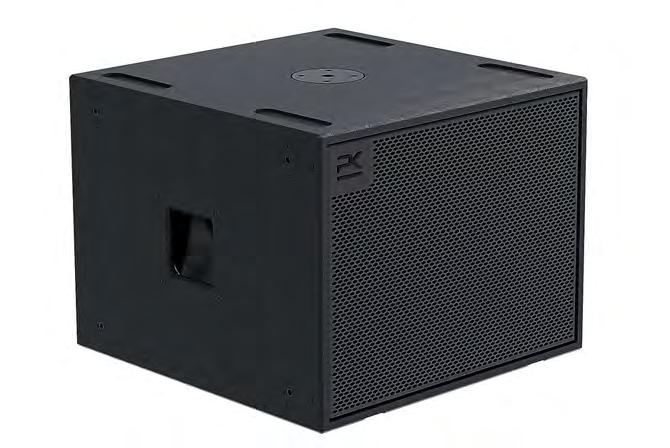
PK SOUND has introduced the Ts15 subwoofer, a low-frequency offering in the Trinity range of robotically controlled line source systems. The high-output, lowprofile enclosure has an operating range of 33–130Hz and peak SPLs of 136.5dB. It features a front-loaded, long-excursion 15-inch transducer in a bass-reflex design for clean and punchy output. A large vent enables high SPL performance with minimal port distortion. PK Sound’s proprietary VE platform single field-replaceable module located on the rear of the cabinet contains the 2,400W Class-D amplifier, control electronics and power supply. Onboard DSP and AVB end points are said to simplify setup and calibration while
optimising acoustic performance, all routed through Neutrik’s DR Series of IP65-rated connectors. Network-based Auto-Array via PK .dynamics software allows each Ts15 to recognise its position within the system for improved accuracy and simplifies advanced deployments including cardioid configurations and arc delays. Integrated rigging hardware allows for modules to be securely ground-stacked or flown as single units in a wide array of configurations via an optional Bracket Set. An M20 pole mount thread is also located atop the unit, and an optional Caster Kit is easily installed for portability.
www.pksound.live
WITH LIVE sound engineers preferring to use the AES/EBU digital audio connectors of CEDAR Audio’s existing noise suppressors to minimise latency for concerts, festivals, conferences and other live events, the manufacturer has released the DNS 8S, a noise suppressor designed specifically for
paths anywhere within the audio chain. With its standard 4-pin 12VDC input in addition to universal mains power, it’s suitable for use in all live situations, such as theatres and places of worship.
Meanwhile, the manufacturer has also added two processes to its CEDAR icons suite
DEBUTING IN Meyer Sound’s ASTRYA-140 screen channel loudspeaker, the Galileo Extended Networking platform – or GEN-1 –brings networked connectivity and onboard signal processing directly to the loudspeaker. While traditional sound system designs rely
transforms each loudspeaker enclosure into an intelligent node on the network. AES67-compatible and optimised for Milan integration, GEN-1 is capable of receiving an AES67 audio stream and performing full onboard processing, including delay and

on centralised DSP to manage processing before distributing signals to loudspeakers, GEN-1 shifts that model by embedding processing at the loudspeaker. Meyer says that this not only reduces cabling and rack requirements but also minimises points of failure and gives system designers greater flexibility in how they tailor systems to specific performance and budget needs. Delivering the processing power of a single Galileo Galaxy channel, GEN-1
EQ, as well as Meyer Sound’s proprietary U-Shaping and Product Integration tools. Configured and monitored via the manufacturer’s Nebra software platform, GEN-1 also delivers system telemetry over a network connection. As the platform evolves, Meyer says Nebra will enable additional control features and user-defined logic for network redundancy and failover.
www.meyersound.com
SOMMER CABLE
live sound and broadcast where audioover-IP isn’t required. The DNS 8S offers the same setup, processing and remotecontrol capabilities that make previous DNS hardware simple to use, along with a high-quality AES/EBU breakout cable. This means that users can immediately connect its four XLR male plugs and four XLR female sockets to almost any other professional standard digital audio devices and be working within moments of unpacking. It is suitable for front of house, monitoring, liveto-air broadcasting and anywhere else where near-zero latency and retention of lip-sync is critical.
The DNS 8S also provides fail-safe AES3 audio bypass implemented in the form of hardware relays that immediately connect its inputs to its outputs in the event of a power failure or other significant disruption. This means that users can install it in critical
of plugins. Derived from the CEDAR Studio range, Auto Dehiss and Debuzz offer the same processing, but with new user interfaces that are said to make them quicker and easier to use. Auto Dehiss removes noise in real time without unwanted side effects. It can be used to remove tape hiss and other broadband noise when mixing and mastering, in post and when preparing user copies in libraries and archives. Debuzz removes buzzes and hums with fundamentals as high as 500Hz, and can eliminate unwanted harmonics across the entire audio spectrum. It will track wandering tones so that the problems don’t reappear if the fundamental frequency drifts and, unlike traditional filters, can restore the audio without unwanted artefacts and side effects such as limited bandwidth or the hollow sound introduced by comb filters.
www.cedaraudio.com
XLR connector to its Hicon Alp-Line XLR series. The HI-X3CFA-NXT (female) and HI-X3CMA-NXT (male) come with high-quality, gold-plated contacts for optimum signal transmission. The robust construction in a metal housing reportedly ensures increased durability, while the black silk matte finish is described as visually appealing.
The slim, ergonomic design is said to provide a comfortable feel, making it suitable for daily use in demanding audio, lighting and event technology applications.
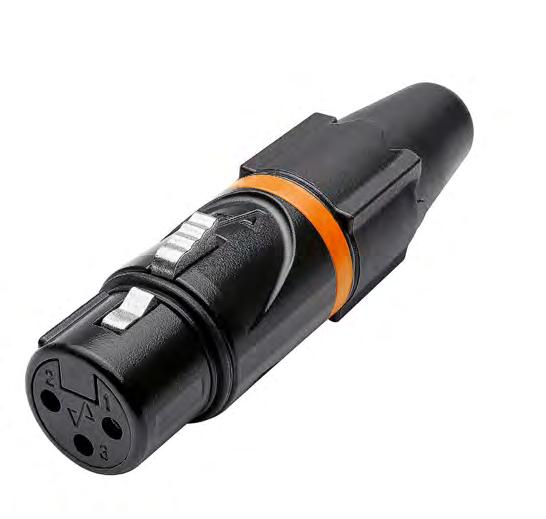
The special clamping chuck design provides a pull-out force and, at the same time, facilitates installation. At the end of the connector, a flexible plastic cap with integrated kink protection protects the cable from bending stress. The cap’s rib structure means it can be fitted quickly and easily without any additional tools.
while a black replacement ring for alternative markings is also included. The connectors are suitable for cables with a diameter of 3–8mm. When matched with the SC-Binary 225 DMX cable, it can be used by ambitious lighting riggers and event professionals who need to rely on their equipment even at height.
www.sommercable.com
OVER RECENT years, Tasker has gradually increased its range of CPR approved products so that it can provide solutions that are suitable for all applications in the audio and broadcast worlds. The manufacturer has recently released several cables that are compliant with the most advanced homologations needed worldwide. This is part of a broader approval programme that has already been scheduled up to 2030 and that aims to create a complete range of audio, video and LAN cables for all risk classes required by the new legislation. All of the company’s products are suitable for indoor and outdoor installations.
For digital audio, Tasker has unveiled a new range of multipair cables, ranging from two to 12 pairs. The TSK908 CPR Cca is suitable for multiple operating situations such as control of complex lighting systems or connecting to thimble control desks.
For video applications, the company’s 12G-SDI cables are suitable for video signal at 4K
resolution at distances between 40–100m. Available with CPR homologation for medium (Cca) and high (B2ca) fire risk classes, the TSK1078, TSK1079 and TSK1080 are suitable for broadcast installations.
For local area network, video-over-IP over 1GHz and DMX signals, the Cat7a C723 CPR B2ca allows customers to install a single versatile cable that can be used for a wide range of applications.
All the manufacturer’s products are highly shielded, featuring an inner aluminium foil on the pairs and a second foil on the total grouping followed by a dense tinned copper braid shielding. The external sheath, made of a special low-smoke, zero-halogen material, means that the cables are suitable for fixed installations in outdoor environments in direct contact with atmospheric agents.
www.tasker.it
SPECIFICALLY CREATED for multiamplifier systems, the pre-assembled Klotz LP164XY1S 16-channel speaker multicore cable is compatible with all multicore speaker cables with Socapex connectors. Elaborately constructed and capable of replacing up to two 8-channel speaker cables, the LP164XY1S ensures reliable signal transmission over long distances and reduces setup times. The multicore serves as the foundation for the latest LP164XY1S series, which comprises 16 conductors with bare copper strands (class 6, VDE 0295), each with a conductor cross-section of 4mm². Ensuring maximum tensile strength even under extreme conditions down to –40°C, a cold-resistant PVC outer jacket is stabilised with an additional Vectran textile braid. Designed to meet stringent legal requirements in theatres, multipurpose halls, tradeshows and production facilities, the EC1-1225G5 6-channel high-flex EnergyCore is
a power multicore cable for multiple AC power circuits distributed over long distances. The flexible EC1-1225G5 features 12 2.5mm² power conductors of high-purity Cu-EPT1 copper and two 2.5mm² PE protective conductors. The dual 2.5mm² grounding in the EnergyCore ensures effective power transmission, with each of the 12 cores made of finely stranded, bare copper
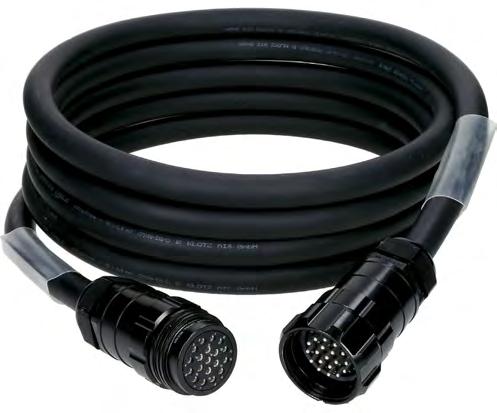
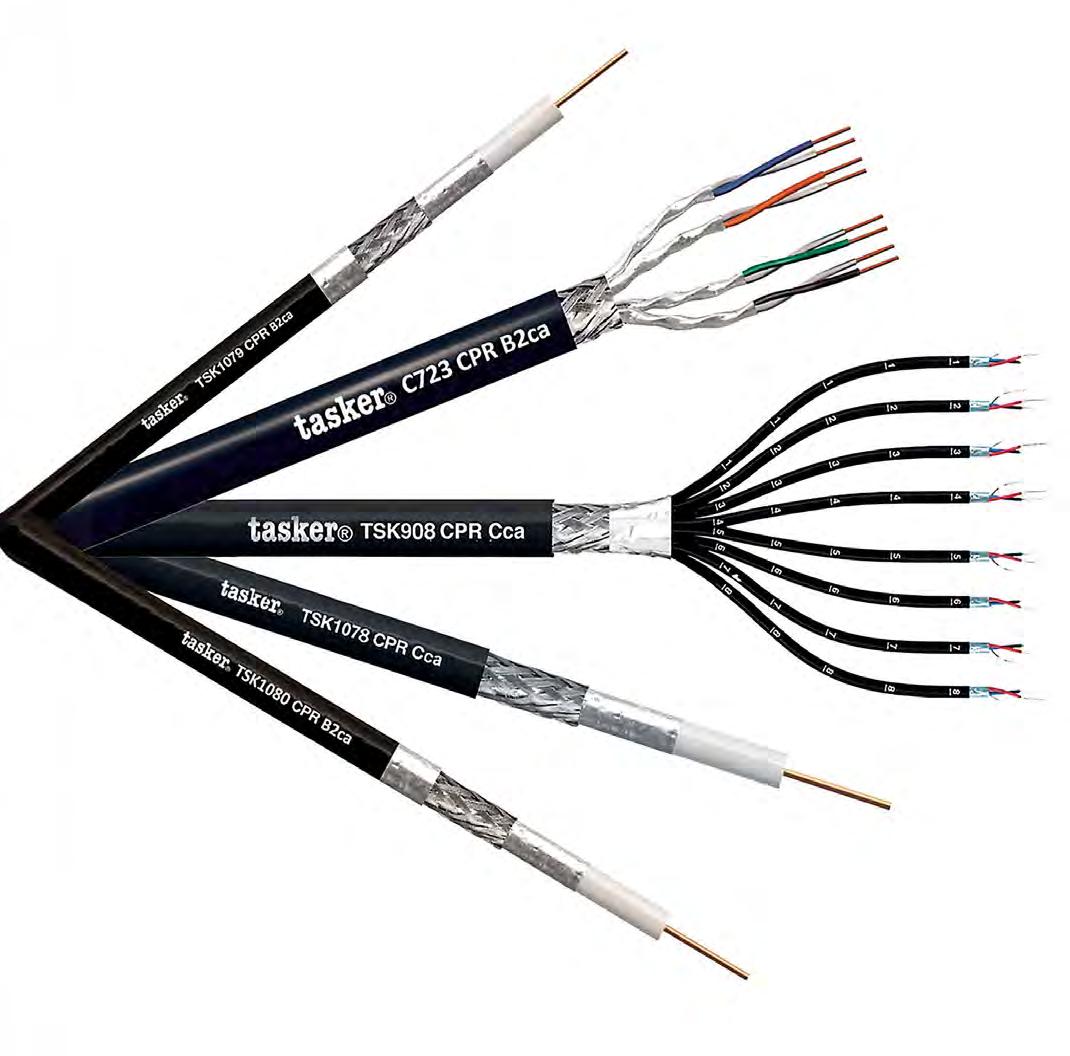
stability while maintaining high flexibility down to –30°C. For connector options, the multicore can be assembled with either a 16-pin Harting HAN 16ES or a Socapexcompatible RMP419AR. The EMC6 MF power multicore cables were developed for event,
JOINING ROBE’S T-Series and specifically created for theatre and broadcast environments, the T3 Profile has been designed for long-throw applications. Over 31,250 lumens (integrating sphere) emanate from the T3 Profile’s 1,400W MSL (Multi-Spectral-Light) LED engine, offering user-selectable – CMY, RGB or individual colour emitter RGBAL – colour control for nuanced colour work. Colour features include a DataSwatch virtual colour library, factorycalibrated whites, an extensive 2,700–8,000K CCT range, lamp selectable tungsten emulation and MCE multicoloured effects directly from the LED engine. It has a virtually controlled CRI of 80–95+, while UpLift handles can be attached and removed to improve portability.
The iPAINTE LTM comes with a 170mm front lens but weighs 30kg. The optical design
features a 2:1 field ratio, enhanced with a 3–52° zoom range – narrowing the iris allows coverage from 2–52°. In long-throw mode, using patented xR7 technology, this fixture provides ultra-tight beams from 0.7–2° without any of the intensity loss usually associated with engaging an iris.
Said to solve remote power issues for all environments, the PowerDolly weighs 80kg and has a load capacity of up to 200kg for all types of kit, including lights, audio and AV equipment. For all-round environmental protection, the PowerDolly has IP65 ingress protection; for touring and location work, the unit has an IK07 impact protection rating. Selected for safety, longevity and extra stability, the LiFePO4 battery within the PowerDolly delivers long-lasting 5,000Wh power, generating 2,000W for 2.5 hours or over 300W for 16 hours.
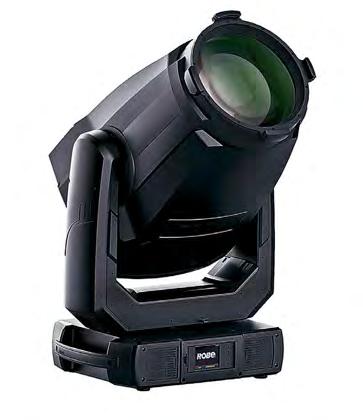
Following the initial SVOPATT launch, demand increased for a streamlined model. The SVOPATT Classic can be used as either a scenic element, as a dynamic light curtain or as part of a “pixel matrix” combined with other “pixel”-style fixtures. The SVOPATT Classic has
a Socapex-compatible RMP419AR (male/ female) in the EMC6RMF version or Harting HAN 16ES (male/female) in the EMC6HMFT version.
Developped for mobile applications, the EMC8HMFT is an 8-channel variant with a 16-pin Harting HAN 16E. The lightweight and flexible power multicore cable features 16 2.5mm² power conductors and a 4mm² PE protective conductor. The 4mm² grounding added in EnergyCore ensures maximum protection for 16A operation.
www.klotz-ais.com
nine individual modules, each with six 40W RGBA multi-chips that deliver over 12,500 lumens of output and 132,500 lux at 5m. With a fixed 4° beam angle, each module supports quick-swap diffusers, so the beam spread can be tailored to all design requirements, individually or across the entire fixture.
The IP65-rated FOOTSIE1 MC comes with 24 4W RGBW or RGBA LED multi-chips, increasing to 48 for the FOOTSIE2 MC. The fixtures have a low-profile, 52mm-high design and are said to produce smooth colour homogenisation closer to the source. A self-contained cable tray removes any loose laying cables and reduces trip hazards, reportedly resulting in a cleaner-looking installation with quick and easy connection between fixtures, including various angled corner pieces.
www.robe.cz

CAMEO HAS expanded its AZOR series with the launch of the AZOR SP2 IP, a compact IP65-rated spot profile designed for both indoor and outdoor use. Equipped with a 300W LED light source delivering 11,100 lumens, the fixture combines a powerful output with a versatile effects package in a weatherproof housing.
Offering a 3–51° motorised zoom, the unit also integrates CMY colour mixing with linear CTO, and an additional colour wheel
THE MAVERICK Storm 1 Flex is the latest addition to Chauvet Professional’s Maverick range. It is an IP65-rated, high-powered spot/ beam/wash combination fixture with a 520W LED source, CMY and CTO colour mixing to create a wide palette of colours, an animation
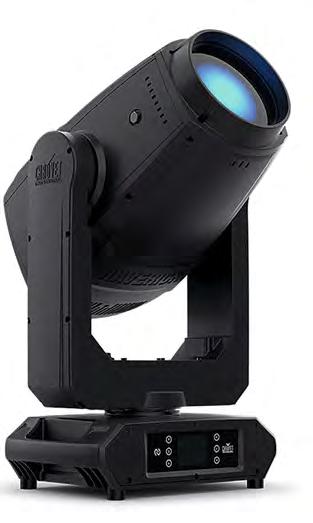
REPRESENTING THE latest development in the Sharpy line and incorporating several updates aimed at improving output, colour control and reliability, Claypaky has introduced the Ultimo Sharpy, a compact IP66-rated beam moving head designed for use in high-demand production environments.
The Ultimo Sharpy is built around a newly developed 250W ultra-high performance short-arc lamp, delivering a luminous output of 100,000 lux at a distance of 20m. The fixture maintains a compact footprint similar to the original Sharpy while incorporating advanced optics to produce a sharp, halo-free beam. According to the manufacturer, the lamp offers a lifespan of up to 6,000 hours in “Pro mode”, which includes dimming algorithms designed to reduce operational stress during low-intensity cues. Motion features include fast tilt, infinite pan rotation and updated motor control.
featuring eight dichroic filters. A rotating gobo wheel with seven replaceable glass gobos, overlapping prisms, two frost filters and motorised framing blades on four levels provide extensive creative possibilities. The framing shutters can rotate by ±60° for precise beam shaping, while the fixture’s 360° pan and 270° tilt add dynamic movement options.
Optimised for both live and broadcast use, the AZOR SP2 IP includes adjustable

PWM frequencies up to 25kHz for flickerfree camera performance. Control is offered via DMX512, RDM or wirelessly through an integrated W-DMX iDMX adapter, with an OLED display and onboard controls simplifying configuration.
Housed in a durable metal and ABS chassis, the fixture weighs 24kg and is designed for reliable operation in ambient temperatures from –10°C to 45°C. IP65 protection ensures resistance to dust and water, making the fixture suitable for demanding environments such as outdoor theatres, open-air festivals and architectural installations.
www.cameolight.com
wheel, two gobo wheels, two layerable prisms, large zoom range and lightweight aluminium/ magnesium housing. Other features include 16-bit dimming of the master dimmer for smooth control of fades, CRI and CTB filters on the colour wheel for added flexibility, one rotating and one static gobo wheel and a tight 2.6° narrow beam angle for focused air effects. The fixture includes seven rotating and 10 static gobos, along DMX, CRMX, sACN and Art-Net. An integrated sun shield protects the optical path from sunlight when the fixture is off, while a USB-C slot is included for software uploads. Meanwhile, the Strike Saber 10 is an IP65 10-cell batten that can be used as a blinder, footlight or tunable warm-white wash. It has an emulated “red shift” to mimic incandescent fixtures, while 16-bit dimming control provides smooth fades. The fixture is pixel-mappable for intense chase and strobe effects and has a built-in NFC chip. It also includes an easy-to-use OLED display, adjustable Pulse Width Modulation (PWM) and RDM (Remote Device Management) for added flexibility. The 5,959-lumen unit has a colour temperature (at full) of 2,792K, a CRI of 92.9, a TLCI of 91, a 20.9° vertical and horizontal beam angle and a 25.1° horizontal and vertical field angle.
www.chauvetprofessional.com
ETC HAS introduced two additions to its architectural portfolio, the Navis 50 luminaire and the Response 0-10V Gateway R3. Both are designed to enhance flexibility, reliability and integration for modern lighting environments.
The Navis 50 is the latest in ETC’s Navis series of architectural fixtures, delivering a 600-lumen output in a compact 2-inch aperture. Available in fixed white options from 2,700–5,000K, with a 90+ CRI, it also features ETC’s patented Fade to Warm functionality on the 3,000K variant to mimic the red-shift of incandescent dimming. Multiple beam angle options (15°, 25°, 40° and 60°) and damp-location rating make the luminaire suitable for offices, hotels, restaurants and other demanding spaces. Engineered to operate exclusively with ETC’s F-Drive RX system, a single driver can power
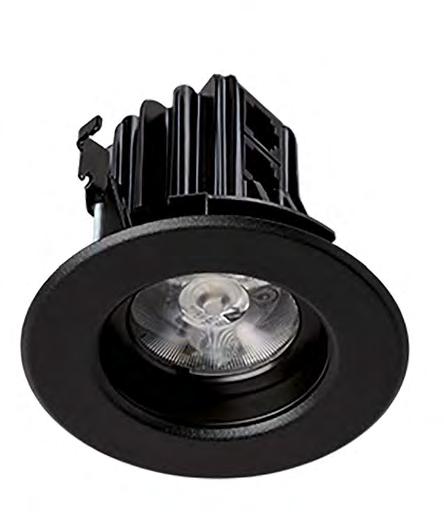
and control up to 240 Navis 50 fixtures via lowvoltage Cat6 cabling, simplifying installation and enabling scalable designs.
Alongside the luminaire launch, ETC has released the Response 0–10V Gateway R3, the latest evolution of its power control solutions. The R3 brings enhanced electrical isolation to all 24 channels of 0–10V sink control, ensuring robust performance in retrofit and new installations alike. It supports both sACN and DMX protocols, with user-defined signal precedence, and is UL 924 listed for integration with Directly Controlled Emergency Luminaires. With flexible configuration, customisable dimming curves and control via ETC’s Concert software or its onboard interface, the DIN-rail-mounted R3 gateway is said to offer precision and reliability for critical applications.
www.etcconnect.com

The fixture also supports a Sharpy Emulation Mode, allowing it to replicate the behaviour and timing characteristics of the original model. In terms of colour control, the Ultimo Sharpy features a true CMY mixing system in place of fixed colour wheels. This is supplemented by a 14-colour wheel and a frost filter for beam-to-wash transitions. Dual rotating prisms can be controlled independently or layered with gobos and frost for more complex mid-air effects.
Weighing 19.5kg and measuring 534mm in length, the fixture is designed for ease of rigging in tight or overhead spaces. Its IP66 rating makes it suitable for outdoor use, while the 140mm front lens allows for consistent beam clarity across long distances.
www.claypaky.it
INSPIRED BY Shakespearean theatre, Martin Professional says its ELP MANET 8f LED stage and studio Fresnel blends tungsten warmth with high-efficiency LED performance. Debuting the company’s next-generation light engine, the fixture adopts a six-colour engine featuring red, green, blue, amber, lime and cyan LEDs, to deliver a TM-30 Rf of 95 and a CRI score of 98. Its fully linear colourtemperature control spans 1,850–12,500K in 50K increments. Meanwhile, its 8-inch Fresnel lens delivers soft-edge fades that Martin claims are free of artefacts, while the
9–50° zoom system offers precise lumen control. Standard anti-reflective barn doors enable beam shaping and eliminate glare. Despite delivering over 13,000 lumens of output, the ELP MANET 8f boasts a sub30dB noise rating. In addition, the unit’s integrated manual zoom and optional poleoperated yoke allow for quick and easy focusing from stage to studio, an intuitive menu and control options, including NFC compatibility with the Martin Companion Mobile app that simplifies setup and operation.
pro.harman.com
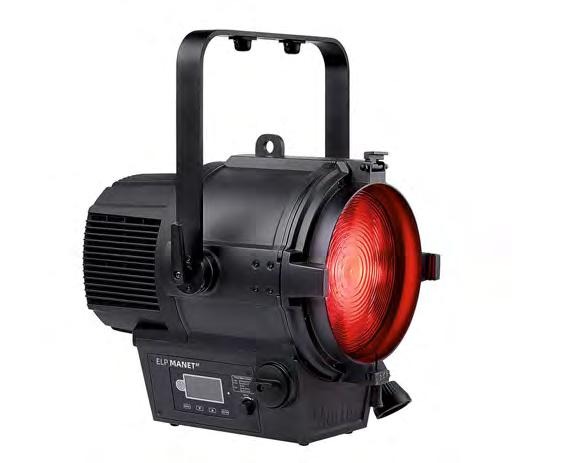
GLP HAS introduced the first fixtures in its new Matrix Series with the release of the Matrix Eye 2 and Matrix Eye 4. Designed as part of a modular cluster system, the fixtures can be mechanically linked into larger seamless lighting units, offering a flexible approach to stage and event design. Both models employ RGBAL LEDs with GLP’s iQ.Gamut colour algorithm to deliver high-efficiency output and accurate colour rendering. With a CRI above 90 at 6,500K, the fixtures replicate the behaviour of traditional DWE tungsten blinders, including a realistic warm dimming curve, while adding the versatility of modern LED technology.
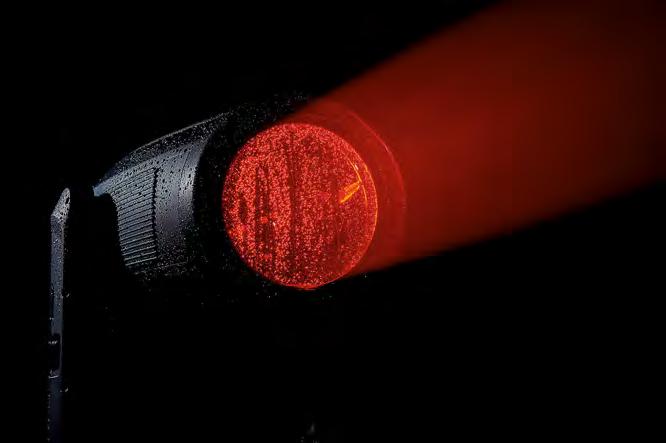
EXTENDING THE company’s Paragon Series, the IP54-rated Paragon LT is a long-throw LED profile luminaire from Elation designed for large productions and stadium shows. Incorporating a number of proprietary patents, the Paragon LT boasts full output even with framing or animation engaged. It has variable TruTone CRI control that allows adjustment from CRI 70 to CRI 93, a dimming system that claims to boost brightness by 4% and a Turbo Mode to deliver up to 20% more output. The luminaire reportedly uses the largest rotating gobo wheel in Elation’s history, as well as re-engineered frost and zoom systems that cut noise by up to 10dB. At the heart of the Paragon LT is a 1,300W variable CRI white LED engine delivering an output of up to 52,000 lumens. It has a 200mm front lens and a fast zoom range from 3.7–48°, as well as providing a full FX suite: three gobo wheels (two rotating, one fixed), a full animation wheel, overlapping dual prisms, dual frosts and a high-speed iris. Its indexable
pan adjustment, while both fixtures carry an IP65 rating for indoor and outdoor use.

The Matrix Eye 2 houses two LED engines, producing up to 19,650 lumens with a 100° field angle, while the larger Matrix Eye 4 doubles the output to 39,300 lumens from four LED engines. Each head provides ±20°
Control options include DMX, RDM and GLP’s iQ.Mesh wireless protocol, with multiple channel modes and high-resolution dimming curves. Pixel rotation and mirroring effects are built in, while fan speed, PWM frequency and output modes are user configurable. Constructed from lightweight yet durable materials, the Matrix Eye 2 weighs 9.5kg without its yoke, compared to 13.5kg for the Matrix Eye 4. Both can be clustered via a dedicated alignment and linking system, making them suitable for touring applications and fixed installations alike.
GLP says that the Matrix Series is designed to offer maximum performance at a costeffective entry point, ensuring fast return on investment and competitive rental rates.
www.glp.de
THE D3 family from UK lighting and visual control manufacturer Avolites is a five-strong family of control products powered by Avolites’ Titan software. Designed to deliver intuitive programming and operation for multiple
full-blackout framing system provides beam shaping and detailed shutter cuts, while its profile lens can be swapped for a Fresnel wash or PC beam lens.
Combined with a variable linear CTO, Elation says the Paragon LT features its fastest and quietest CMY colour mixing system to date; available as an option, the SpectraColor colour mixing system uses a CMY + RGB mixing array in combination with the variable CTO to deliver an expanded colour range. Its Ultra Dimming system allows for precise low-level control and operates at a refresh rate of 25kHz. For noise-critical environments, a range of lownoise modes minimise distractions for quieter operation. Paragon LT’s specialised theatre mode further reduces sound by slowing specific motors to decrease audibility and resonance. This can be remotely activated, allowing the fixture to adapt to specific situations as the performance requires.
www.elationlighting.com
across all sectors. The console has a mixture of USB-A and -C ports for file transfer, device control and systems integration.
The D3 Wing adds 20 faders to both consoles to provide more physical control during live

lighting solutions, the D3-010, D3-110, D3 Wing, D3 Core and D3 Touch aim to make lighting and visual control more widely available to a greater range of operators, technicians and projects.
The D3-010 is a self-contained, entry-level console that can handle up to eight universes of DMX control without needing a laptop and offers full programming via 10 faders, three encoder wheels and 12 Macro buttons. Pitched to clubs, mobile rigs and events, as well as freelancers wanting to travel light, an external monitor can be added to access Avolites’ Titan processing and a D3 Wing expand the surface with more faders if needed. The D3-110 features 24 DMX universes of control and an inbuilt touchscreen, and is designed for festivals, gigs, performance and dance shows, plus rental and touring fleets
playback as well as during cue stacking and speed programming. Occupying minimal real estate, it brings more flexibility to the control space for media layers and effects, without needing to replace the console. Meanwhile, underpinning the D3 series, the 1U rackmounted D3 Core processor runs Avolites’ Titan software to bring greater versatility and control practicality to installations, remote-controlled shows and space-challenged locations. Finally, the D3 Touch is a pre-configured plug-andplay Titan remote control interface for use with any D3 product, enabling non-technical staff to switch on/off anything from looped show playbacks to house light presets and architectural schemes.
www.avolites.com

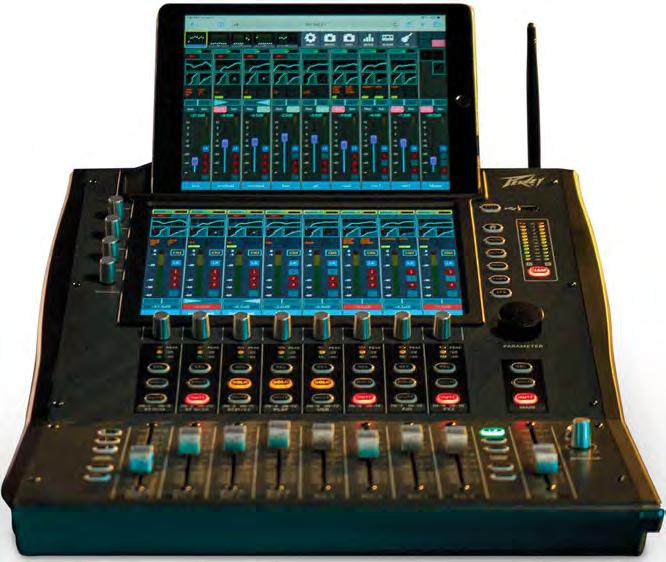

The Aureus Series - the Gold Standard in one-touch digital mixing.
Marking 60 years of innovation, crafted by some of our most experienced engineers, the flagship Aureus 28 delivers 28 inputs, 14 outputs, a 1 0" multi-touch display, nine motorized faders, and Wi-Fi tablet control with per-BUS password security
The Aureus Mini, ideal for intimate installations and live performances, home studios and freelancers, packs 20 inputs, 12 outputs, 6 BUS, 2 mains, and 8 DCAs into a compact and sleek package.
Both models feature, onboard FX, powerful routing, and rugged portability - so wherever you mix, Aureus puts gold-standard control at your fingertips.
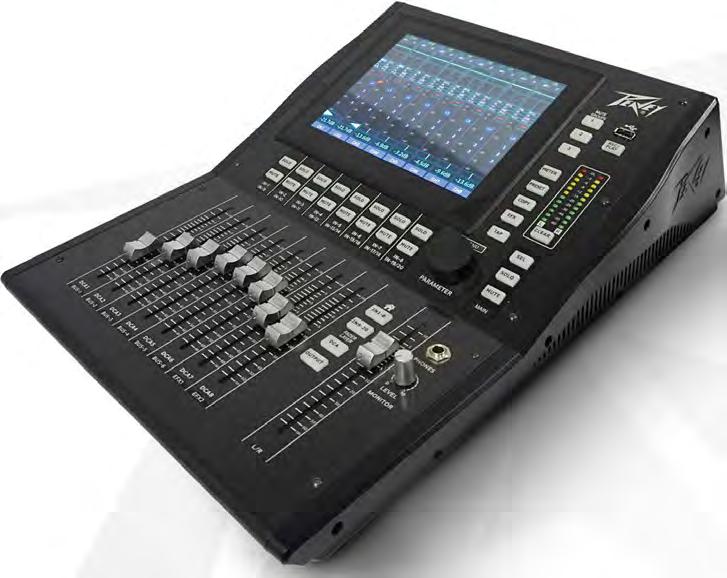

For more information: https://peaveycommercialaudio.com/peavey/

GRASS VALLEY is introducing a series of new live production technologies, including a compact addition to its cinematic camera lineup, a next-generation replay platform and expanded software-defined workflow capabilities built on the AMPP OS architecture. The announcements reflect the company’s continued drive to combine hardware with cloud-native infrastructure for scalable, futureproof production environments.
Headlining the camera lineup is the LDX C180, a compact version of the flagship LDX 180 large-imager model launched earlier in the year. Built around the same 10K Super 35 Xenios sensor developed in-house, the C180 is optimised for Steadicam and PTZ applications, bringing cinematic depth-of-field and high dynamic range to faster-paced live production settings. Its compact form factor is said to allow creative teams to capture moments with a new level of “drama, intimacy and impact”.
The full LDX 100 Series has also received several upgrades. A new UHD/HDR option has been added to the LDX 110, while all models now support cable-less roaming
and low-latency contribution via RF and 5G integration from Vislink. A redesigned ND filter setup enables 1 F-stop exposure
being introduced for installations requiring dedicated 12G connectivity instead of hybrid or IP-based workflows.

control for precise HDR and SDR shading, and an optional Optical Low-Pass Filter helps mitigate interference from coarse LED walls without compromising detail or contrast. A new 12G-SDI XCU Cradle is also
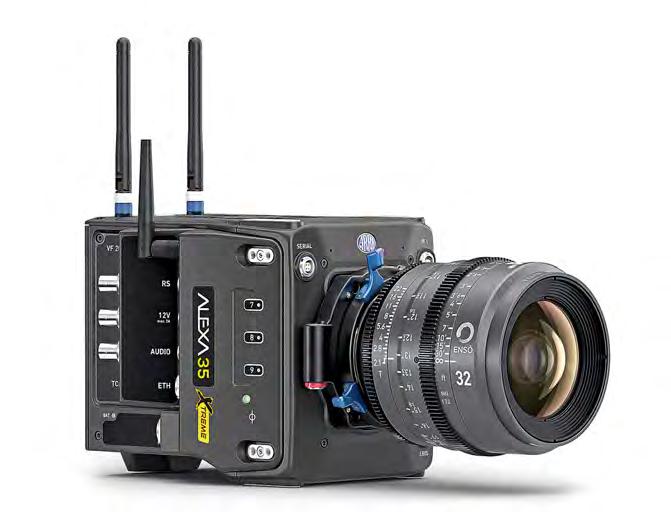
CREATED TO replace the Alexa 35, the Alexa 35 Xtreme from ARRI incorporates higher frame rates, a next-generation, high-quality codec that reduces data rates, much longer prerecording times, lower power consumption and improved Wi-Fi capabilities. The Alexa 35 Xtreme is available as a new camera or as an upgrade to existing Alexa 35 cameras.
Delivering frame rates of up to 660fps, the Alexa 35 Xtreme reportedly removes the need for a secondary high-speed camera on most shoots. The result is said to be streamlined production workflows, time and money savings, and highspeed footage that matches seamlessly with standard-speed shots in postproduction. The new main processor is equipped with more and faster on-board memory. Frame rates up to 330fps retain the camera’s full 17 stops of dynamic range, while a new Sensor Overdrive mode allows
frame rates up to 660fps at a dynamic range of 11 stops.
The Alexa 35 Xtreme is complemented by ARRICORE, ARRI’s next-generation RGB codec designed to deliver the camera’s high image quality at a more accessible cost by reducing data rates. Flexibility in post is provided, since sensitivity, white balance and tint are not baked in. On-set and post workflows remain consistent with existing Alexa 35 codecs and drives. The ARRI Look File ALF4, ARRI Textures, metadata, the MXF wrapper and audio will behave in a familiar way. ARRICORE is launching in beta to actively engage users and drive rapid enhancement of its capabilities through direct feedback. Most third-party tools that already support the current Alexa 35 codecs will also support ARRICORE.
www.arri.com
Complementing the camera updates is Production Replay X, a softwaredefined platform designed to streamline multicamera ingest, instant replay and highlight creation. Built on AMPP OS and
natively integrated with the manufacturer’s Framelight X media asset management system, the solution enables operators to access, edit and publish content with minimal delay, all within a unified
Also showcased are new features within AMPP Automation, including the launch of the Ignite Protocol Core. This provides native support for over 60 third-party device integrations, offering operators centralised, cloud-based control over hybrid production infrastructures.
Finally, the manufacturer has released updates to its Playout X and Framelight X platforms. Playout X’s new features include multi-region resilience, newsflash controls, AMPP Control enhancements and fast-turnaround editing direct to playout, while Framelight X now brings tighter integrations with Mync, EDIUS, Ayrshare, Signiant, Aspera and MASV, enabling faster ingest-to-publish workflows and seamless collaboration across locations.
www.grassvalley.com
image crispness from ultra-wide to long telephoto shots. The NDI video-over-IP protocol allows for high-quality, low-
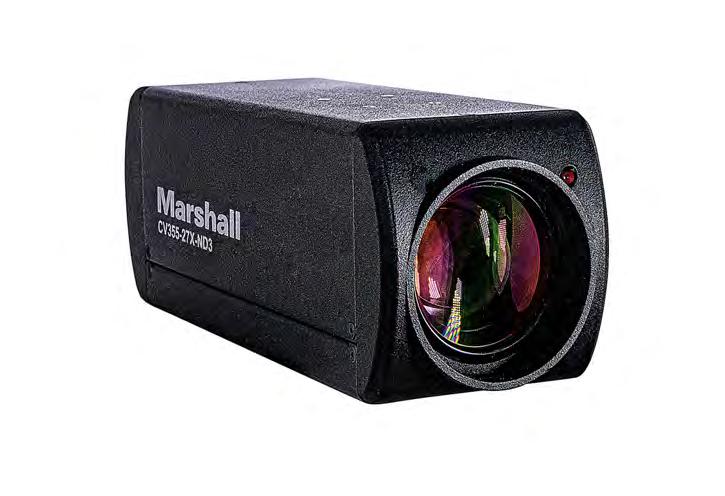
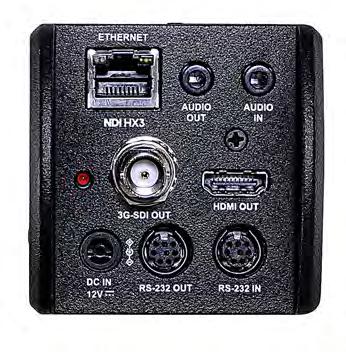
HDSDI and HDMI simultaneous outputs with stereo audio embedding. The CV355-27X-ND3 reportedly operates with exceptional lowlight sensitivity, providing a clear picture in variable and challenging lighting conditions, including houses of worship, live events and other dynamic indoor and outdoor lighting environments.
www.marshall-usa.com

BUILDING ON its first-generation VC-TR40 AI camera, Lumens has deepened its AI integration with the VC-TR41 PTZ camera, integrating additional capabilities to automate media production and delivery workflows. When connected to the Lumens LC300 series 4-channel media processor, the VC-TR41 can be set in either Presenter or Audience Tracking mode. In presenter mode, cameras will track the presenter’s movement across a stage area. In audience tracking mode, the VC-TR41 will focus on any audience member who engages with the presenter by standing. This also automatically switches the media processor to capture the audience member’s involvement. Meanwhile, its Intelligent Director mode is designed to support automated video production, which Lumens says is much sought-
after in the education, judicial and meetings sectors.
Like its predecessor, the VC-TR41 is a 20x HD PTZ with motion-tracking, Zoom certification and compatibility with the CamConnect multi-camera voice-tracking system. It sports IP, HDMI, SDI and USB ports for AV transmission and device control, and is optimised for integration with Panopto and Kaltura content management systems and major video delivery platforms for live and on-demand streaming and secure media archiving.
Finally, the manufacturer has announced that its VC-TR60A is now certified for Microsoft Teams to deliver streamlined integration and fully autonomous functionality.
www.mylumens.com
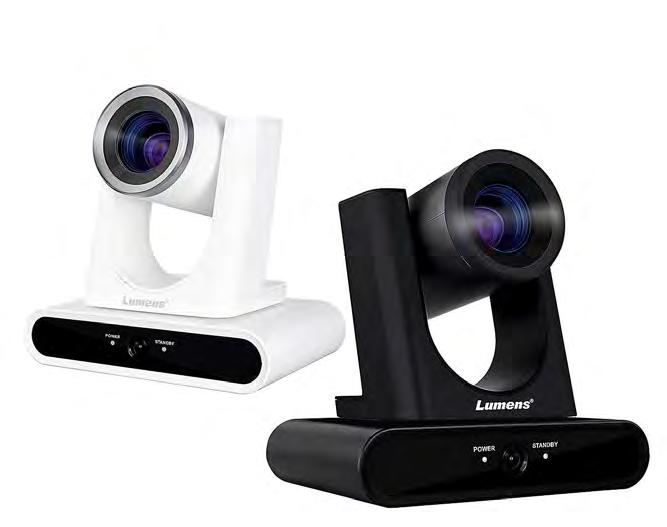
WITH THE creation of the AW-RP200GJ remote camera controller, Panasonic Connect aims to streamline operations for large-scale, multi-camera productions. The AW-RP200 builds on the AW-RP150 predecessor and introduces a suite of features including macro capabilities, dual joysticks and enhanced support for complex multi-camera workflows.
The macros allow operators to automate sequences and complex tasks including the control of multiple cameras simultaneously or executing preset actions with a one-touch execution. Combining efficient production with minimal staffing, operators can manage other cameras while a macro is running.

In addition to the primary joystick for pan, tilt and zoom or focus, the AW-RP200 features a second joystick on the left side. The dual setup enables simultaneous control of different functions, offering multitasking and
highly responsive operation. The controller includes 20 customisable buttons, each
DESIGNED TO streamline signal flow management across broadcast, production and pro AV environments, AJA Video Systems has released two mini converters. The IP25-R connects SMPTE ST 2110 networks with 4K SDI/HDMI infrastructures, while the UDC-4K provides 12G-SDI/HDMI conversion, 4K /UltraHD/2K/HD scaling and frame synchronisation.
For output to baseband 12G-SDI and HDMI 2.0 devices used for confidence monitoring, playout and routing, the IP25-R seamlessly de-encapsulates and converts SMPTE ST 2110 video, audio and ancillary data with frame-accurate synchronisation. Delivering low-latency video up to 4K DCI (4096x2160p60), the IP25-R includes dual 10/25GbE network ports, two HDMI 2.0 outputs and four 12G-SDI BNC outputs.
The UDC-4K includes features that have been engineered to streamline signal flow management, including an integrated colour LCD display and button control panel to save teams configuration time and reduce cable clutter. Active cooling and front-to-back airflow are integral, together with SDI VPID and HDMI Infoframe HDR signalling management, and a built-in EDID emulator.
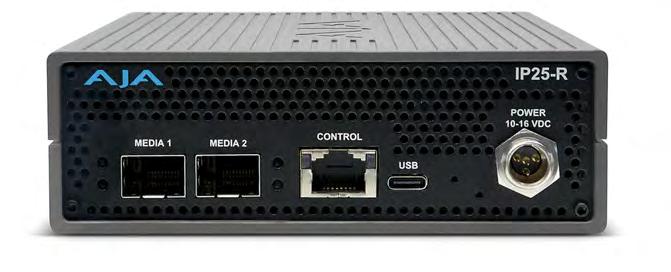
Bridge Live 12G-4 simplifies the accommodation of connectivity types, resolutions, frame rates, formats and protocols. Combining multichannel UltraHD support to the Bridge Live line of IP video devices together with a Desktop Software v17.6 update has resulted in improvements for AJA’s KONA IP25 SMPTE ST 2110 I/O card. The high-density IP workflow solution supports a range of applications from multichannel video transport and contribution to direct-to-audience streaming, remote production and distribution encoding. Four bidirectional 12G-SDI ports are included for encoding, decoding and transcoding within
with a built-in LCD for clear mode indication. Functions such as camera selection, preset recall and macro execution can be quickly accessed and accurately performed, while up to 200 PTZ cameras can be controlled for large productions.
With its web-based configuration, operators can configure device settings via a connected PC browser, allowing for batch assignment of IP addresses and camera IDs. Reducing setup time for large systems, the interface supports macro creation and custom button mapping. The AW-RP200 offers flexible 3G-SDI input and supports IP video input via NDI High Bandwidth and SRT. Video feeds from a LANconnected camera input are monitored directly on the built-in LCD or via SDI OUT.
pro-av.panasonic.net
Desktop Software v17.6 expands the capabilities of the AJA KONA IP25. With the update, the next-gen IP video and audio PCIe I/O card with 10/25GbE network connectivity, enabling multichannel UltraHD and uncompressed bidirectional SMPTE ST 2110 workflows, includes Video+Key playout/TX per SMPTE ST 2110-20:2022 for combining programme video with keyed graphics and titles. The release adds KONA IP25 support for up to 4:4:4 12-bit 4K and selectable multiple ST 2110-30 audio
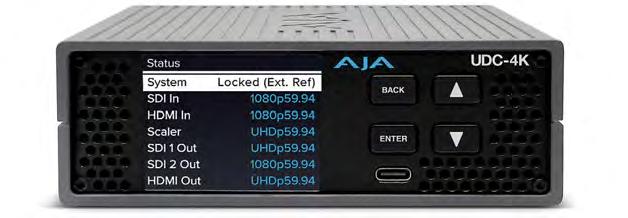
the 1U enclosure. The device can convert video between SDI and standard IP video codecs and protocols, including H.264, H.265, NDI, SRT, RTMP and HLS.
streams per video mode for routing up to 16 channels.
DESCRIBED AS a major addition to its range of viewfinders, the VFE-P711AD from Ikegami is a 7-inch, high-resolution OLED model compatible with all UNICAM-XE and UNICAM-HD cameras. Designed for indoor and outdoor broadcast production applications and based on the established VFL-P700AD LCD viewfinder, the OLED version combines chroma rendition with high brightness and contrast ratio to provide clear visibility even in environments with intense ambient light. The fast response time of the
These include fixed and hinged field hoods, a studio hood, an above-camera viewfinder mount, cables and a carrying case. The VFE-P711AD supports digital interfacing to a UNICAM-XE camera or can be connected via a VFC-700i5 analogue cable to any camera in the UNICAM-HD series. The viewfinder can also be used as a field monitor for an external 3G-SDI feed. Power can be sourced directly from the camera or external 12V DC, allowing standalone operation. Energy consumption is approximately 12W.
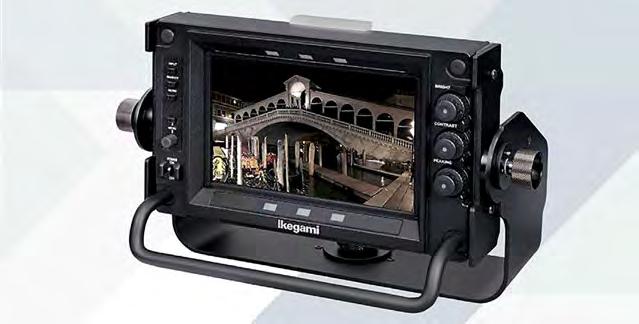
OLED panel is said to enhance the operating experience, especially when capturing content in high frame rate mode where precise focusing and framing are important. An integrated waveform monitor and vectorscope plus audio level metering further enhance the VFE-P711AD’s operability in the field. The viewfinder also incorporates two front-facing green/red tally indicators plus a rear-facing red tally. All accessories that fit the existing VFL-P700AD LCD model are compatible with the new OLED viewfinder.
The viewfinder is available in four different versions: Pack S with standard attachments for mounting on a portable camera head with ENG lens; Pack A allowing enhanced pan/ tilt operation on a portable camera head with ENG lens; Pack B allowing enhanced pan/tilt operation on a system expander (SE-U430) for box lens applications; and Pack C for enhanced pan/tilt operation on a studio camera head (UHK-X750/-X650).
www.ikegami.co.jp
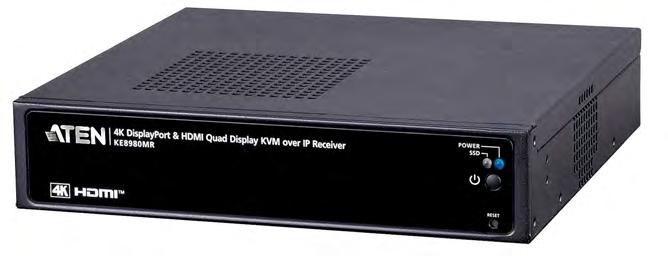
THE KE8980MR 4K quad-display KVM-over-IP multiview receiver from ATEN is described as a high-performance solution designed to redefine how operators monitor and control IT infrastructure in mission-critical environments. Supporting multiview access windows for up to 16 physical and/or virtual servers across four displays at a single workstation, operators can freely position server windows across four screens, resize them as needed and overlay multiple server windows to create a customised monitoring layout.
To ensure intuitive and uninterrupted workflows, the KE8980MR features ATEN’s Boundless Switching MX, allowing users to switch between systems in real time by simply moving the mouse cursor across displays or windows, eliminating the need for manual switching.
During active monitoring, the KE8980MR can switch to Operation Mode, featuring Panel Array that displays up to 108 servers in a 6x6 layout for centralised management and streamlined oversight. Simultaneously, it highlights a selected server with ultra-low-latency performance on a dedicated screen, to provide precise, real-time control without compromising visibility of the overall server environment. It is ideally suited for high-pressure environments such as broadcasting, air traffic control, surveillance and other critical operations.
Aiming to meet the growing demands of large-scale, high-performance digital signage applications, the manufacturer has also introduced the VE8962 True 4K HDMI-over-IP extender. Delivering 4K 4096x2140@60Hz 4:4:4 HDMI AV transmission with ultra-low latency over both Ethernet and fibre optic networks, ATEN says the VE8962 ensures reliable longdistance AV-over-IP with LAN/optical failover for continuous system availability across a range of applications, including airports, transit hubs, stadiums, university campuses and exhibition centres.
Boasting advanced compression and upscaling, it transmits HDMI, audio, USB, IR and RS-232 over a single cable. It has power redundancy with both DC and PoE, network redundancy via LAN and fibre, and operational redundancy supported by drag-and-drop web GUI management and control system integration. The VE8962 also supports audio embedding and de-embedding, enabling audio to be integrated into the HDMI stream or extracted for separate delivery. In addition, the VE8962 supports videowall configurations of up to 80 displays in both portrait and landscape orientations, while its daisy-chain capability allows up to 30 receivers to stream from a single source without the need for additional network switches.
www.aten.com
DESIGNED FOR indoor fixed installations where both performance and efficiency are essential, ROE Visual has unveiled an LED display series named Meru. Available in 500mm x 500mm and 500mm x 1,000mm panel sizes with 1.9mm and 2.6mm pixel pitches, Meru reportedly combines precision engineering with energy-efficient operation to suit corporate, public and broadcast environments.
The panels are engineered to a structural tolerance of just 0.05mm, ensuring a flat, seamless surface. Front-mounted magnetic modules allow tool-free servicing, while a wall-mountable frame and modular design streamline installation. A micro-adjustment system further simplifies panel alignment. Optional dual power redundancy provides continuous performance for mission-critical applications, supported by EMC Class B certification for safe operation in complex
environments such as airports and control rooms.
With a 7,680Hz refresh rate, Meru is equally suited to direct-view applications and in-camera use. The display is described as delivering “vivid colours, deep contrast and smooth gradients”, while its energyefficient power supply helps reduce long-term operating costs.
www.roevisual.com

THE 2U iVAM2-MPEG SRT monitor from Wohler can decode MPEG SRT MPEG2, H.264 or H.265 HEVC transport streams, at bitrates up to 35Mbps. The unit parses out MPEG transport
streams and presents operators with PID (packet identifiers) tables, allowing for independent selection of audio and video PIDs for decoding and monitoring. Overlays on the video display
allow for monitoring of closed captions and subtitles embedded in the MPEG transport stream. Audio monitoring for AAC, Dolby Digital+ and MP3 is supported. The unit provides two

4.3-inch LCDs for an easy-to-operate touchscreen interface complemented by a built-in webserver, enabling operators to configure presets, upgrade the unit and view audio meters remotely. The manufacturer has also introduced an optional 12G-SDI re-embed feature, to re-embed 16 audio channels chosen from any connected audio source in the 12G-SDI BNC output. Available on the iAM1-12G and iVAM1 and iVAM2-12G monitors, the feature is available via software activation.
www.wohler.com
THE ECLIPSE G3 from Christie is a 6DLP projector that offers true HDR performance and represents the third generation of Christie’s Eclipse technology. Designed for high-end applications like home theatres, planetariums and themed attractions, Christie says the Eclipse G3 delivers a degree of detail and depth of colour not possible with any other projector. With up to 20,000,000:1 sequential contrast ratio – 100 times Rec. 2100 contrast performance – the company claims it can display true black without any residual light and has a colour gamut of
~98% of the Rec. 2020 colour palette. It supports up to 120Hz 2D and active 3D at up to 60Hz per eye at native 4K resolution. With this latest generation of Eclipse technology, the 30,000 ANSI lumen Eclipse G3 is capable of maintaining full brightness for 50,000 hours, and is described as more refined with built-in RGB pure laser illumination and a streamlined, easier-to-install form factor. www.christiedigital.com

EPSON HAS introduced new projector models designed for venues ranging from lecture halls and galleries right up to immersive digital signage applications. At the forefront is the EB-L890E, a 3LCD laser projector specified
Also making its debut is the EB-L690SE, a compact short-throw laser model offering 6,000 lumens with 4K Enhancement technology. With a 0.5–0.7:1 throw ratio, 1.4x optical and motorised zoom, focus and lens
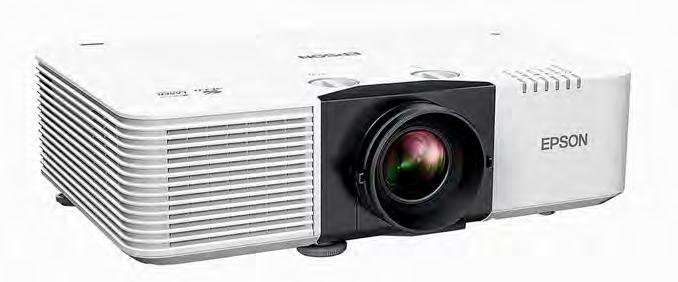
for large spaces such as conference rooms and auditoriums. Delivering 8,000 lumens of colour and white brightness, it reportedly ensures vivid images even in bright environments. The projector offers WUXGA resolution with 4K Enhancement technology, alongside flexible installation options including a 1.6x optical zoom, wide lens shift and 360° mounting capability. Connectivity covers HDMI, HDBaseT and wireless casting via Apple AirPlay 2, Miracast and Epson’s iProjection, while built-in geometric correction and optional accessories such as the ELPEC01 camera enable multiprojector configurations.
shift, the unit can project large images from short distances, suiting space-constrained installations such as simulators, galleries and meeting rooms.
Completing the lineup is the LightScene EV-115, Epson’s digital signage projector designed to merge lighting and display. Capable of projecting onto almost any surface while simultaneously functioning as a spotlight, the LightScene series creates immersive environments for applications spanning retail, décor and digital art.
www.epson.com

BLACKMAGIC DESIGN has released its Camera ProDock, which adds professional camera connections to iPhone 17 Pro and iPhone 17 Pro Max. The dock works with the Blackmagic Camera app to add support for external timecode, genlock, audio and SSD recording, transforming an iPhone into a production tool that fits seamlessly into highend studio and on-set environments. Genlock ensures that every frame of video is captured in sync with other sources, such as cameras and switchers, preventing issues like dropped frames. It also lets customers shoot LED walls without distracting flickering or tearing, which is important for virtual production. When customers are shooting with multiple cameras, timecode allows each camera to start and stop recording independently. DaVinci Resolve then uses the recorded timecode to sync the shots from all cameras, so filmmakers don’t need to waste time sorting and manually aligning thousands of shots.
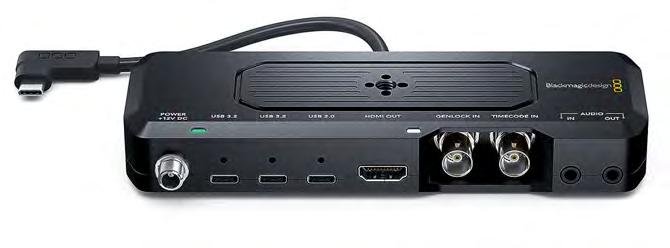
The dock is designed to accommodate a wide range of accessories, from audio recording to external storage and remote controls. It features three USB-C ports for lens and camera control accessories, and high-speed external SSDs for recording. The power management system ensures everything can run at the same time, while powering an iPhone. There are 3.5mm connections for microphones and headphones, and a full-size HDMI output for on-set monitoring.
The Cintel Scanner G3 HDR+ 8/16 has been designed to support 8mm HD and 16mm Ultra HD film scanning. It features a completely new optical assembly that allows customers to get higher-resolution image scanning of these smaller formats, in particular for scanning archived, historical footage. The model retains the same capstan drives, real-time HDR film scanning and includes 8mm and 16mm film gates.

LYNX TECHNIK has added three products to its Series 5000 and yellobrik ranges designed to expand signal distribution, fibre efficiency and IP conversion in broadcast and AV workflows. The DVD 5410 is a 12G-SDI 1x8 distribution amplifier for the Series 5000, supporting all formats up to 12G-SDI. It can reclock or pass signals transparently, with strong return loss for 4K video. An optional power fail relay maintains
continuity during outages, while integration with LynxCentraal enables remote monitoring and error reporting.
The OCM 1800 yellobrik is an 18-channel CWDM multiplexer/demultiplexer, capable of transmitting or receiving up to 18 signals over a single fibre. Operating across 1,270–1,610nm wavelengths, it requires no power and installs into a standard rack, offering an efficient way to increase fibre capacity without new infrastructure.

as
part of a turnkey solution, the platform is designed to optimise the design, simulation and documentation process of projection environments and enables teams to walk
The RGB LED grid array illumination source is designed to work with a sensitive imaging sensor and ensures customers’ priceless film is never exposed to unnecessary thermal stress and colour fading effects of traditional scanner lamps. The new light source also provides an additional 3.5 stops of HDR, while a new film inspection mode allows customers to see how the original film actually looks compared to the scans the new light source produces.
Finally, the manufacturer has announced DaVinci Resolve 20.2 and Blackmagic Camera 9.8 public beta which add support for Apple ProRes RAW, including footage captured with the new iPhone 17 Pro, and ProRes RAW HQ file formats. In addition, future updates for Blackmagic Camera and Blackmagic Video Assist 12G will also add both ProRes RAW file formats.
www.blackmagicdesign.com
The third addition, the CDE 1922 yellobrik, provides bidirectional conversion between 3G-SDI and SMPTE ST 2110 IP networks. Supporting up to four HD streams (two SDI to IP, two IP to SDI), it handles uncompressed video, audio and ancillary data, with full redundancy via ST 2022-7 protection switching. Built-in NMOS support streamlines device discovery and connection management.
www.lynx-technik.com
through, interact with and collaborate on projects in real time.
Users can import any drawing and instantly project it to real-world dimensions using simple reference points, automatically adapting to any space and enabling users to navigate through the projected plan in true scale, regardless of the size of their physical room. Combined with centralised control covering content management, automation and its communication with projectors, software and other devices, VIOSO says EXAPLAN functions as a centralised dashboard for the entire visual system. With true scale projection of CAD layouts in real space allowing teams to walk through and interact with designs together, VIOSO says the software aims to bridge the gap between conceptual planning and technical execution, reducing miscommunication and helping to avoid expensive mistakes.
www.vioso.com
DEVELOPED AS a companion application for its SP Grid platform, SP Grid Viewer from Stage Precision is now available as a free download in the App Store. The iOS app provides technicians, operators and creative teams with live access and control of their custom-built SP Grid interfaces directly from an iPhone or iPad.

Designed for use in high-pressure environments such as live events, immersive installations and remote system monitoring, SP Grid Viewer supports full-screen user interfaces, portrait and landscape modes and secure connection options. The app allows professionals to connect to the Grid Studio server remotely and maintain control of existing SP Grid deployments from mobile devices. SP Grid is described as a “Swiss-army knife” for digital productions, offering tools to create and route custom control panels, system states, triggers and monitoring solutions across distributed setups. The new Viewer app extends that ecosystem, enabling mobile system management without adding workflow complexity.
www.stageprecision.com
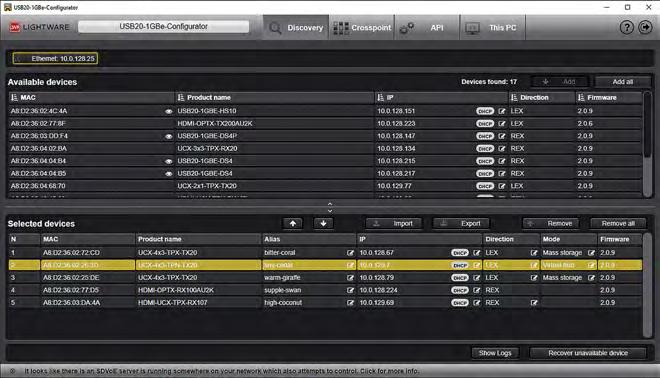
THE FREE-TO-DOWNLOAD USB20 1GBe configurator is a Windows-based software tool from Lightware that speeds up USB pairings in a range of systems, including the UCX Series, as well as HDMI-TPN, HDMI-OPTN and UBEXPRO20 devices. It has been created to help both AV and IT professionals pair USB endpoints quickly, automatically discover devices, manage connections consistently, and easily monitor and integrate with control systems.
Designed specifically for Lightware devices with USB 2.0 over Ethernet capacity, the software provides a clean, user-friendly interface.
MATROX VIDEO has introduced its Origin Fabric, a low-level C++ SDK that enables asynchronous media content sharing across applications using the most efficient available transport method. This foundational transport technology from the Matrox Origin framework is being introduced as a forthcoming standalone offering for OEM customers and media application developers.
operating modes (Virtual Hub, MSA or Single Port). Auto-discovery of all Icron-enabled Lightware devices and peripherals is said to simplify the process even further by reducing the need for manual pairing and complex cabling.
According to the manufacturer, there’s no longer any need to rely on spreadsheets or external documentation to understand the connection topology. Graphical topology view provides a visual map of how USB devices and hubs are connected, making pairing devices easy, as well as quickly identifying connectivity issues.
The tool can be used to help prevent IP conflicts and device misconfigurations thanks to DHCP and IP validation that provide conflict-free networks. For large rollouts, the export/import of full configurations via editable JSON files results in standardised deployment at scale. It’s also ideal

Technicians can assign device roles (LEX, REX or BiDi), configure settings and choose from USB
for replicating setups or restoring earlier states, helping to reduce workload. This feature will be
particularly beneficial in universities, boardrooms and corporate workspaces where multiple rooms and many different elements are involved. Thirdparty integration is also fully supported thanks to the built-in REST API, providing direct access to device status monitoring.
The manufacturer has also unveiled the latest firmware update for its whole Taurus product family (including TPX, TPN and the standalone UCX variants). A new security feature called Remote System Logging enables Taurus devices to automatically forward system logs to an external, centralised server, such as SIEM system, in standard syslog formats (RFC3164 or RFC5424). This removes the need to store logs locally, allowing for easier monitoring, analysis and long-term storage. The update also gives administrators simplified visibility into device activity across networks without having to manually access each device individually, making it easier to troubleshoot, detect anomalies and spot suspicious behaviour. This solution will be particularly beneficial for security-sensitive sectors such as banks, government and defence.
Finally, the manufacturer has also integrated Microsoft Teams Rooms into its Taurus universal matrix switchers. As a result, Taurus UCX and TPX users will reportedly benefit from easier content sharing and flexible connectivity options, as well as leveraging the power of USB-C.
go.lightware.com
Key features include automatic routing between sources and destinations, including shared memory for local high-speed transfers, TCP for maximum compatibility or RDMA for low-latency, high-bandwidth networked systems. The SDK supports multiple producers for the same content stream with automatic failover, eliminating single points of failure

According to the manufacturer, the SDK delivers the same scalable, resilient media fabric layer as Matrox Origin, allowing developers to improve performance and interoperability without fully rearchitecting their existing platforms. It addresses a critical need in modern media workflows by enabling vendoragnostic, asynchronous transport across cloudbased, distributed and microservice-oriented environments.
and ensuring continuous service without custom failover logic. It also functions as a transport layer that seamlessly connects multiple applications across different vendors using logical, content-centric routing, making it ideal for distributed, microservice-oriented and cloud-based media workflows.
video.matrox.com
DESIGNED TO reduce cost and complexity, Vizrt’s Viz Engine 5.4 delivers multiplatform graphics from a single workflow and streamlines adaptive design, HDR and simultaneous outputs. Viz Engine 5.4 can be applied in applications ranging from stadium-wide LED walls to immersive studio backdrops with productions currently up to 8K from a single Viz Engine with a fibre connection. With adaptive graphics that flex to any aspect ratio, one design can cater for broadcast, OTT and social simultaneously with multiple formats running in parallel in one workflow.
With HTML5 integration, any live web content such as sports scores or election results can be pulled directly into the graphics and transmitted on-air in seconds. Support for Unreal Engine 5.4 and 5.5 enables hyperrealistic virtual sets and richer visual detail. An automated lens calibration reduces setup time without requiring specialist skills, and the latest rendering options provide more effects.
With the latest release of the Viz Arena 6, AI-powered advancements have been introduced to simplify keying and to speed up live augmented reality graphics and virtual advertising sports production. The virtual advertising and AR graphics solution includes features for simplifying the workflow of operators when integrating AR graphics into live broadcasts. With AI calibration, AR graphics and virtual ads are locked to the field, regardless of camera movement, with graphics getting to air 10x faster. The Sports Intelligent Keyer uses ambient learning to intelligently separate foreground from background, with minimal manual input required. In live sports, action in the control room mirrors the action on the ground. Counting on a reliable system that eases time-consuming and complex tasks means producers can scale quality production –without scaling costs or complexity.
www.vizrt.com

FOR AS LONG AS I’VE BEEN IN THE PR INDUSTRY –and yes, it’s been a while – the demise of my profession has been declared with surprising regularity. Fifteen years ago, we were told: “PR is dead! SEO is the only thing that matters.” Then came the rise of social media: “PR is dead! Find the influencers!” Three years ago, with the launch of ChatGPT, the chorus grew louder: “PR is dead. Now the robots will write everything for us, for free!” And yet, here we are. The robots are very much among us – and PR has never mattered more. In the old search world, visibility meant mastering SEO. Entire industries grew up around backlinks, keyword density and metadata, with marketers pouring tens of thousands of dollars a month into clawing their way onto page one of Google, or paying for the privilege.
But that playbook is already going out of date. A recent report from research firm Gartner predicts that by 2028, traditional search will lose half its share to AI tools as people increasingly turn to chatbots and generative platforms for answers. Instead of 10 blue links, users now receive polished, easy-to-read, and (mostly) wellresearched responses.
And here’s the crucial shift: those answers aren’t pulled from your “About Us” page or that blog post masquerading as thought leadership, ghostwritten by an eager intern. They’re stitched together from credible, third-party sources – content that’s timely, fact-checked and subject to editorial oversight. In other words: news outlets, analyst reports and trade publications, like ProAVL and ProMEA . Because here’s the reality: LLMs (large language models) don’t care what you say about yourself. They care what others say about you.
A 2025 Muck Rack study of more than 1m AI citation links found that 89% came from earned media –

journalism, trade press and independent reporting – while branded content barely registered. Another analysis from PR platform PRsay showed that editorial media drives 61% of all LLM content about brand reputation, while corporate websites were cited in fewer than 5% of cases. Research by the Content Marketing Institute found that up to 84% of B2B decision-makers consult trade publications.
The takeaway is simple: if you want to show up in AI-driven search results or on an SI’s or procurement officer’s shortlist, you need third-party validation. That blog post you spent weeks polishing? It might boost your CEO’s ego but it’s unlikely to move the needle on your relevance with LLMs.
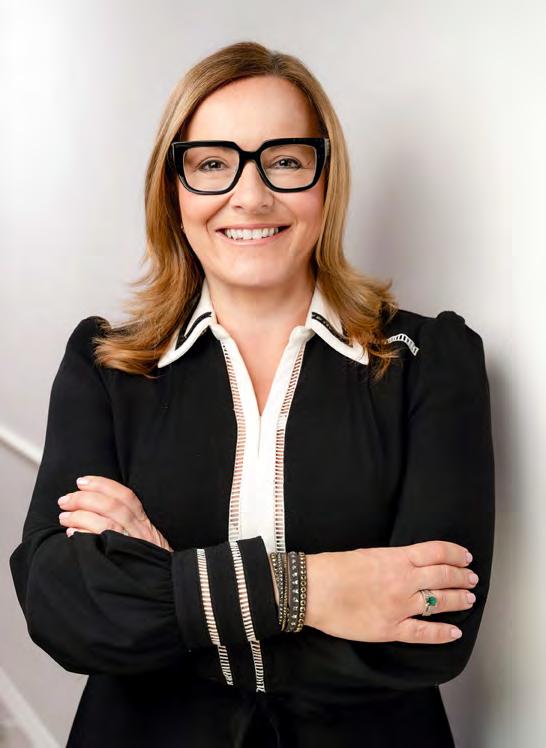
Trade publications may not dominate social media feeds but, in the AI age, they’ve emerged as unlikely power players. They are trusted, respected and, most importantly, indexed heavily by AI systems looking for credible voices. This is especially true in B2B markets. In industries from security and IT to media technology and AV, decision-makers rely on trade press not just for product updates but for context, analysis and independent validation. These outlets provide the “receipts” that algorithms and executives alike recognise as proof of credibility.
Take the AV industry as an example. Trade publications may not have the mass reach of the Wall Street Journal. But, within the industry, they are read religiously by integrators, consultants and end users making multimillion-dollar decisions. When AI models scan for “trusted voices” in the sector, those same outlets feed into the knowledge base.
None of this means you should abandon your corporate blog or branded content efforts. They still matter for brand voice, customer education and SEO in the near term. But let’s be honest: branded content often reads like… well, branded content. AI knows this. Studies of LLM outputs show that corporate blogs and promotional sites are cited in fewer than 5% of brand reputation queries. Why?
Because algorithms, much like humans, can smell the spin. The website content you lovingly polished may charm your CMO but, since it wasn’t published or validated through a credible third party, it won’t shape the answers people are reading, or the models generating them.
So what’s the practical takeaway for marketers staring down this AI-driven future?
• You can’t buy your way into authority. AI rewards credibility. To show up in AI answers, you need earned visibility across trusted outlets.
• Newsworthiness matters more than noise. LLMs are trained to filter out puff pieces. If your announcement isn’t genuinely newsworthy, it won’t stick.
• Storytelling wins over keyword stuffing. Both people and algorithms respond to real narratives. Boring feature lists won’t get you far.
• Repetition builds repetitions. A steady drumbeat of credible mentions, especially in the runup to major events such as ISE and InfoComm, builds the kind of reputation equity that both machines and humans respect.
• Think audience and algorithm. Write stories that engage real readers and stand up to algorithmic scrutiny.
The future of search won’t be won by louder selfpromotion. It will be won with credibility. If you’re responsible for brand visibility, the mandate is clear: show up in the outlets your audience and the algorithms trust. That means investing in real PR. Work with professionals who cultivate journalist relationships, pitch meaningful stories and translate jargon into narratives worth reading. Because, in the end, the future of search will belong to the brands trusted enough to be cited.
www.bubbleagency.com



